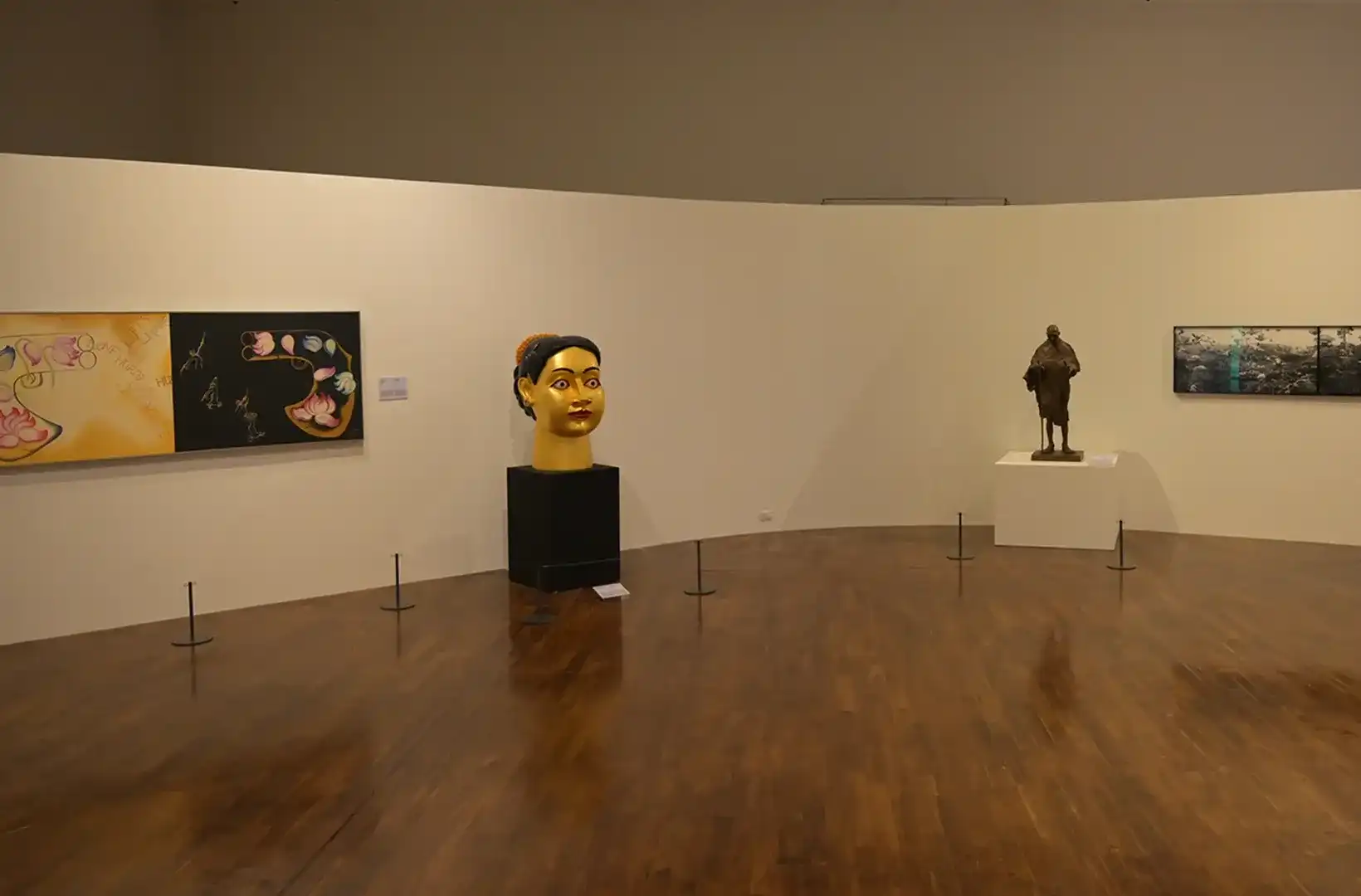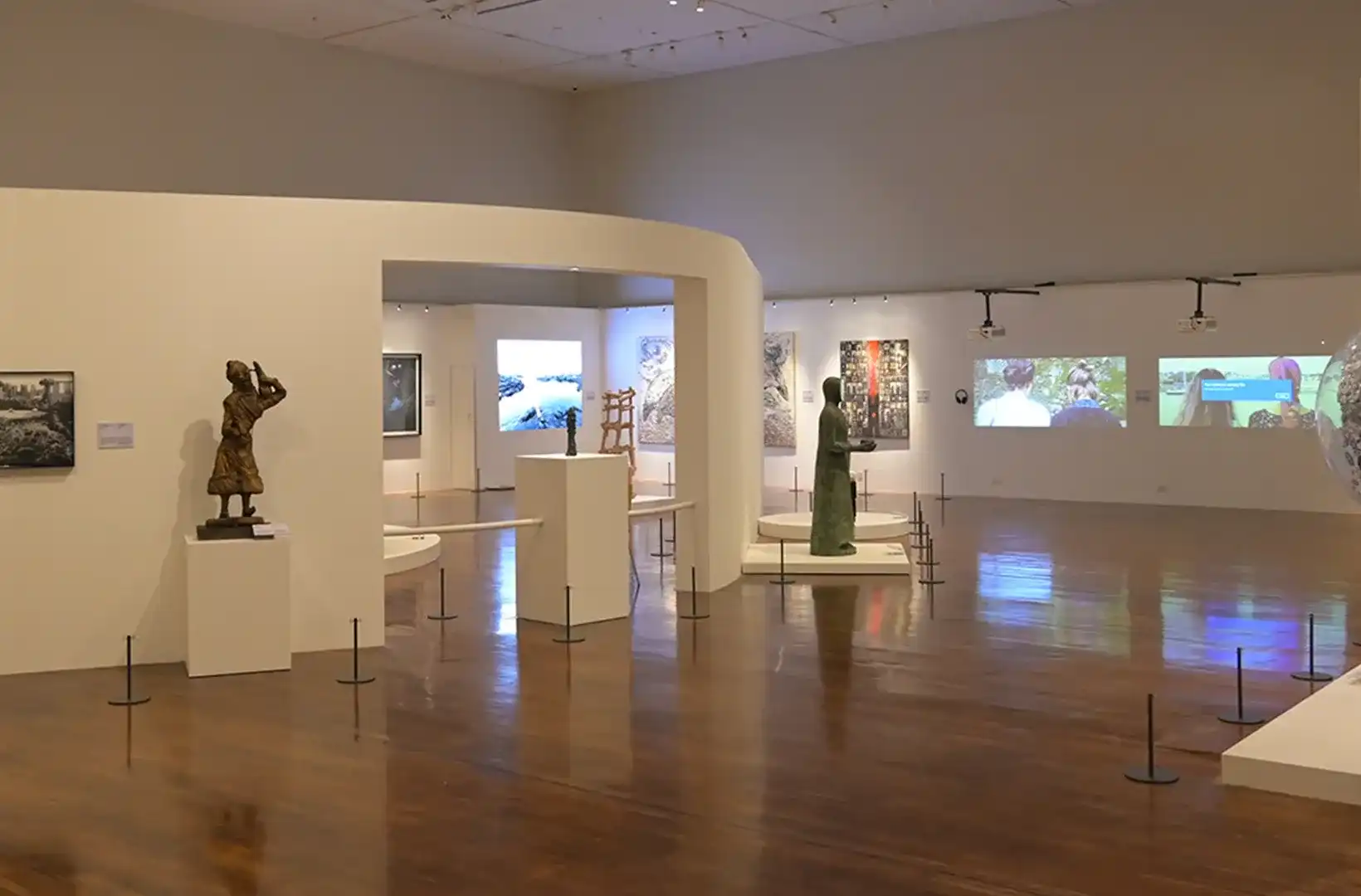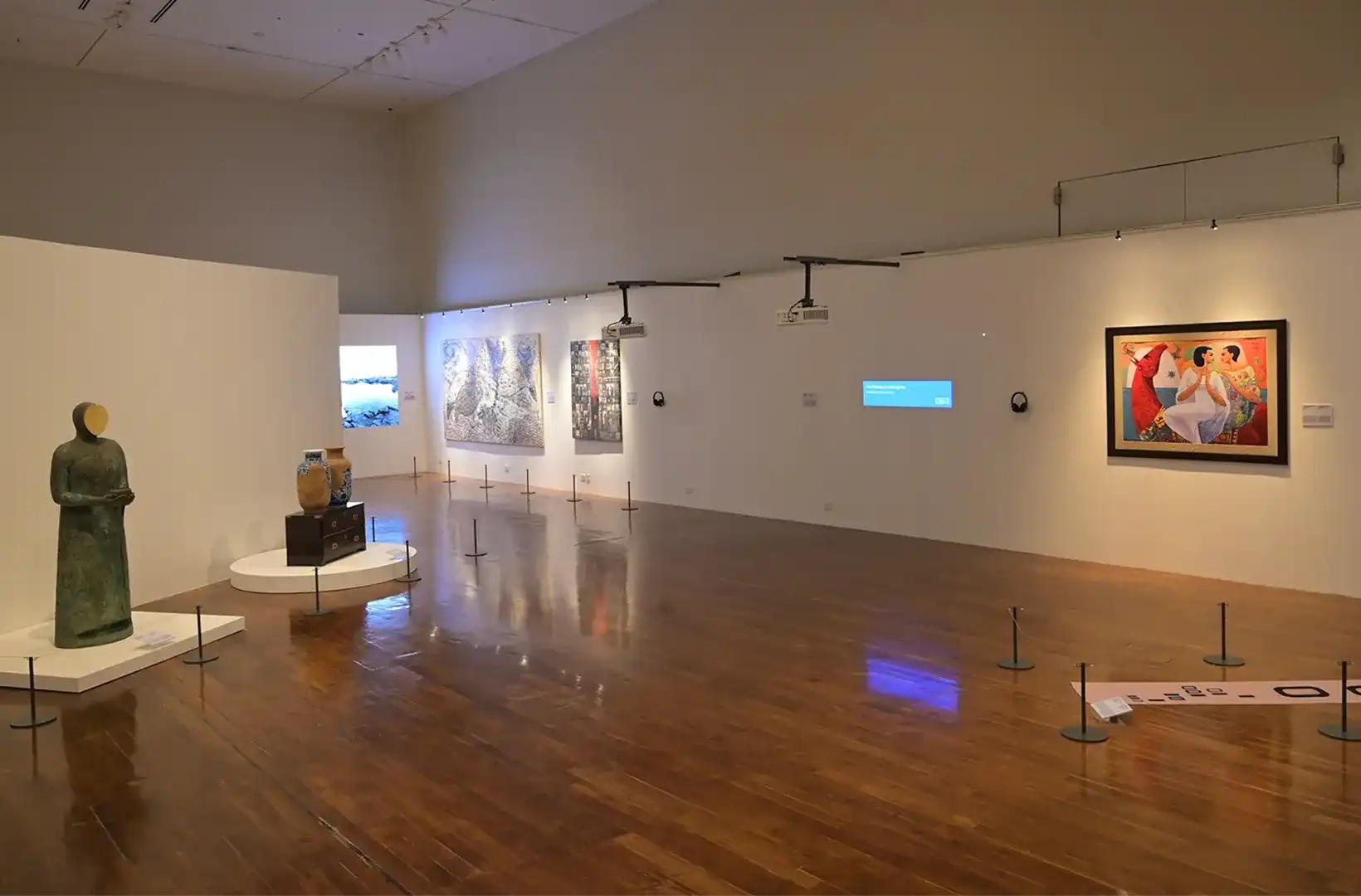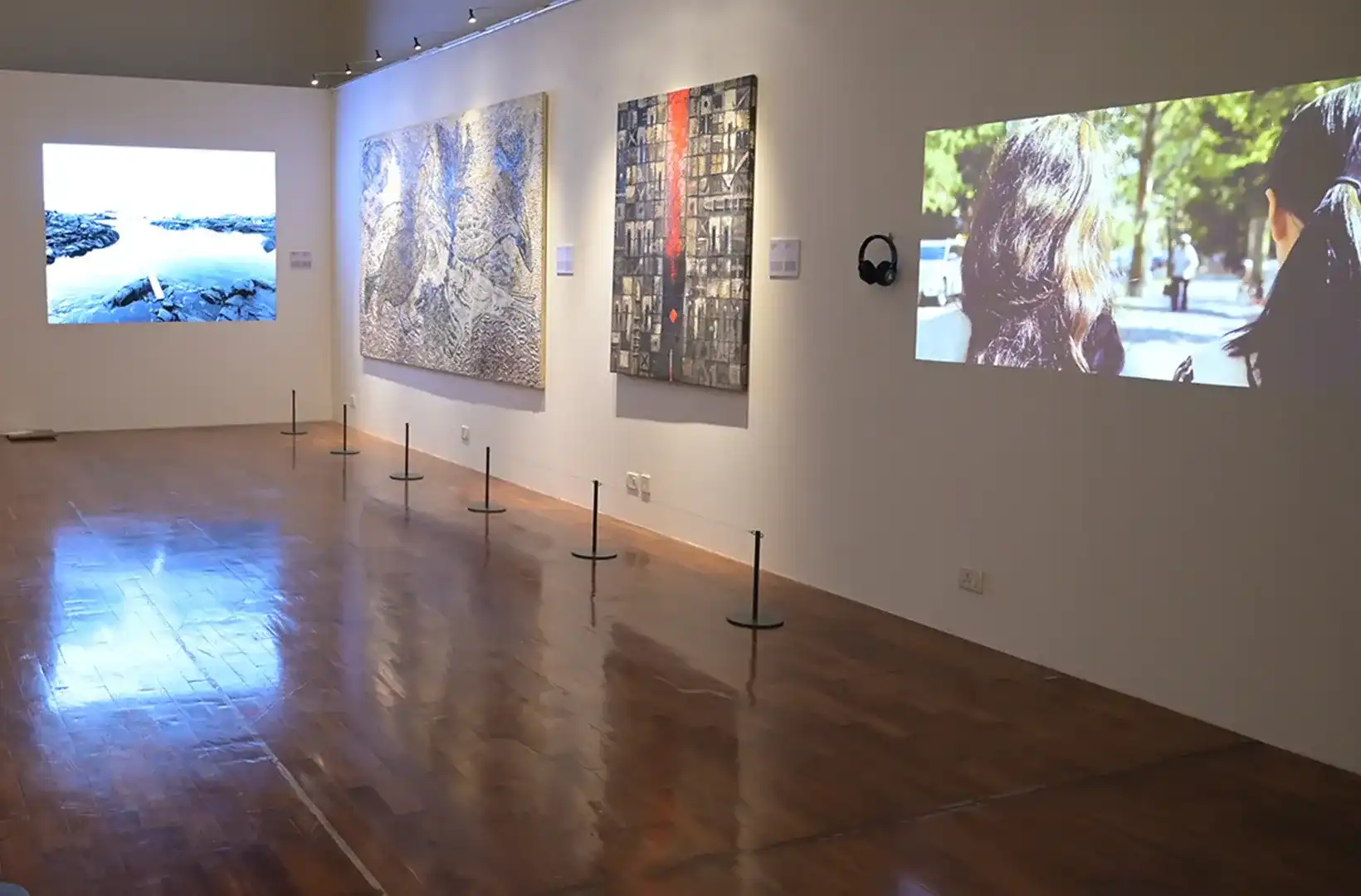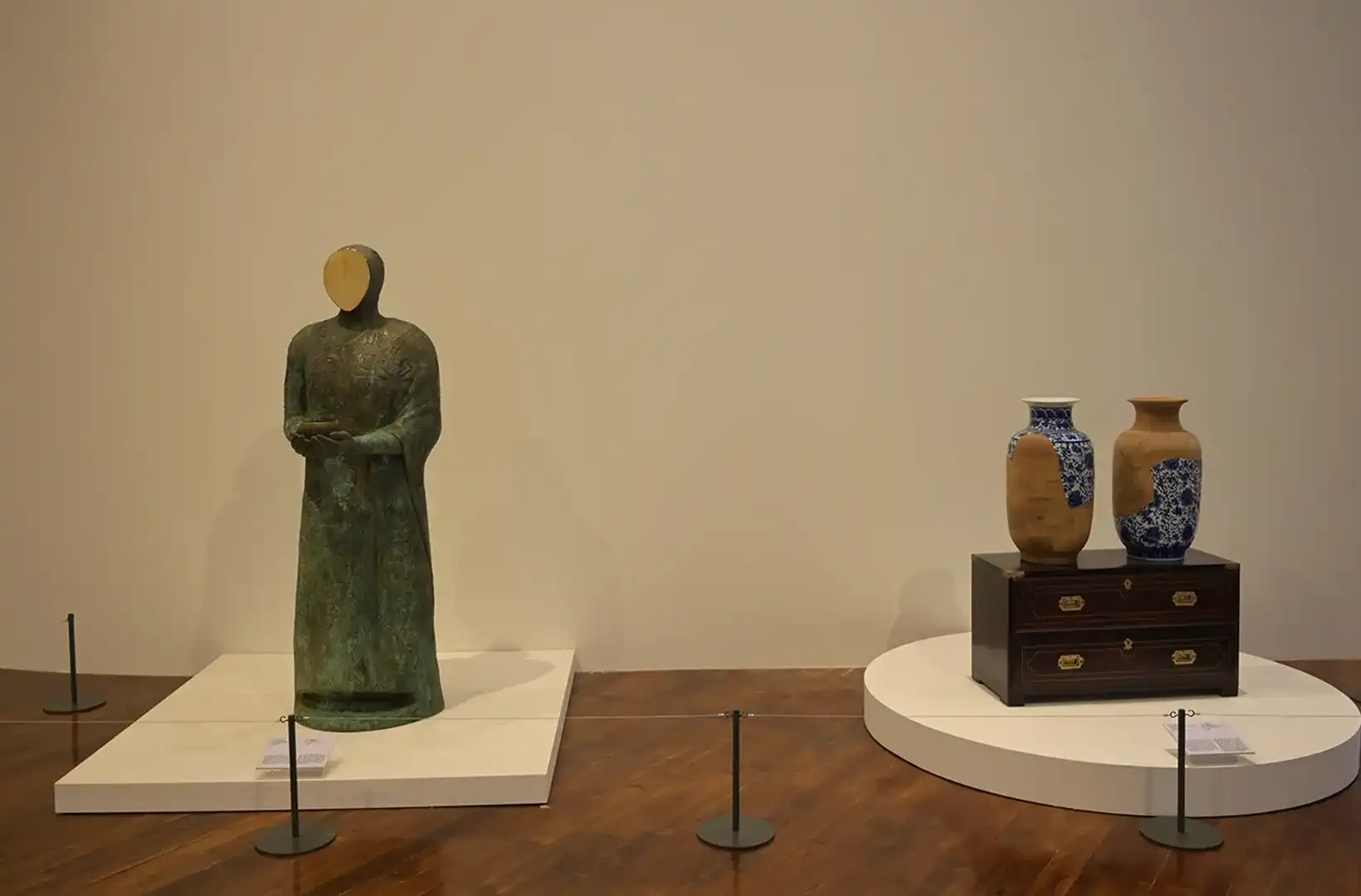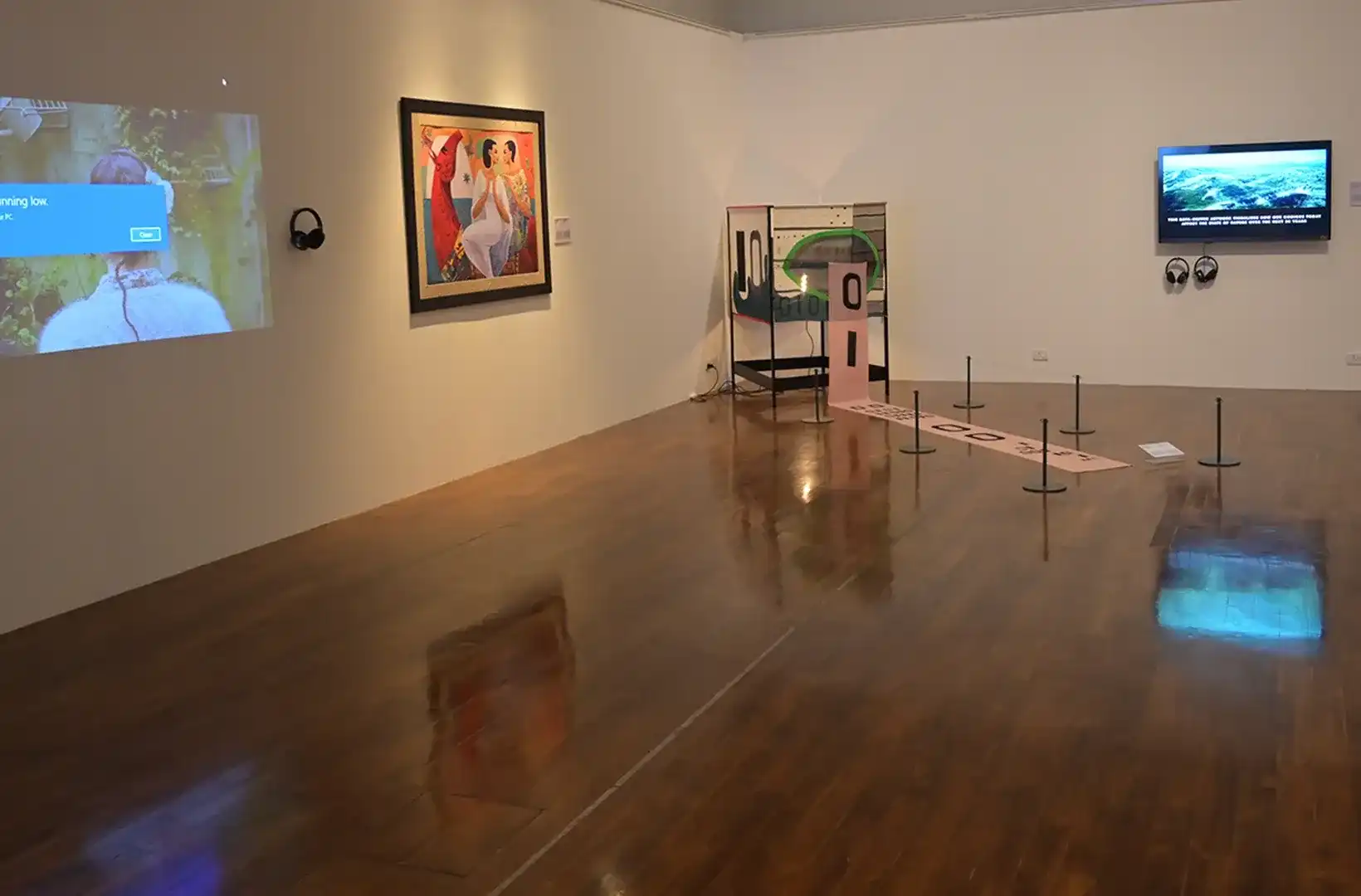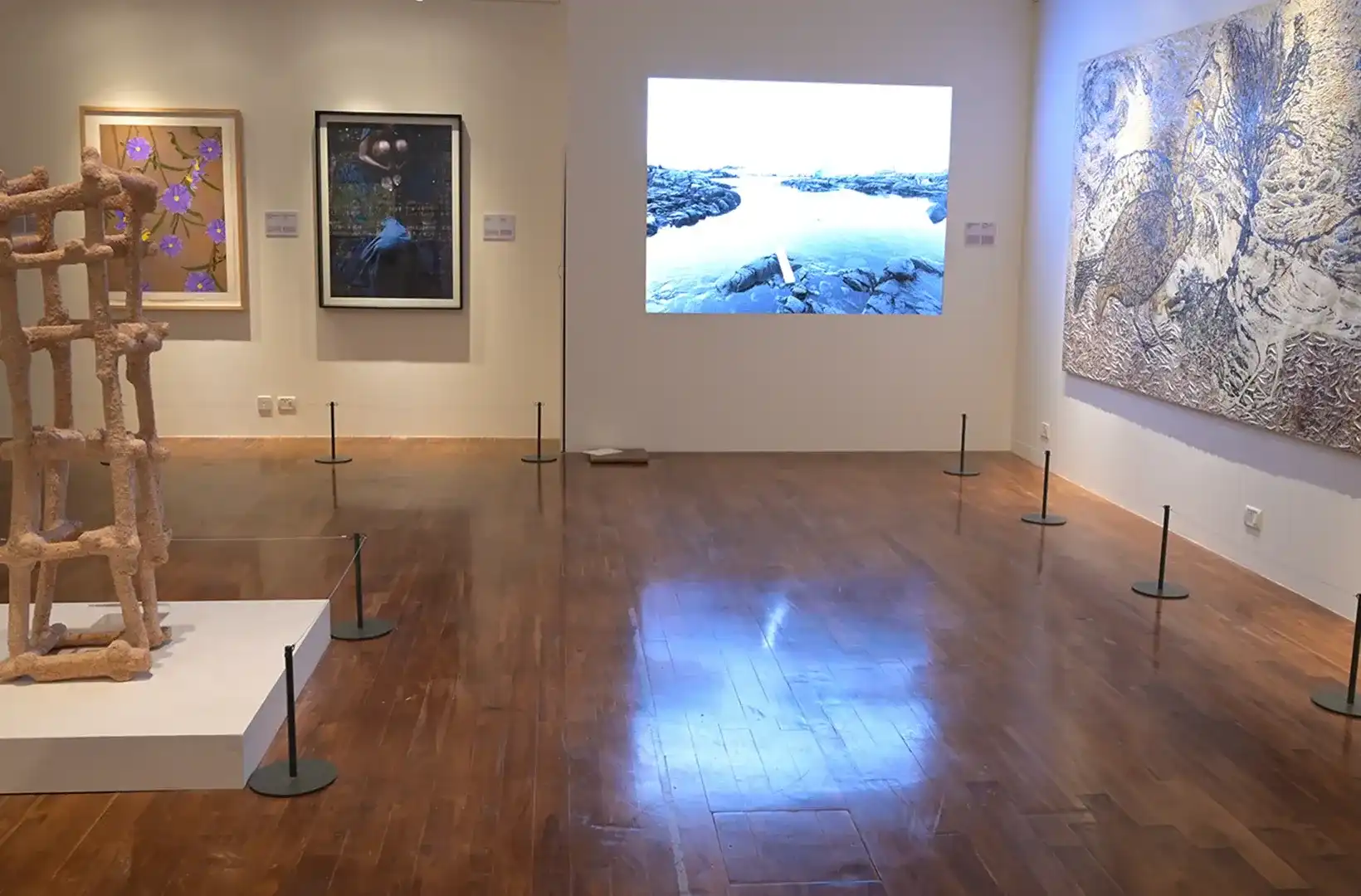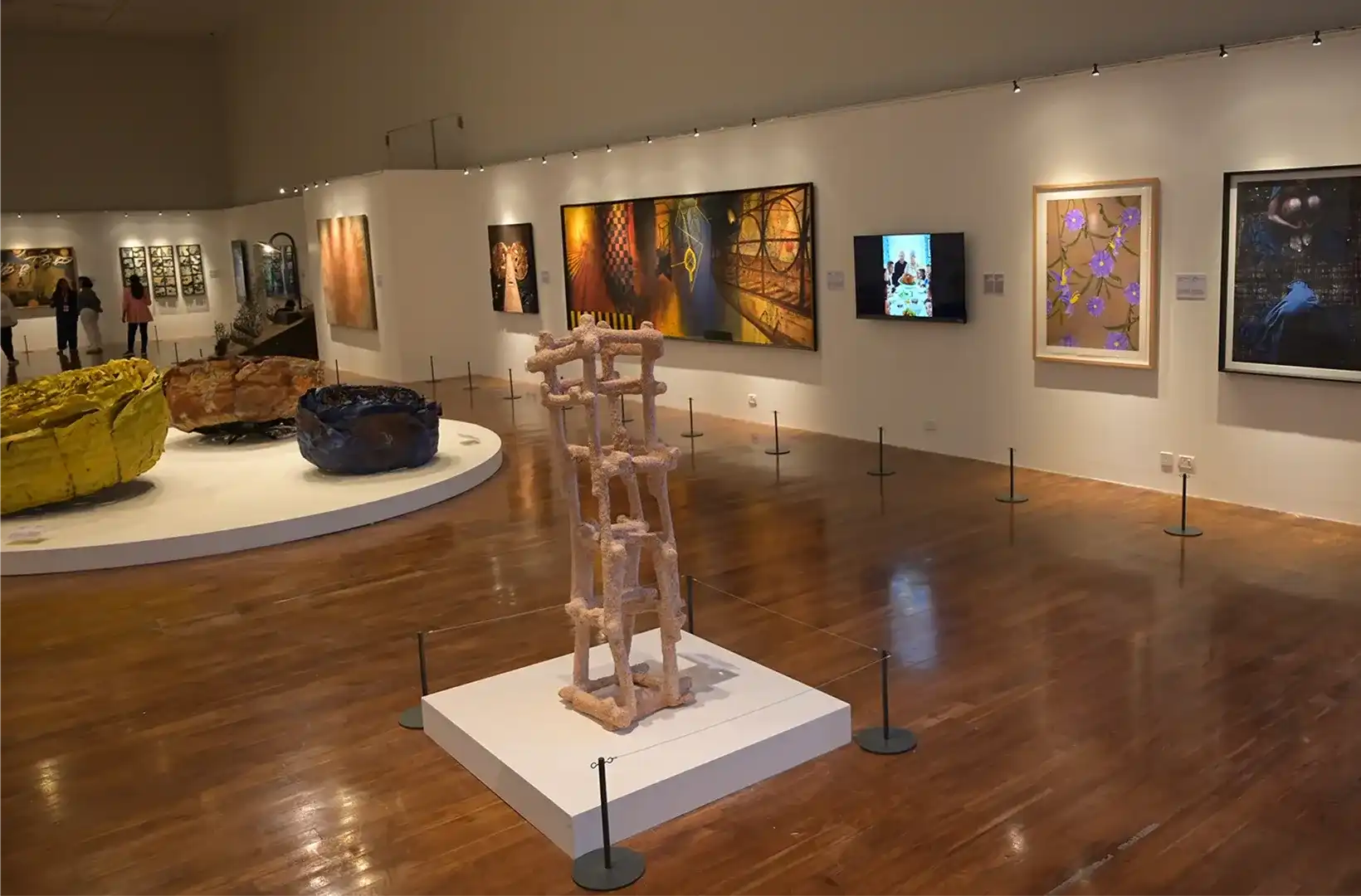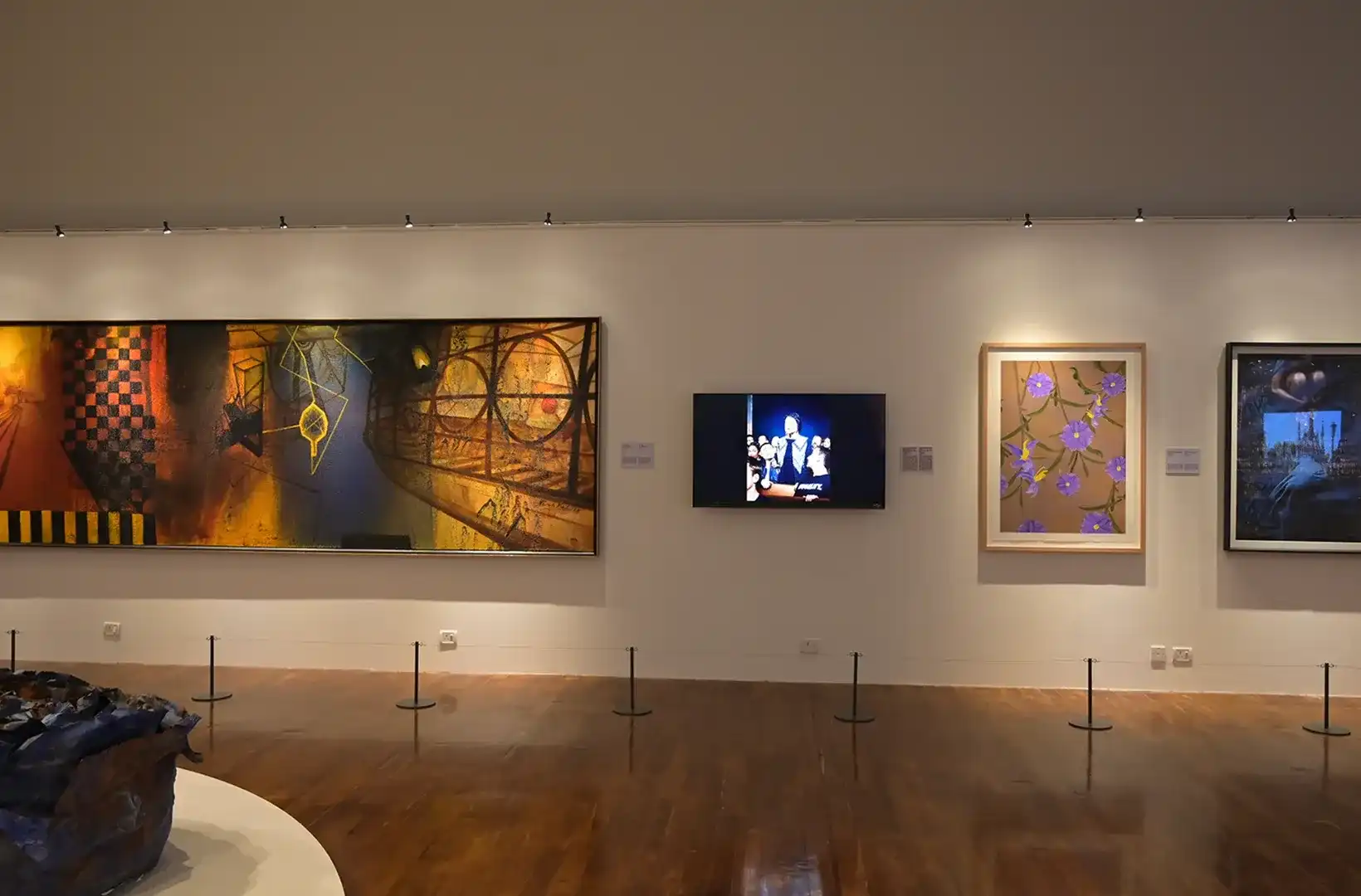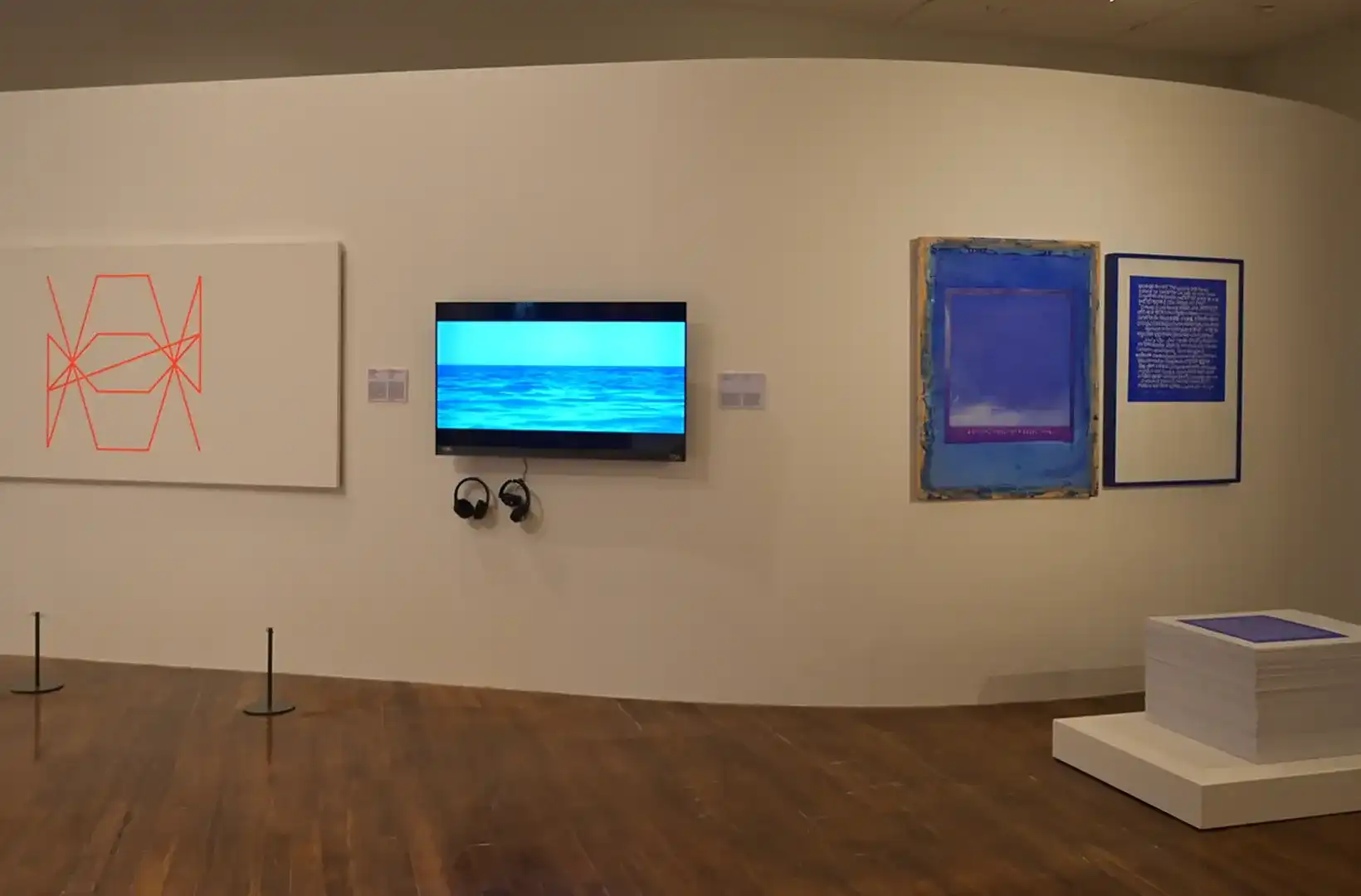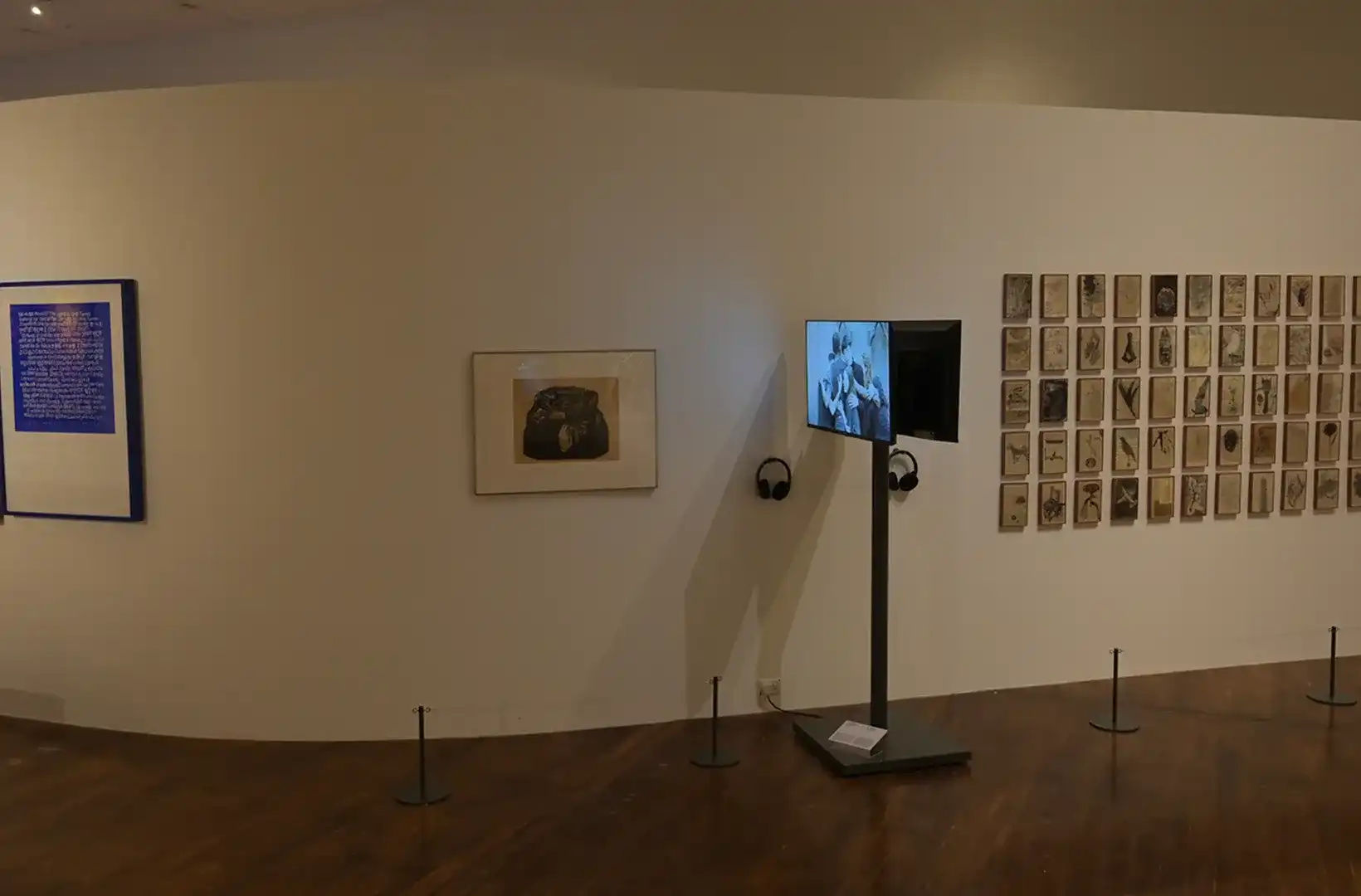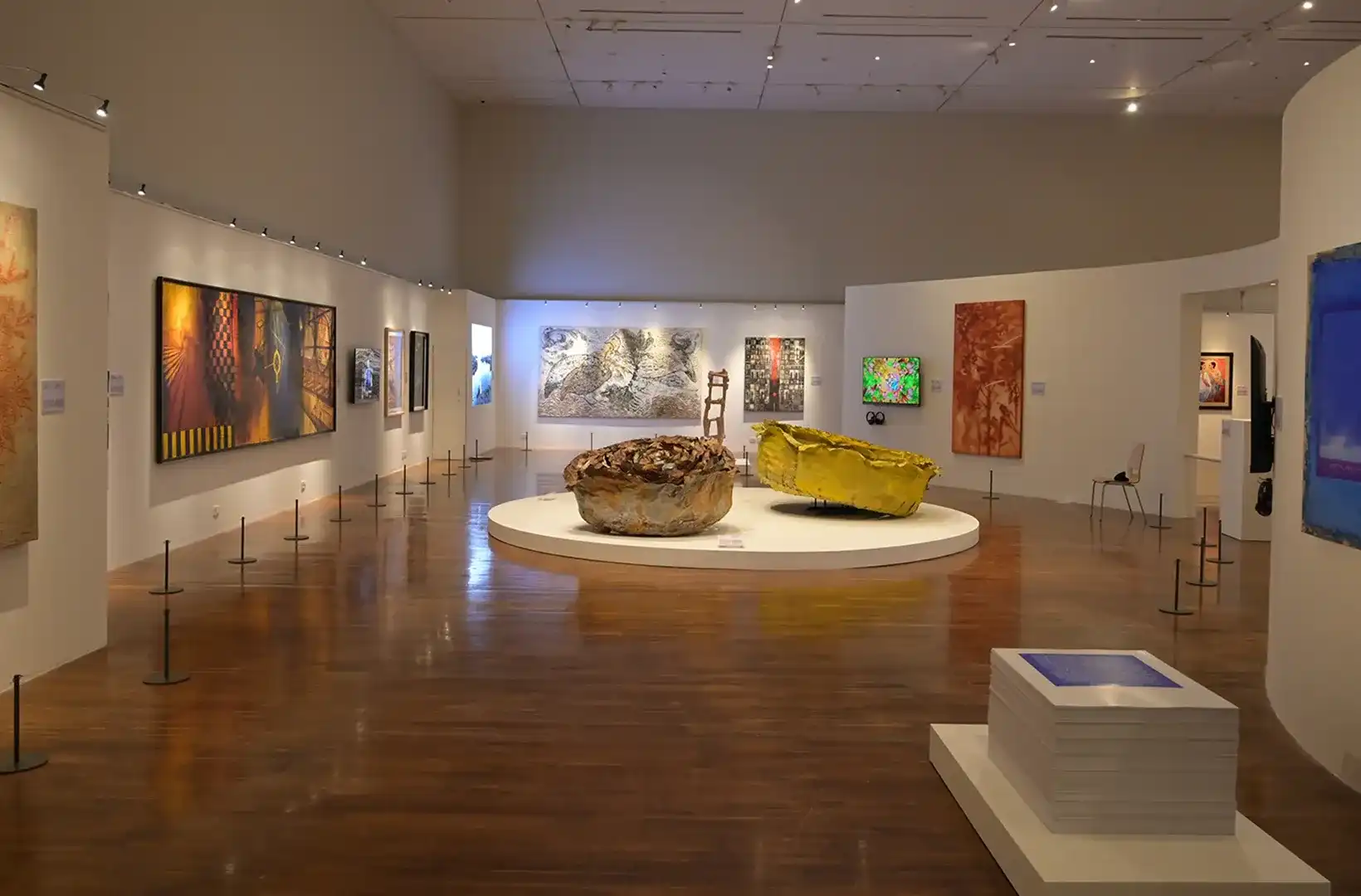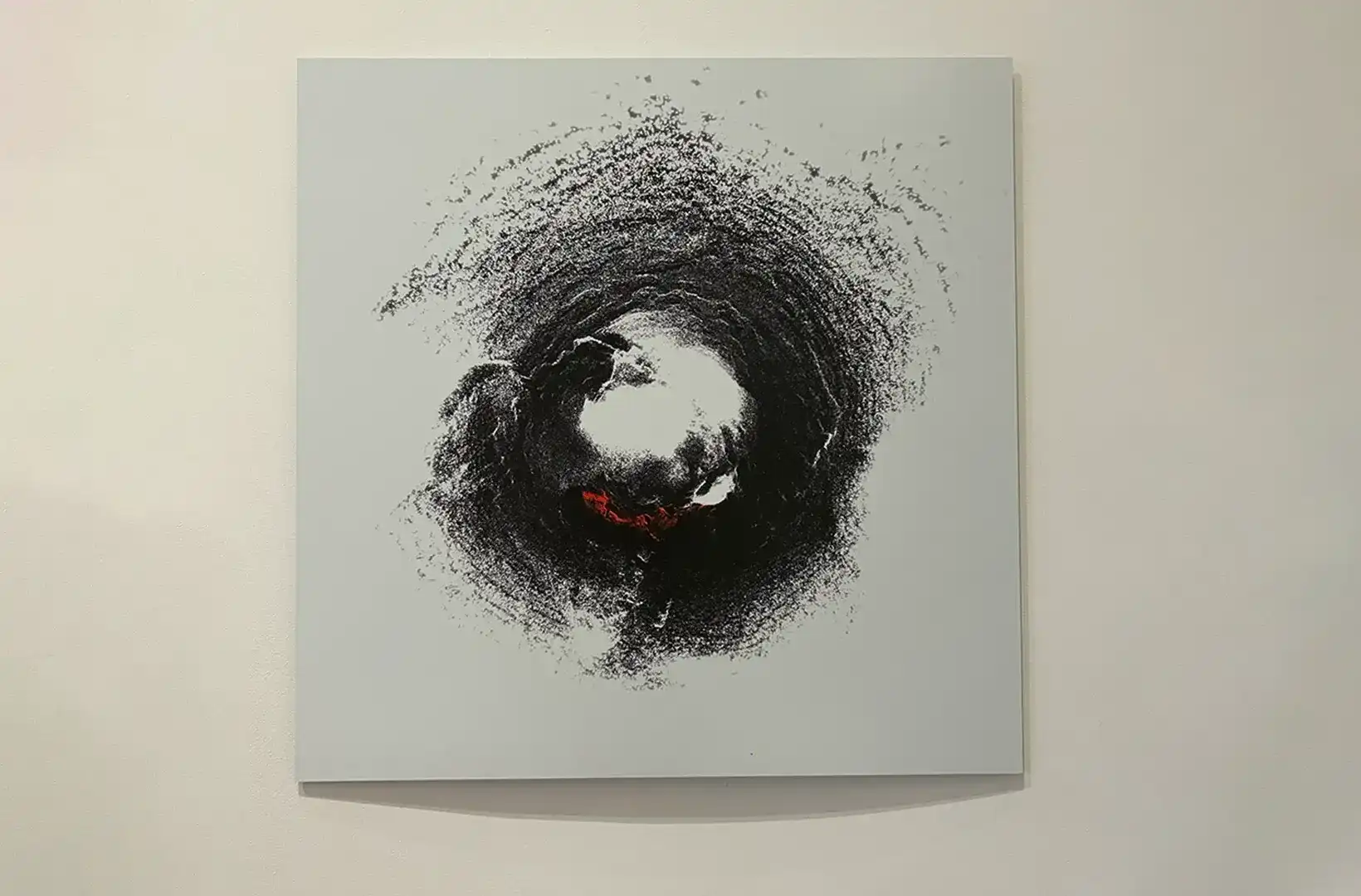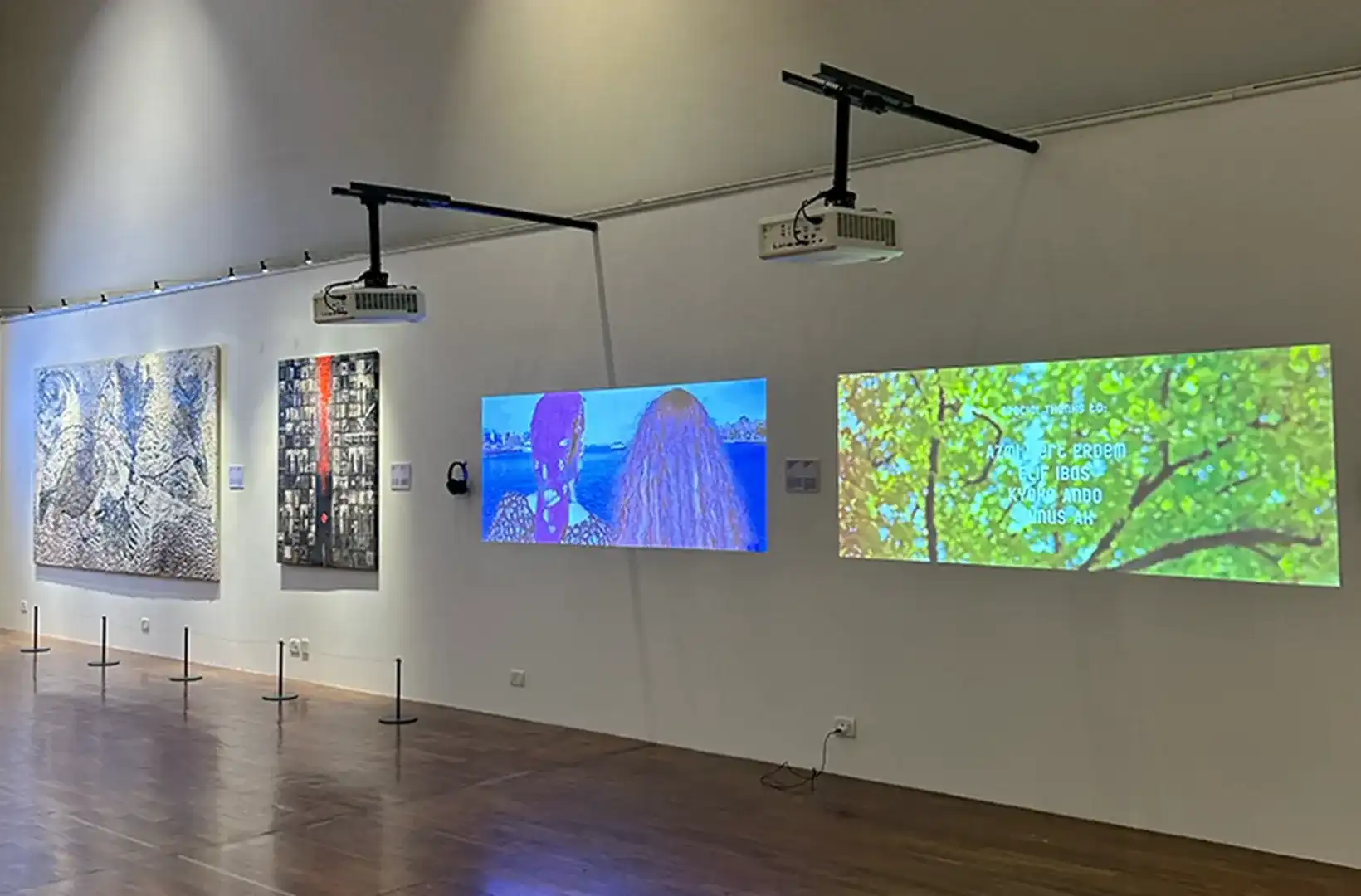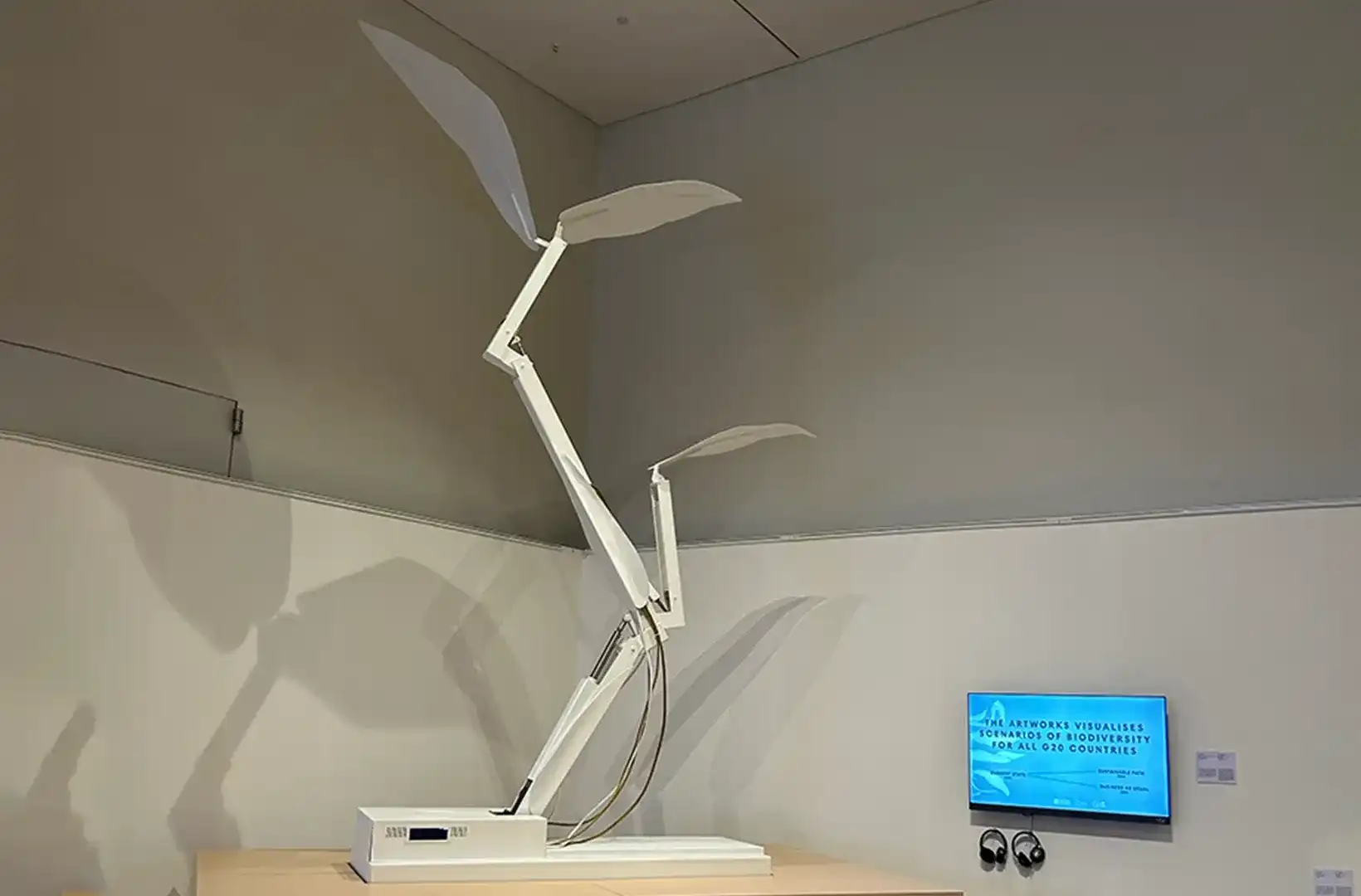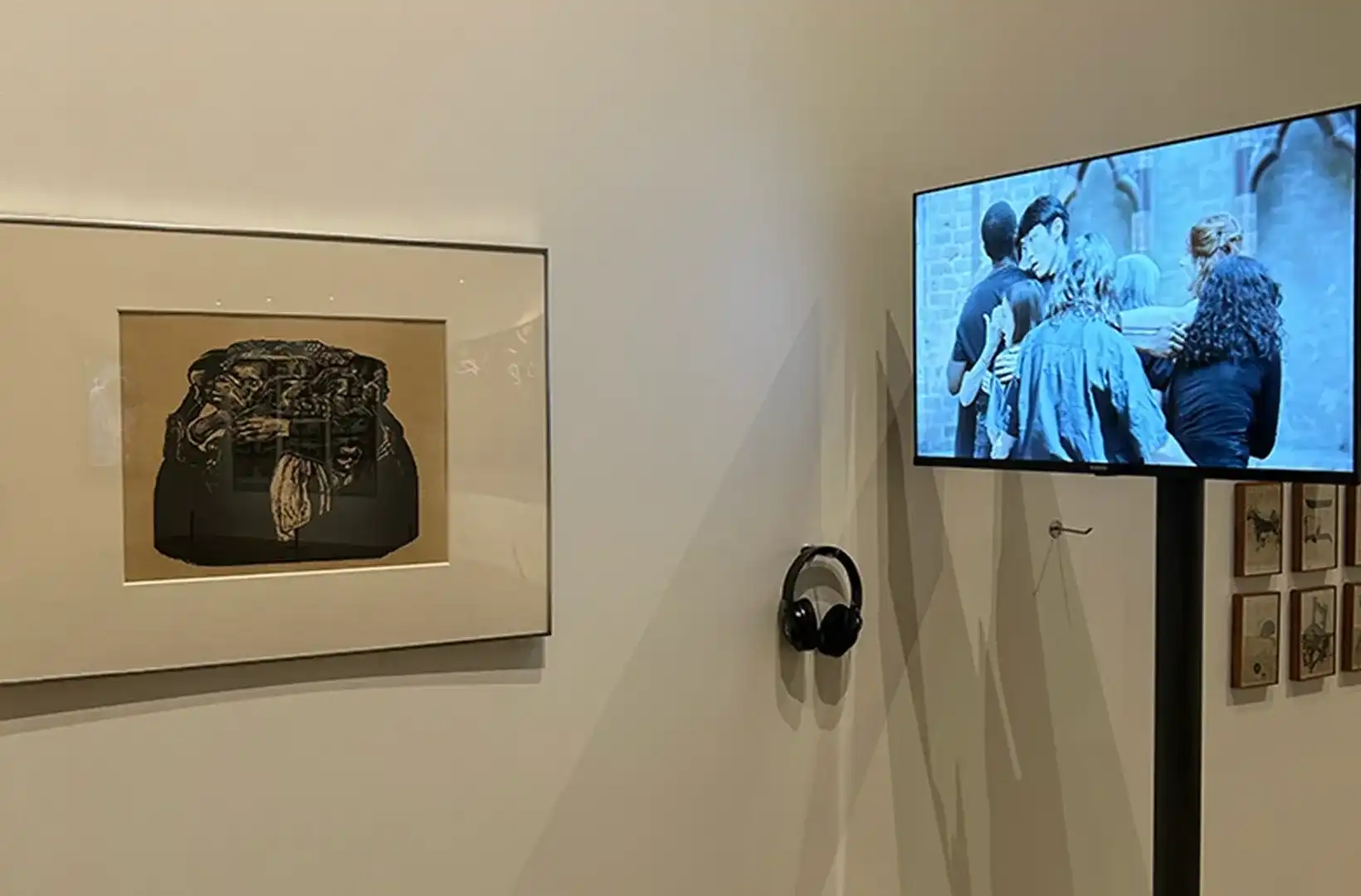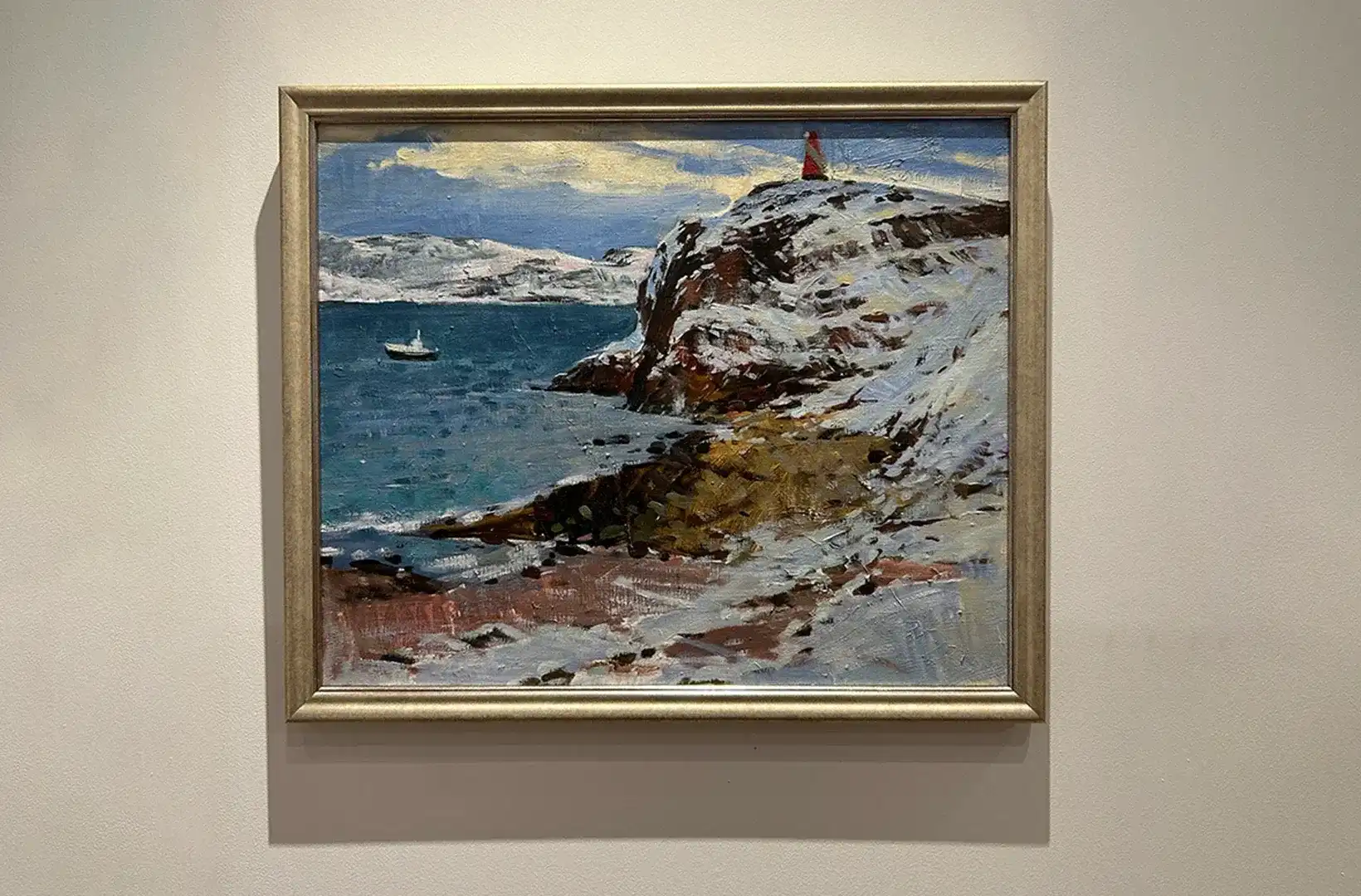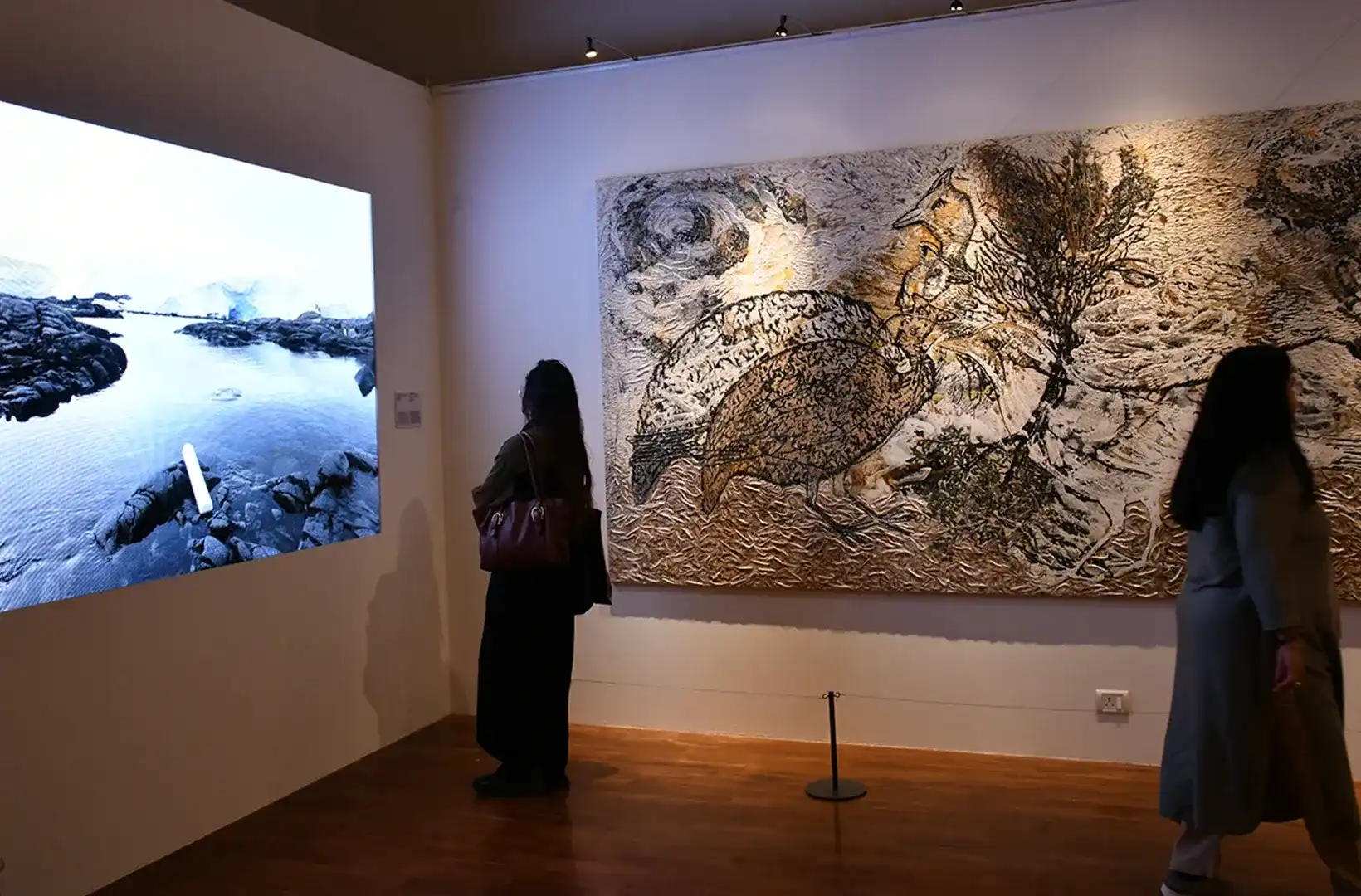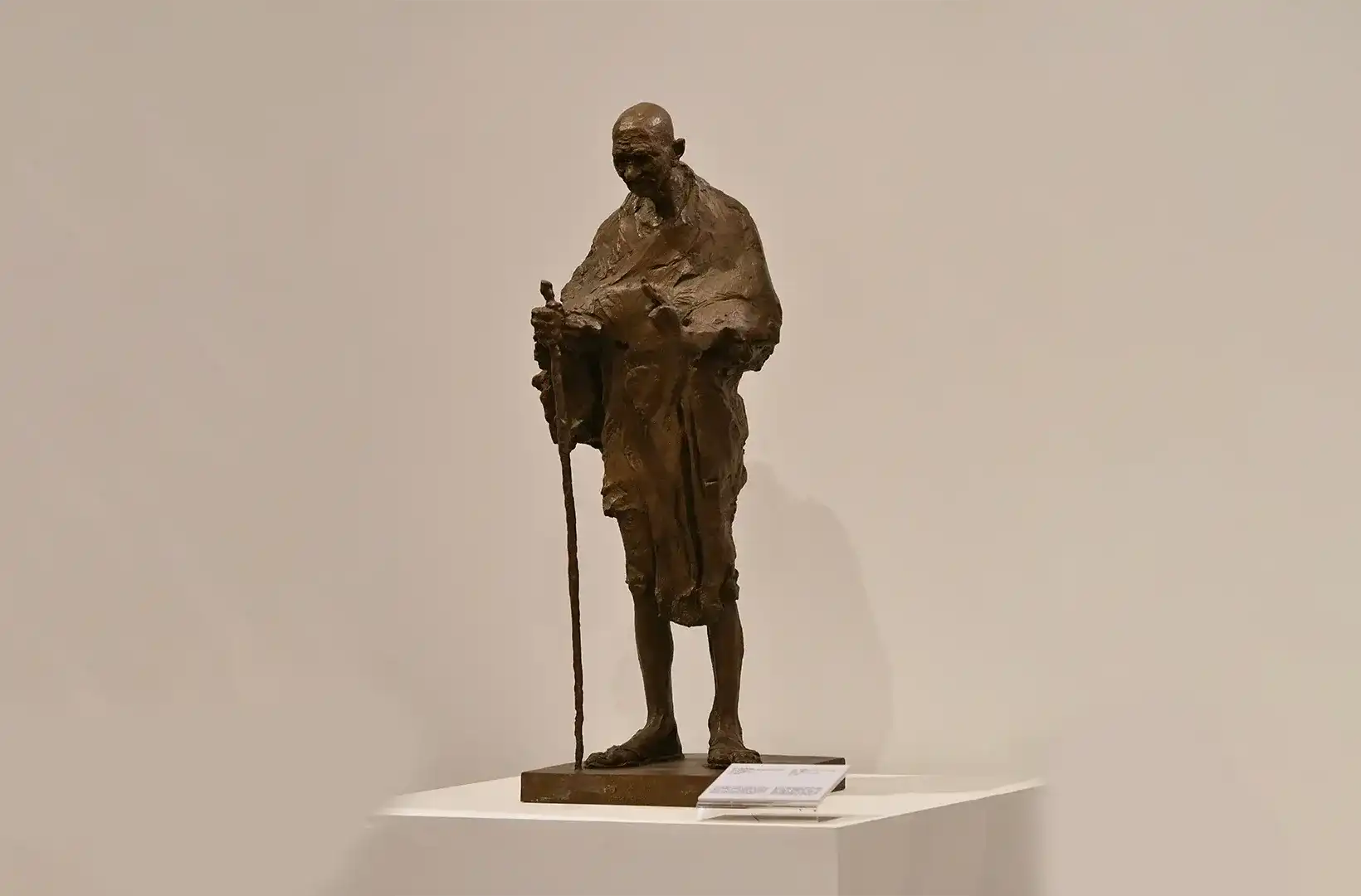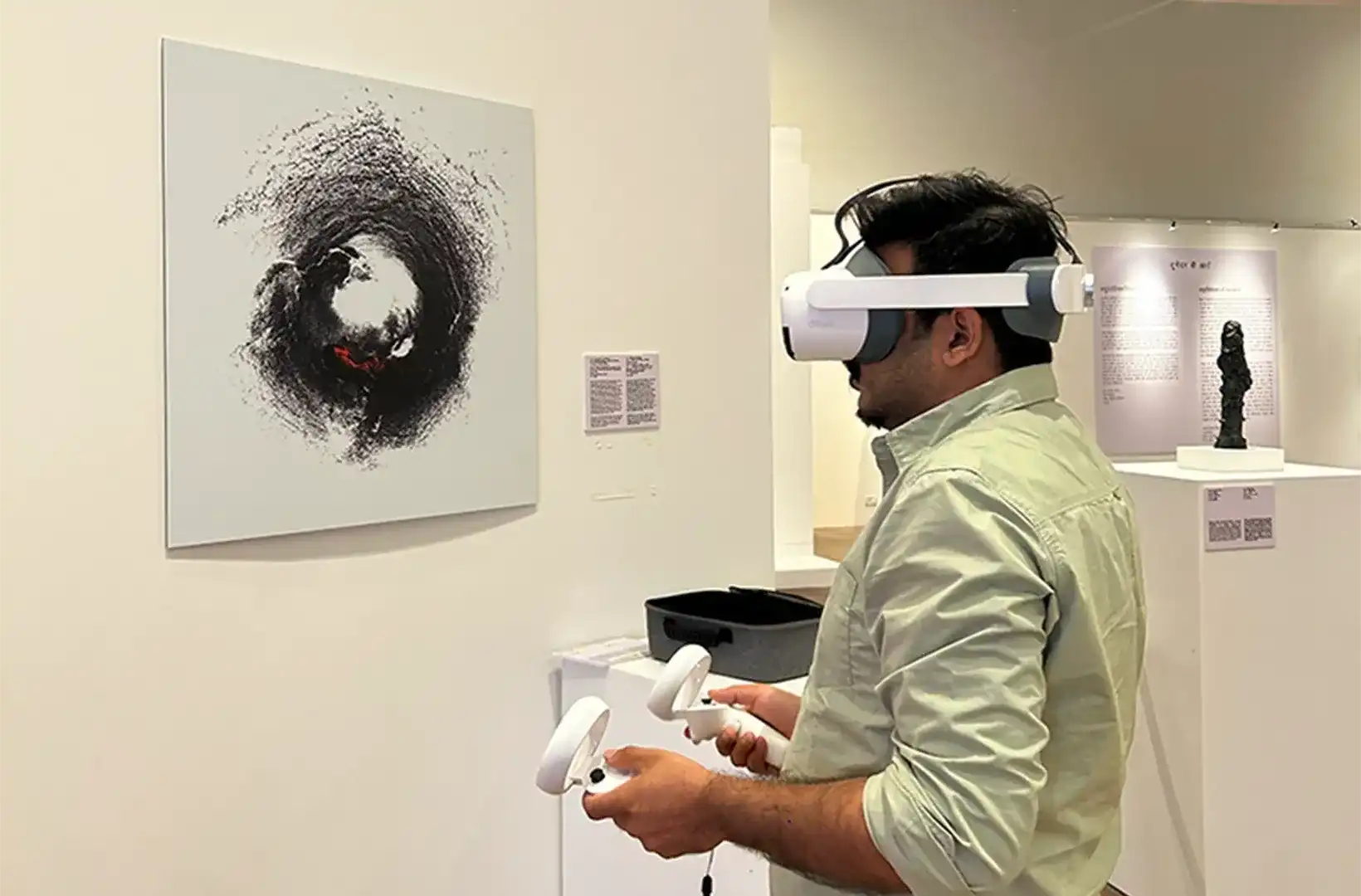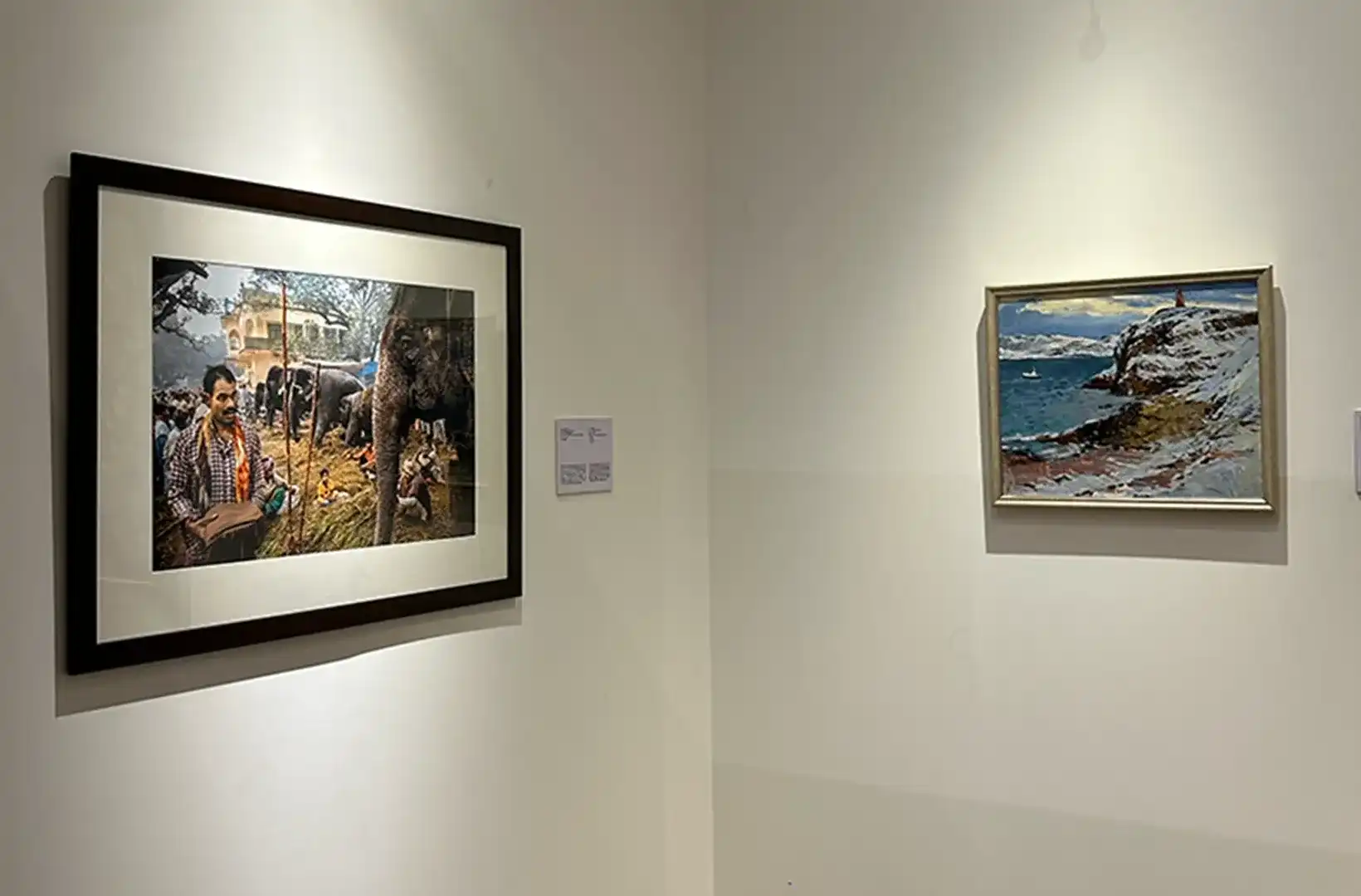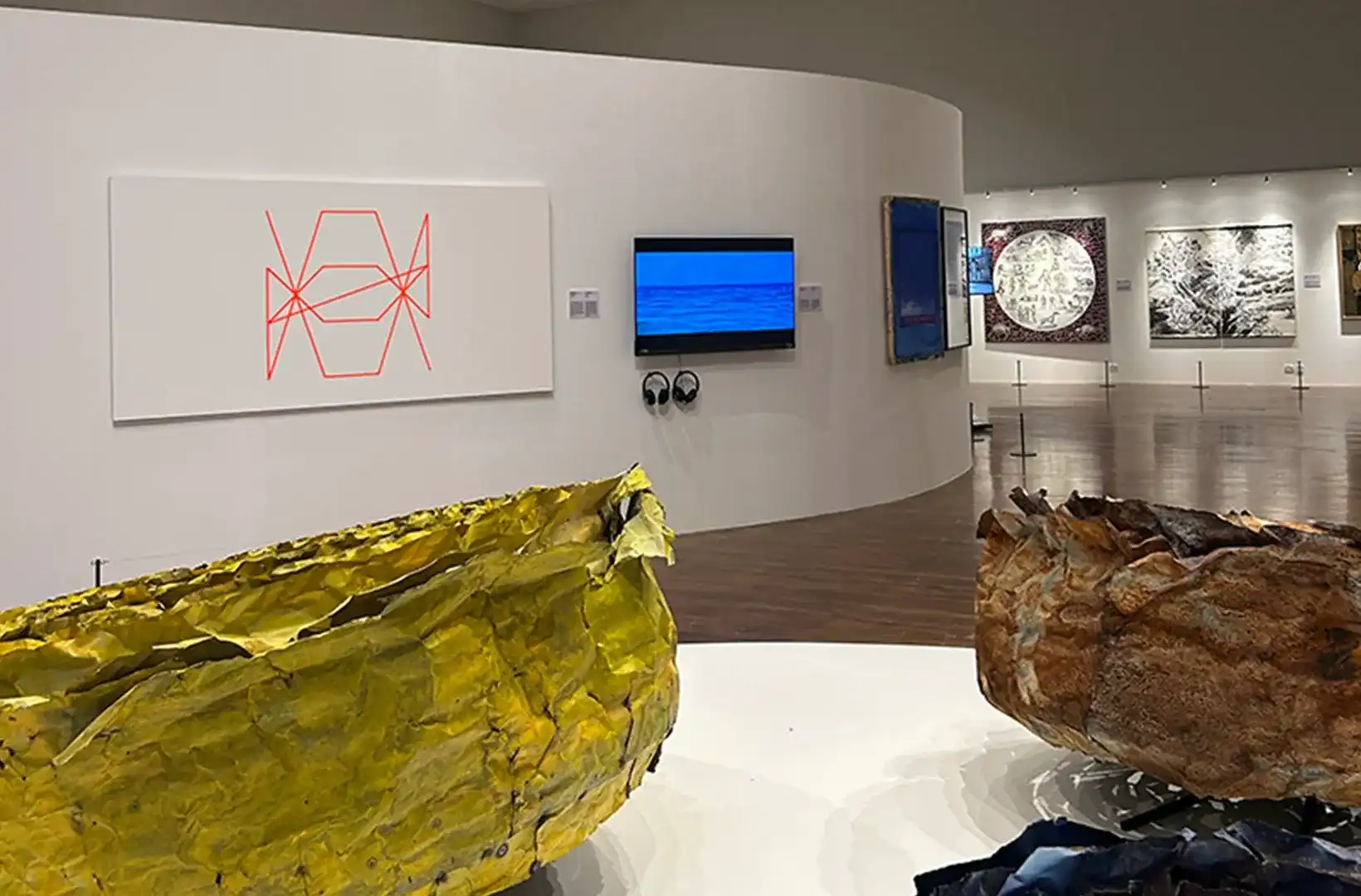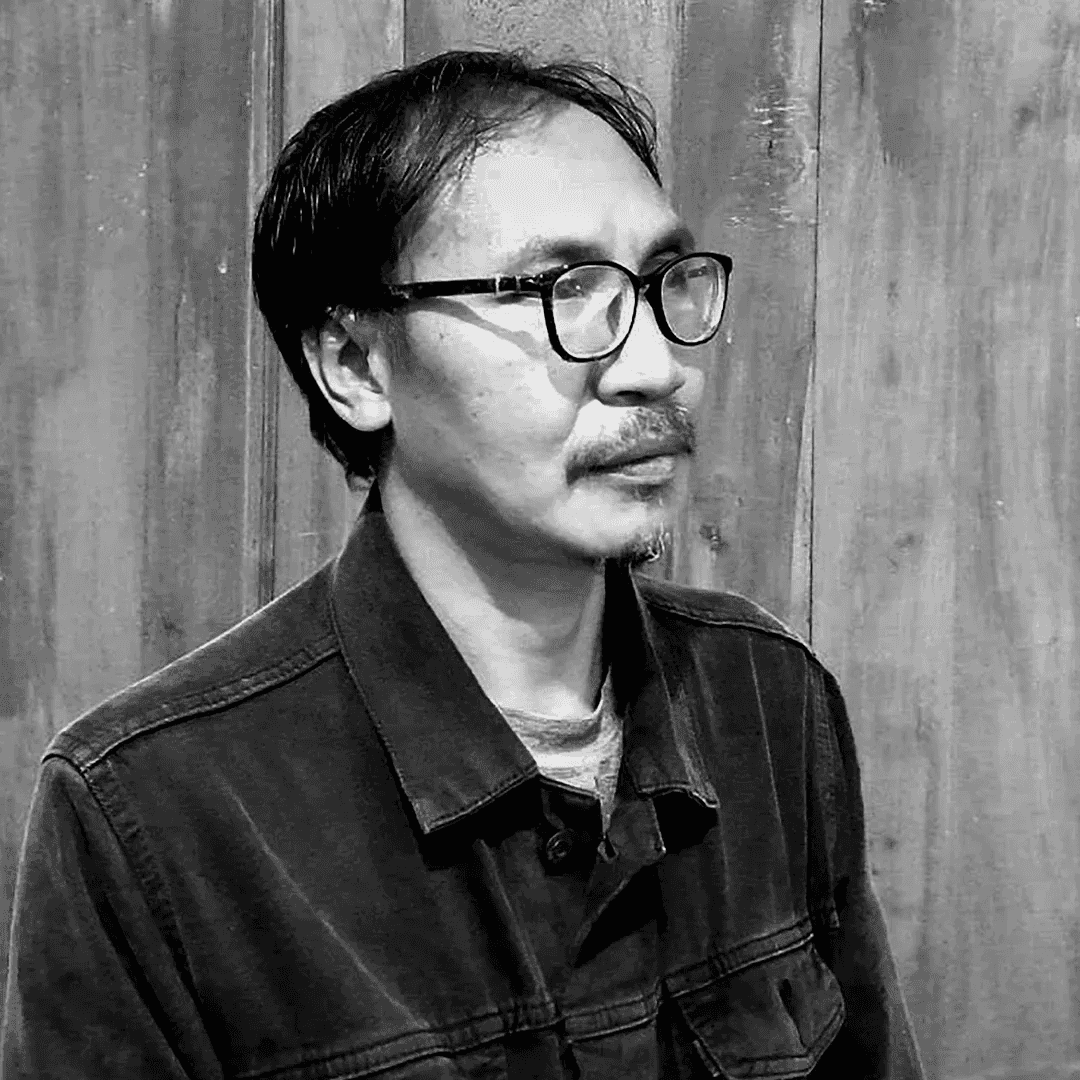
INTRODUCTION
Faisal Kamandobat, born in Cilacap, Central Java, Indonesia is a poet, writer and visual artist. He studied anthropology at the University of Indonesia and currently works as a researcher at the Abdurrahman Wahid Center for Peace and Humanities, Universitas Indonesia (AWCPH-UI), Jakarta. He founded Matur Nuwun Studio in his hometown as a centre to develop the villagers’ creativity. As a researcher, he specialises in conducting ethnographic studies on the intricate relationship between religion and the state, women and the economy, and the interplay between tradition and globalization. From his teenage years, he has delved into the realm of poetry, publishing his works in various media and anthologies. His artistic journey in the fine arts has been shaped by influential figures such as Heri Dono, Nasirun and Samuel Indratma. His visual creations predominantly take the form of manuscripts, intertwining literature and fine arts, as they draw inspiration from Sufi knowledge, tradition and modern science. Embracing a contemporary approach, his visual style reflects a progressive evolution of folk art in the region. Beyond his research endeavours, he actively participates in literary gatherings and organises introductory exhibitions for emerging artists. He engages in art exhibitions and “wayang” (puppet) performances at esteemed venues like the National Gallery of Indonesia, Jakarta and the International Puppet Exchange, supported by the Asia Center and the Japan Foundation. His multifaceted interests encompass environmental issues, the impact of technology and the economy, and also moves into the realms of human cosmology and spirituality.
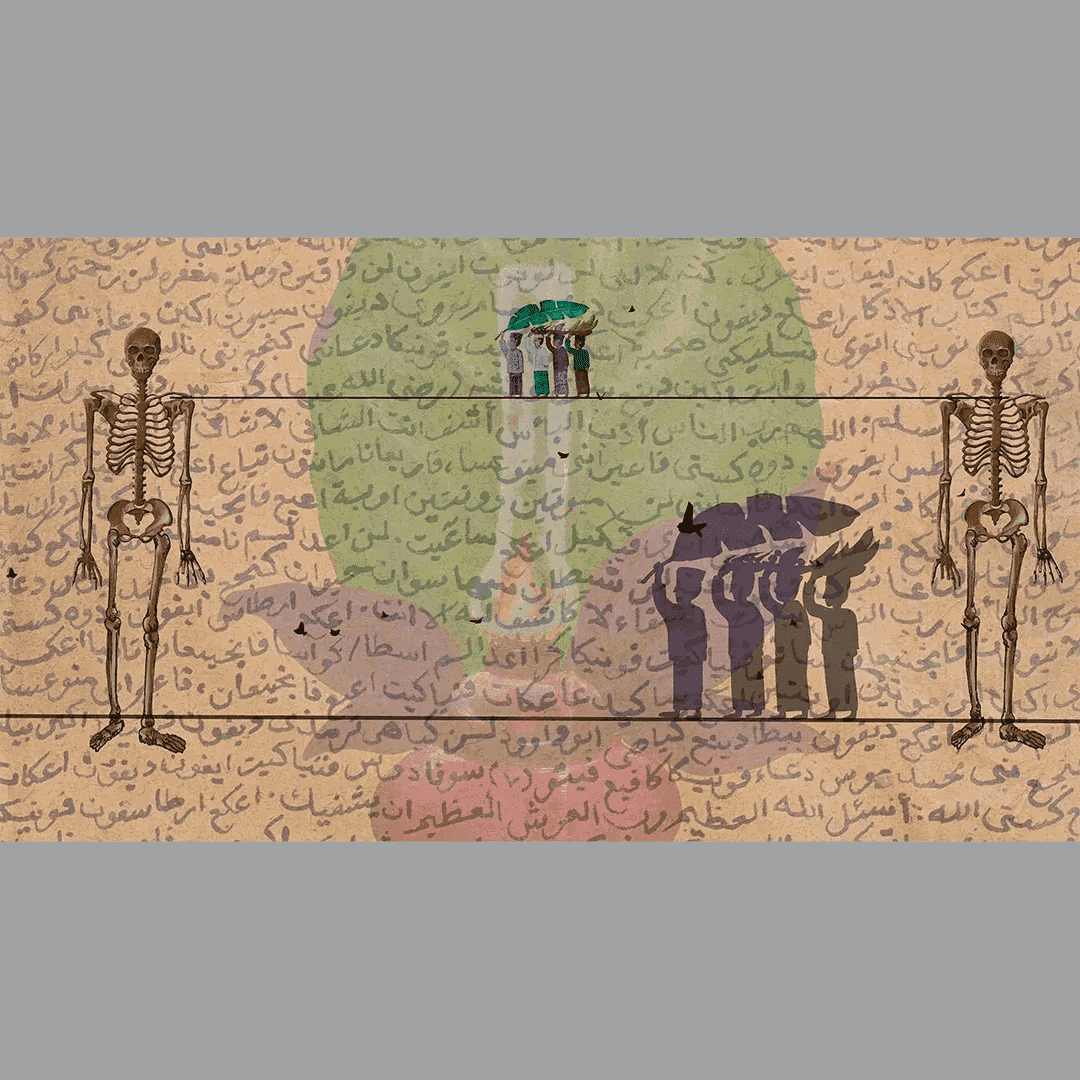
ABOUT THE ARTWORK
Bridges of Cosmologies, Medium: Video, Duration: 11 min 33 sec, Year: 2023
“Bridges of Cosmologies” aims to bridge gaps and overcome dichotomy and domination while addressing the increasing disconnection and destruction between humans, nature and objects. It proposes a cosmology that goes beyond institutions and global governmentality, allowing for a harmonious co-existence of everything in the universe – humans, stars, nature, spirits and also ideas. A balanced and holistic order is sought where nature, humanity, ideas and sacred realities are recognized as living, sovereign and responsible entities. Art serves as a vital bridge between different cosmologies, fostering imaginative and creative diplomacy between the past and the future. It offers new perspectives to navigate challenging economic and political times, ultimately contributing to the salvation of world history from stagnation. The work, comprised of manuscripts written in Javanese-Arabic letters, delves into ethno-pharmacological knowledge, the history of spice trade routes, and healing prayers in traditional Islamic societies in Indonesia. Through the lenses of biodiversity and cultural diversity, this work portrays Indonesia as a multi-ethnic and religious nation while shedding light on pressing global issues such as environmental destruction, poverty and cultural discrimination. It underscores the importance of mutual understanding and human emancipation as necessary steps towards embracing cultural diversity.
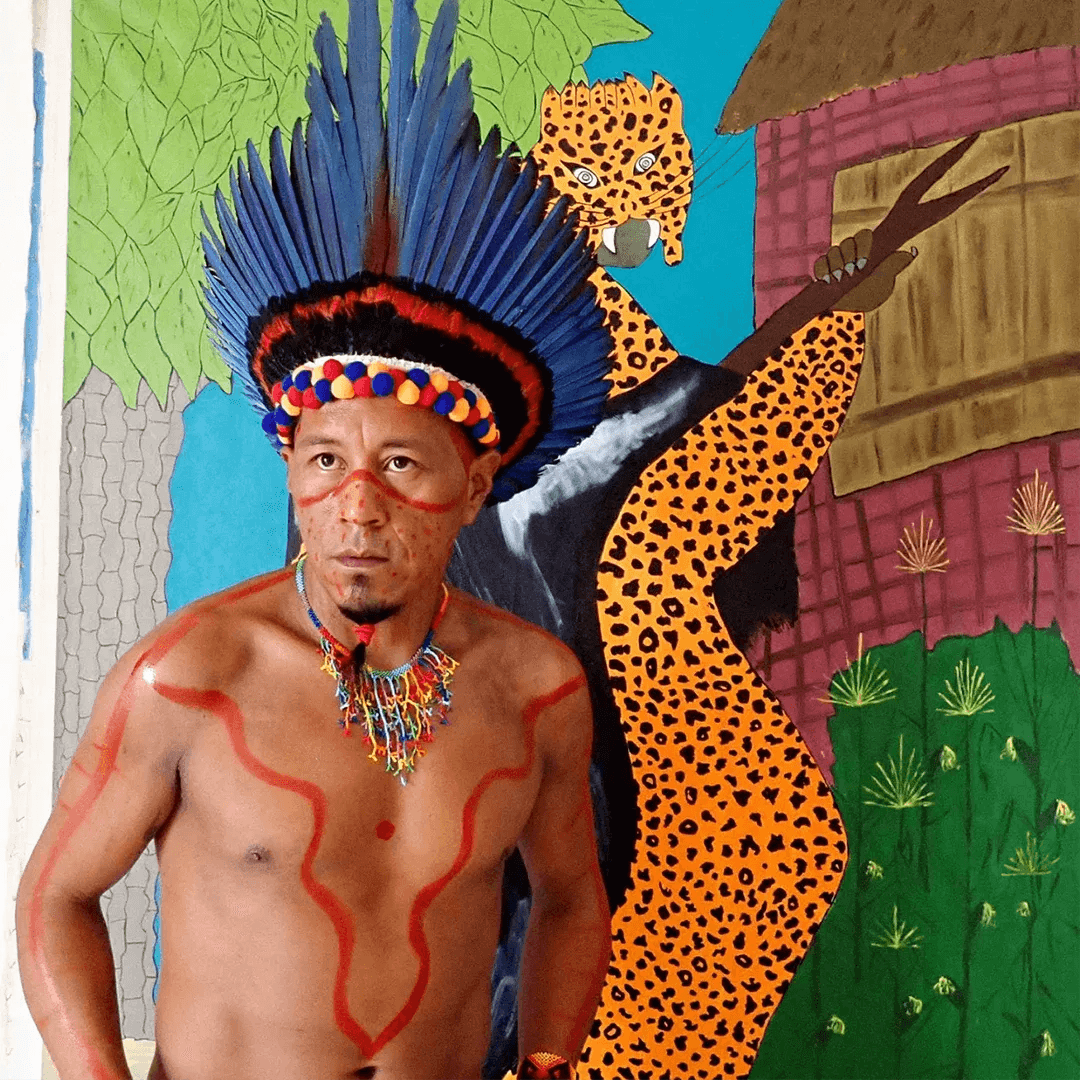
INTRODUCTION
Jaider Esbell, born in 1979 was a multimedia artist and independent curator. His original cosmology and history make up the poetics of his work, in which reflections on mythical narratives and life in the Caribbean Amazon occupy a central place. From the Jaider Esbell Contemporary Indigenous Art Gallery, founded by the artist in 2013 in the city of Boa Vista - Roraima/Brazil, he articulated several initiatives with indigenous artists from the circumroraima region and art-education activities in indigenous, quilombola, riverside and peripheral urban communities. In the field of decolonial criticism, his propositions materialized in artistic practices what is generally experienced strictly in terms of discourse. Defining her production as artivism, Esbell's research combined intersectional discussions between art, ancestry, spirituality, history, memory, politics and the environment.
He was a guest artist at the exhibitions "Véxoa: we know", held in 2020 at the Pinacoteca do Estado de São Paulo; "It's dark but I sing", 34th Bienal de São Paulo in 2021; "Brazilian Stories, at Museu de Arte de São Paulo (MASP)in 2022; "Les vivant", organized by the Cartier Foundation in Lille in 2021; the 59th Venice Biennale in 2022; the 23rd Milan Triennale in 2022; "Siamo Foresta" organized by the Cartier Foundation and Milan Triennale in 2023. As a curator, he organized the group show "Moquém_Surarî: contemporary indigenous art", in 2021 at the Museum of Modern Art in São Paulo (MAM). His works are part of the collection of the Pinacoteca do Estado de São Paulo and the Georges Pompidou Center in Paris - France.
CONCEPT NOTE
"A Guerra dos Kanaimés" ("The Kanaimé's War") is a series of paintings in which Jaider Esbell presents the figure of the Kanaimé, a being known by the indigenous peoples around Mount Roraima for his lethality and infinite capacity to transform his body by wearing the skin of animals and plants , mobilizing their potencies as weapons and spells. On the canvases that make up the set, the artist portrays the body transformations of the Kanaimés, their transit between different worlds and spheres of energy and, especially, the double perspective of their behavior: while being an ally of some, he is still an enemy of others. Based on the experience of relational variation in the spectrum of alliances of these entities, which is widely described in the cosmovision and history of the Makuxi people, Esbell broadens the understanding of the recent intensification of the colonial war over their indigenous territories in the region, also understanding it such as attacks by foreign and predators Kanaimés. The colorful paintings on a black background also evoke the struggle of the indigenous peoples, which not only is constituted by the political defense of their rights, but also does take place on a spiritual level, through traditional shamanic activities and the production of alliances with protective Kanaimés. The series "A Guerra dos Kanaimés" comprises eleven canvases painted with acrylic paint between 2019 and 2020. The works were commissioned by Fundação Bienal de São Paulo, for the 34th Bienal "Though it's dark, still I sing".
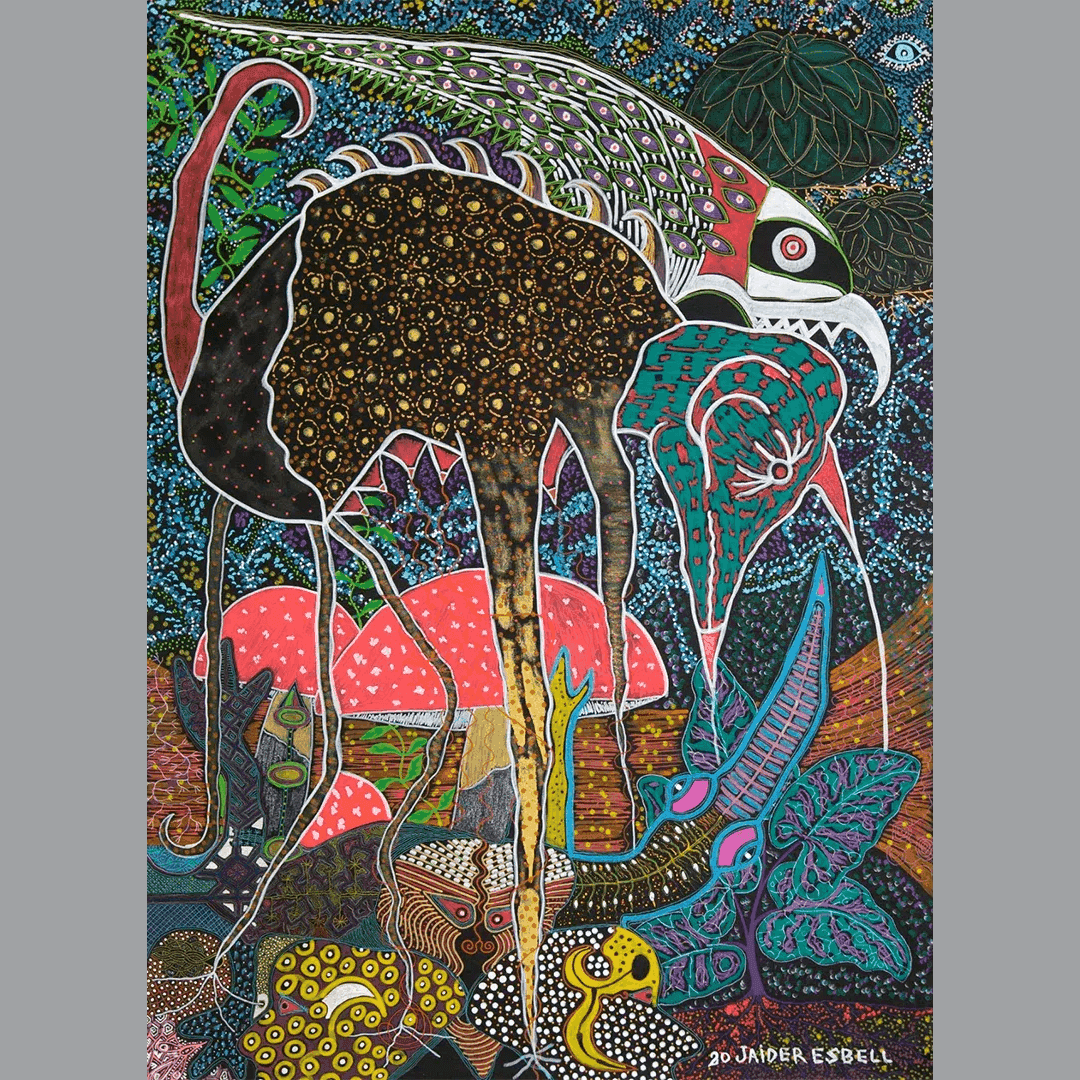
ABOUT THE ARTWORK
Series ‘The Kanaimés War’, Painting number 5, Medium: Acrylic and Posca pen on canvas + Digital reproduction, Dimensions: 110 x 145 cm, Year: 2020
"A Guerra dos Kanaimés" ("The Kanaimé's War") is a series of paintings in which Jaider Esbell presents the figure of the Kanaimé, a being known by the indigenous peoples around Mount Roraima for his lethality and infinite capacity to transform his body by wearing the skin of animals and plants , mobilizing their potencies as weapons and spells. On the canvases that make up the set, the artist portrays the body transformations of the Kanaimés, their transit between different worlds and spheres of energy and, especially, the double perspective of their behavior: while being an ally of some, he is still an enemy of others. Based on the experience of relational variation in the spectrum of alliances of these entities, which is widely described in the cosmovision and history of the Makuxi people, Esbell broadens the understanding of the recent intensification of the colonial war over their indigenous territories in the region, also understanding it such as attacks by foreign and predators Kanaimés. The colorful paintings on a black background also evoke the struggle of the indigenous peoples, which not only is constituted by the political defense of their rights, but also does take place on a spiritual level, through traditional shamanic activities and the production of alliances with protective Kanaimés. The series "A Guerra dos Kanaimés" comprises eleven canvases painted with acrylic paint between 2019 and 2020. The works were commissioned by Fundação Bienal de São Paulo, for the 34th Bienal "Though it's dark, still I sing".
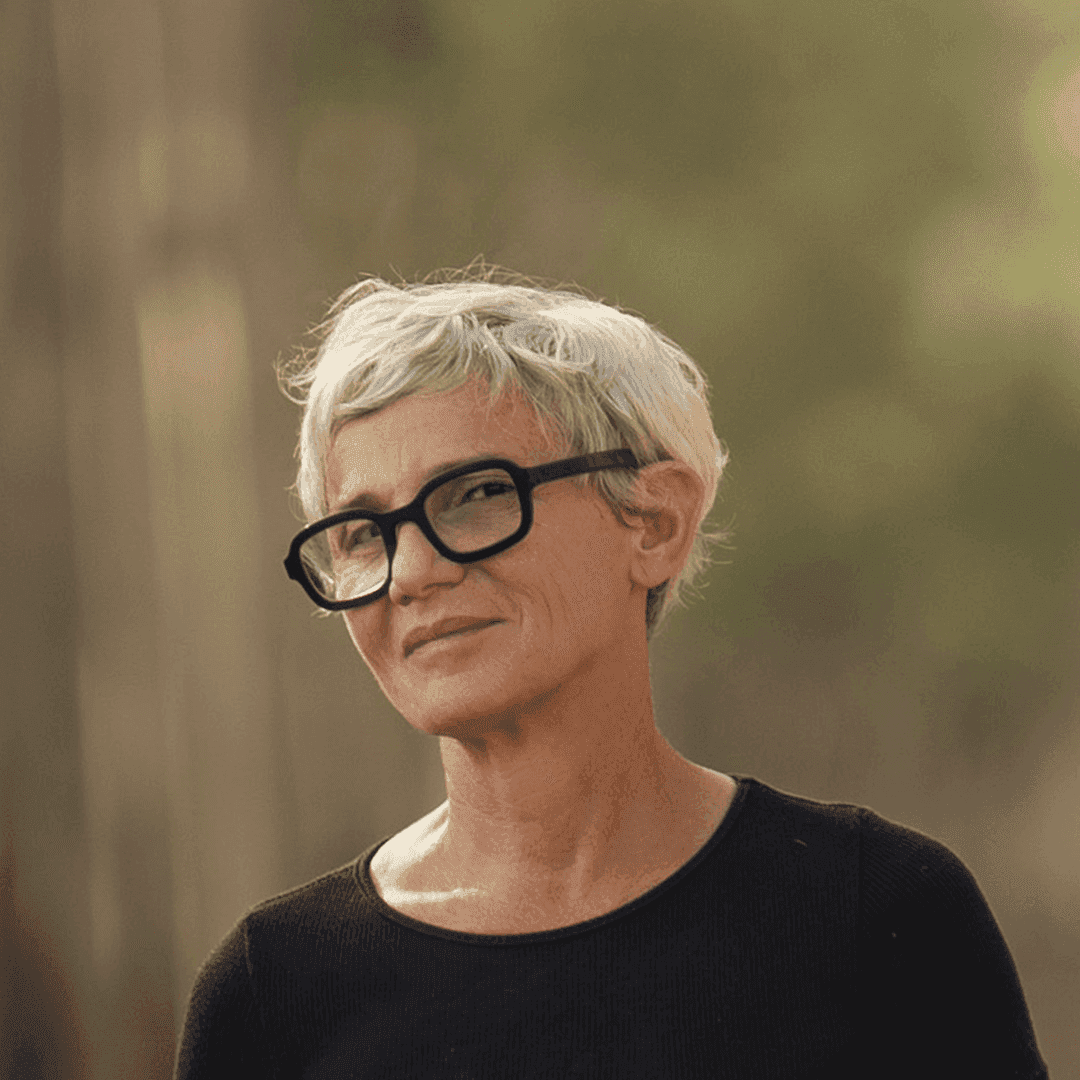
INTRODUCTION
Born in 1965 in Bahía Blanca and raised in Córdoba, she currently lives and works in Buenos Aires, Argentina. Recent solo and group exhibitions of Bustos’ work include América, MARCO Museum, Buenos Aires (2023); Cosmopolis 2. Rethinking the human at Centre Pompidou, Paris, France and Cosmopolis 3 at Museo d’arte contemporanea Madre, Napoli, Italy (2019-2022);The Vision Machine, Exercise 3, Federico Klemm Foundation, Buenos Aires (2018);The Vision Machine, Exercise 2, Nora Fisch Gallery, Buenos Aires (2018);Imago Mundi, 8M2 Contemporary Art, Lima, Peru (2018);The Matter of Photography in the Americas, Cantor Art Center, Stanford University, US (2018);Prosa del observatorio, MUSAC, León, Spain (2017);Who says what to whom, Galería Bacelos, Madrid (2016);Transcultural Flux, Stiftelsen 3’14, Bergen, Norway (2016);Magic Positivism, Galería Ignacio Liprandi, Buenos Aires (2015);ARCO Collection, Moscow Museum of Modern Art (2015);Latin America Roaming Art, NC-arte, Bogota (2014);Conjuring Capital. Conscious Realities, San Art, Ho Chi Minh City, Vietnam (2014);Una línea de polvo: Arte y drogas, Espacio Flacso, Quito, Ecuador (2014);Planos Contrapuestos, MALBA, Buenos Aires (2014) and Beast of Burden, Kimura Gallery, University of Alaska Anchorage, US (2012). Her work is part of many public collections including Reina Sofía Museum, Madrid; ARCO Ifema Foundation, Madrid; Museo de Arte Latinoamericano, Buenos Aires; Museo de Arte Moderno, Buenos Aires; Aciacity Foundation, Singapore; Klemm Foundation, Buenos Aires; Museum of Contemporary Art, Lisbon; Museum of Contemporary Art of Medellín, Colombia and Fondazione Cassa di Rizparmio, Modena, Italy, among others.
CONCEPT NOTE
I have centered my artistic practice on how iconographic and epistemological research can help approach history through non-linear critical terms and envision new articulations for it in relation to the present. Anthropological investigation, scientific research, popular culture, fiction, image assembling, academic and intuitive knowledge, the juxtaposition of multiple epistemological frameworks, the unfolding of official and personal histories, the tension between objectivity and subjectivity and notions of fragmentation are among the tools I use to build new networks of trans historical associations between past and present occurrences.
History generates models of meaning that anchor our present in a series of truths but, in spite of this, history is not a totalizing discourse. It contains within its structure empty spaces, contradictions, chimeras, places of reverie, unconscious territories and hallucinations. These are strategic voids that open up a space that allows for the identification and appropriation of history at the level of the subject.
Searching for these cracks involves shaking up pre-existing and known patterns of connection and rearranging information into new patterns. Any artistic practice that takes history as its subject requires the work of cutting, joining and designing. Something similar to costume design. It is a way to connect incongruent times and distant spaces with our present.
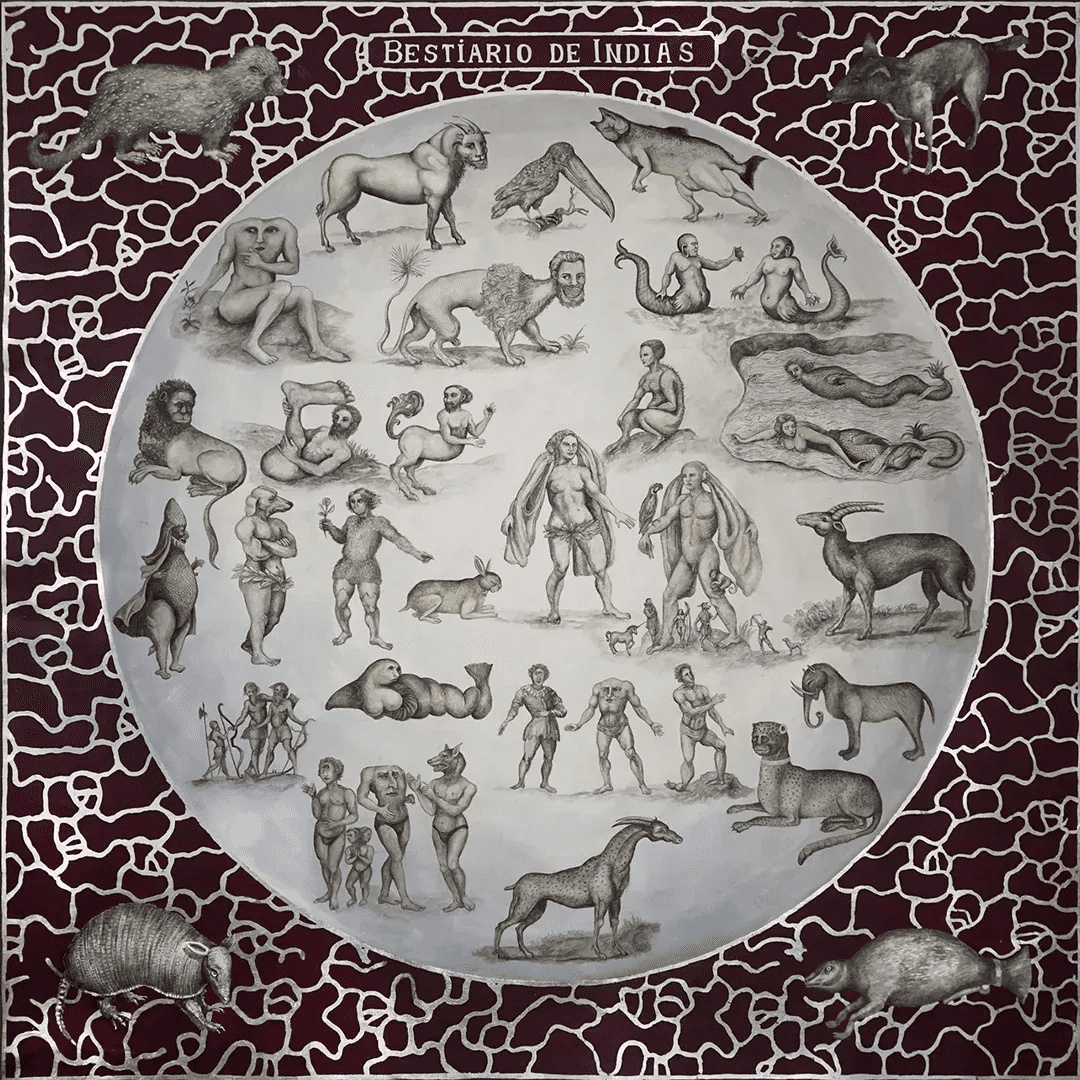
ABOUT THE ARTWORK
Bestiario de Indias, Medium: Acrylic, gouache and silver leaves on canvas, Dimensions: 187 x 187 cm, Year: 2020
“Bestiario de Indias” stems from the images and stories of the first chroniclers who arrived in what became known as the Americas. The representations and descriptions they developed, show them immersed in a hallucinatory world of dreams in which men and women, plants and flowers, stones and landscapes merge into enigmas that hide and reveal the desires, fantasies, and terrors of humanity.
The genealogy of these exuberant visions is inscribed in the bestiaries of the Middle Ages. The colonial imaginary that marked the gaze of the chroniclers was undoubtedly a medieval European one. A subsequent switch took place when it became clear that the monstrous beasts did not really exist. The monstrosity and dangerousness were then assigned to the indigenous inhabitants of those lands, so as to justify the unprecedented domination and massacre that took place.
I am interested in how humanization becomes a constant element in the representation of monsters, giants, pygmies, mermaids and hybrid beings: how it speaks of the relationship of human beings with nature and with the culture of the time and invites us to accept the validity of the anthropocentric view of nature in our culture and in what we believe to be the real nature of the world.
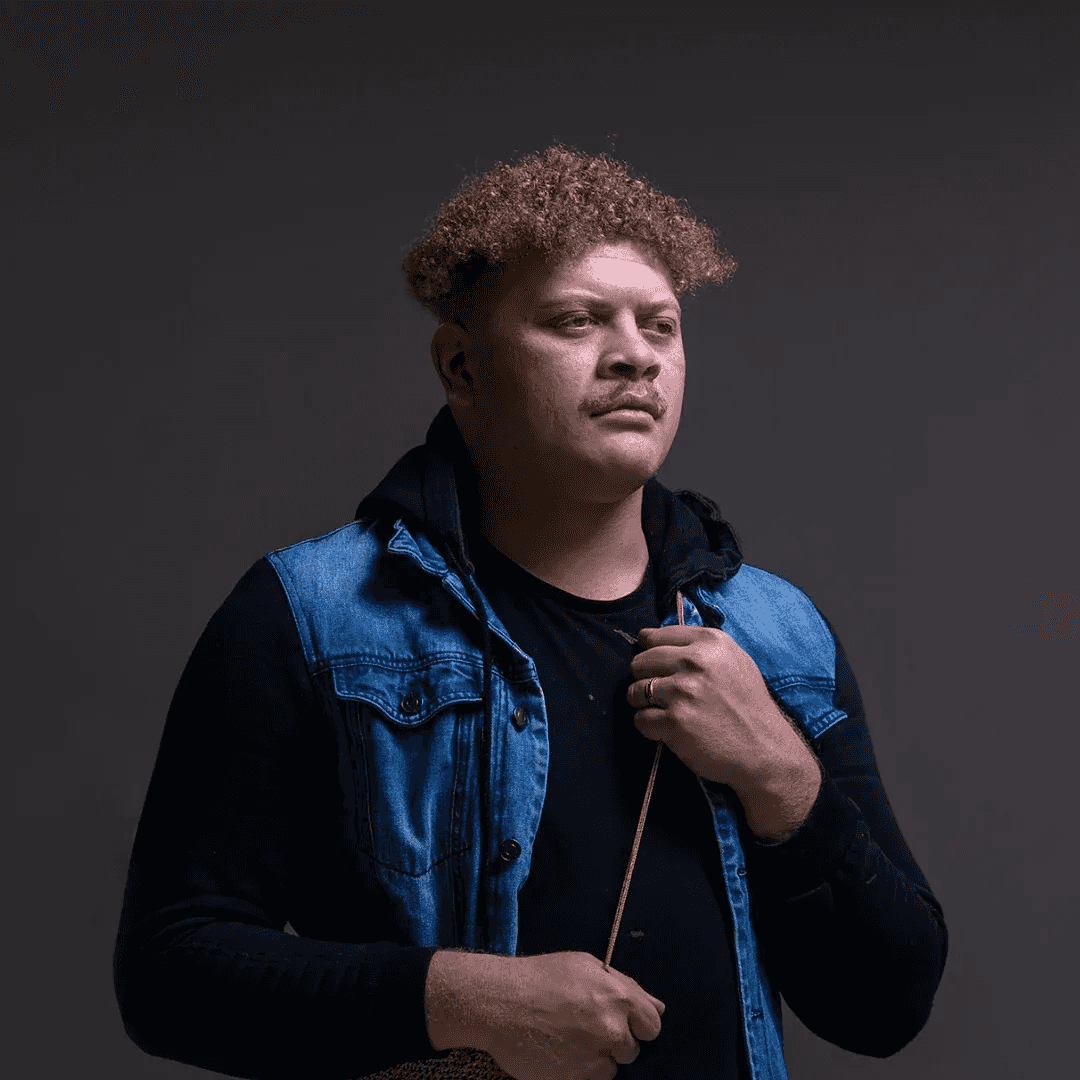
INTRODUCTION
Dylan Mooney is a proud Yuwi, Torres Strait and South Sea Islander man from Mackay in North Queensland working across painting, printmaking, digital illustration and drawing.
Influenced by history, culture and family, Mooney responds to community stories, current affairs and social media. Armed with a rich cultural upbringing, Mooney now translates the knowledge and stories passed down to him, through art. Legally blind, the digital medium’s backlit display allows the artist to produce a high-impact illustrative style with bright, saturated colour that reflects his experiences with keen political energy and insight.
This blending of digital technology and social commentary is a uniting of the artist’s sense of optimism – pride within the works exude with profoundness and substance.
Dylan is among artists who are rethinking digital technologies and artistic practices to consider contemporary issues around identity, desire and representation. Interested in the ways in which we can reframe the conversation around some of the voices that have been left out, the artist has made an important body of work that embodies a shift in representation of queer love among people of colour.
** CONCEPT NOTE**
Intertwined investigates our relationship with native flora and by extension, Australian culture. Rather than focussing on cuttings and arrangements in the still life genre, Mooney’s digital illustrations observe living plants as a way of highlighting the continuation of Indigenous culture, resistance to introduced species, and connection to Country — redefining the still life genre by celebrating resilience. Intertwined presents new work combining Dylan's digital illustrations with hand-painted ochre sourced from Yuwi Country. This blending of digital technology with traditional materials unites of the artist’s sense of optimism – pride within the works exude with profoundness and substance.
COLLECTIONS
- National Gallery of Victoria
- Art Gallery of New South Wales
- Queensland Museum
- Museum of Brisbane
- Mackay Artspace
- Redland Art Gallery
- Artbank
- University of NSW
- Australian Queer Archives
- Brisbane City Council
- Queensland Performing Arts Centre
- Queensland Children’s Hospital
- Macquarie Bank Collection
- Slattery Collection
- Denholder Gibson Collection
COMMISSIONS
2023 Still Thriving Mural, Sydney World Pride, Darlinghurst 2022 Brisbane Powerhouse, ABC Kids – Murringa Lullaby, Art Collector Magazine's 99th issue - Jan-March Cover, Microsoft Pride Campaign, Telecom Pride Campaign, Cross River Rail mural, Brisbane, Queensland University of Technology mural, Brisbane, Mackay Regional Council Library mural, Ben & Jerry’s ‘This is Our Whirled’ ice cream packaging 2021 Rolling Stone – December Cover, Google – Doodle Celebrating Pearl Gibbs, Instagram – featured artist for Mardi Gras, The Wall mural commission, Mackay Art Space 2019 Gamma Festival mural, Brisbane City Council, Queensland Performing Arts Centre UnEarthed mural, QPAC, Where We Stand mural, Charleville 2017 Eagle Junction Station mural, Queensland Rail 2014 G20 ‘BRISBANE’ sign, Southbank Parklands
AWARDS & GRANTS
2020 Mackay Artspace Foundation Bursary
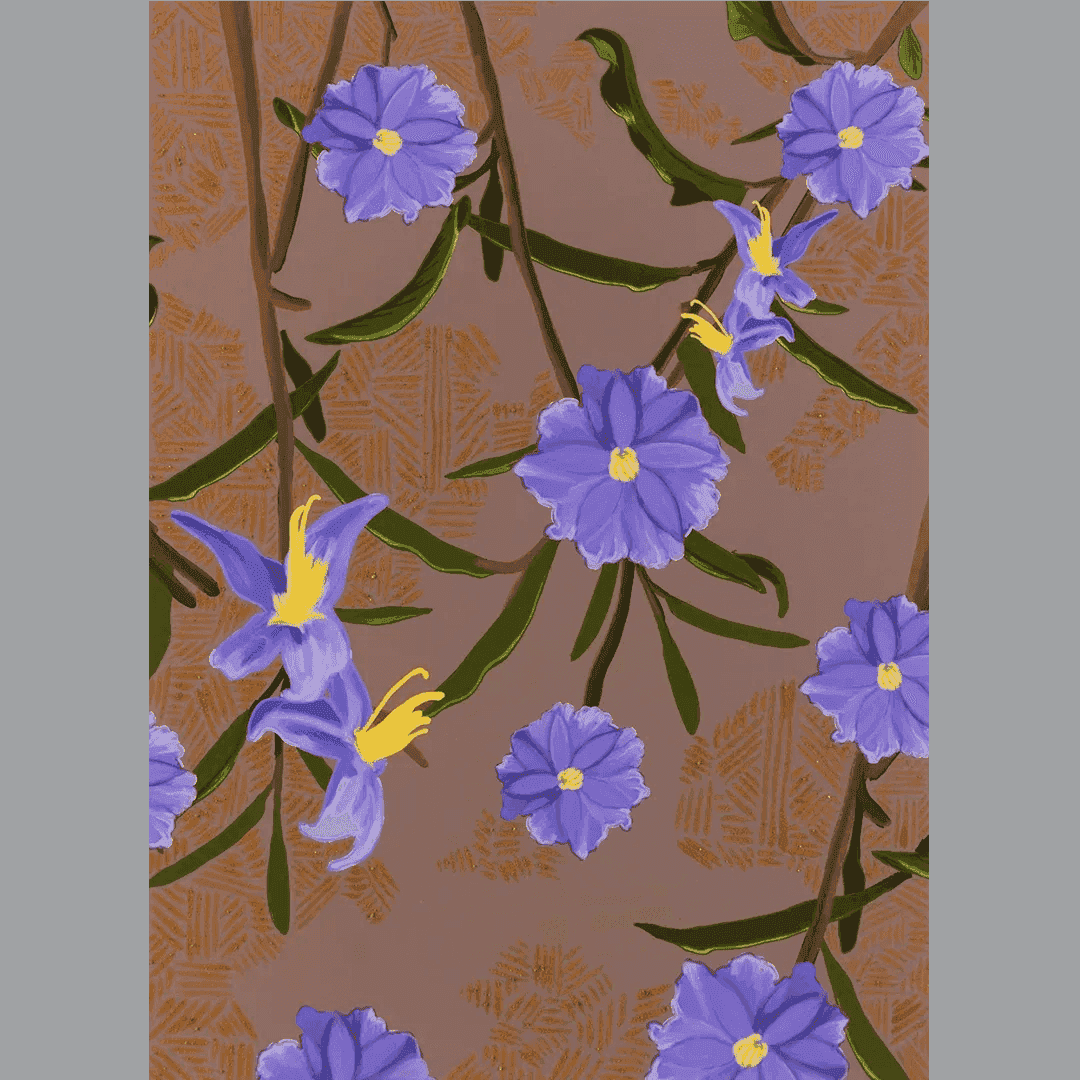
ABOUT THE ARTWORK
Solanum Graniticum – Granite Nightshade, Medium: Digital illustration and hand-painted Yuwi ochre, Dimensions: 120 x 88 cm, Year: 2021
This work is based on the still-life genre. Digital drawings illustrating local flora in bright, luminous colours are then hand-painted with Yuwi ochre from his native country. A tension between Linnaean-type naming and traditional indigenous knowledge is at the heart of the print. The work shows a mastery of rhythmic patterns and complex colour combinations. As Mooney grew up with rich cultural nurturing, his vibrant creations are a way of translating the knowledge and stories passed down to him. His work has been included in the National Gallery of Victoria Queer exhibition and Biennale of Sydney: Rivus. His work is represented in the collections of the Queensland Museum, Museum of Brisbane and Artspace Mackay, Queensland among other regional and private collections.
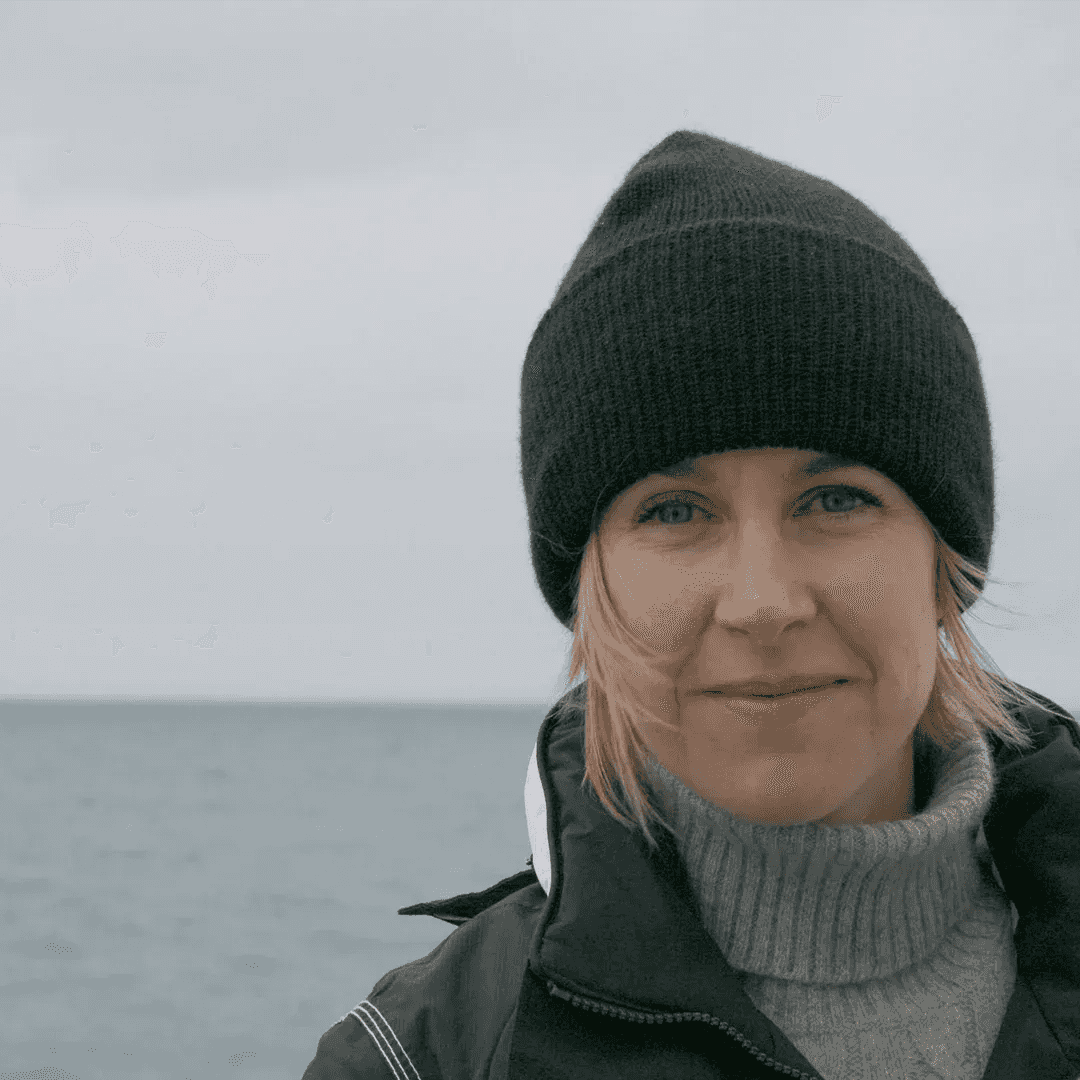
INTRODUCTION
Jessica Houston journeys from pole to pole, employing oral narratives, photography, objects, painting, and video as her mediums. Her focus lies on climate change and social justice issues, particularly emphasizing the deep time of ice and collaboration with nature. Through her research-based practice, Houston engages with poets, penguins, scientists, and philosophers to uncover and illuminate the geographies of resistance in the Canadian Arctic, Antarctica, and Iceland. Select solo and group exhibitions include 1,000 Years, at the Vanderbilt University Fine Arts Gallery, in Nashville, Tennessee, USA (2024); Territoires sous observation, at the Museo de Arts de Querétaro, in México (2023); Terra Nova, at the CREA Gallery, in Venice, Italy (2022); Ecologies: A Song For Our Planet, at the Montreal Museum of Fine Arts, in Montréal, Canada (2021); Dear Future…, at the University of Northern Colorado Gallery, in Greely, Colorado, USA (2020); I Beseech You: Women, Art, Politics and Power, at the Schmucker Art Gallery, Gettysburg College, in Gettysburg, Pennsylvania, USA (catalog) (2020); and The Call of Things, at the The Arktikum Museum, University of Lapland, in Rovaniemi, Finland (2019). Houston has created site-specific works for the New Jersey MOCA, in Asbury Park, New Jersey; the Castello di Corigliano, in Puglia, Italy; Governors Island, in New York City, New York; The Albany Airport, in Albany, New York and The Lewis H. Latimer House Museum, in Flushing, New York. Her works are funded by the Canada Council for the Arts and are in the collections of the Prêt d’oeuvres d’art, Musée national des beaux-arts du Québec; the Bibliothèque et Archives nationales du Québec, in Montréal, Quebec; the Bank of Montreal, in Toronto; the Canada Council Art Bank; and the Consulate General of Monaco. Website: jessicahouston.net
CONCEPT NOTE
Letters to the Future is a 1,000-year collaboration with ice and with people across disciplines, including posthumanist philosopher Rosi Braidotti, Inuk leader Okalik Eegeesiak, composer Arvo Pärt and physicist Carlo Rovelli.
Artist Jessica Houston has called upon a variety of voices across disciplines to write a handwritten letter to the future. The contributors’ letters were placed in a time capsule that was buried in the Queen Maud Land ice sheet by scientist Alain Hubert, chief operator at the Princess Elisabeth Antarctica Station. It is anticipated that the time capsule will emerge in roughly 1,000 years, after being carried by the ice to the sea. Except for the authors themselves, no one from the present has seen the letters.
The substances of the planet are vital materials of this artwork, which asks us to imagine our time and our place in the history of the Earth with renewed sensitivity.
Letters to the Future – Antarctica, 3019 was recently acquired by the Canada Council Art Bank to celebrate its 50th anniversary. Since 1972, the Canada Council Art Bank has been making contemporary Canadian artwork available to a wide public across Canada and internationally through three programs: corporate art rental, loans to museums, and outreach activities. With more than 17,000 artworks by over 3,000 artists, the Art Bank has the largest collection of contemporary Canadian art in the world. It houses paintings, sculptures, drawings, photographs and prints by emerging and established artists, including a significant number of artworks by Indigenous artists. Through its effort to build a dynamic and inclusive public collection, the Art Bank celebrates the vibrant and essential role that the arts can play in bringing about social change.
For more information on Letters to the Future, visit: lettertothefuture.netTo learn more about the Canada Council Art Bank, visit artbank.ca
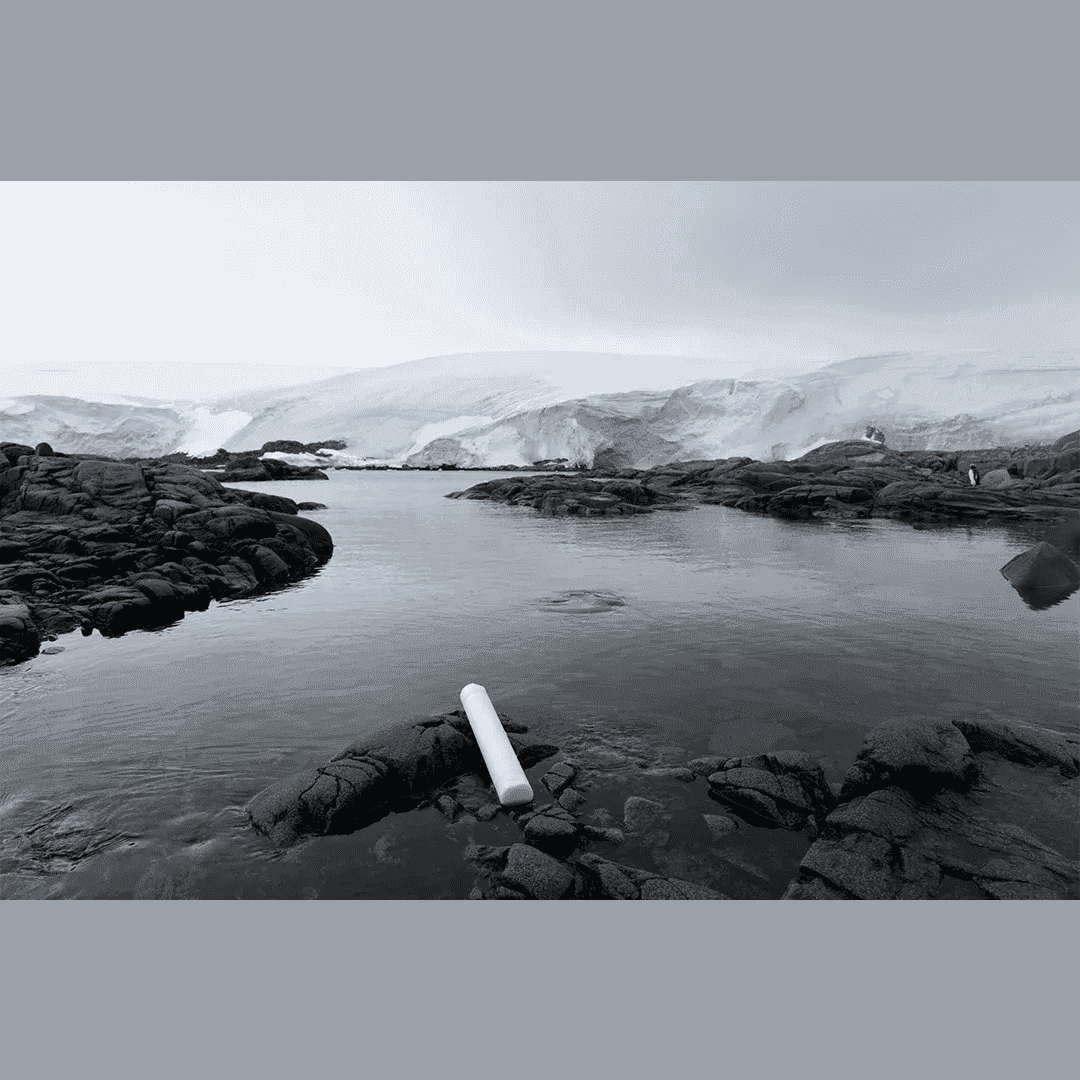
ABOUT THE ARTWORK
Letters to the Future – Antarctica, 3019, Medium: Archival Digital Print + Digital reproduction, Dimensions: 122 x 183 cm, Year: 2020
In February, 2019, Alain Hubert, founder of The International Polar Institute, deployed the time capsule at latitude 70.5700 S, and longitude 23.6086 E, in the Dronning Maud Land region surrounding The Princess Elisabeth Antarctic Station, the world’s first zero-emission scientific station.
Letter to the Future is a 1,000-year collaboration with ice to provoke consideration of our present and the possibilities for our future. Contemporary thinkers across disciplines have written a letter to the future that has been put inside a time capsule and deposited in a glacier in the Dronning Maud Land in Antarctica. It is anticipated that the container will emerge in roughly 1,000 years. Except for the authors themselves, no one from the present has seen the letters. I have called upon a wide variety of voices across disciplines to write a handwritten letter to the future. The contributors have written their letters with archival materials and each author has chosen their language; some have made drawings. Letter to the Future brings together cultural, philosophical, environmental, and scientific collaborators in a work carried by ice and time. The work is beyond any one individual, both in time scale and in ideologies, and it is beyond the human. The substances of the planet are vital materials of this work, which asks us to imagine with renewed sensitivity our time and our place in the history of the earth as the messages withdraw into the future. Letter to the Future is an affirmative gesture that provokes consideration of the state of our times and the possibilities for our future. It asks people to consider oneself in the context of the planet – in relation and in responsibility. If the present is both a record of what we are ceasing to be and what we are in the process of becoming, Letter to the Future is a proposal to build knowledge across a human and beyond-human spectrum, in convergence with ice and time.
Deployment: Additional Support: Dr. Bruno Tremblay, climate scientist at McGill University, has provided invaluable insights and resources. Ice velocity data from a 1.5 million year simulation of the Antarctic ice sheet (Pollard and De Conto, 2012; DeConto and Pollard, 2016; Gomez, Pollard and Holland) has been helpful in determining the deployment location to obtain the desired 1000-year time scale.
Time Capsule: The time capsule, donated by RBR, is a Conductivity Temperature Depth (CTD) container, an oceanographic instrument typically used to measure salinity/temperature and depth weighing 1 kg and measuring 40 cm x 6.4 cm. The capsule is designed to sustain a hydrostatic water pressure of 740 m and can float with the letters encapsulated within. If the CTD reaches the ocean, it will become an ocean drifter. Letters to the Future, Antarctica, 2018 and the contributors’ names have been engraved on the capsule.
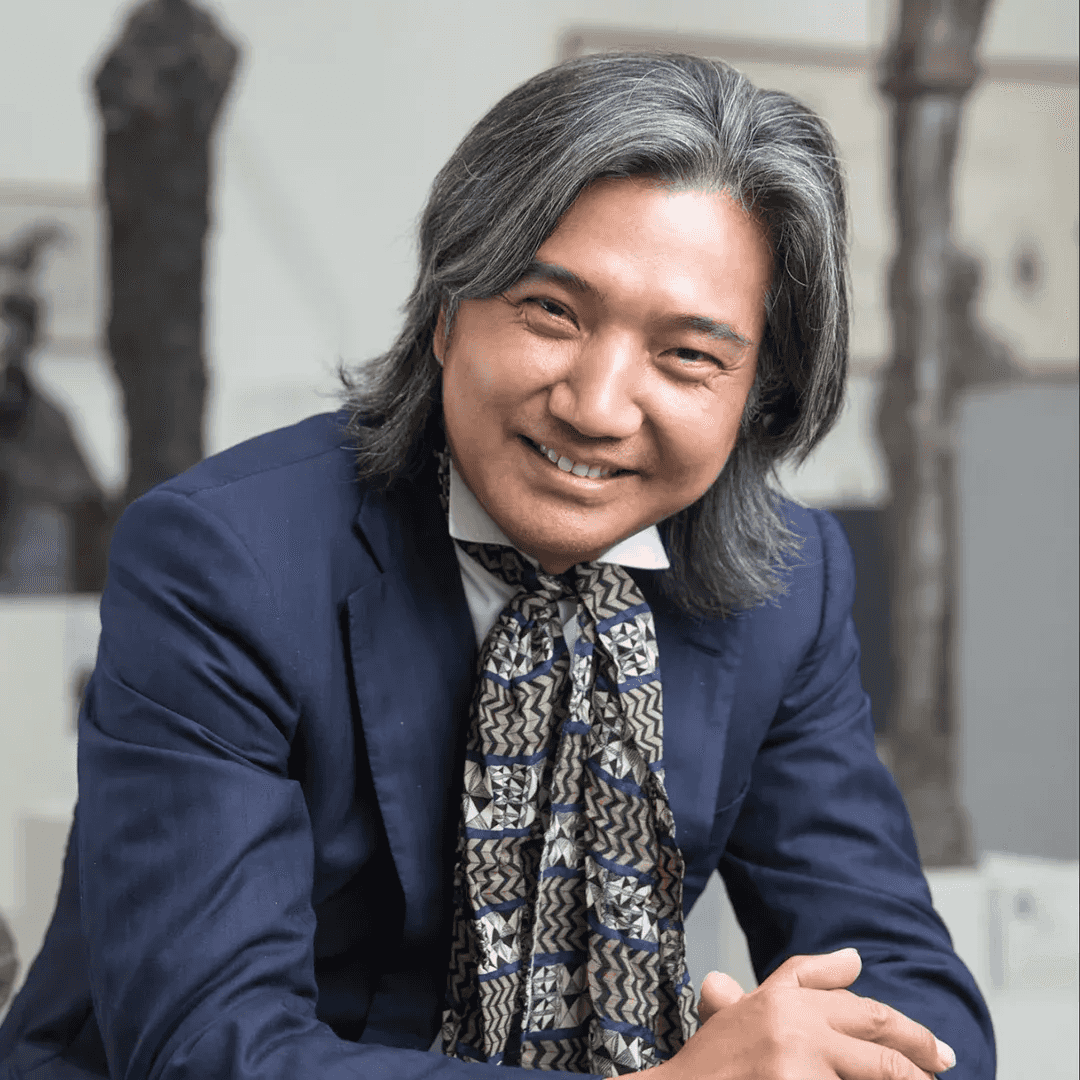
INTRODUCTION
Mr. WU Weishan was born in January 1962. He is the Vice Chairman of the Central Committee of China Democratic League, Director of the National Art Museum of China, Vice Chairman of the Chinese Artists Association, Secretary-General of the Silk Road International Alliance of Art Museums and Galleries and the BRICS Alliance of Art Museums and Galleries, and a corresponding member of the Académie des Beaux-Arts.
Due to his extraordinary achievements and influence, Wu Weishan was awarded academicians in several countries. He received many international awards, including the Michelangelo Award by Italy, the Louvre International Gold Medal for Fine Arts, the Pangolin Award, the Gold Medal by the Russian Academy of Arts, and the Francysk Skaryna Medal by the Republic of Belarus.
Wu Weishan pioneers the modern Chinese Xieyi sculpture. He has created more than 600 pieces of work. “Sculpting the Soul of a Nation - An International Touring Exhibition of the Art of Wu Weishan” was held in the UN headquarter in New York and Italy. He held solo exhibitions in France, the UK, South Korea, Japan, etc. His sculpture of Karl Marx was erected in Trier, Germany. Confucius and Socrates: An Encounter was established in the Ancient Agora in Athens. A Dialogue Across the Time: Leonardo da Vinci and Qi Baishi was permanently established at Leonardo da Vinci Museum and Library, Italy. He has published over 30 works and catalogs, with nearly one million characters of theoretical achievements, and some were translated into several languages for international publication.
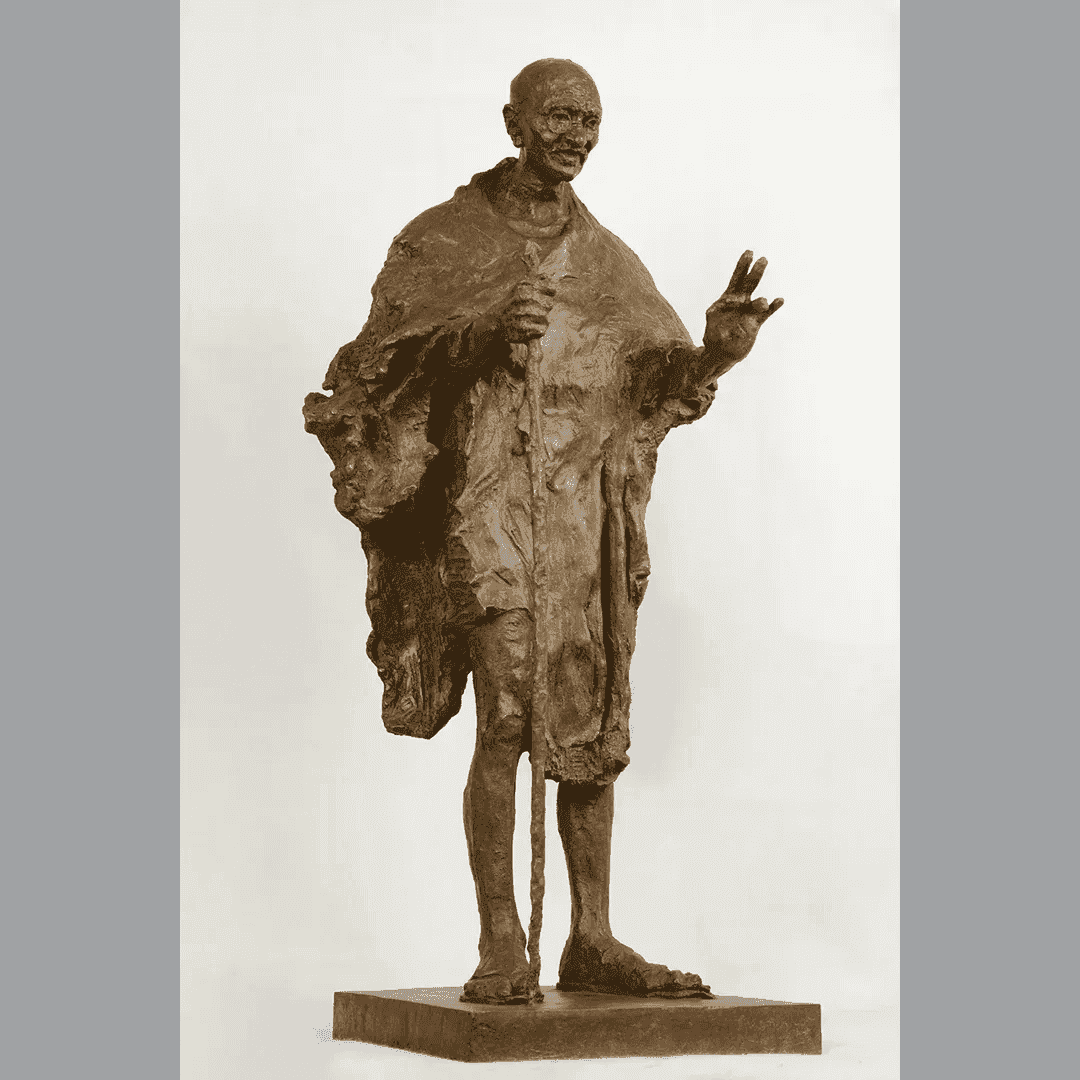
ABOUT THE ARTWORK
Statue of Mohandas Karamchand Gandhi, Medium: Copper, Dimensions: 120 x 52 x 50 cm, Year: 2019
Mohandas Karamchand Gandhi was an outstanding Indian statesman and national leader whose doctrine of truth and non-violence brought new light to the liberation and independence of the Indian nation and made an outstanding contribution to the peaceful development of humanity. Throughout his life, Gandhi was frugal and diligent, dressed in rags and wearing straw shoes, reaching out to the masses and leading the peace movement by example.
In terms of posture, the sculptor focuses on Gandhi's image of standing firm on the earth, defying oppression, hardship and personal safety, and always fighting courageously. When dealing with the clothes and the contour lines of the figure, the sculptor combines the rhythm of Chinese calligraphy with the shaping of the structure of the figure, with a mixture of rigidity and flexibility. Gandhi's steadfastness can be seen in his eyes, and his determination can be felt in his posture. As a world-renowned sculptor, Wu Weishan's use of Chinese Xieyi sculpting techniques demonstrates his superb artistic and expressive skills, vividly and accurately portraying a national leader with integrity and ideals.
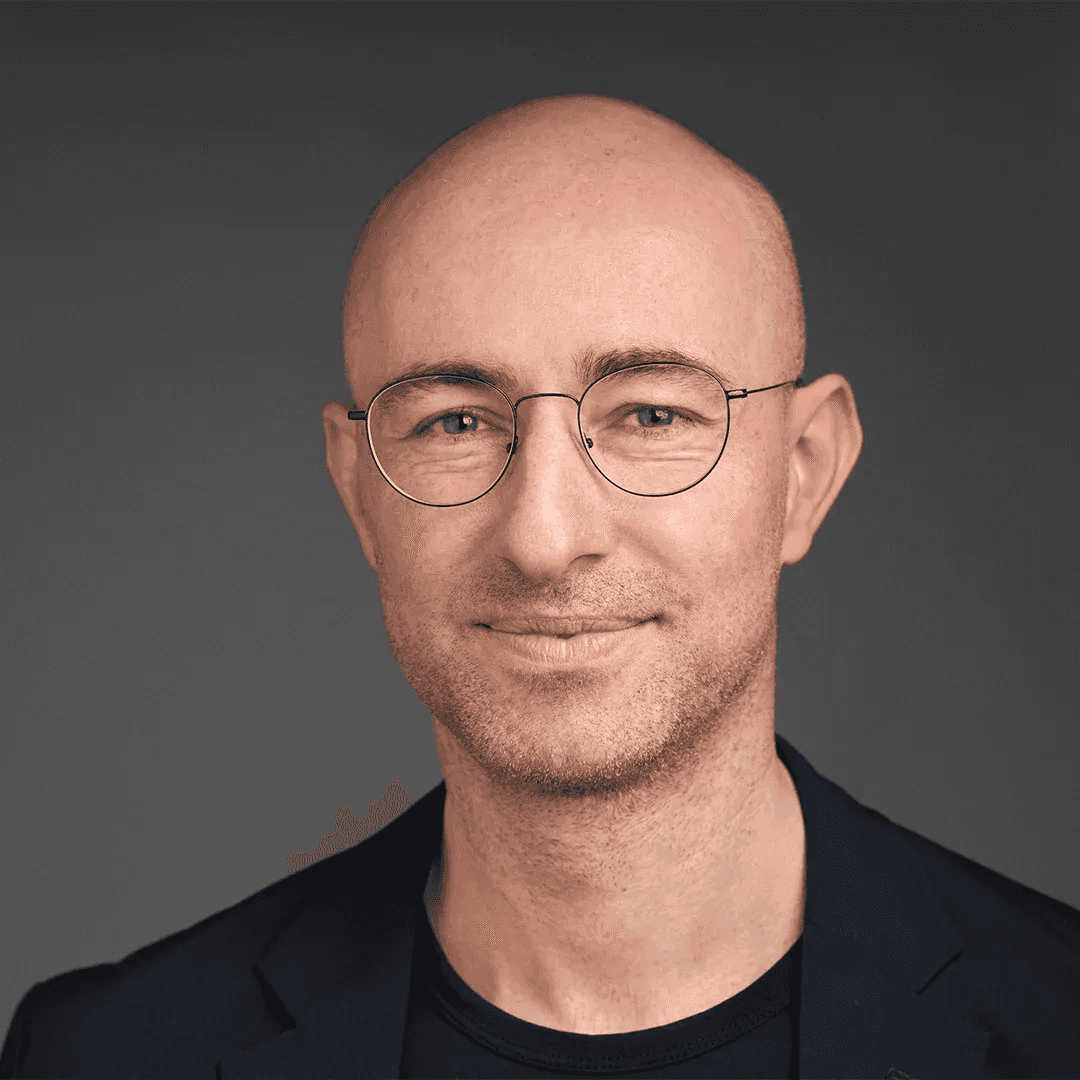
INTRODUCTION
Alexander Peterhänsel is an interdisciplinary media artist and researcher. He is a professor for Visual Computing at the Technical University of Applied Sciences Amberg-Weiden; his works discuss the implications of the digital turn with a focus on virtual- and augmented reality as well as artificial intelligence. He has performed, exhibited and lectured at numerous festivals, conferences and institutions worldwide, amongst others at Ars Electronica, CCCB Barcelona, BOZAR Brussels, Futurium Berlin, European Parliament, Museo de Arte Moderno Medellı́n, ISEA, Transmediale Berlin. He also is the founder of the Audiovisual Architectures Lab and an external expert to the Joint Research Centre of the European Commission (JRC).
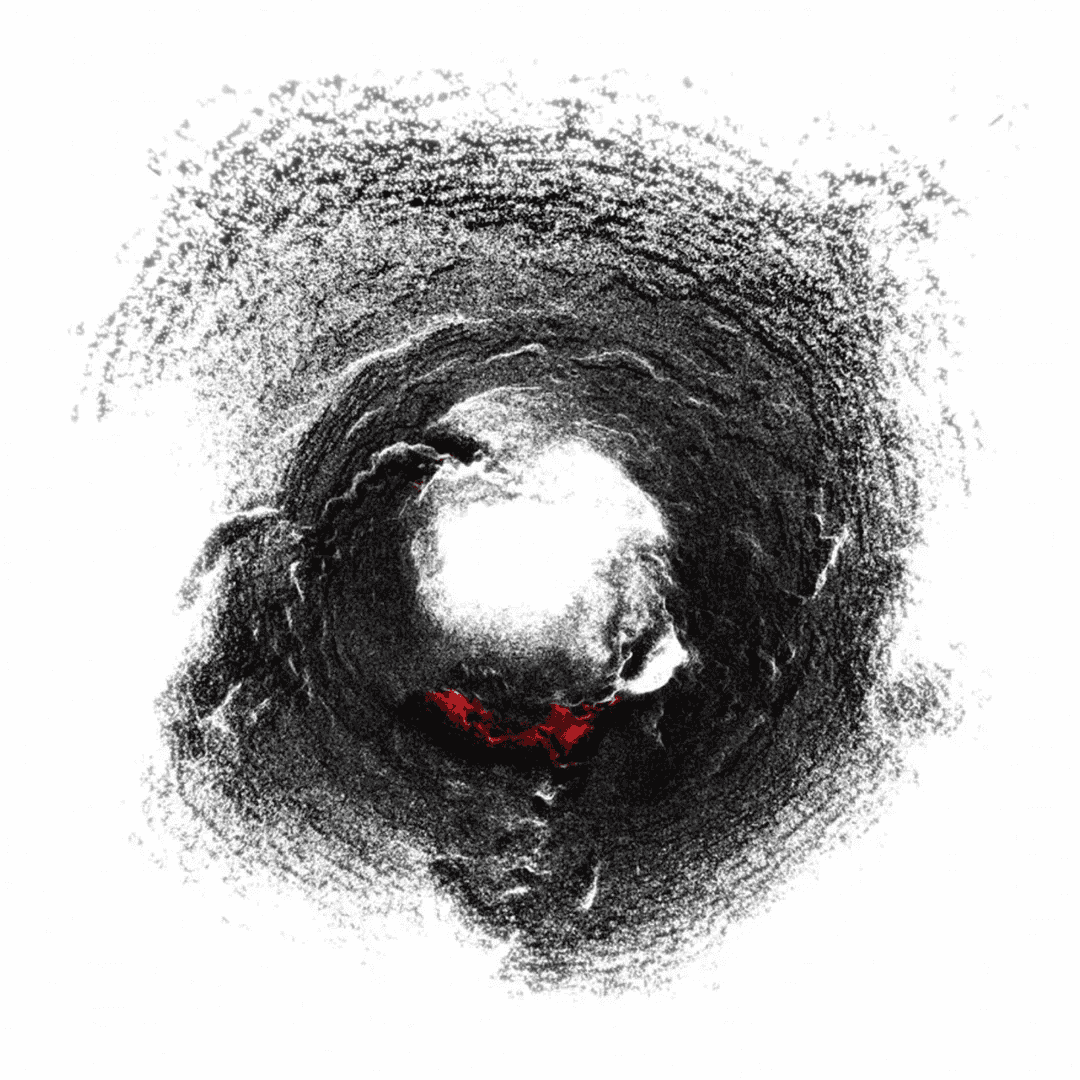
ABOUT THE ARTWORK
Resonance Space, Portrait 01 (Global Temperature Data 2018), Medium: Print on aluminium composite sheet + Pointcloud rendering captured in Resonance Space (VR), Dimensions: 80 cm x 80 cm x 0.3 cm, Year: 2022
Resonance Space(s) is an interdisciplinary artistic- scientific research project conducted at the Joint Research Centre of the European Commission and the University of the Arts Berlin from 2018 to 2022. It is the result of a collaboration between media artist Alexander Peterhänsel, geophysicist Daniel Tirelli, and meteorologists Jutta Thielen-del-Pozo and Thomas Petroliagkis. The project discusses human-induced climate change and resulted in several artistic-scientific Artifacts. One of them is an interactive Big Data sculpture that can be experienced in Virtual- or Augmented Reality. The room-scale installation attempts to unfold the physis of our planet in all its unconcealedness within 2.5 billion data points. It invites recipients to an audiovisual meditation on climate change. The Big-Data sculpture translates a scientific hypothesis into an interaction model, making it tangible as an individual, immersive and audiovisual experience. Resonance Space (VR) premiered on October 15th 2019 at the Resonances III Festival “Datami” at the Joint Research Centre of the European Commission in Ispra. From December 2019 to January 2020, the work was exhibited at BOZAR Centre for Fine Arts in Brussels.
Recognising the potential of Big Data visualisation as a cultural technique, Resonance Space Portrait(s) translate a global temperature data set into an aesthetic experience. Being aware that without Big Data, it would be impossible to grasp the world climate in its entirety, Resonance Space(s) sets out to find ways of representing the Big Data set in a form that allows for an intuitive understanding of the complex flow of chaotic behaviour. On one hand the work allows for the spectators to be overwhelmed by the beauty of taking a bath in a data clowd; the portraits place the spectatators in the eye of a data hurricane and completely submerges them in a cyclone of data points whirling around them. On the other hand, it was very important to find a sweet spot – or a focal point – in the data set, which would allow for a meditative resonance of the spectators with the serene beauty of the complex behaviour these data are depicting.
“Our geosphere begins to resonate multi-harmonically in response to our behaviour as a species.” – Daniel Tirelli, 2018 (Geophysicist at the Joint Research Centre of the European Commission)
The Joint Research Centre (JRC) is the Commission’s science and knowledge service and provides independent scientific advice and support to EU policy, in order to tackle the interlinked and complex challenges faced by our society. Operating at the interface between science and policy, the JRC wants to strengthen its capacity to be a key partner in helping to identify solutions to such challenges. Its Science and Art project (SciArt) brings together scientists with artists and policymakers to discuss matters of concern, not only to the JRC and the European Commission but also more widely to society. It brokers, curates and communicates transdisciplinary exchanges and encounters around given topics of interest. It operates on a bi-annual cycle, Resonances, during which the topics are elaborated jointly by artists and scientists. The end of each cycle is marked by exhibitions of the works at a venue of relevance as a way to engage with the public, foment conversations with citizens and create cultural products of contemporary relevance. Resonances have taken place on the topic of Food (2015), Fairness (2017), and datami - Big Data, digital transformation and Artificial Intelligence (2019). The current cycle features the topic NaturArchy: towards a Natural Contract (2022-2024).
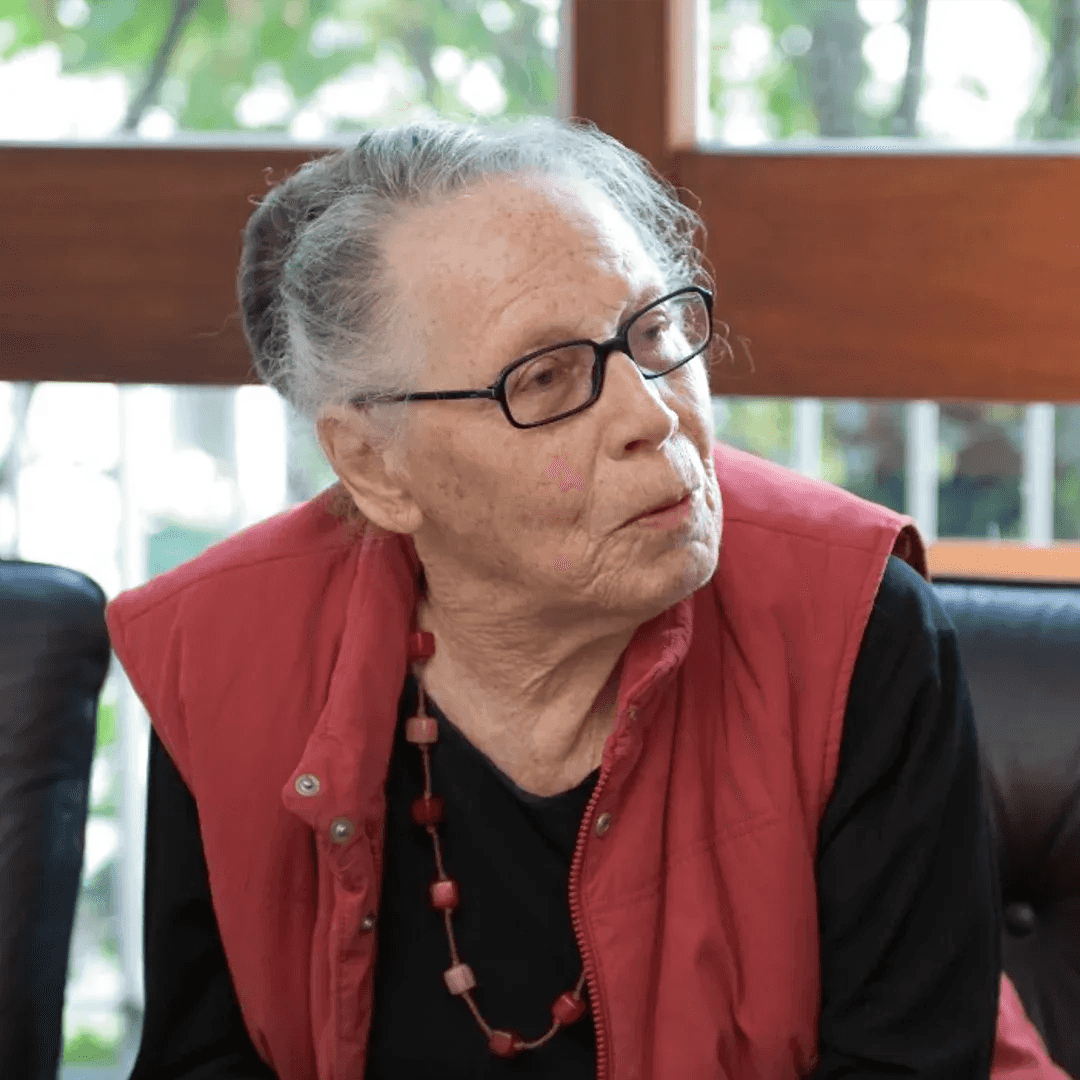
INTRODUCTION
When one has to present Vera Molnar in a few words in a biographical note, the terms chosen are most often: "Geometric abstract painter since 1948". Her ascending lineage is thus all designated, it is that of the geometric abstract painting. Her plastic ancestors are undoubtedly Kandinsky, Malevitch, Mondrian and Klee; but if Vera Molnar's work has been elaborated from their heritage, she has also strongly dissociated herself from constructivism and the artist remains today one of the rare representatives, along with François Morellet and Julije Knifer, of a certain form of anarcho-constructivism unashamedly flirting with the so-called conceptual art.
1924 Birth of Vera Gács in Budapest (Hungary) on January 5. 1942–47 Studied painting, art history, and aesthetics at the Budapest School of Fine Arts, alongside Ferenc [François] Molnar, Judit Reigl, Marta Pan, Simon Hantaï; graduated as professor of art history and aesthetics. 1947–48 François and Vera Molnar move to Paris. 1957 Meeting of Jesús Rafael Soto and François Morellet. 1960 Becomes a member of the Centre de recherche d’art visuel (CRAV). 1967 Co-founder of the Art et informatique group at the Institut d’esthétique et des sciences de l’art in Paris. 1968 First works done with the use of a computer. 1969–76 Works at the computer center of the Paris-Sorbonne University, in Orsay; use of an IBM computer, a Benson plotter, and a Tektronic printer. 1973 Participation in the first international digital art exhibition in Paris. 1974 Development, with François Molnar, of the digital program MolnArt. 1980 Founding member of the Centre de recherche expérimentale et informatique des arts visuels (CREIAV), Paris-Sorbonne University. 1990 First installation, Hommage à Dürer, Stiftung für Konkrete Kunst, Reutlingen, Germany. 1999 Solo exhibition at the Crédac, Ivry-sur-Seine. 2001 Solo exhibition at the musée de Grenoble. 2004 Retrospective exhibition at the Wilhelm-Hack-Museum in Ludwigshafen, Germany. 2006 Retrospective exhibition at the Kunsthalle Bremen, Germany. 2009 Participation in the group exhibition The Digital Pioneers, Victoria and Albert Museum, London, United Kingdom. 2012 Retrospective exhibition at the musée des Beaux-Arts de Rouen and the Centre d’art contemporain in Saint-Pierre-de-Varengeville. 2013 Participation in the group exhibition Dynamo (with Agam, Calder, Cruz-Diez, Kapoor, Le Parc, Morellet, Soto) at the Grand Palais, Paris. 2017 Participation in the group exhibition Thinking Machines, Art and Design in the Computer Age, 1959-1989 at MoMA, New York, United States. 2018 AWARE Outstanding Merit Award; solo exhibition at the musée des Beaux-Arts de Caen. 2020-2021 Retrospective exhibition Pas froid aux yeux at the Espace de l'Art Concret in Mouans Sartoux and at the Musée des Beaux-Arts in Rennes.
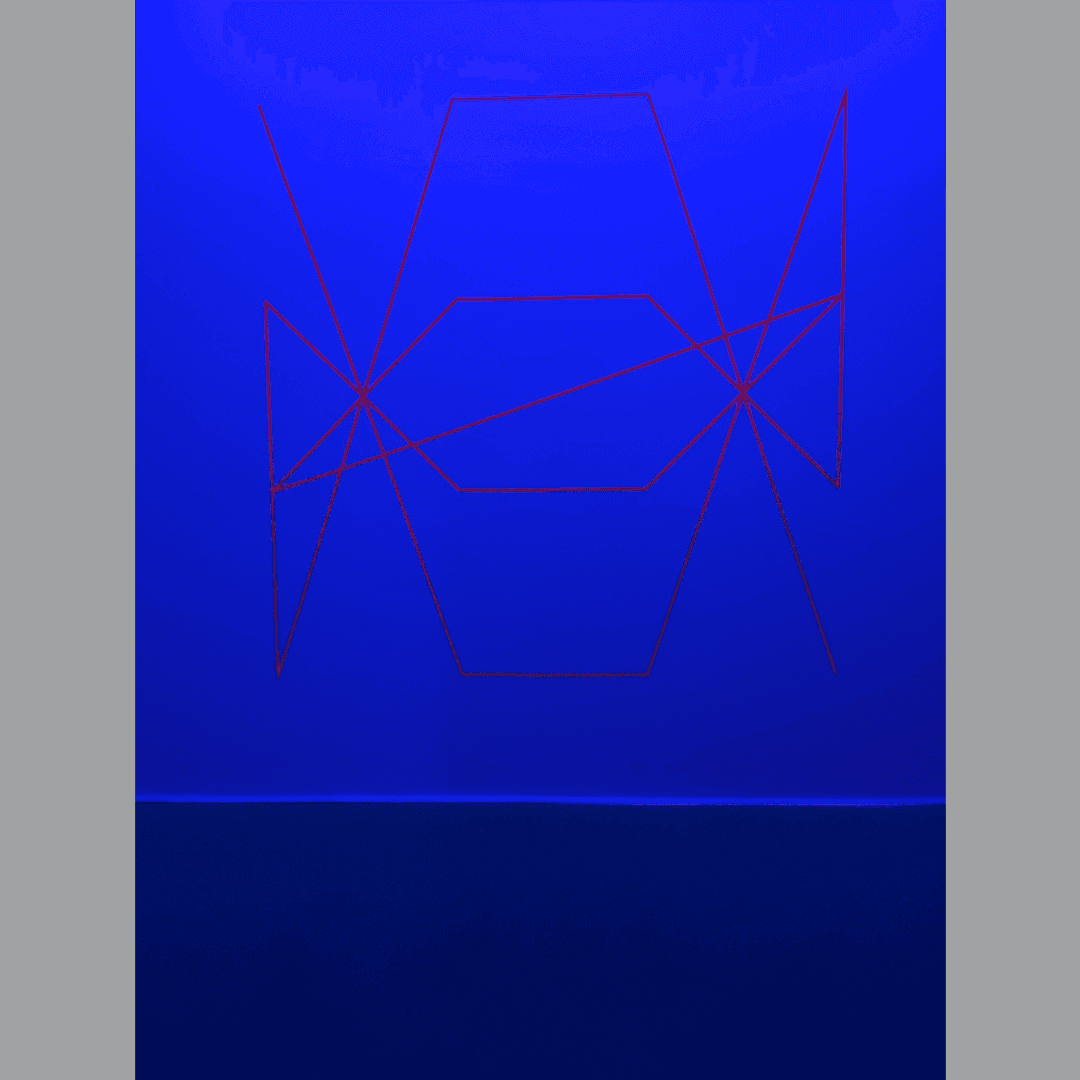
ABOUT THE ARTWORK
Tribute to Dürer, Medium: Fluorescent orange adhesive tape, Dimensions: Variable, Year: 1948-2022
Together with Art, the guiding theme of this exhibition organized in India for the 2023 G20, underlines the importance of artistic creation in international relations. In a world more than ever in search of dialogue, it was important that the Musée national d'art moderne at the Centre Pompidou, committed since its creation to high-level artistic exchanges between France and the world's leading art scenes…. (…) Vera Molnar celebrates her 100th birthday on January 5 and yet she is still very active, hence her interest in NFT technologies. She was thus an obvious choice for this exhibition. Born and trained in Budapest at the dawn of the avant-garde at the beginning of the 20th century, she chose to settle in France, where she enjoyed an incredible artistic career after the Second World War. Embracing abstraction, she became a pioneer in the use of emerging computer techniques. In this way, she pushed back the limits of invention and became a role model for today's younger generation. Above all, she was part of a long tradition, rather than a break from it. This can be seen in her conception of this abstract and colorful protocol work - created according to her instructions for each presentation - as a tribute to the German Renaissance master, Albrecht Dürer (1471-1528). She thus offers us a fine example of the transmission of art and aesthetics across centuries and cultures. We are grateful to the artist who accepted to lend the work readapted for its presentation in India.
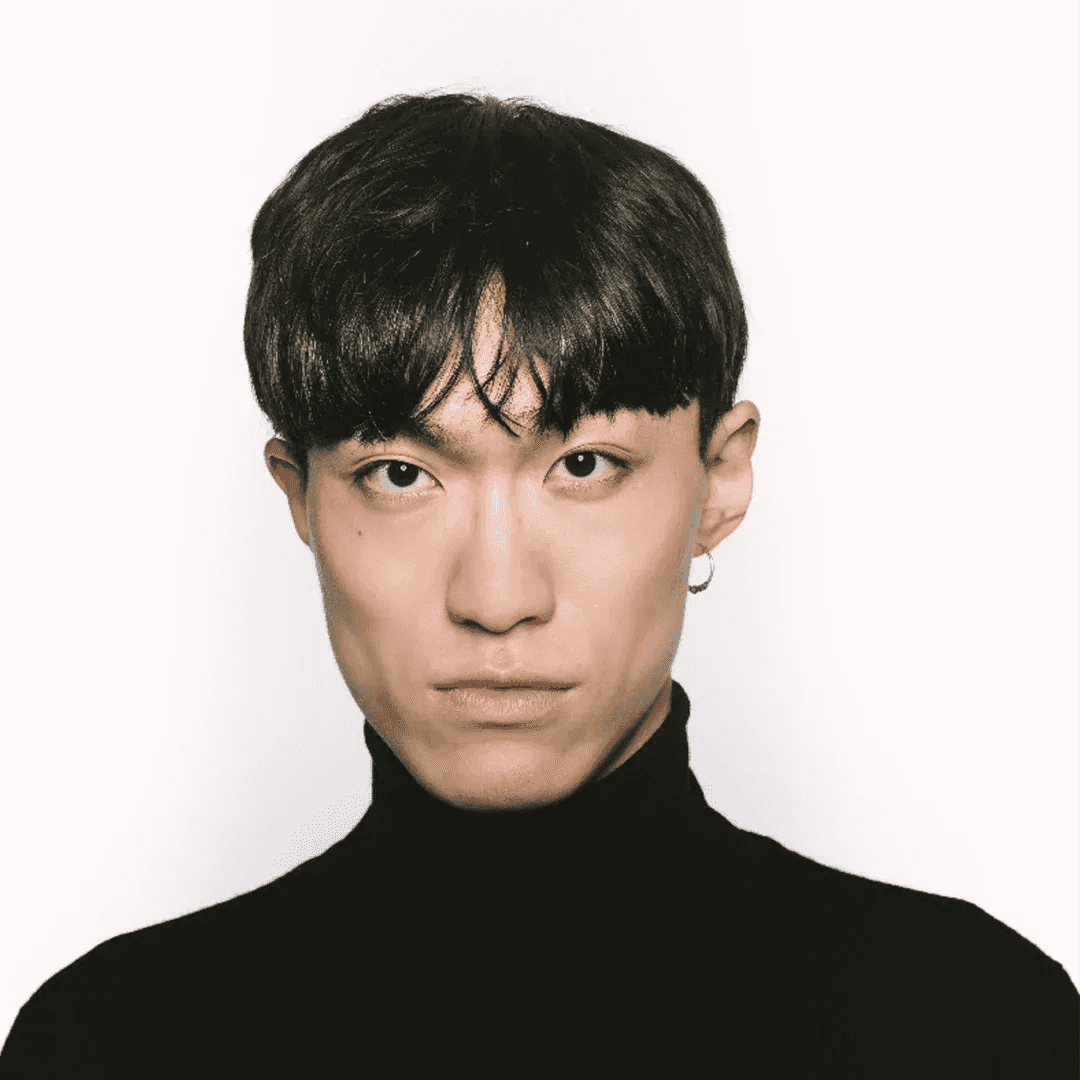
INTRODUCTION
Isaac Chong Wai is an artist working between Berlin and Hong Kong. The conceptual, political, and performative qualities of Isaac Chong Wai’s practice are incorporated by an interdisciplinary approach, processing the exigency of societal shifts and global phenomena. His subtle, poetic, and yet critical works infiltrate the systems of meanings, inviting viewers to reexamine his edited representations of, among others, the body, powerlessness, violence, collectivism, leaderlessness and mourning. He works across a range of media, comprising performance, sculpture, video, painting and photography.
He had solo exhibitions at Museum Schloss Moyland and Liste, Basel (2023); Zilberman Selected, Istanbul and Una Boccata d’Arte, Fondazione Elpis and Galleria Continua, Castiglione di Sicilia (2022); Bilsart, Istanbul (2021); Blindspot Gallery, Hong Kong (2019); Zilberman, Berlin (2019); Kunstraum München, Munich (2018); Goethe-Institut, Hong Kong (2018); Bauhaus Museum, Weimar (2016). His work has been shown at Hamburger Bahnhof – Nationalgalerie der Gegenwart, Berlin (2023); Bundeskunsthalle Bonn and ifa-Galerie Berlin, Berlin (2022); Federal Foreign Office, Berlin (2021); MMCA, Seoul and IFFR, Rotterdam (2020); MOCA Taipei and Guangdong Times Museum, Guangzhou (2019); M+ Museum (2018); Haus der Kulturen der Welt in Berlin (2017).
Chong received scholarships from Stiftung Kunstfonds, Bonn (2023), Akademie der Künste (with Dagmar Aigner), Berlin (2022), Berlin Senate Department for Culture and Europe, Berlin (2021) and a fellowship from Kulturakademie Tarabya, Istanbul (2020/2021). He graduated from Academy of Visual Arts at Hong Kong Baptist University with a BA in Visual Arts and Bauhaus-Universität in Weimar, Germany, with a MFA in Public Art and New Artistic Strategies.
CONCEPT NOTE
Referencing Käthe Kollwitz's woodcut “Die Mütter” (1922/23), Isaac Chong Wai has developed a 2 channel video, installed back-to-back on a metal pole, commissioned by ifa-Galerie Berlin. The performers move in a circle and sing lines from songs, including dirges and lullabies in various languages directed by musician Dagmar Aigner, who has been working with mourners for over 10 years in Munich. Revolving around the ideas of death, birth and motherhood, the work, named after Kollwitz’s woodcut, responds to the rhythm of histories marked by wartime experiences and places the grief engendered by Kollwitz into a transnational discourse.
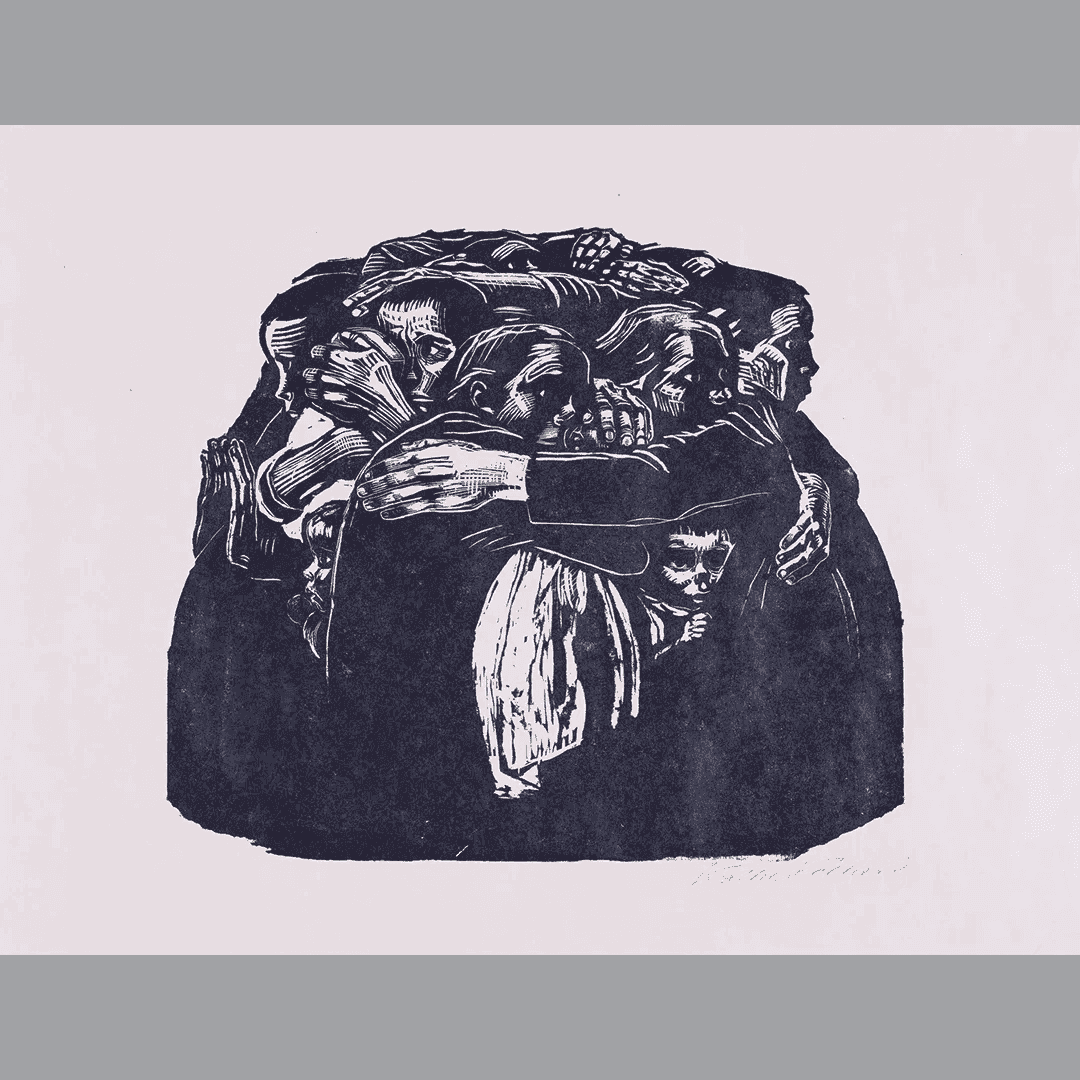
ABOUT THE ARTWORK
Die Mütter / The Mothers, Medium: 2 channel video, Duration: 14 min 01 sec, Year: 2022
Käthe Kollwitz The Mothers, Sheet 6, Medium: War Series Woodcut, Dimensions: 49 x 67.5 cm, Year: 1922 / 1923
In "Die Mütter/The Mothers“, the performers form a collective hug and move in a circle while singing lines from songs, including dirges and lullabies in various languages directed by musician Dagmar Aigner, who has been working with mourners through music. The 2 channel video is installed back-to-back on a metal pole. Revolving around the idea of death, birth and motherhood, the work, referenced and named after Käthe Kollwitz’s woodcut “Die Mütter” (1922/23), responds to the rhythm of histories marked by wartime experiences and places the grief engendered by Kollwitz into a transnational discourse. Please find the viewing link here:
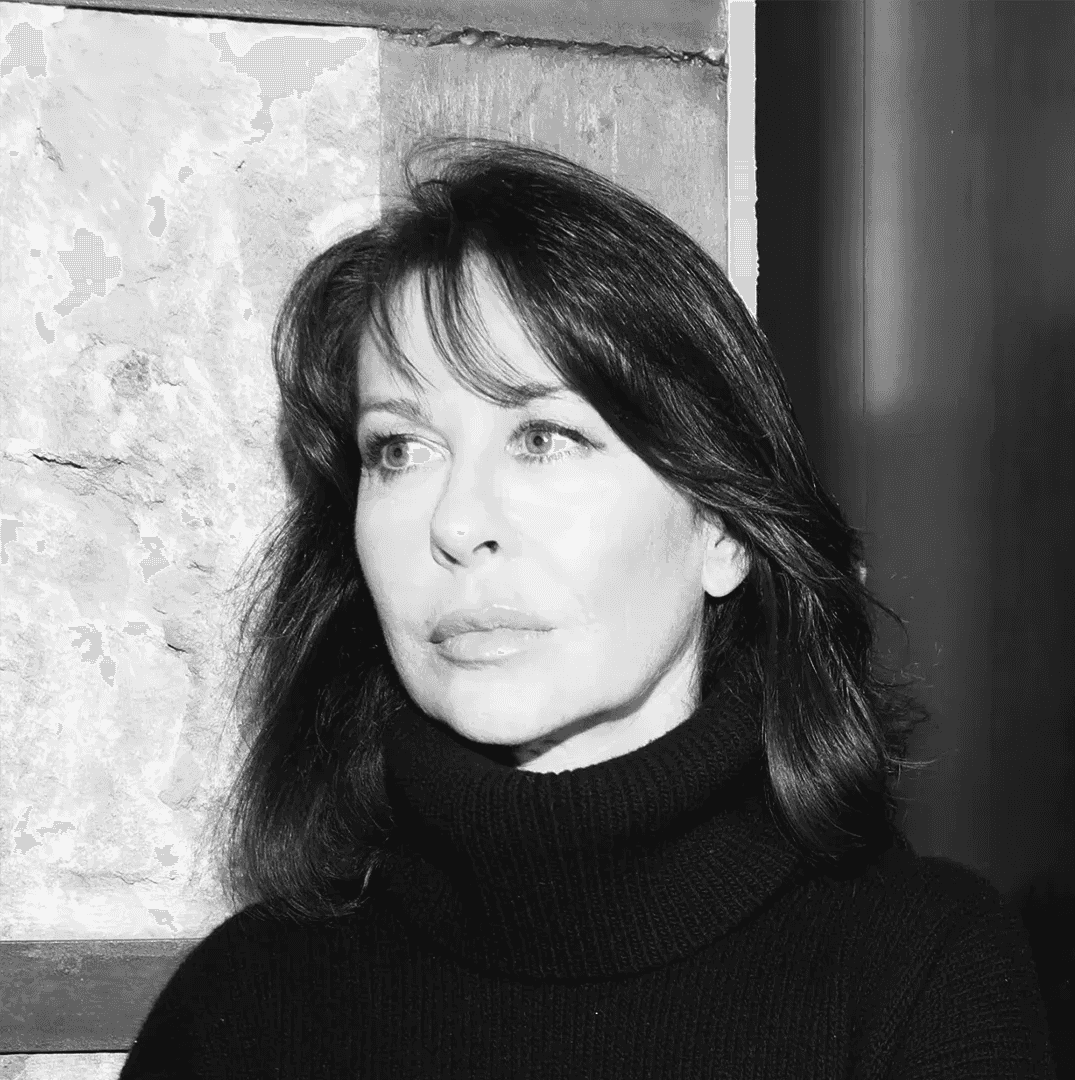
INTRODUCTION
Francesca Leone was born in Rome into a family of artists. Her first exhibiting was in 2007 in the Capitoline Museums followed by “Riflessi e Riflessioni” that took place at the St Bartholomew Lodge of Palermo, in 2008. At the end of this year, Francesca was dedicated a solo exhibition by Palazzo Venezia in Rome, “Primo Piano” that later travelled in 2009 to Castel dell’Ovo in Naples. In the same year, she was invited to exhibit at the Moscow Museum of Modern Art (MMOMA). She participated in the Venice Biennale in 2011 and 2013. In 2014, Francesca Leone was the protagonist of three solo shows: one at the MAC of Santiago in Chile, one at the MACBA in Buenos Aires and one at the Museum of the Academy of Fine Arts in Saint Petersburg. 2015 opened with a solo exhibition in Singapore and ended with the monumental exposition “Our Trash” at the Triennale of Milan. In 2017 she presented “Giardino” at the MACRO Museum in Rome. Danilo Eccher curated in 2018 her show “Monaci” in the Reale Ospizio dei Poveri in Palermo and “Domus”, at Palacio de Gaviria in Madrid. In 2020 Magazzino Gallery in Rome presented her installation “Si può illuminare un cielo melmoso e nero?” In 2021 Gallerie d’Italia in Milan, hosted her solo show “Ulteriori gradi di libertà, nella città che resiste” curated by Andrea Viliani. In 2022 the artist partecipated at the Collateral Event of the 59th Venice Biennale with the monumental exhibition “Take your Time” curated by Danilo Eccher.
CONCEPT NOTE
The passage of time and an awareness of the environment are inseparable elements in the works of Francesca Leone. The recovery of discarded, thrown away or abandoned objects, on which the artist intervenes by taking them apart, reconstructing them and painting them, causes them to lose their old identity, taking on a new, more poetic guise, while retaining the signs of a past existence. Just like the objects, abandoned metal sheets also become inspirations for the artist to paint on, after shaping them, crumpling them, welding them and letting them oxidise. Iron is therefore transformed into paper or into giant flowers or stalactites from a prehistoric world or distant galaxy. Every piece of sheet metal has a story to tell, fragments of the past that are brought back to life. The rust on the metal is like a wrinkle on the skin, on which the artist intervenes gently with paint, removing the signs of time. The installation entitled Una rosa, è una rosa, è una rosa (A rose, is a rose, is a rose) after the verse by the poet Gertrude Stein represents an ailing garden, in which the largest rose has lost the traces of rust and time, thanks to the colour restored to it by the artist, and has gained a new lease of life. Meanwhile, the smallest still shows signs of time with the hope that it can “heal”. In the third rose, on the other hand, the rust has taken over, it has no colour and all hope is lost. And yet, in this dreamlike rose garden, which still shows signs of its ancient beauty, we can glimpse the hope of being able to save it before it all wilts away.
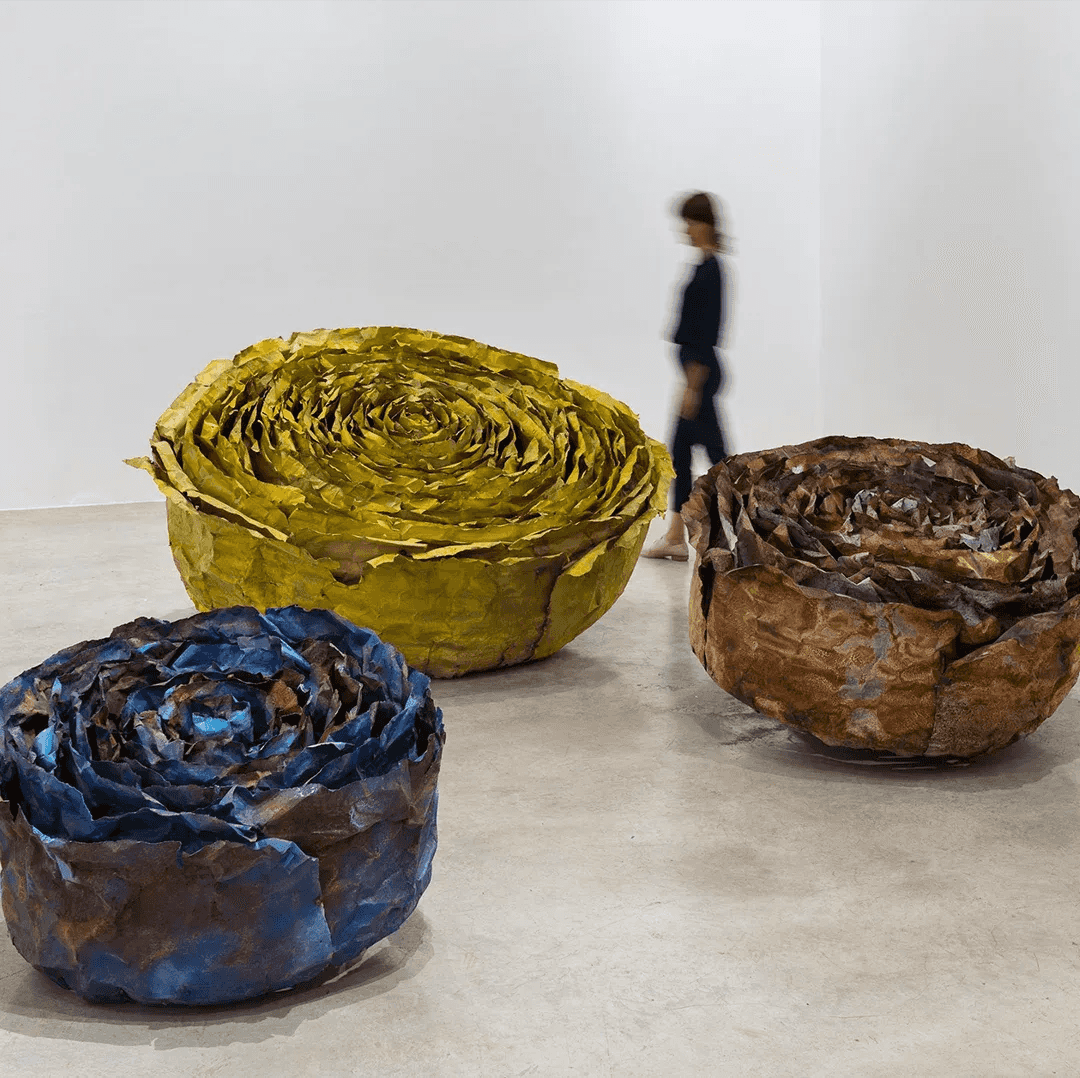
ABOUT THE ARTWORK
Una rosa, é una rosa, è una rosa (A rose is a rose is a rose) Installation, Medium: Oil on reclaimed sheet metal, rust, Dimensions: 70 x 210 cm (Yellow and Blue), Medium: Reclaimed sheet metal, rust, Dimensions: 70 x 150 cm (Rust), Year: 2021 - 2023
The installation by Francesca Leone, entitled Una rosa, è una rosa, è una rosa (A rose, is a rose, is a rose) after the verse by Gertrude Stein, is comprised of three huge flowers of different sizes, made from sheet metal salvaged by the artist from old construction sites or abandoned buildings. On their surface we can see the signs of time, lacerations, cuts, scratches and rust, which Leone heals with paint as if they were scars on skin. The largest rose, painted in its entirety, has lost all traces of rust and time and has gained a new lease of life. The blue rose, which is the smallest of the three, still shows evident signs of time with the hope that it can “heal,” while all colour is absent from the third rose, which is dominated by rust and completely wilted. In this ailing garden, which still shows traces of its ancient beauty, we can glimpse the hope of being able to save it before it all wilts away.
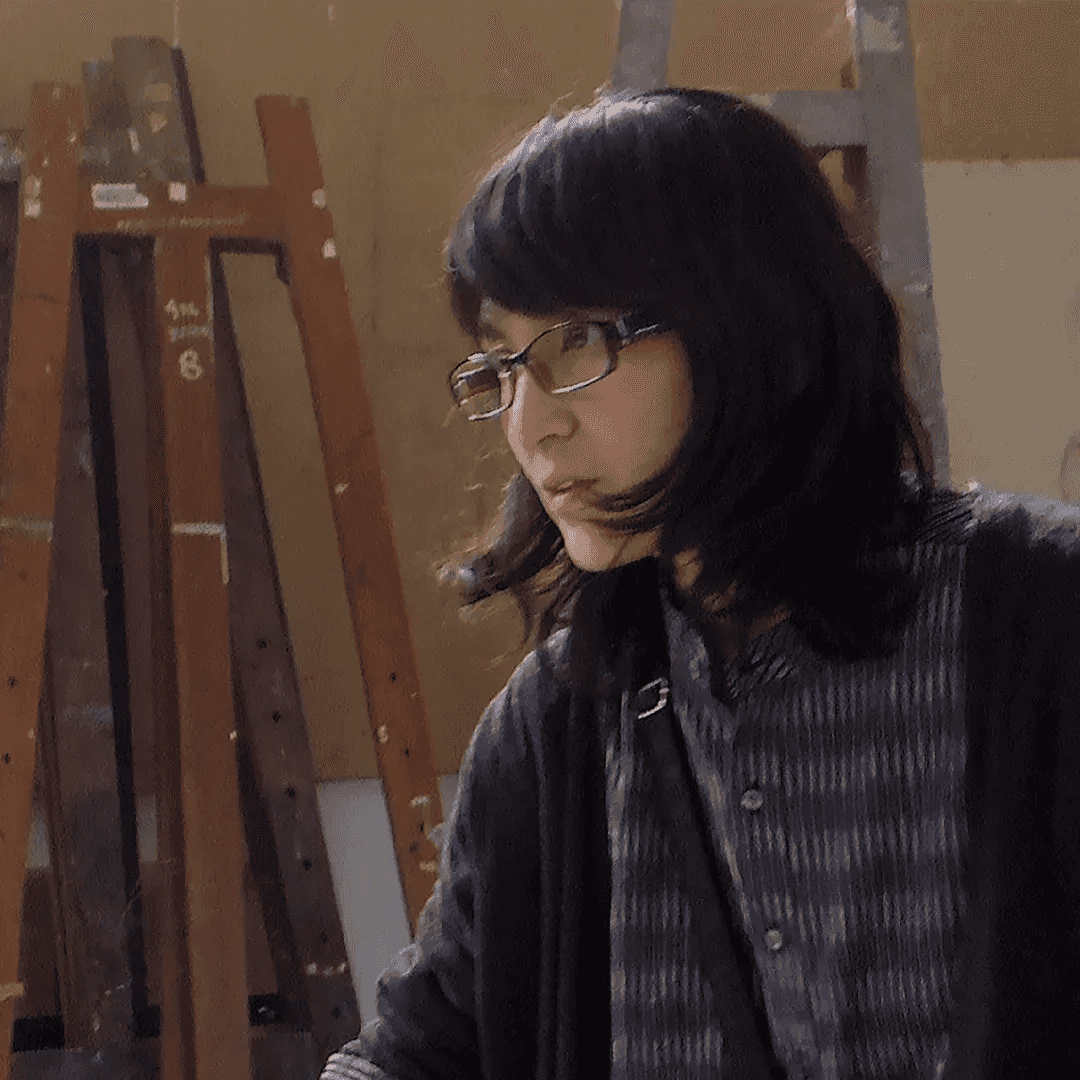
INTRODUCTION
Born in Osaka, Japan in 1963, Misako SHINE has done her B.F.A., from Department of Painting, Japanese Painting Course, Tama Art University in 1987. Way back in 2001 her solo exhibition “Art Walk 2001” was organized at Gallery Center Point, Tokyo. In 2002 her solo Exhibition was held at Akino Fuku Museum Citizen’s Gallery, Shizuoka. Also, in the same year 2002, Ms. Shine won the Second Prize in “The 4th Tenryugawa Painting Contest Exhibition” held at Akino Fuku Museum, Shizuoka. In 2004 Misako Shine’s solo exhibition was organized at Lalit Kala Akademi in New Delhi. The artist participated in the “Special POLA Exhibition New and Rising Artists - Metaphors of Flowers” at Pola Museum Annex, in Tokyo in 2005. In the same year she bagged the Grand Hoshino Shingo Prize, at the 3rd Triennial Competition” in Toyohashi” - Toyohashi City Museum of Art and History which was held at Aichi. Shine had her exhibits displayed at “Tokyo Contemporary Art Fair 2008” organized by Tobi Art Forum, Tokyo and also in “The way of Contemporary Art” - Nerima Art Museum, Tokyo in 2010. In the same year Shine’s works were showcased at the “Two-person Exhibition Contemporary ink painting” at the Shun Art Gallery, Shanghai. In 2013 Misako Shine’s works were displayed at the “Tobi Selection” - Tokyo Metropolitan Art Museum Gallery, in Tokyo. The same year National Art Center in Tokyo witnessed her masterpiece at the “Contemporary Sumi Ink Artist Exhibition. In 2016 Japan Foundation organized her solo exhibition titled “Speculation on Art of Bengal School” at Tenshin Okakura Gallery, New Delhi which was re-organized in 2017 at Hayashida Gallery, Tokyo. In 2018, Misako Shine’s solo exhibition called “Flower” took place at Nakamuraya Salon Museum, Tokyo. In 2019 Shine’s solo exhibition named “Flowers and Nostalgia” was organized at Kolkata Centre for Creativity in Kolkata. The very same year witnessed her artistic excellence at a solo exhibition “Flowers and Nostalgia” at Kala-Bhavana Visva-Bharati, Santiniketan.
Post Covid pandemic, in 2021, Shine had another solo exhibition “Flower of Sumi Ink” solo exhibition at Kanagawa Kenmin Hall, Kanagawa. Lately, in 2022 Rabindra Okakura Bhavan in Kolkata hosted her solo exhibition titled “Flowers and Birds” followed by her participation at the India and Japan Joint Art Exhibition at Rabindra Bharati University and Rabindra Okakura Bhavan in Kolkata in the same year.
According to Misako Shine, “I think that color is a phenomenon and does not represent the essence of a thing. When I think about what the thing is, color interferes with it, so I want to draw its essence with Sumi-ink that has all the colors inside. There is a meaningful deep world that can only be expressed with Sumi-ink. Sumi-ink is not just black ink, it is an excellent art medium and history itself that can express all colors.”
CONCEPT NOTE
I think that color is a phenomenon and does not represent the essence of a thing. When I think about what the thing is, color interferes with it, so I want to draw its essence with Sumi-ink that has all the colors inside. There is a meaningful deep world that can only be expressed with Sumi-ink. For Sumi-ink, it must choose paper, inkstone, brush, water quality, weather, temperature, humidity, etc., and the persons condition who rubs the Sumi-ink, years of involvement, experience, etc. I usually use short-fiber Chinese paper (it has been aged for more than 10years) and old Chinese and Japanese pine and oil inks(30 to 50 years old) in my work. The moment I write, I can see how good old Sumi-ink is about to spread. However, just because the materials and conditions to be ready, does not necessarily good work will be produced. I think that stripping away various elements to make it simple and not being explanatory will lead to the expression of a deep infinite world and spiritual world. The world seems to be uncertain (as if drifting), as paintings are invisible. What is important in the expression is that the work has polysemy, universality and infinity. Rabindranath Tagore(1861-1941) continued to seek harmony between humans and nature, the earth, life, which are the roots of human beings. It is said that he saw the preciousness of human beings in the astonishing fact that I exist in the eternal flow of life. Tagore’s poems and songs about the joy of life are the source of my work. I think freedom is a sad but great joy, and that India itself is such a country. And it is the great spirit itself that is common to the whole world and all mankind.
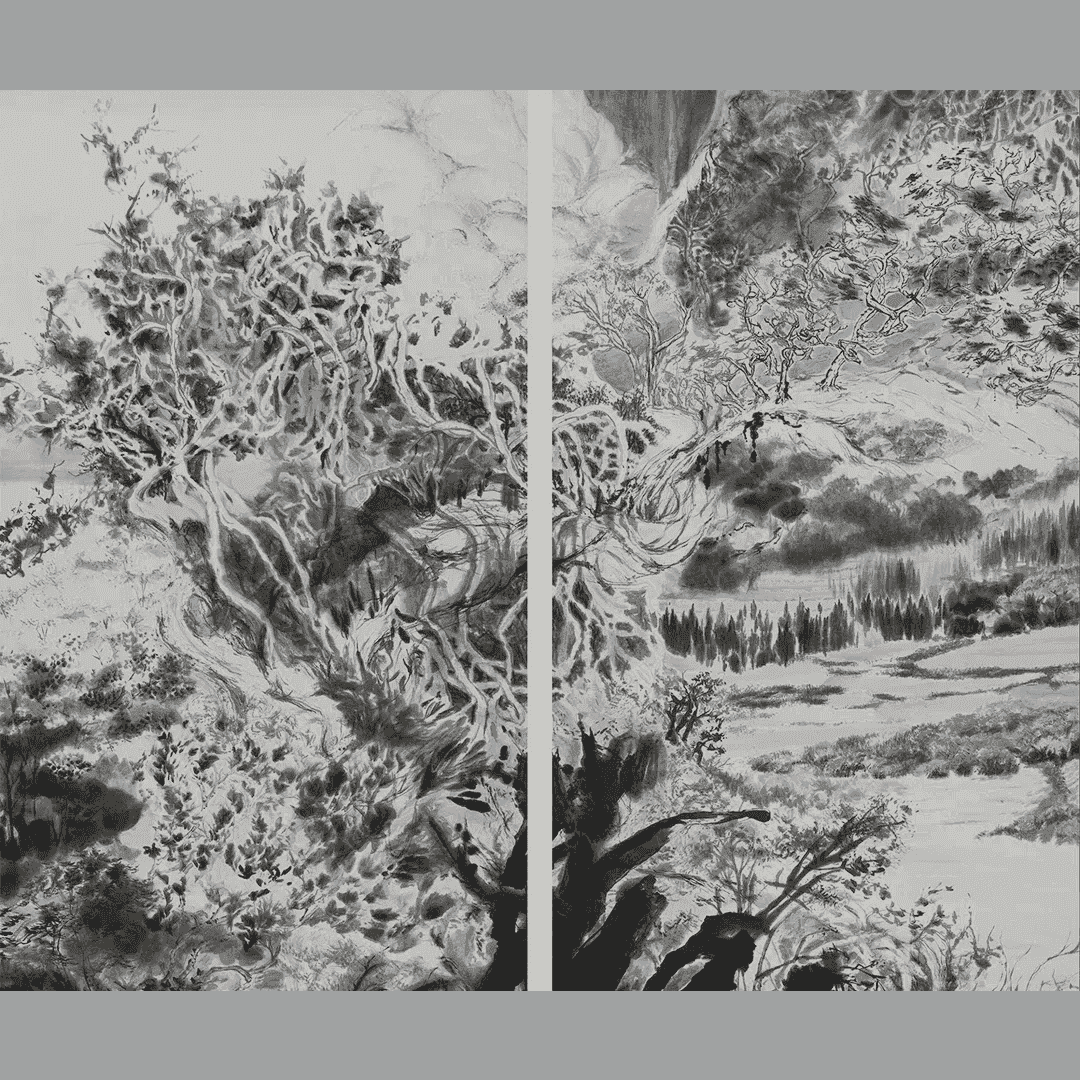
ABOUT THE ARTWORK
Season, Medium: Japanese Sumi-ink painting on paper, Dimensions: 183 x 152.3 cm, Year: 2023
Such scenery does not exist in Japan. Of course it does not exist anywhere in Asia or the world. Instead of just drawing the view as it is seen, I expressed the imaginary scenery by multi-view perspective. The piece measures 71 inches high by 115 inches wide. One work consists of three hanging scrolls arranged side by side (image of Japanese hanging scrolls). There is a way of thinking in East Asia that ”Sumi-ink has five colors". Five colors means all colors. Sumi-ink is not just black ink, it is an excellent art medium and history itself that can express all colors. When Tagore and Bengali painters interacted with Tenshin Okakura and Japanese painters 120 years ago, they also used Japanese Sumi-ink to paint. And now, even in India, Sumi-ink has captured the hearts of people all over the world. Sumi-ink painting, which can be said to be a common language around the world, is a symbol of cultural exchange around the world. Following the idea of Tagore, who is the great spirit, I expressed my own harmony with nature and the earth.
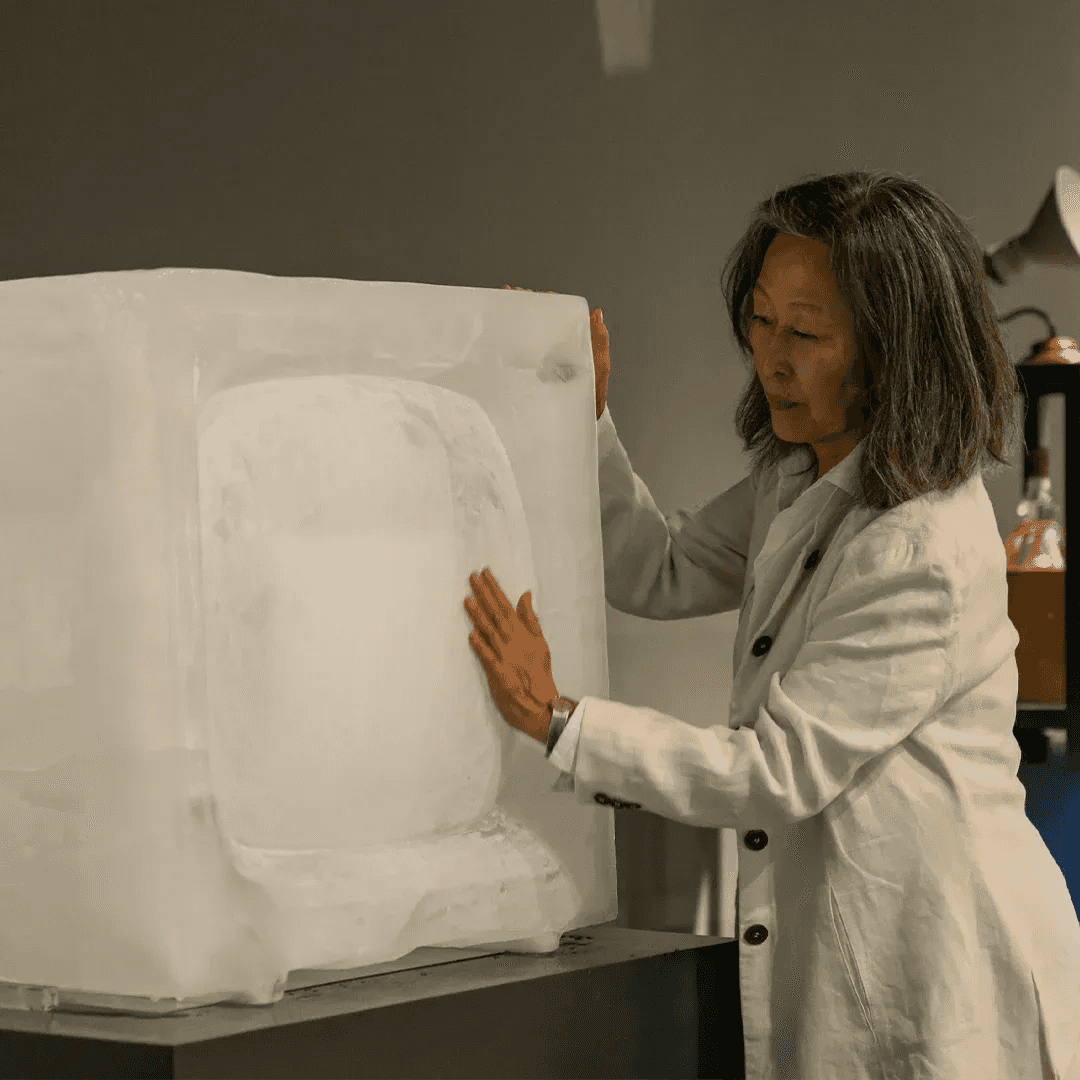
INTRODUCTION
KIM Soun Gui(b. 1946) graduated from the Department of Painting at Seoul National University and moved to France in 1971 upon invitation by the Centre Artistique de Rencontre International in Nice. She has since carried out her artwork primarily in France while also teaching at such institutions as the Ecole Nationale d’Art Décoratif de Nice and the Ecole Nationale Supérieure d’Art de Dijon. Her experimental works combined art, philosophy, and science as she associated with Nam June Paik, John Cage, and Ira Schneider among others. Kim worked closely with philosophers and artists in the southern France, a region known for lively intellectual debates since the protests of 1968. Since the 1980s, she has been living in a farmhouse that was renovated into a studio in Viels-Maisons on the outskirts of Paris. There, she contemplated the irreducible relationship between art and life by investigating concepts of time and space through various media spanning video, installation, drawing, and painting. Kim held a solo exhibition titled Lazy Cloud in 2019 at the National Museum of Modern and Contemporary Art, Seoul, and in 2023 at the ZKM | Center for Art and Media Karlsruhe.
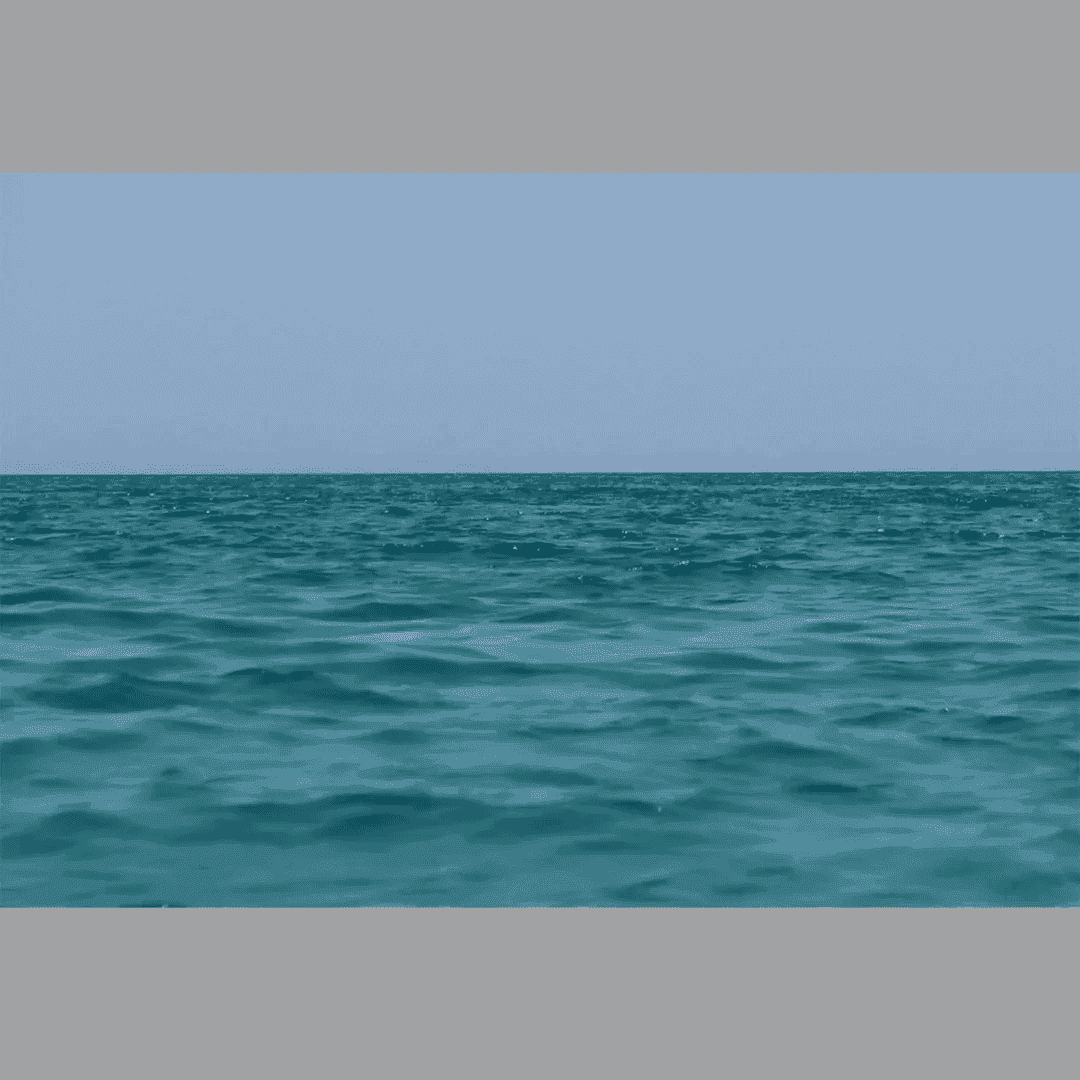
ABOUT THE ARTWORK
Mer-Mère, Medium: Single-channel video, color, Sound, Duration: 5 min 39 sec, Year: 2019
KIM Soun Gui worked on Mer-mère (2019) in Corsica after her mother passed away. Having migrated to France few decades ago, Kim’s work demonstrated culture that transcends the East and the West, the past and the future. During her career, it was her mother who had been unconditionally supporting Kim to ponder and thrive in a diverse, multicultural environment. In Mer-mère, the only thing that appears on the screen during the entire running time is a scenery of the Mediterranean Sea of Corsica, with surface water mildly moving back and forth. The mother who disappeared off the face of the earth is now behind the sea line. “La mer” means the sea in French. Having the same pronunciation as “la mère” (the mother), the title of the work is a play on words. Such wordplay provides room for imagination and/or retrospection for the individual audience to interpret the work in countless ways.
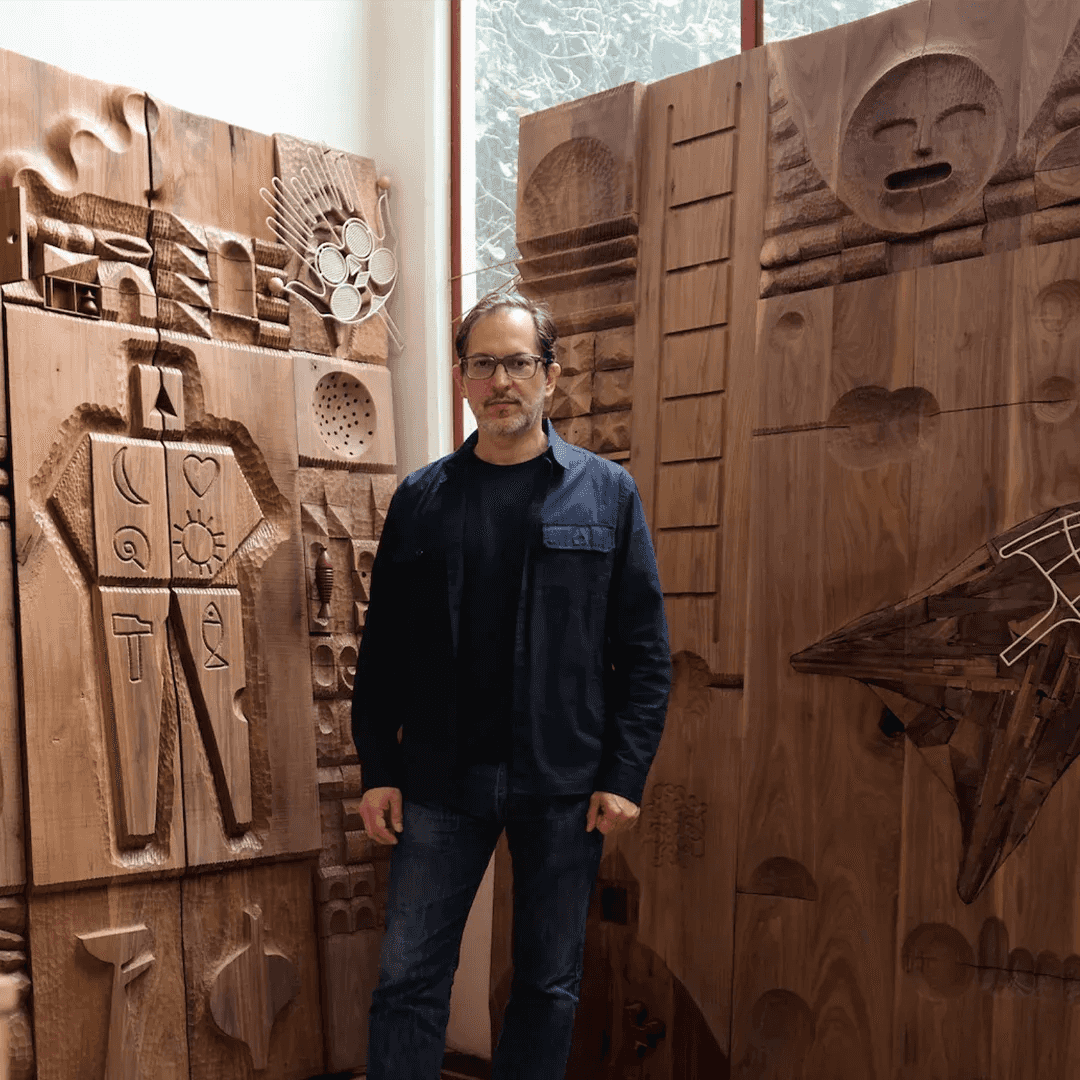
INTRODUCTION
Edgar Orlaineta (1972, Mexico City) lives and works in Mexico City. In his artistic practice, Orlaineta focuses on hybrid sculptural forms. Modernist ideals, popular culture as well as specific historic moments are echoed in the artist’s investigation. Orlaineta explores design and architecture from the post-war period: movements that generally depicted biomorphic shapes due to its strong influence by surrealism. Orlaineta also alters perception and questions the symbolic and economic value of things –industrial objects that at one point became mass products, despite of their original purposes–, by either incorporating craft elements or assembling objects of the every day that lack any historical relevance. When Orlaineta’s objects loose their functionality, historical cult or value, and present themselves opened to a new imagery, they replicate the legacy of the historical avant-garde.
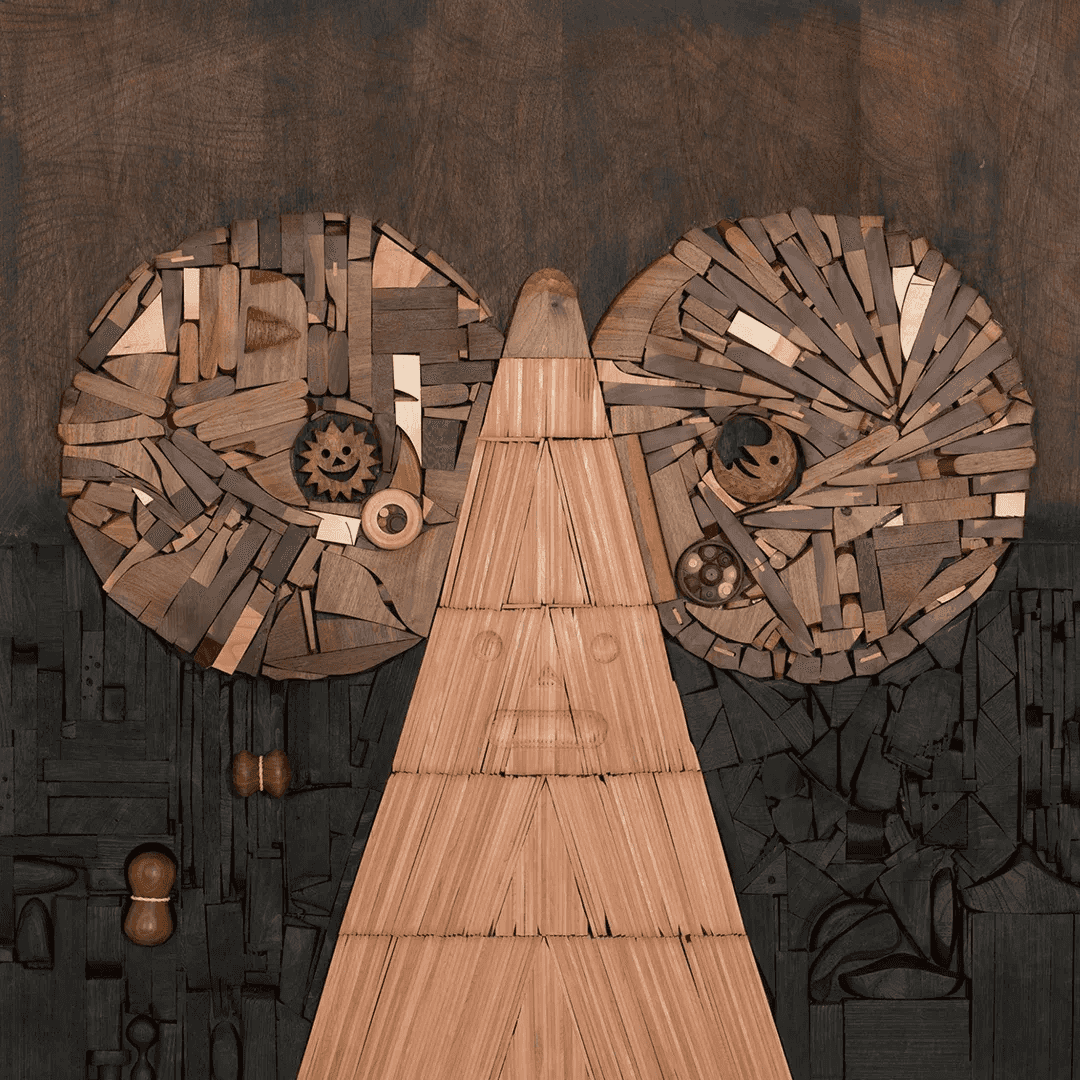
ABOUT THE ARTWORK
The Waif Mountain, Medium: Varnished wood (cedar, pine, walnut, cottonwood, plywood, beech, and wenge), acrylic paint, palm robe, colored pencils and wax, Dimensions: 120 x 120 x 11.3 cm, Year: 2020
Built from the "odds and ends" of other projects, these pieces reflect on the idea of the meditative state that comes intrinsically within the hand made process. Not as tradition, but as a more direct engagement with the world. It is a meditation on the thinking body, the thinking hand, and a method to create a space and a time that runs parallel to the accelerated times of today. Where everything changes in rhythm, becoming almost subversive. Different from previous work, these pieces have to do with the praxis rather than the investigation or the idea, where references automatically appear during the production process.
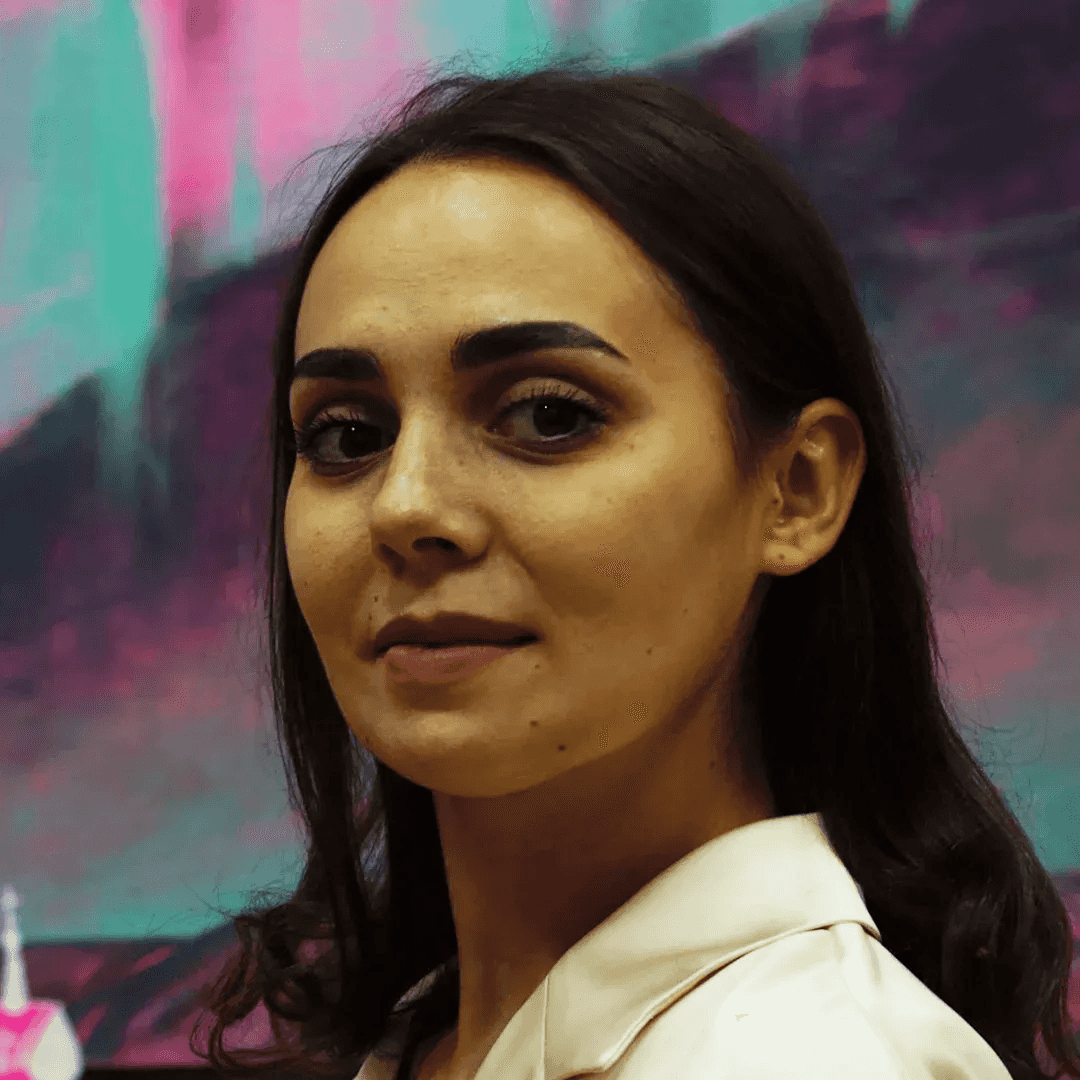
INTRODUCTION
Anna Maksimovich was born on September 7, 1994 in the city of Korolev (Moscow region). She has been drawing since childhood. In 2009, graduated from the Children's Art School of Korolev. In 2011, entered the Moscow Academic Art School in memory of 1905, at the Faculty of easel painting. Graduated in 2017. Educational works are now in the exhibition fund of the school. In 2017, entered the Moscow State Academic Art Institute named after V.I.Surikov. She studied at the studio of Monumental painting in the class of I.Lubennikova and E.Maximova. In 2023, she graduated the Institute. Educational works are now in the exhibition fund of the Institute.
During her studies took part in various projects, plein-airs and exhibitions. Some of them are:
- Exhibitions of young artists from Moscow Union of Artists in 2018, 2021, 2022;
- Festival of positive art “Time forward” in 2018;
- International Plein Air in Belarus in 2018;
- Richter Festival in Tarusa in 2022;
- Exhibitions supported by the foundation “Assistance to Domestic Art” in 2022, 2023
- The exhibition “Nature and man. National color” in the Moscow House of Nationalities in 2023
- Private exhibitions together with young artists.
The works are in private collections in Russia, Belarus, Spain, Switzerland, USA, Georgia, in the Belarusian Museum of Art.
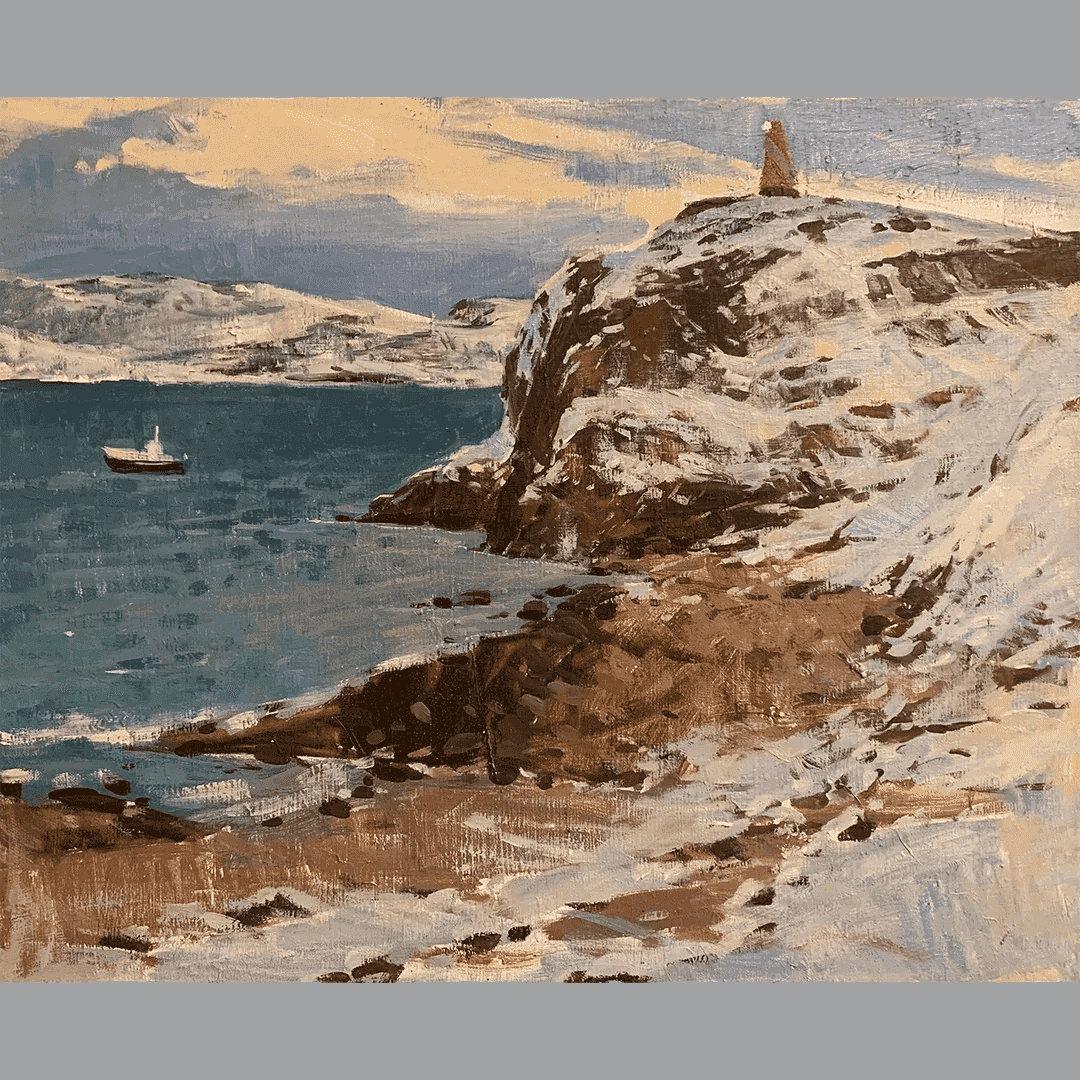
ABOUT THE ARTWORK
The Symbol of Light, Medium: Oil on canvas, Dimensions: 55 x 45 cm, Year: 2021
The work “Symbol of Light” was painted from nature in the far north, on the shore of the Barents Sea, in the village of Teriberka. In fact, this is the edge of the earth, further only the Arctic Ocean. The work depicts a lighthouse, or rather, a small navigation sign guiding boats.
Lighthouses have always attracted me with their deep, beautiful and encouraging symbolism, because easily traversed parts of the way do not need lighthouses. They illuminate the paths from the Arctic Ocean, to the southernmost point of the Indian Ocean, all over the world. A symbol of light, a symbol of hope. Hope for the successful achievement of the goal, for the future.
The future, which is impossible without careful attitude to the present. To what surrounds us. To the world we live in. To each other.
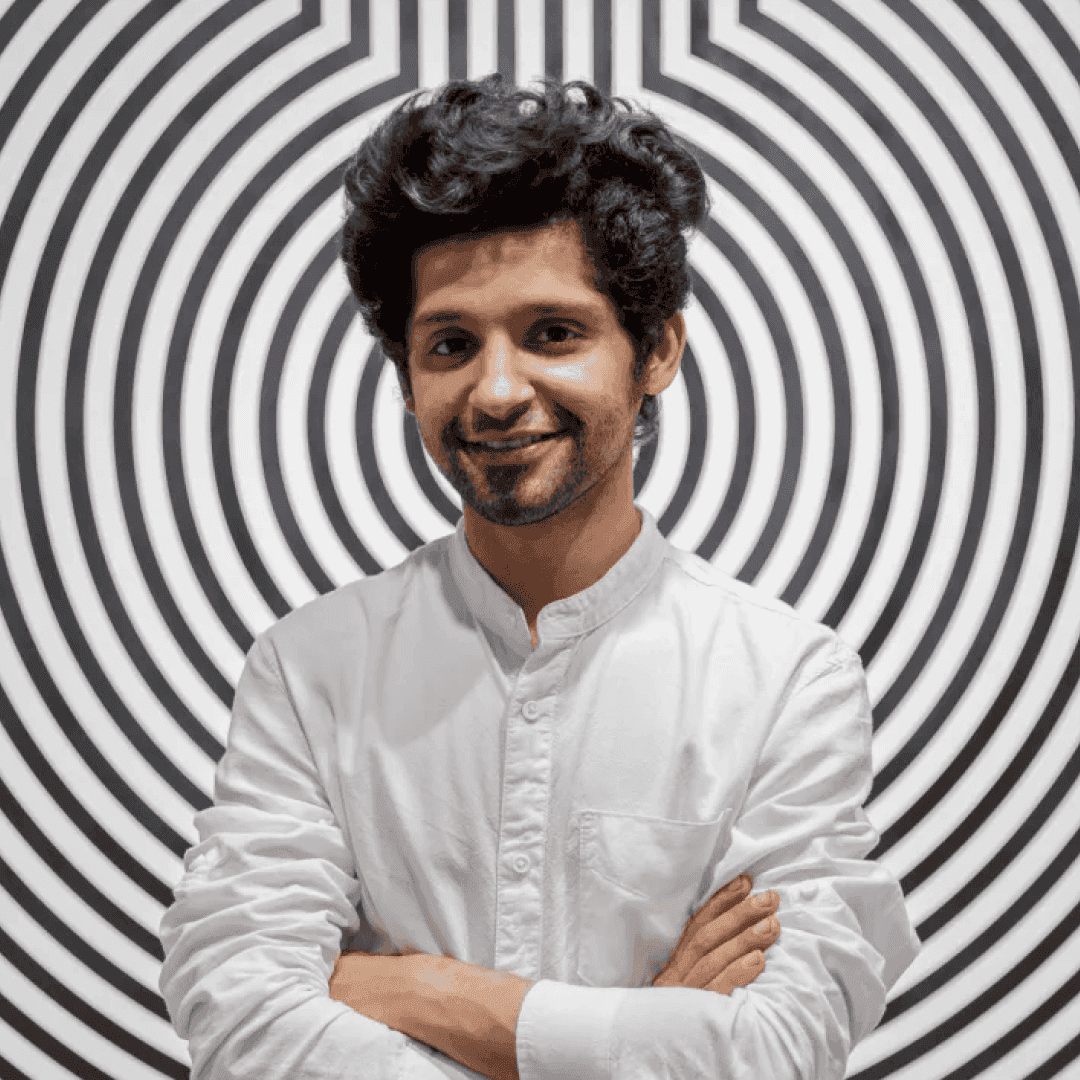
INTRODUCTION
Nasser Al-Salem, born in 1984 in Mecca, lives and works between Jeddah and Riyadh. He received his undergraduate degree in Architecture at Um Al- Kora University in Mecca andstudied calligraphy in the Haram Al-Sharif. His fascination with calligraphy as a youngster led his parents to enrol him in calligraphy classes held every Friday. He received an ‘Ijaza’ certificate – the highest form of recognition and authorization to transmit the art of calligraphy.
Al Salem’sartistic practice challenges the boundaries of the traditional Islamic art of calligraphy by re-contextualizing it in unconventional mixed media forms and conceptual potential through minimalist and architectural methods. His contributions to the contemporary art realm seamlessly fuse various artistic techniques with Conceptualism and the notion of independent objects. Frequently, his subjects delve into profound philosophical themes, including humanity's role in the world, the abstract concept of time, and expressions of devotion.
He is co-founder of Al-Hangar, an artist collective based in Jeddah, a member of the National Guild of Calligraphers and an active fellow of Saudi Arabia’s Arts and Culture Group. He has held solo shows at Amma Baad, at Delfina Foundation, London [2019], Amma Baad, Casa Arabe, Madrid, Spain [2019], State of Affairs, Athr, Gallery, Jeddah [2016], And It Remains, Athr Gallery, Jeddah [2012], among others. He has exhibited internationally in group shows such as Desert X Al Ula [2020]; Al Burda, Abu Dhabi; Ekphrasis, Writing in Art, Villa Empain, Brussels [2019]; Cities of Convictions, Utah Museum of Contemporary Art, Utah; Epicenter X: Contemporary Saudi Art, Arab American National Museum, Detroit [2017] and more. His work is part of the collection of The British Museum, London, LACMA Museum, Los Angeles.
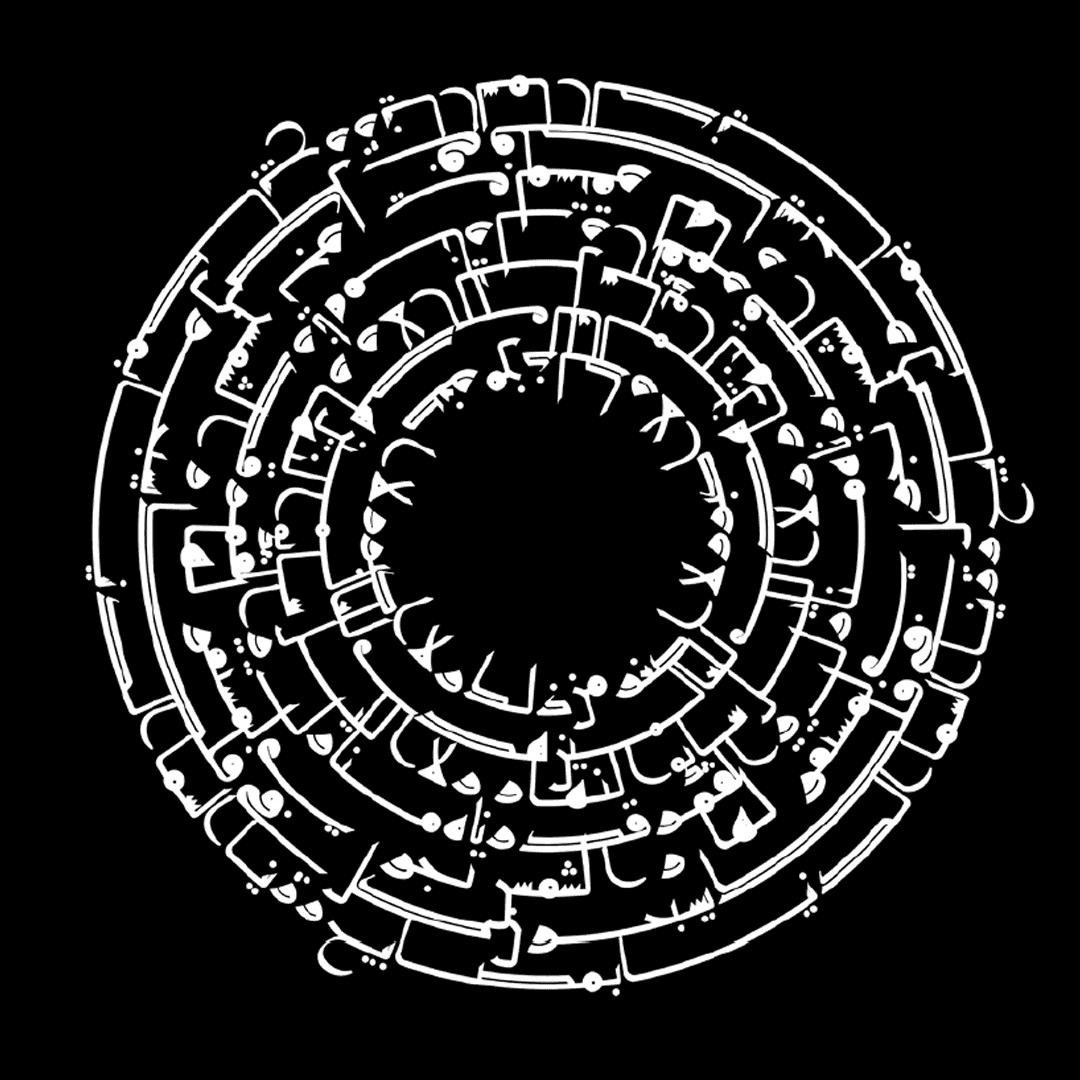
ABOUT THE ARTWORK
An Adornment of Stars, Medium: Print on acid free paper, faced with diasec, Dimensions: 140 x 140 cm, Year: 2014 - 2021
‘An Adornment of Stars’ serves as a contemplation of the recurring journey of spiritual exploration and the equilibrium within the cosmos. Comprising of seven interlocking circles, each adorned with a segment from a Quranic verse in the elegant Kufic script, this work pays homage to the awe-inspiring intricacies of the universe. The artist purposefully selected the number seven, drawing parallels between the renowned pre-Islamic poems known as the Mu’allaqat, traditionally hung at the Ka'ba in Mecca, and the seven circumambulations (tawaf) conducted during the Haj pilgrimage. The artist muses upon the cyclical nature of ‘tawaf,’ akin to the Earth's rotation, the moon's orbit around the Earth, and their collective journey around the sun.
What initially struck Nasser Al-Salem were the seven Moallaqat that surrounded the Ka’ba and he immediately drew a parallel with the ‘tawaf.’ He wondered if this was coincidental and pondered about the number Seven. This led him to a chain of observations, customary with his practice, and where they lead him in those particular moments of his life, not necessarily from pre-existing convictions.
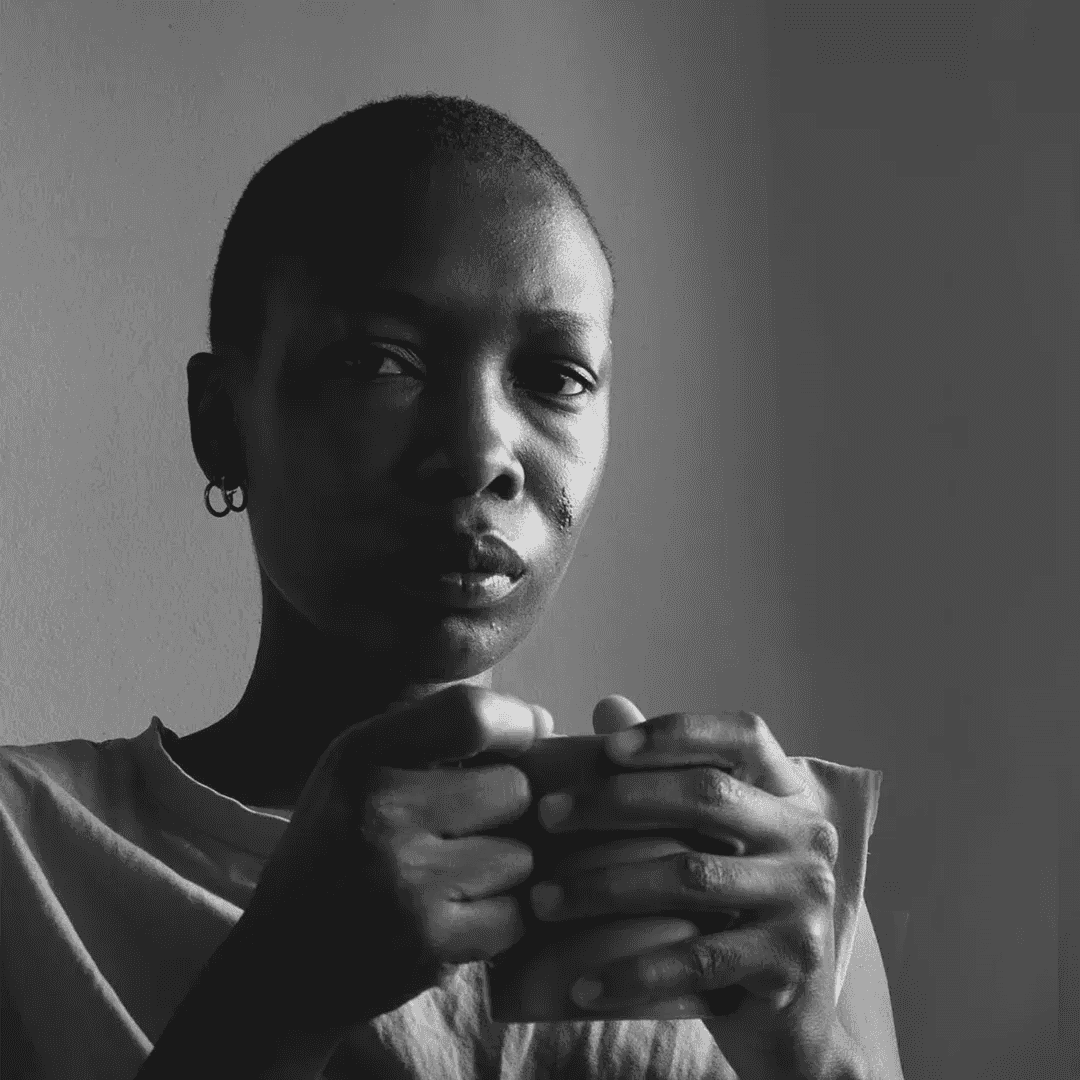
INTRODUCTION
Thalente Khomo is a multidisciplinary artist born on September 25, 1995, in the South Coast village of Gcilima, KwaZulu-Natal, South Africa. Currently based in Johannesburg, Thalente works as a freelance artist, specializing in photography, textile, performance, and printmaking. Thalente holds a Bachelor of Technology degree in photography from the Durban University of Technology, which was completed in 2019 after five years of study, including a year dedicated to arts and design. Thalente's artistic practice revolves around posed portraits, serving as the foundation of their photography work. Through their images, they aim to visually express a universe that intertwines the physical and spiritual realms, drawing from personal and cultural experiences. Their artistic style is characterized by a distinct use of saturation and contrast, with subjects' skin tones often transformed into rich greyscale while the backgrounds are vividly colored. Thalente has actively participated in numerous group exhibitions and residencies across South Africa. These include the Electric South 2022 New Dimensions AR/VR Lab, the Durban Art Gallery group exhibition "Inkaba," the Daor Contemporary gallery group exhibition in 2022 (Cape Town), the AVA gallery cultural exchange exhibition in 2021 (Cape Town), and inclusion in The North-West University gallery Art Bank collection in 2021 (Klerksdorp). Other notable exhibitions and residencies include the 2019 Artist in Residence at the Orms Cape Town School of Photography, the Greatmore Studios Thupelo Art Workshop residency in 2019 (Pietermaritzburg), and participation in the Ikhono lase Natal (Zanele Muholi commission) at the KZNSA gallery in 2019 (Durban). Thalente's work explores themes of identity, spirituality, and cultural heritage, offering viewers a unique perspective on contemporary and ancient narratives.
CONCEPT NOTE
Through my work, I aim to delve into my childhood memories, exploring them to gain a deeper understanding of belonging. My practice centers on themes of spirituality, trauma, and antiquity, all filtered through the lens of imagination, research, self-evaluation, and recollection. Additionally, I am fascinated by the memories that second-hand clothing carries and how these experiences, woven into fabric, connect people. As part of my exploration of this concept, I also draw parallels between humanity and the environment. To express these ideas, I utilise photography, printmaking performance, and textiles as my mediums of expression.
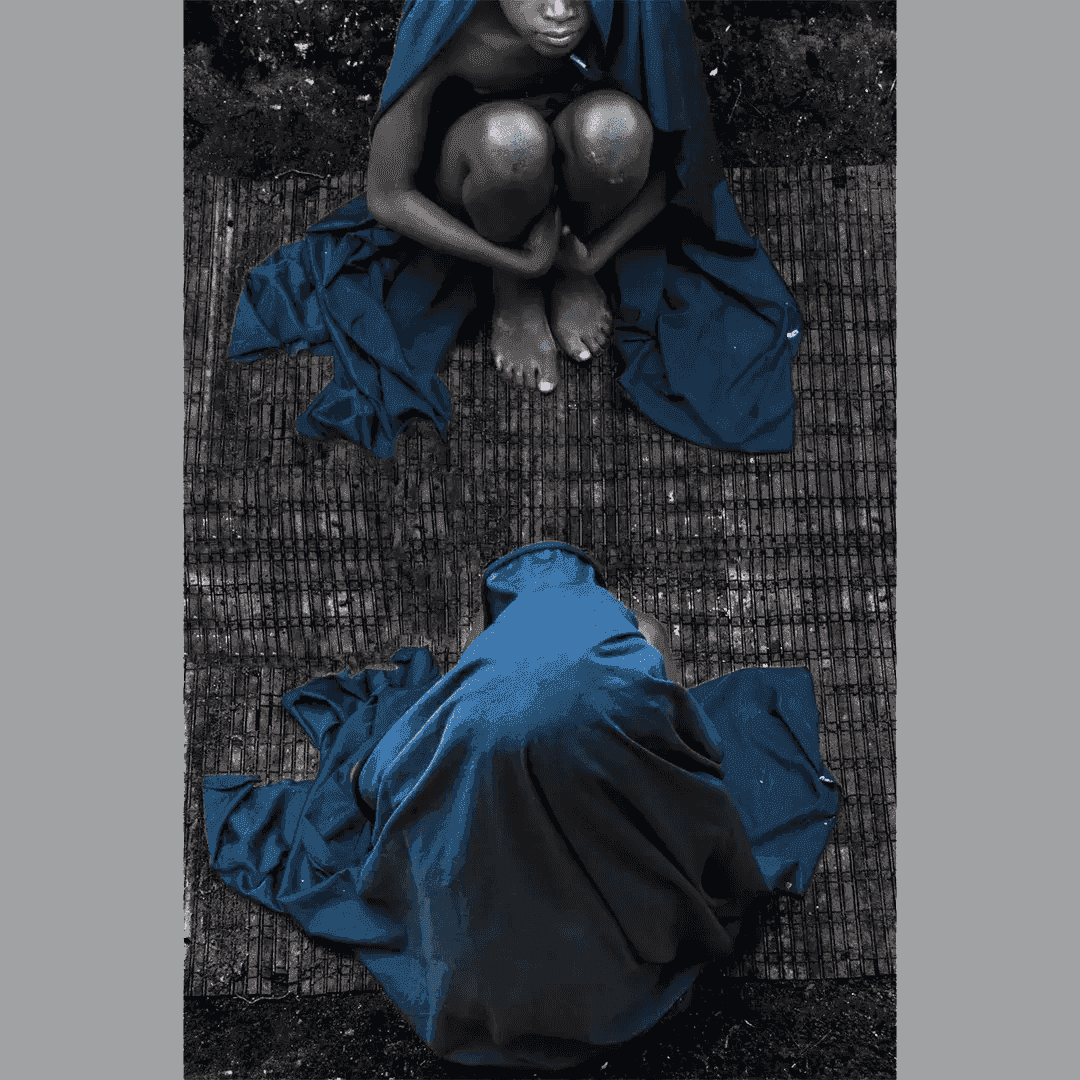
ABOUT THE ARTWORK
Untitled, Medium: Photograph, Dimensions: 118.9 x 84.1 cm, Year: 2017
This artwork forms part of a bigger body of her work. In the artist's words, “This series acknowledges the presence of others that reside within us.” In this work, Thalente comments on the critical connections that exist between the exploitation of women and environmental degradation. She uses photographs as a medium of expression. This photograph delves into the captivating theme of nostalgia while portraying the mirroring of a past life that was intertwined with a child's journey, tinged with elements of trauma. At its core, the mirror featured in the artwork serves as a powerful symbol, representing the avenue of introspection through the eyes of a young child. The core of her artistic practice revolves around themes of spirituality, trauma and antiquity. All three are viewed through the unique prism of imagination, research, self-reflection and recollection. Additionally, she harbours a profound fascination for the stories embedded within second-hand clothing, and she recognises how these experiences, interwoven into the fabric, establish connections among individuals.
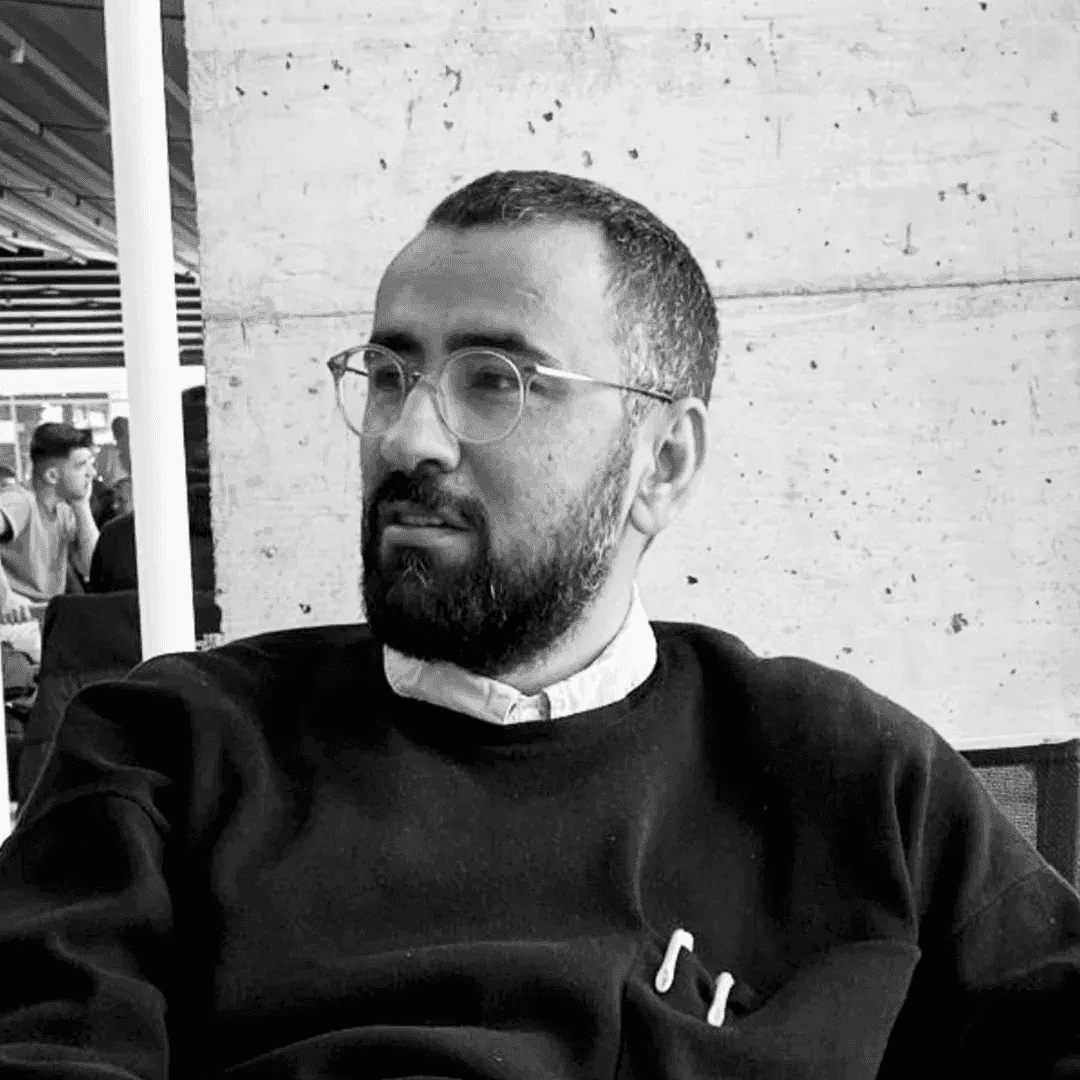
INTRODUCTION
Designer / artist Yunus Ak was born in Mardin, on the Turkish-Syrian border, in 1984. He grew up familiar with various languages such as Kurdish, Turkish, Arabic, Syriac, Aramaic in this city where mosques, tombs, churches, monasteries are located.
As a person who is accustomed to living together with cultural diversity, he migrated to Istanbul with his family. Due to the cultural diversity of the neighborhood they migrated to, lived together with Romanis, Armenians, Kurds and then immigrants from Africa. His childhood and early adolescence were spent with folk songs, laments of dengbejs, halay dances, church bells, polyphonic church music, Romani dances and street fights. Growing up in this rich cultural heritage helped shape his identity with the music, dance and narratives of different cultures.
Living in a multicultural universe enabled him to reflect his art and design practice by creating another language that often does not exist, contrary to expectations. The tools he uses in his design works also vary for this reason. Instead of the concepts/meanings/forms that come to mind first, he constructs the phenomena that are wanted to be described metaphorically from a different perspective. The artist/designer creates an abstract, indirect and instinctive universe in the universe he creates by using various channels such as books, posters, animation, typography, writing, form and color. As an example of this, RE:RE:, the project of two designers in which they experience communicating only through forms without using words or text, was published as a book and exhibited in 2021. He produces projects that he creates in the light of his own design practice in the Beautiful Problems Design Studio, of which he is the founding partner.
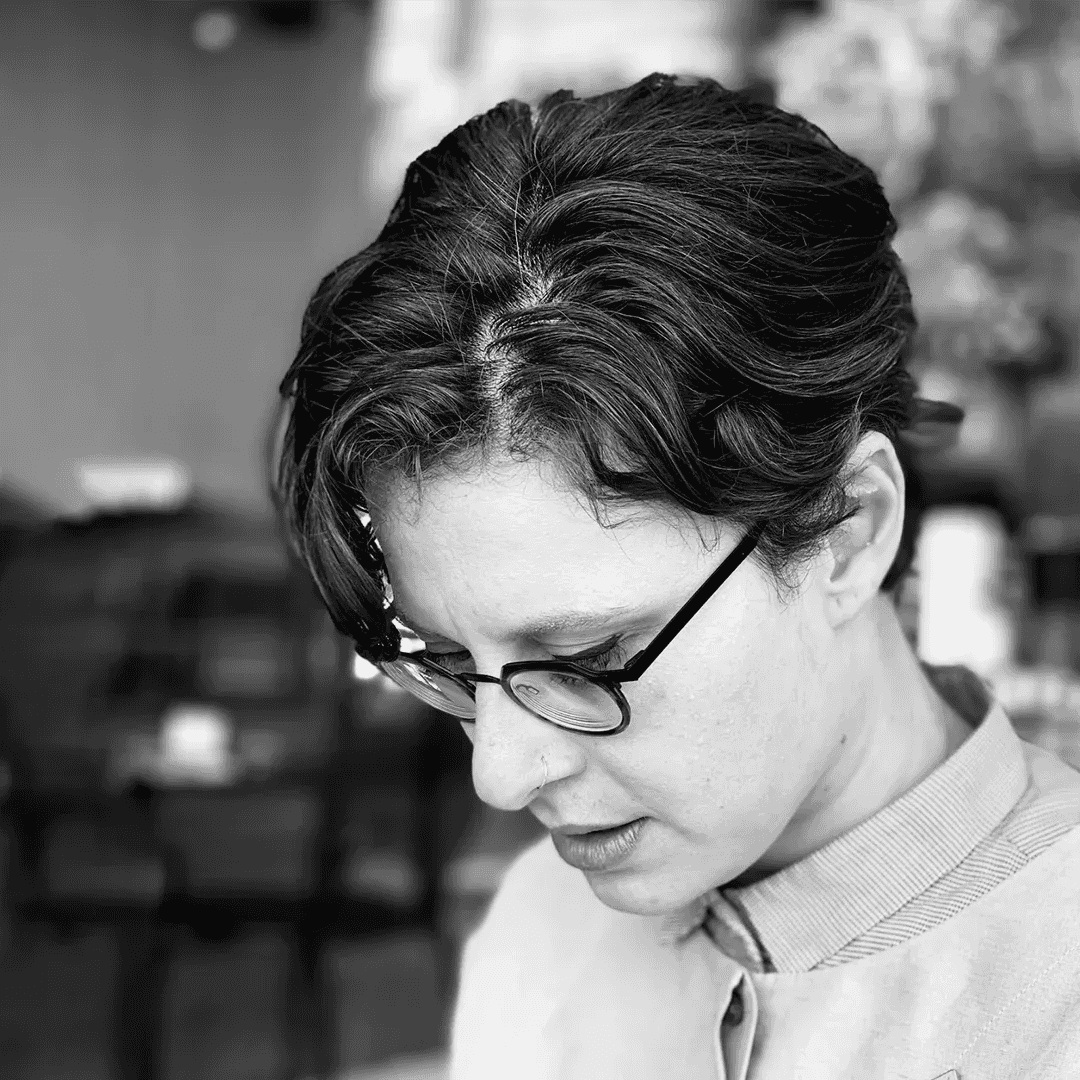
INTRODUCTION
Istanbul based artist/designer Zeynep Özüm Ak was born in Ankara in 1986. Since her childhood, subjects such as mother language, cultural erosion, music and cultural transmission through mother language attracted his attention and contributed greatly to shaping her personality.
In her master's thesis, she focused her studies on endangered languages and the alphabets. She started her doctoral project in 2018, in which he researched collaborations between contemporary composers and designers in order to develop her interest in music in the light of a scientific perspective.
The artist/designer works on the projects where she experiences the effects of music, forms, objects, texts, typography and visual expression styles in enriching the channels of communication. The artist/designer, co-founder of the Beautiful Problems Design Studio, shapes both design and art practice in the light of ambiguity, instinctiveness and randomness.

ABOUT THE ARTWORK
The Kara Düzen Project, Medium: Video Series, Duration: 10 min 14 sec, 09 min 15 sec, Year: 2014-2016
Folk songs are one of the greatest spiritual tools that play a role in the transfer of culture from one generation to another. Culture is fermented with the first lullaby a mother sings to her baby. Each melody that passes through the filter of time goes back to the roots of the culture in which it developed. In traditional folk songs, it is often unknown who is the one who lines the lyrics and who arranges the notes. The feelings of someone whose face we have never seen, perhaps for centuries, have been carried by people whose face we do not know, and we have added their troubles to our troubles and their joys to our joys.
The Kara Düzen Project is a project that aims to build bridges from their own culture to the culture of others with folk songs. Participants who are part of the project teach each other songs from their own cultures. Emotions, melodies are provided by a cross-cultural flow from person to person. What matters is not who sings what song or how. What really matters is who is imbued with what culture.
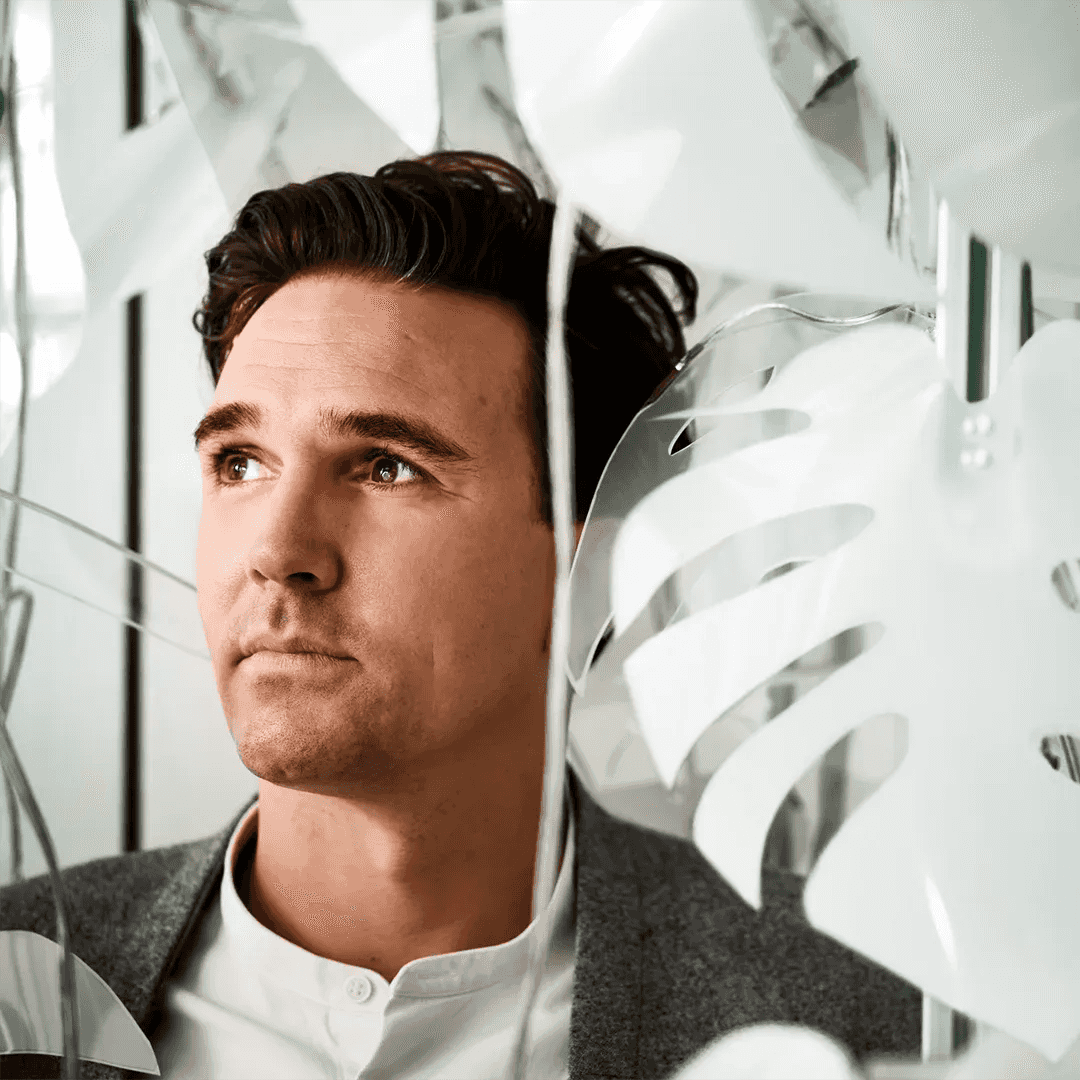
INTRODUCTION
Ecological artist Thijs Biersteker creates interactive awareness installations about the world's most pressing issues of today. By entangling art and environmental scientific data he provokes insight into the ecological challenges ahead and what we might learn from them.
The artwork Econario will be presented at the G20 in collaboration with the Natural History Museum, the British Council and IAG.
Collaborating with top scientists and universities he seamlessly weaves together their scientific research with new technologies to create empowering art installations that make big environmental challenges accessible and relatable. Both intellectually and technologically.
His immersive installations often described as eco - or awareness art, make the invisible impact we have on the world around us visible. Topics like climate change, tree communication, air pollution, mycelium networks, ocean plastic, and the biodiversity crisis are turned into tangible experiences that create much-needed awareness around the world.
His work is recognized for its fluid mixture of data, sensors and living trees, kinetic engines and fragile mycelium, big data visualizations and recycled plastics, artificial intelligence, and plant intelligence. The artworks are produced in a circular and sustainable way with a material passport for the next generation to recycle the works.
Currently, Biersteker holds a Fellowship at the VU University in Amsterdam, he has shaped the course of art Ethics & Empathy at the Delft University of Technology (NL). He has won awards like the prestigious Lumen Prize for digital art, got nominated for the Stars Prize from Ars Electronica multiple times, the New Technology Art Award, and many more. He is a 3 x TED speaker and has exhibited at Fondation Cartier pour l’art contemporain Paris (FR), Today Art Museum (CN), Barbican centre London (UK), Stedelijk Museum Amsterdam (NL), Science Gallery Dublin (IE), SXSW (USA), Science Centre Kuwait (KW), Mu Gallery (NL) and has been featured in Wired, New Scientist, Financial Times, art tribute, Discovery Channel and many more.
He is also the founder of Woven Studio where science-based artworks are created in a circular and sustainable way. Emission calculations and recyclability come together in a material passport attached to each artwork.
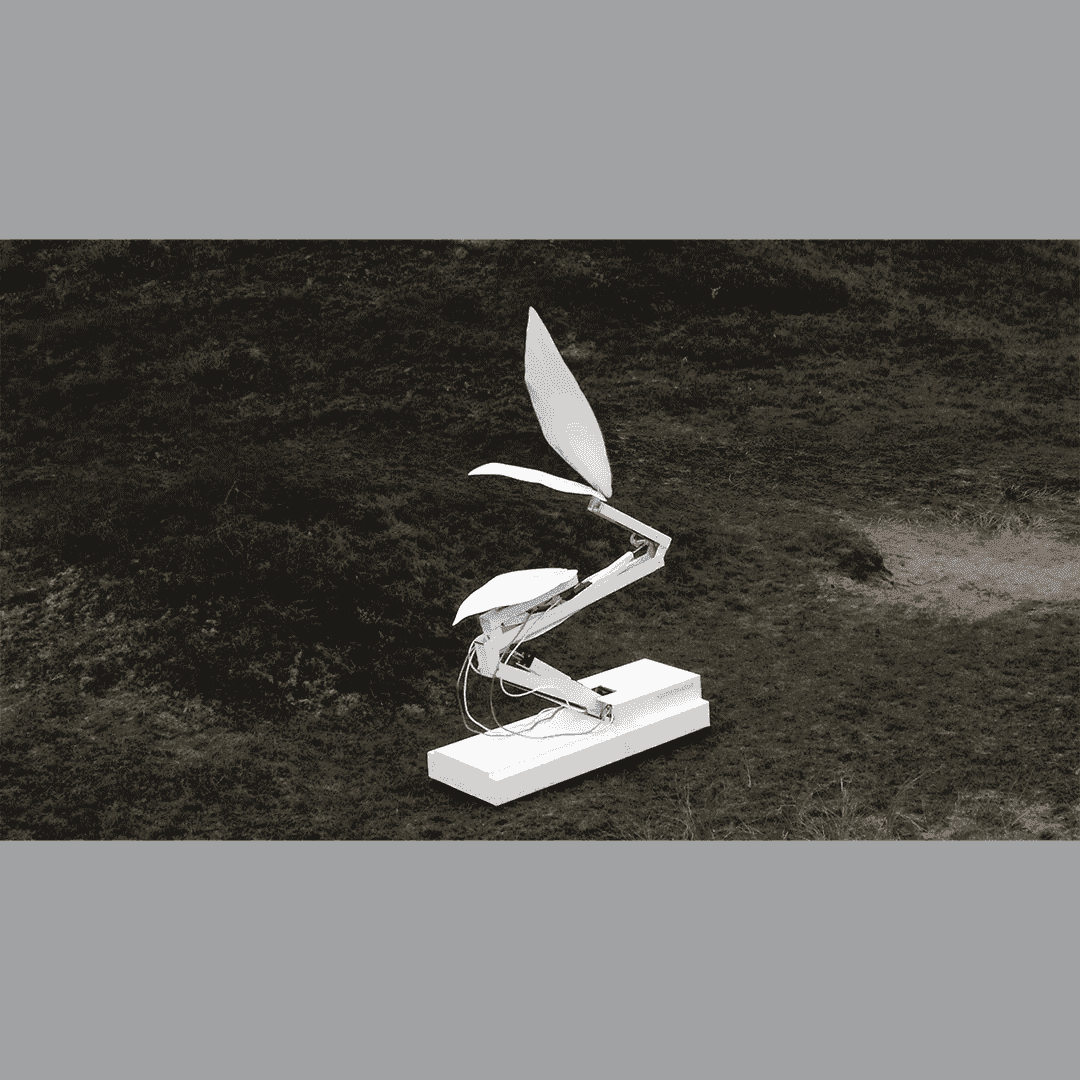
ABOUT THE ARTWORK
Econario, Medium: Metal, servo engines, custom code, BII data, Dimensions: 220 x 83 x 520 cm, Year: 2022
Robotic Plant, Econario, grows on Natural History Museum biodiversity data to demonstrate impact of choices we are making now on the future of the natural world, supported by the British Council and IAG.
Ecological artist Thijs Biersteker has created a 5-metre-tall robotic plant, using biodiversity data from the Natural History Museum, to create a (literally) moving monument to the importance of the choices we are making now for the future of our planet.
Ecological artist Thijs Biersteker has created a 5-metre-tall robotic plant, using biodiversity data from the Natural History Museum, to create a (literally) moving monument to the importance of the choices we are making now for the future of our planet. The artwork ‘Econario’ provides a powerful representation of how choices society makes today will affect the state of nature over the next thirty years.
The robotic plant moves like a small fragile seedling, growing, not with the help of nutrients, but driven by changes over time in the Biodiversity Intactness Index (BII) – a metric developed by the Natural History Museum as a measure of how much of a region’s natural biodiversity still persists. The BII is a rigorous approach to estimating biodiversity loss that combines data on ecosystems and species populations with data on human-caused pressures like land use. It is underpinned by the Museum’s PREDICTS database - a global, open database which now comprises 4.9 million data points, from over 46,000 sites in over 100 countries – a taxonomically representative set of 58,000 plant, animal and fungal species.
When the artwork is folded, the plant has an industrial look, but as biodiversity increases and the work unfolds, the plant-like motion gives the work an organic feel. As the artwork switches between countries, it is showing the biodiversity intactness in 2050 based on five different political scenarios we, as society, can choose today. For example, when the Netherlands chooses a sustainable scenario, the artwork grows towards its full five meters length. However, a scenario in which a country continues to burn fossil fuels as it does in 2022, will make the artwork shrink rapidly back towards its most mechanical state.
The artwork makes technical data and statistics resonate on a personal level by representing data from the location where the work is being exhibited. It is showing us a choice in a time when we still have a choice. ‘Econario’ has been exhibited at museums like the Kunstkerk (NL) and conferences like COP15 in Montreal and the World Government Summit in Dubai.
Thijs Biersteker, ecological artist says’ “I always wanted to make an artwork that shows how woven our environmental choices of today are with that of our future. The BII data from the Natural history Museum gives a small glimpse of those futures. Now people can see it play out in front of them.”
Professor Andy Purvis, biodiversity researcher at the Natural History Museum says; “I am blown away by this piece. The numbers around biodiversity loss are cold hard facts, but cold hard facts never grabbed anyone by the heart. With Econario, you feel joy when it grows and becomes more natural; and you feel pain when it wilts. It has soul. And it really brings home what’s at stake.”
Dr Adriana De Palma, biodiversity researcher at the Natural History Museum says: “When it feels like our actions and decisions only affect other people, other places or other times, it’s easy to feel detached from the data; it’s easy to overlook the evidence. Econario doesn’t just show us the plight of the natural world, it makes us feel it. It reminds us of the beauty in nature and in human ingenuity and gives us hope that we can make a difference.”
Alison Barrett, MBE, Director India, British Council says: "The collaboration between the Natural History Museum in the UK and artist Thijs Biersteker is an astonishing creative response to our most pressing global challenge, climate change, bringing arts and science together as insipiration for collective action to protect the planet. The British Council is delighted to shine the spotlight on the incredible robotic plant Econario for the G20 in India.”
Indicated by small screens on the sides of the work, the visitor can see which scenario and where in the world is being visualised, as well as what will have happened to BII between now and 2050 . In the exhibition space a moving information graphic shows a deep dive into the science behind the data developed by the Natural History Museum.
Visitors learn that when biodiversity intactness reaches 90% or more, the area is resilient and a functioning ecosystem. When intactness falls to 30% or less, visitors will be warned that the area’s ecosystem is at risk of collapse. Few countries are at 90% today, and most of the scenarios suggest even fewer will be in 2050.
The Natural History Museum’s Biodiversity Trends Explorer Biodiversity measurement is complicated – encompassing species abundance, species diversity, ecosystem health and much more – yet it has never been more critical to be able to monitor change and predict future losses. The Natural History Museum has also opened-up the Biodiversity Intactness Index data through a digital tool which makes this data easy to find, understand, visualise, filter and download for anyone who wishes to use it.
Responding to a genuine need for rigorous, transparent and interpretative data, the Biodiversity Trends Explorer allows users to track modelled biodiversity changes since 2000 – globally, nationally and regionally. Future versions will also demonstrate what is driving that loss – and how those drivers have changed.
Each country’s biodiversity intactness, where established, is visualised to place their statistics in a global and a regional context. Using these statistical models based on the 4.7m records, the tool shows projections under the Shared Socioeconomic Pathways to 2050.
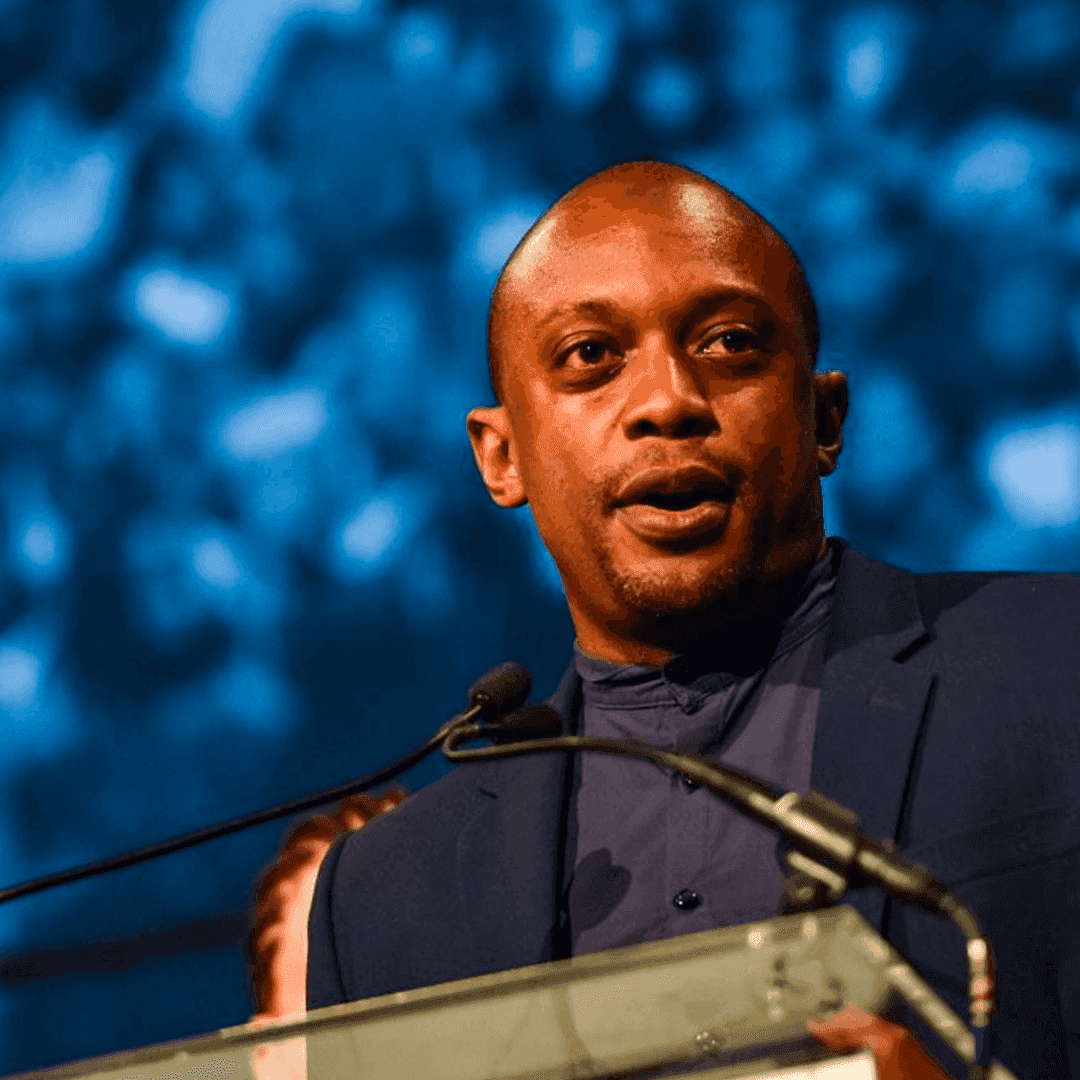
INTRODUCTION
Hank Willis Thomas, born in 1976 in Plainfield, New Jersey, lives and works in Brooklyn, New York as a conceptual artist. He works primarily with themes related to perspective, identity, commodity, media and popular culture. Thomas holds a B.F.A. from New York University, New York, NY (1998) and an M.A./M.F.A. from the California College of the Arts, San Francisco, CA (2004). He received honorary doctorates from the Maryland Institute of Art, Baltimore, MD and the Institute for Doctoral Studies in the Visual Arts, Portland, ME in 2017. His work has been exhibited throughout the United States and abroad including the International Center of Photography, Guggenheim Museum Bilbao, Musée du quai Branly, Hong Kong Arts Centre and the Witte de With Center for Contemporary Art.
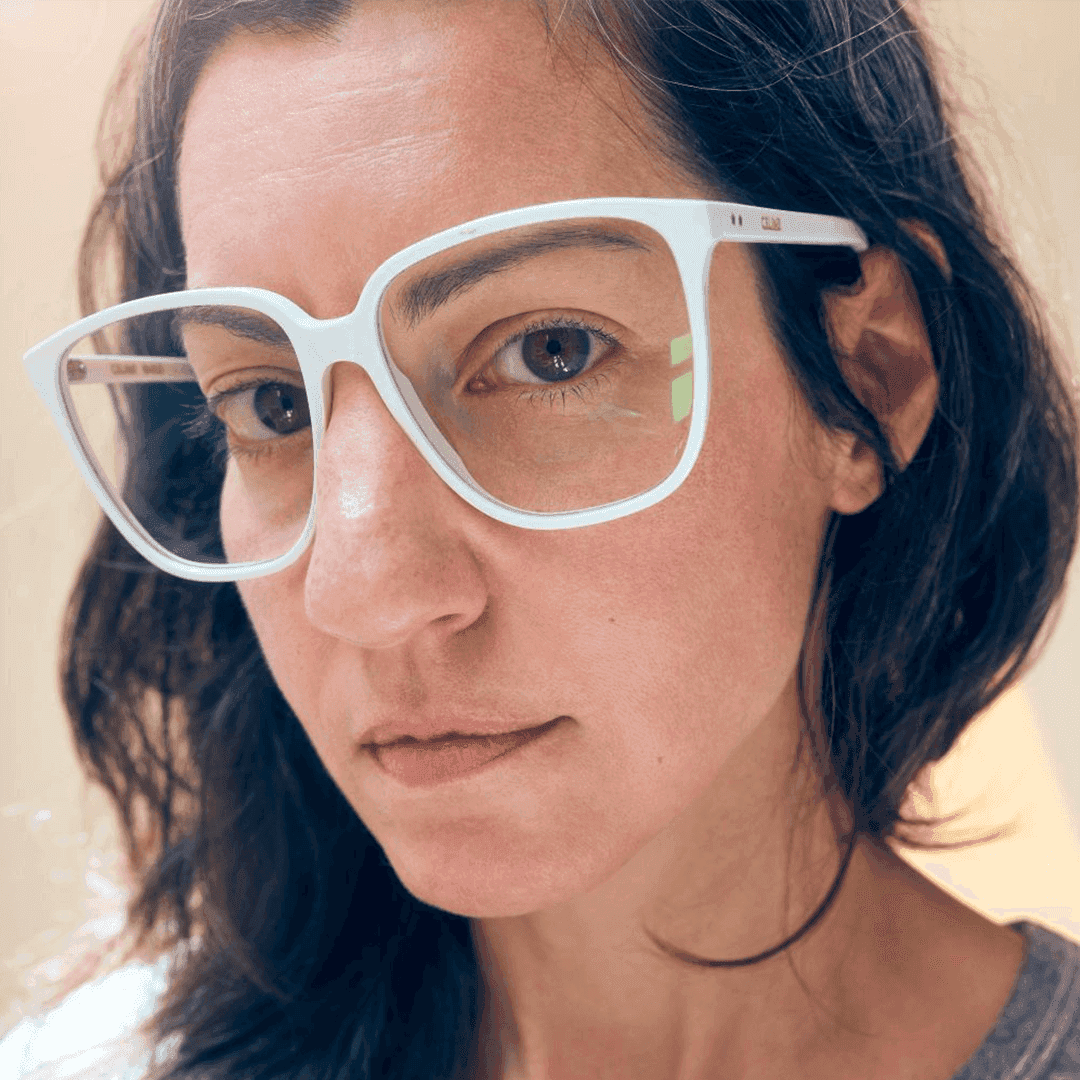
INTRODUCTION
Emily Shur was born in New York City and grew up in Houston, Texas. She currently lives in Los Angeles with her husband and their dog Momo. Her original style connects her diverse portfolio where she mixes vibrant colour and personality with strong conceptual storytelling. Her work has been exhibited at London’s National Portrait Gallery, the Museum of Fine Arts Houston, Hirshhorn Museum, International Center of Photography, and her art is held in the permanent collection of the Whitney Museum of American Art.
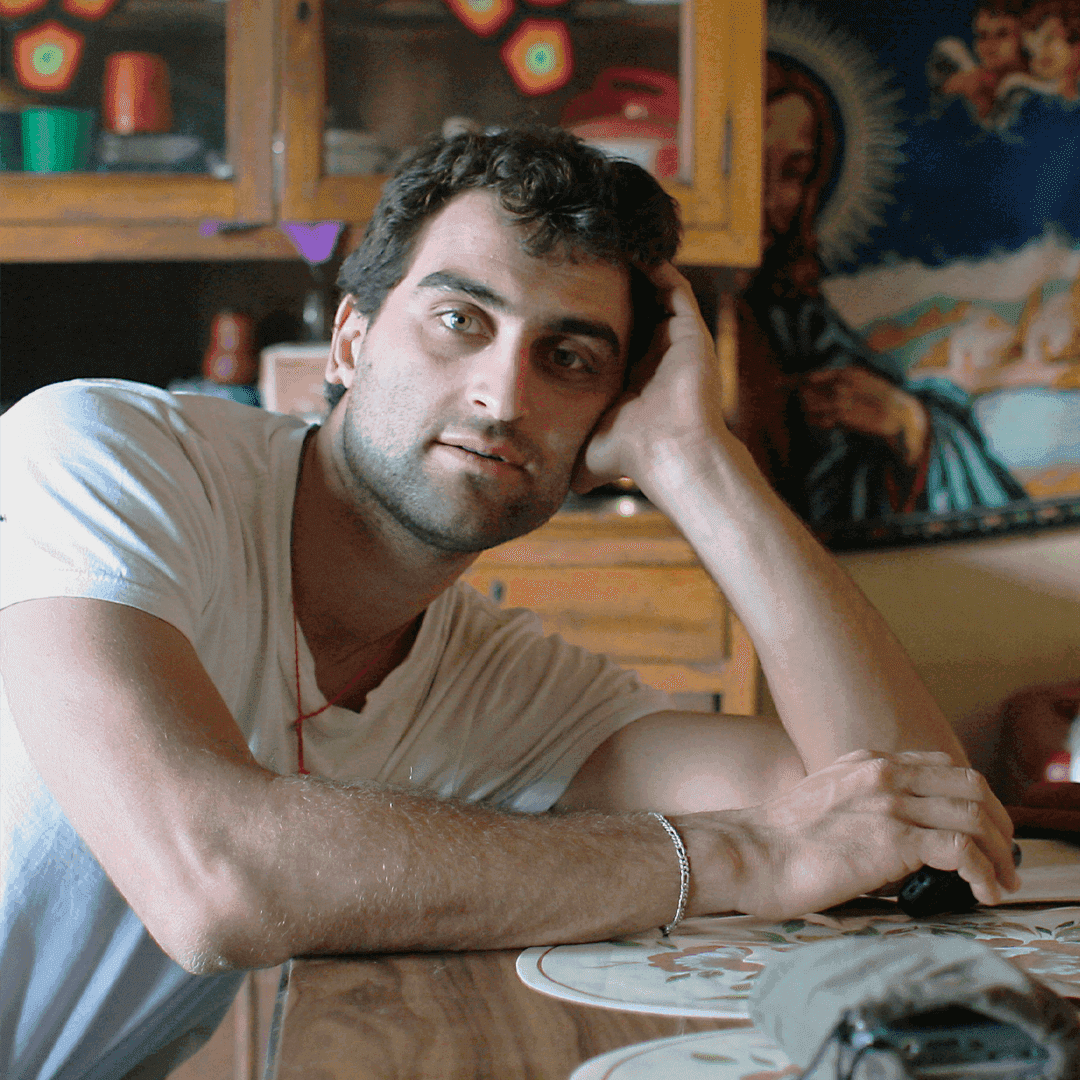
INTRODUCTION
Eric Gottesman, born in 1976 in Nashua, New Hampshire, is an artist whose work addresses nationalism, migration, structural violence, history and intimate relations. He is an Assistant Professor of Art at the State University of New York, Purchase College and a Mentor in the Arab Documentary Photography Program in Beirut, Lebanon. His projects question the accepted notions of power. By engaging communities in critical self-reflection and creative expression, he proposes repair models. Gottesman’s work is always collaborative. He has never made an artwork alone. Gottesman co-founded Four Freedoms, an award-winning initiative for art and civic engagement named the “largest creative collaboration in United States history” by TIME Magazine.
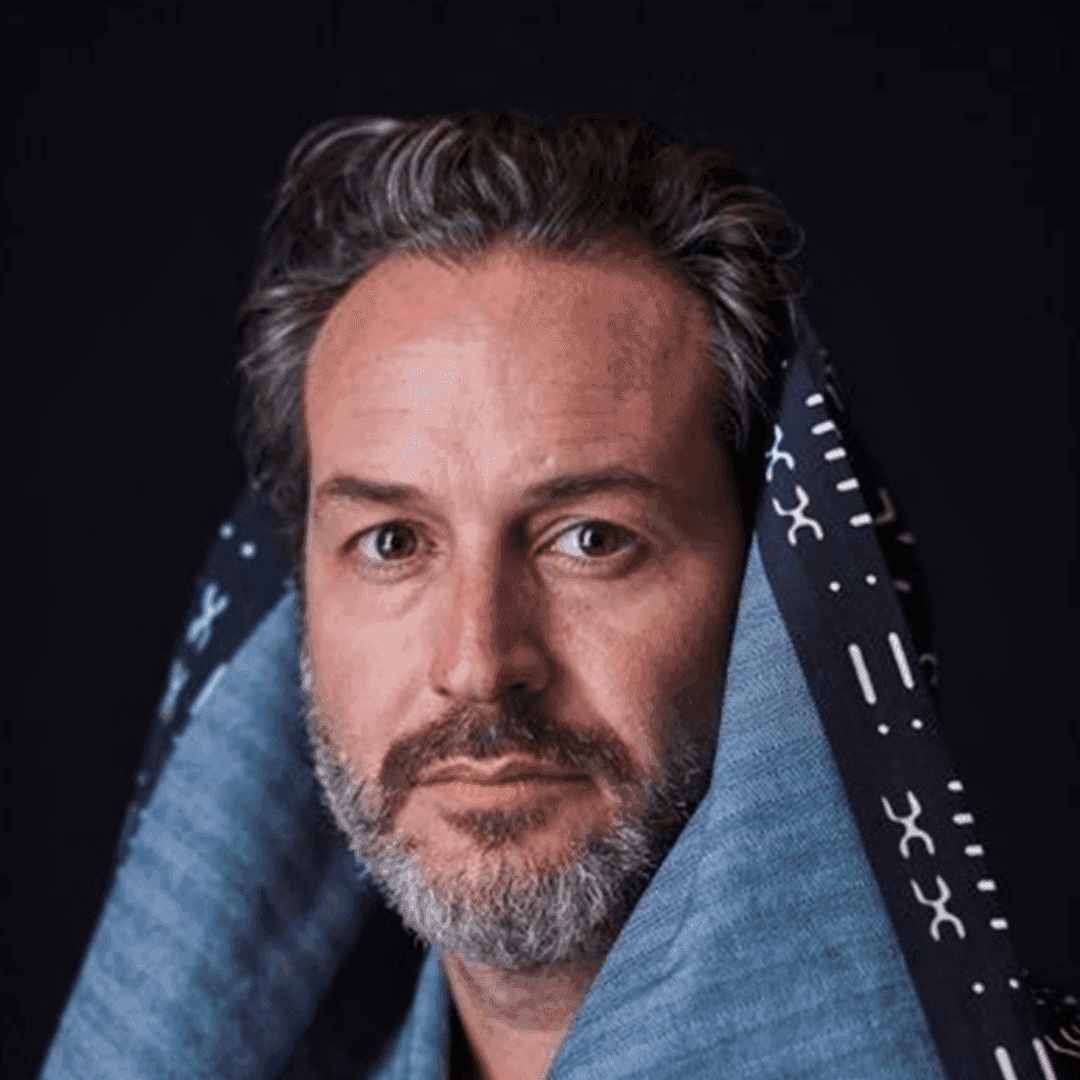
INTRODUCTION
Wyatt Gallery, born in 1975 Austin, Texas, received a Bachelor of Fine Arts degree from the Tisch School of The Arts at New York University in 1997. Soon after, he received a coveted Fulbright Fellowship to Trinidad & Tobago where he photographed religious places until 2001. His work has been reviewed in The New Yorker magazine and featured in Esquire, Departures, Condé Nast Traveler, The New York Times, Mother Jones, and on Oprah’s OWN Network, amongst others. Gallery was an adjunct professor of photography at the University of Pennsylvania and is the recipient of various awards from the International Center of Photography’s 2017 Infinity Award in New Media, Photo District News magazine 30 under 30 and Rising Stars, among others. He has published four books in the last decade.
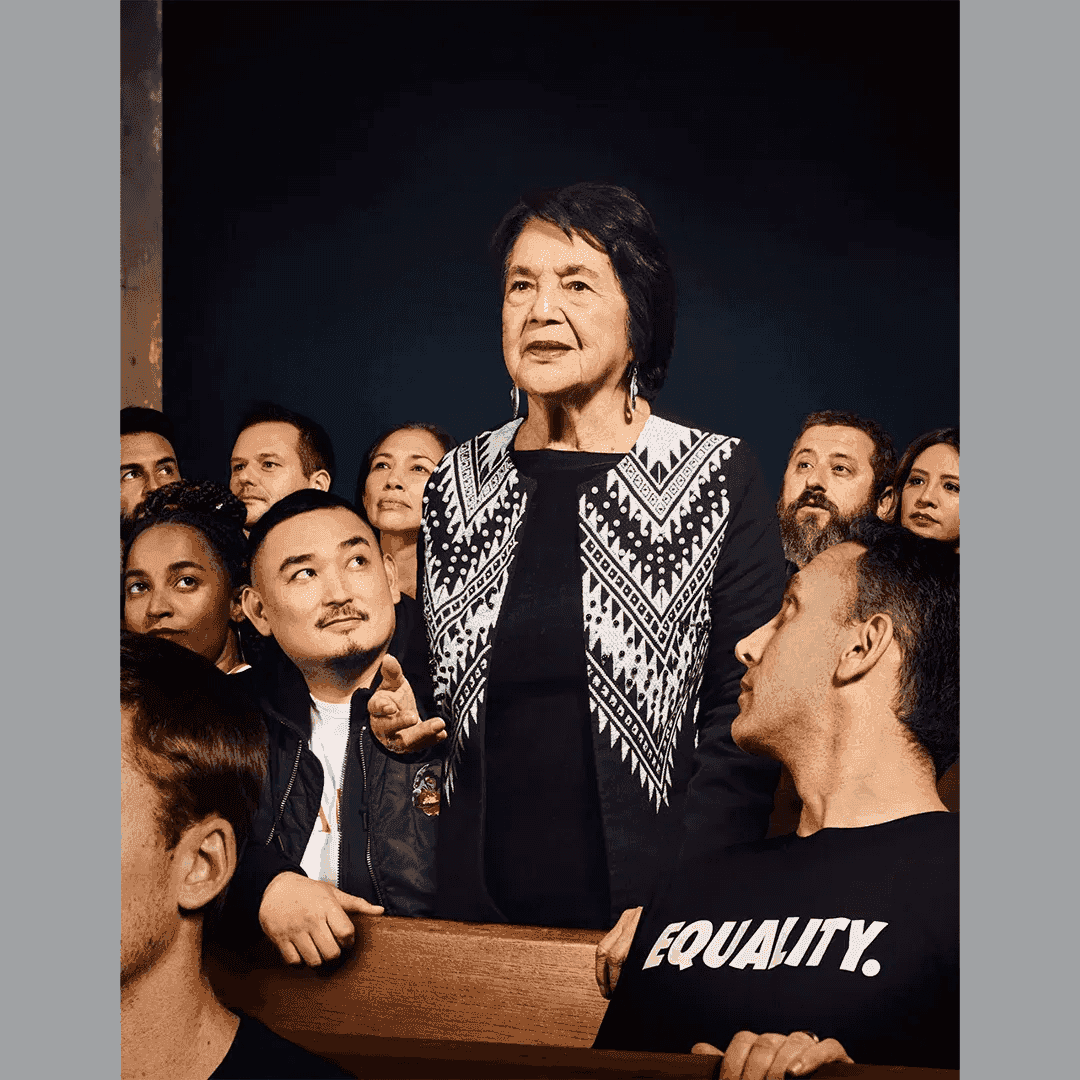
ABOUT THE ARTWORK
"Four Freedoms" (Freedom of Speech, Freedom of Worship, Freedom from Want, Freedom from Fear), Medium: Digital Photograph, Dimensions: Variable, Year: 2018
In his 1941 State of the Union Address, President Franklin D. Roosevelt proposed “four essential human freedoms” that he believed people all over the world deserved to enjoy: Freedom of Speech, Freedom of Worship, Freedom from Want, and Freedom from Fear. His speech, which would later be developed into the Universal Declaration of Human Rights, influenced a leading American illustrator, Norman Rockwell (1894–1978), to create a series of oil paintings that represented the Four Freedoms using everyday people as models. These four concepts, as articulated by FDR and envisioned by Rockwell, inspired generations of artists and became the namesake of Four Freedoms. On the seventy-fifth anniversary of Rockwell’s painting career, Four Freedoms collaborated with artists Hank Willis Thomas, Emily Shur, Eric Gottesman, and Wyatt Gallery to create a photographic series that would transform what such liberties might look like today. Throughout the two photo shoots held in Los Angeles in January and May 2018, more than 150 volunteers were photographed, including public figures, activists, celebrities and members of the public. The unexpected turnout is a not only a testament to the continued belief in the “Four Freedoms” proposed by Roosevelt, but also reflects a desire for more inclusive visual representations of Americans. In their final form, the 86 photographic compilations reference Rockwell’s iconic aesthetic in stylized scenes of everyday life and attempt to reflect the immeasurable diversity of American identities today.
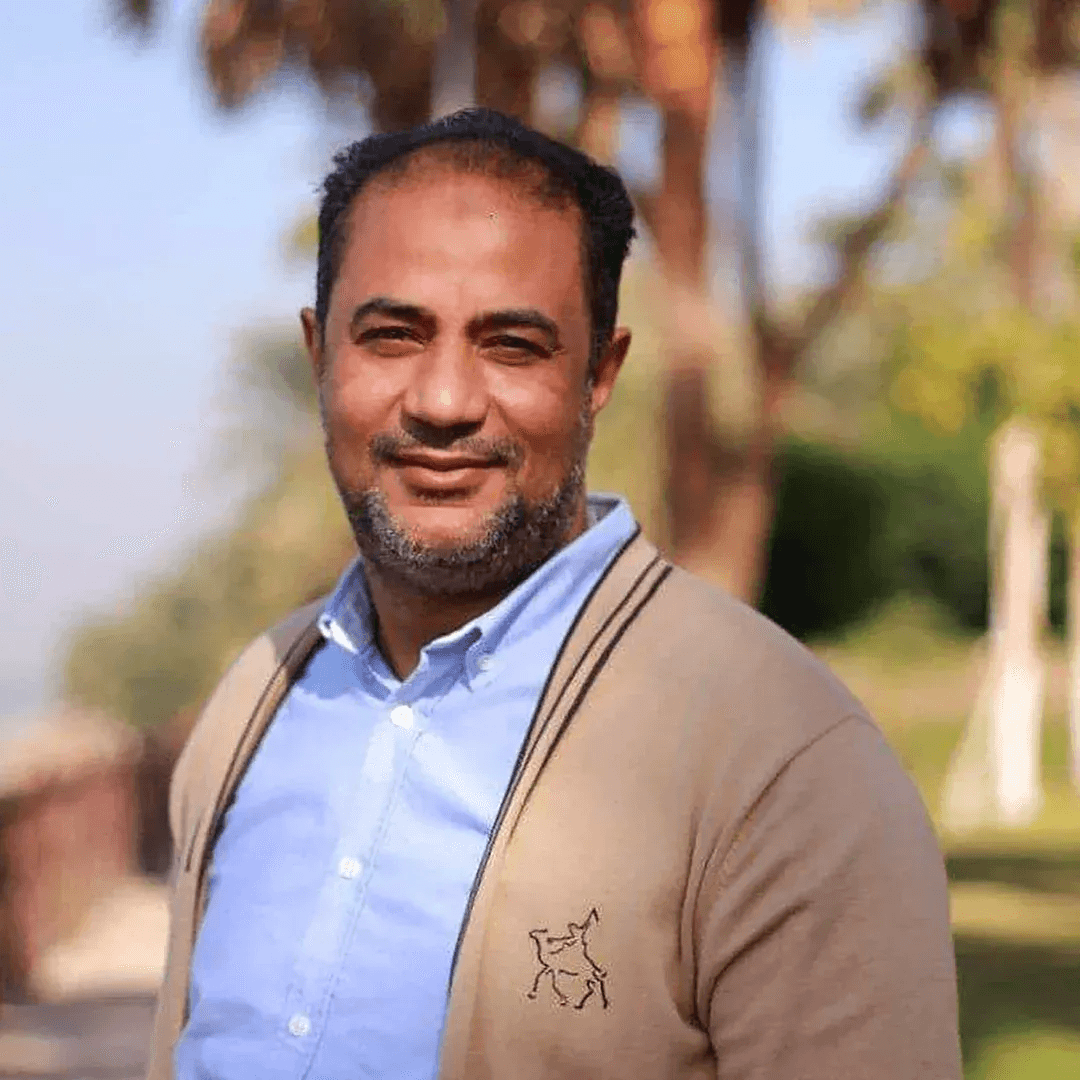
INTRODUCTION
Egypt, born in Qena,1978. Bachelor of Fine Arts, University of Luxor, 2003. Participated in the Egyptian Formation Movement since 1998. Participated in many collective exhibitions inside and outside Egypt. 10 personal exhibitions were held inside and outside Egypt. Winner of the first prize at the 2013 Youth Salon. He has collections in Egyptian museums. Collections for individuals inside and outside Egypt.
Award-winning painter Alaa Abul Hamd credits the beautiful landscape of Upper Egypt and its ancient Egyptian character as the inspiration for his artwork. His subjects are characterized by their stillness, strength, and silence, which he attributes to his fascination for ancient Egyptian murals and carvings.
Abul Hamd holds a BA in Fine Arts and is pursuing a PhD on the impact of the Luxor civilization on contemporary Egyptian art while also serving as an assistant professor of painting at the Faculty of Fine Arts at Luxor University. His work has been exhibited extensively locally and internationally. He is the recipient of the 24th Youth Salon Award and has participated in over twenty group exhibitions in Cairo, Port Said, Alexandria, Luxor, and Muscat.
Alaa Abu al-Hamad Abdul-Sattar. The artist was born in Qena Governorate in 1978. He resides permanently in the city of Luxor, in the south of the Arab Republic of Egypt. He works as an assistant professor in the Department of Painting at the Faculty of Fine Arts, Luxor University. I work permanently in my private studio in the city of Luxor, between the ancient Egyptian heritage and the picturesque landscapes of Upper Egypt.
Bachelor of Fine Arts, University of Luxor, 2003. Participated in the Egyptian Formation Movement since 1998. Participated in many collective exhibitions inside and outside Egypt. 10 personal exhibitions were held inside and outside Egypt. Winner of the first prize at the 2013 Youth Salon.
Solo exhibition in Motion Art Gallery, Cairo, one year 2019.2020.2021.2022.2023 Solo exhibition at Samah Art Gallery, Cairo, 2017-2018. He has collections in Egyptian museums. Collections for individuals inside and outside Egypt.
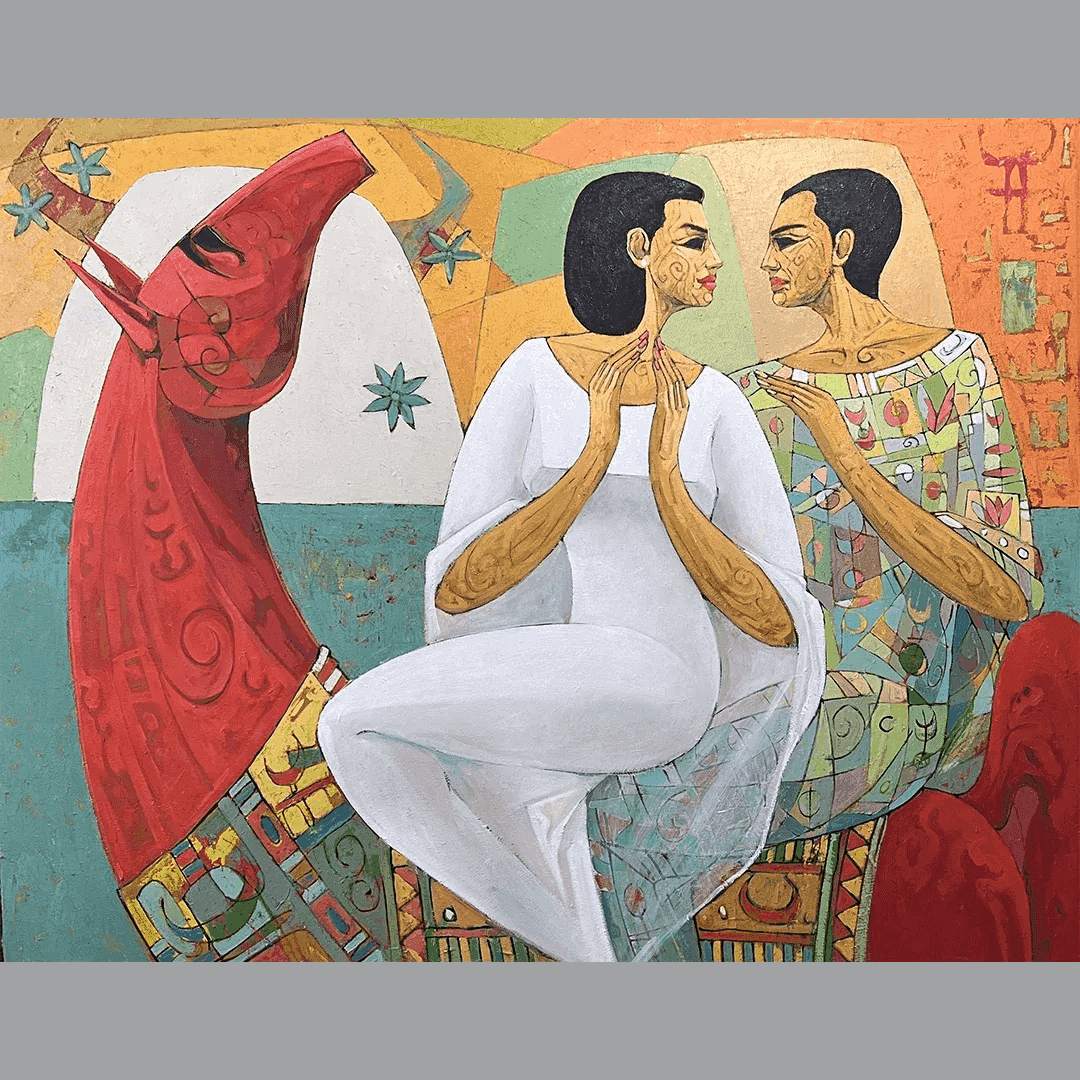
ABOUT THE ARTWORK
The yarrow paradise in Ancient Egyptian, Medium: Oil on canvas, Dimensions: 160 x 200 cm, Year: 2023
The artwork draws inspiration from ancient Egyptian art philosophy and portrays a celestial encounter of lovers in heaven, thoroughly immersed in bliss. Through a contemporary artistic lens, the piece captures the profound sense of longing shared between the two lovers. His work beautifully blends elements of ancient Egyptian art, infusing it with their unique creative expression to create a captivating and emotive composition. The lovers symbolise the unity of the past and present, and humankind from all over the world who identify with and can experience the singularly uplifting sentiment of love. The concept of paradise and heavenly love indicates what people reach out for through generations, regardless of class, colour or creed, signifying oneness of thought.
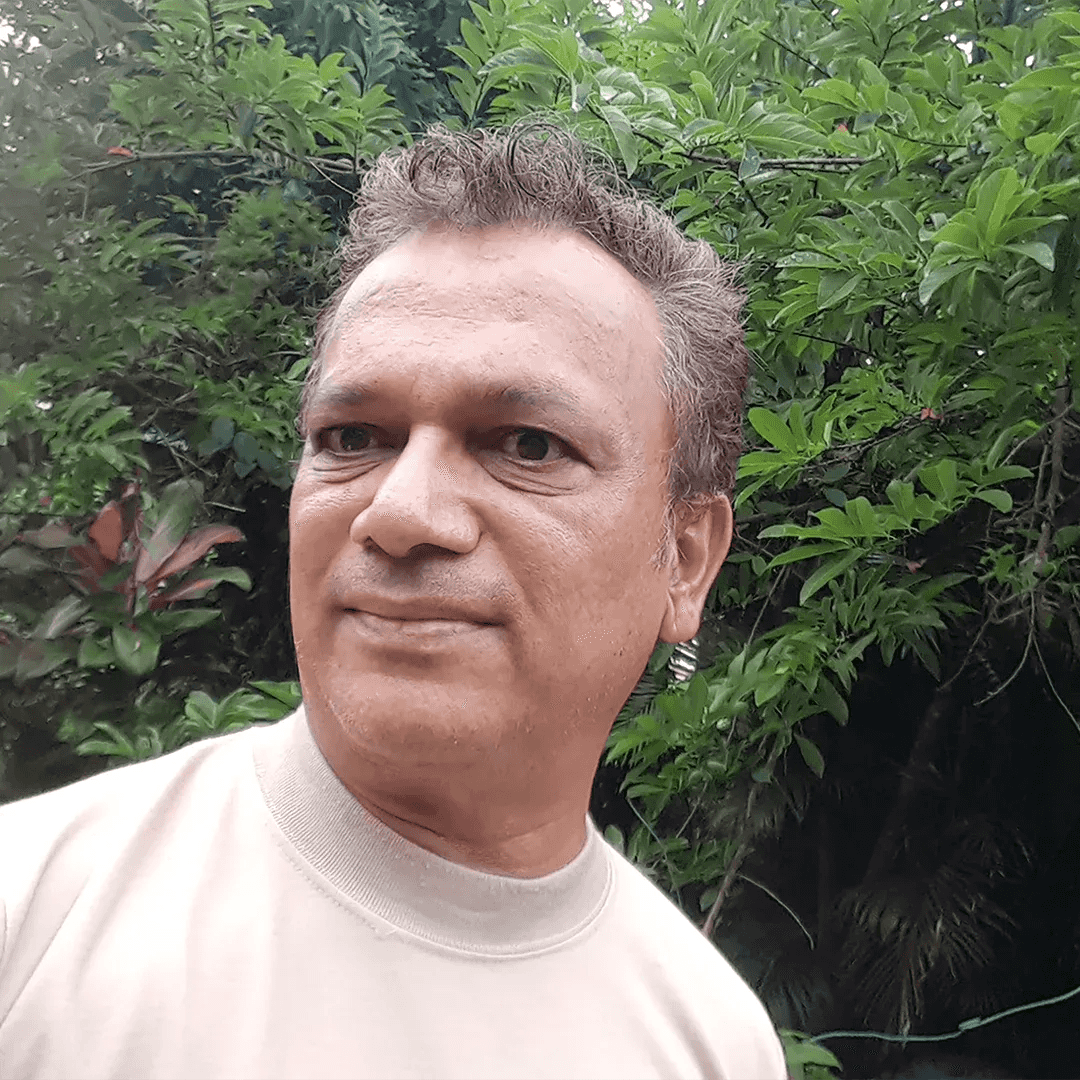
INTRODUCTION
I am a Mauritian artist who has embarked on a creative journey full of diverse paths and passages. My work spans a wide range of themes, including social, political, cultural, ecosystem and environment, religious, community affinity, popular discourse, customs and traditions, issues on presentation, esotericism and human nature, history, ethical and vernacularism issues. Throughout my career, I have participated in numerous exhibitions, art residencies and workshop, both nationally and internationally. I have also made significant contributions to the evolution of the Mauritian art scene by progressing an adaptable way of thinking about the welfare of our local environment. By not implementing a set of rules, I am incorporating scrap materials, scavenging, recycling and reusing them, indirectly salvaging these resources which are collected from roadsides and sugar cane fields. It was a challenging and daring journey of pioneering sustainable art in the island. Currently, I am engaged in research on organic materials that have shaped the history of our island. By reviving materials such a vetiver, bamboo, airy plants, grass, sugarcane plant, bagasse, charcoal, cow dung, aloe plant, ravenala, gunny and dried fish, I aim to preserve their cultural significance through my artistic expressions. My artworks often embrace the use of the Creole and Bhojpuri languages, making them accessible to a broader audience and reflecting the multicultural fabric of Mauritius. Through my creative endeavours, I strive to leave a lasting impact on the art world, captivating audiences and leaving an indelible mark with my creations.
ARTIST STATEMENT
My fantasy journey consists of a route, with many connected paths and passages, in which it is hard to find my way, as it branches into a meandering, but creative trajectory. While travelling along these earmarked designations, I had the opportunity of addressing topics from numerous themes: social, political and cultural, ecosystem and environment, religious, community affinity, popular discourse, customs and traditions, issues on presentation, esotericism and human nature, history, ethical and vernacularism issues. I contributed significantly to the evolution of the Mauritian art scene, with the introduction of scrap materials, collected from the roadsides and sugar cane fields. I am currently doing research on organic materials, that have marked the history of our part of the world. Travelling through the 1970s provides an opportunity to revive materials that are fast disappearing: vetiver, bamboo, grass, airy plants, sugarcane and its leaves, bagasse, charcoal, cow dung, aloe-stems and leaves, ravenala, gunny and dried fish, which are parts of my visual vocabulary. Through the choice of the medium and the prevalence of the Creole and Bhojpuri languages in the presentation of my works, I try to make my world accessible to a larger public.
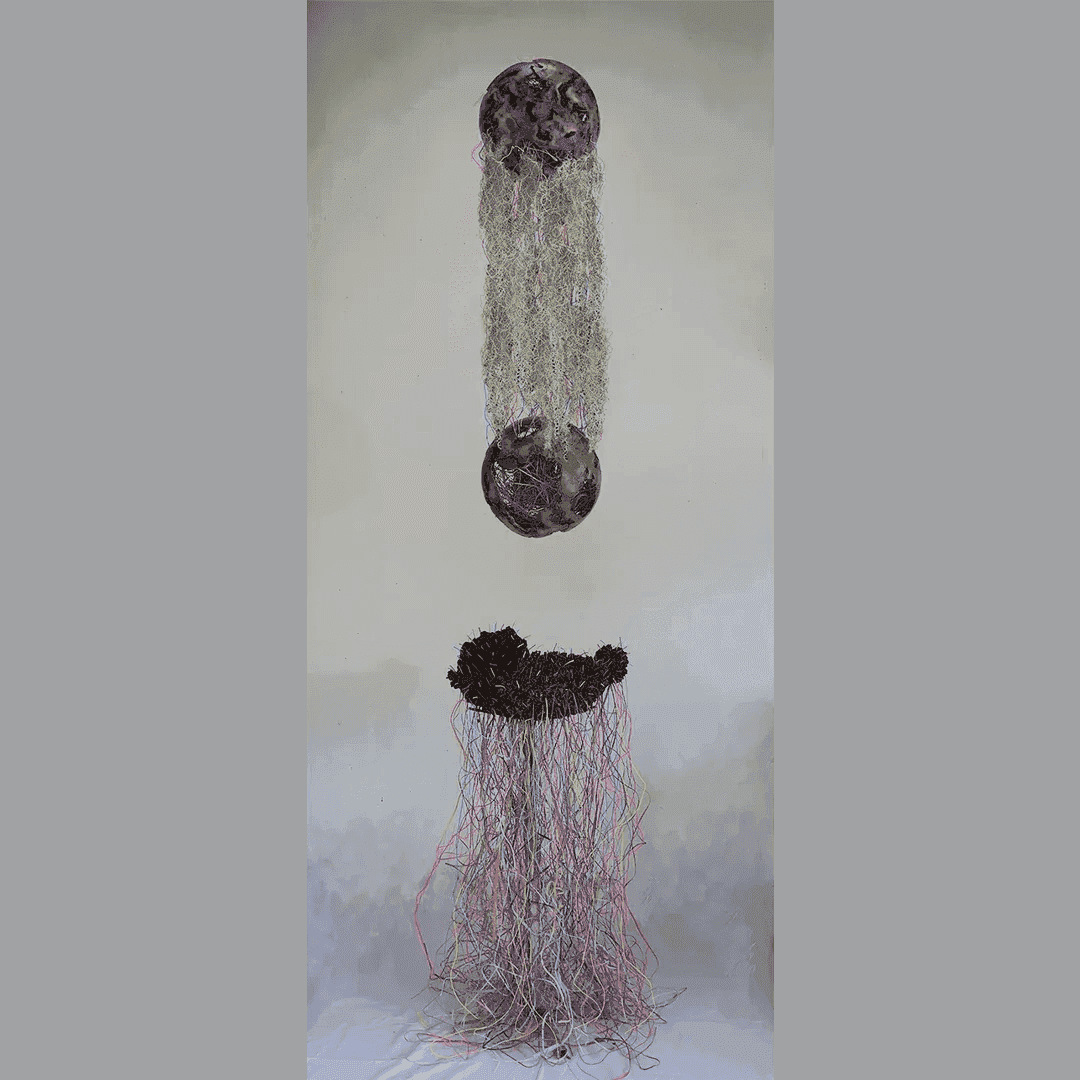
ABOUT THE ARTWORK
Basic Laws of Life Energy, Medium: Concrete, collected coloured plastic strip, airy plant, Dimensions: 240 x 50 x 50 cm, Year: 2023
Globalization is ineluctable. The world is connected economically, environmentally and technologically. However, in the quest for economic dominance, some laws of Nature have been neglected. The interdependence of worldly laws has, here, taken the form of visual investigation through the Spanish moss (the vegetal sphere), the coloured plastic strips (the human activity sphere), the termitaries (the animal sphere), the positive and negative space (in between the elements) and the concrete globe (the earth), which communicate with each other. This sculpture installation has a vertical progression, that interlaces natural elements and objects of the man-made world, but, what attracts our eyes is the negative space in between. Addressing the invisible, the laws of life energy, our relationships with the physical world should be our priority. If technological advances have brought the opposite ends of the world together, it has also alienated us from our environment, which raises the debate of the Same and the Others.
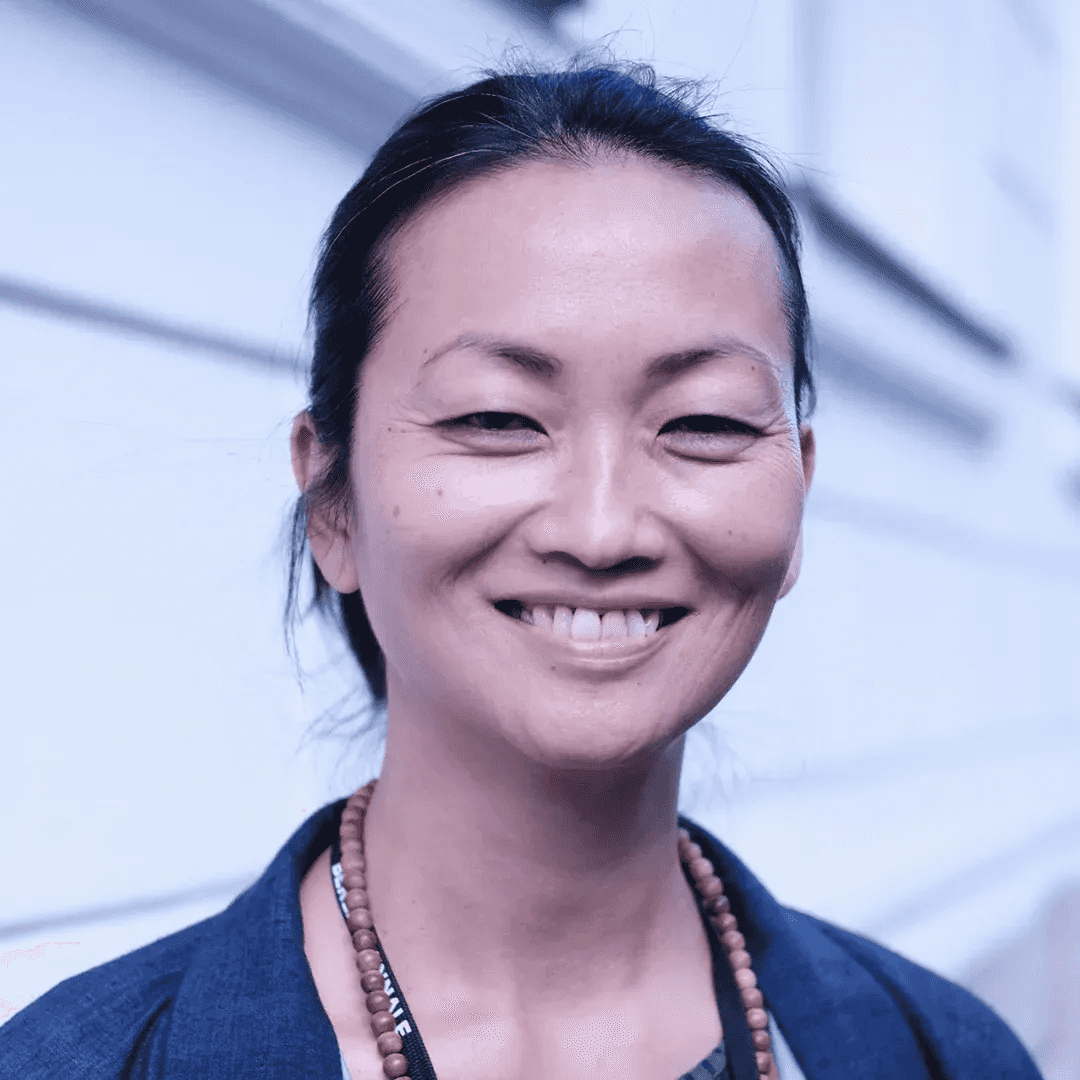
INTRODUCTION
Sara Sejin Chang (Sara van der Heide, 1977) (NL) is a Korean-Dutch artist currently living and working in Berlin. In 1995 she entered the Amsterdam University of the Arts, whereafter she continued her study at AKI Academy of Art & Design (ArtEZ) in Enschede. Chang has won several prizes of which the last was the important Dutch Theodora Niemeijer prize in 2023. Sara Sejin Chang (Sara van der Heide) is currently a fellow of the Berlin Artistic Research Grant Programme (2022-2023). Recent or current solo exhibitions at Moderna Museet, Stockholm (2022-2023); Centraal Museum, Utrecht (2023); Rozenstraat | a rose is a rose is a rose, Amsterdam (2023); ARGOS, Brussels, (2021); CASCO | Hartwig Art Foundation, Utrecht (2021). Two-person exhibition with Youngjoon Kwak at ARKO, Seoul (2022). She has participated in the following biennials: Busan Biennale, Busan (2022), 11th Berlin Biennale, Berlin (2020); Dhaka Art Summit, Dhaka (2020), Contour Biennale 9, Mechelen (2019); 6th Kuandu Biennale, Taipei (2018); Sharjah Biennial 13, Beirut (2017); the 1st Asia Biennial/the 5th Guangzhou Triennial, Guangzhou (2016); The School of Kyiv: Leipzig Class. Seminar: Politics of Form, Part of the Kyiv Biennial (2015); the 19th Biennale of Sydney (2014). Her works has been part of numerous group exhibitions amongst others at Kunstenfestivaldesarts, Brussels, Spielart, Munich; MHKA, Antwerp; Mu.ZEE, Oostend; Stedelijk Museum Amsterdam, Amsterdam; Van Abbemuseum, Eindhoven;; KIOSK, Gent; If I Can’t Dance, I Don’t Want To Be Part Of Your Revolution, various locations; De Pont, Tilburg; Fondazione Giuliani, Rome; De Appel, Amsterdam; Marres, Maastricht; Walker Art Center, Minneapolis; Temporary Gallery, Cologne; De Vleeshal, Middelburg; 44th and 45th International Film Festival Rotterdam; Espai d’art Contemporani de Castelló, Spain; CAAC, Seville
Her work is a.o. part of the following collections: Moderna Museet, Stockholm; Van Abbemuseum, Eindhoven; Stedelijk Museum Amsterdam; Centraal Museum Utrecht; De Domijnen, Sittard; De Vleeshal/M HKA, Middelburg and Antwerp; Walker Art Center, Minneapolis; Mu.ZEE, Oostend.
CONCEPT NOTE
Since the late 1990s, Sara Sejin Chang has created a rich body of work that traverses an array of formats and mediums, including film, text, immersive film- and sound installations, performances, and painting. Chang combines spiritual evocations, historical research and the unraveling of colonial narratives creating works that act as historical repair, healing and belonging. Chang questions Eurocentric systems of categorization, racialization and its penetration in all levels of life and contemporary Western society. Her work can be seen as poetic and intimate gestures that centralise a meta-cosmic and inclusive approach to modernity, transforming the meaning of value and time, transcending the biographical and personal. Chang combines spiritual evocations, historical research and the unraveling of colonial narratives in works that act as historical repair, healing and belonging. Through her artistic practice, Chang has questioned Eurocentric systems of categorisation and racialisation, as well as their penetration into all levels of life and contemporary Western society. In her work she raises questions about these systems of inequality as she intervenes to deconstruct and reconstruct them.
The A-Symmetrical Imperialistic Data Server addresses the problems Chang sees with the growth of the digital culture and the negative imperialistic impact it has on some. The ‘asymmetry’ in the title and in the work points towards serious concerns regarding the unequal distribution of energy and resources across the globe, and consequently the large (negative) impact on certain geographic areas, often far removed from the location of the internet user.
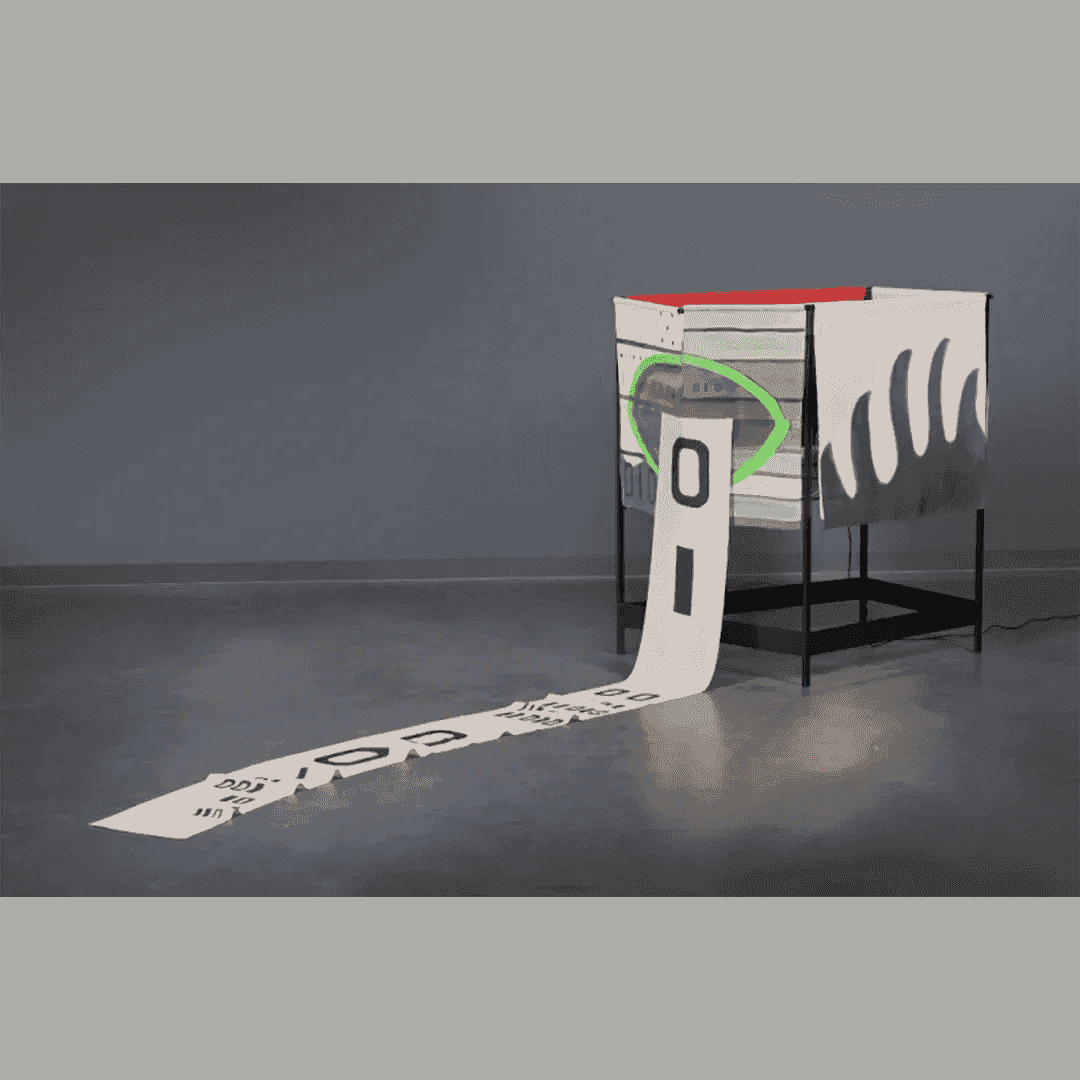
ABOUT THE ARTWORK
The A-Symmetrical Imperialistic Data Server, Medium: Black metal frame with hand painted silk paintings, light, Dimensions: 150 x ± 500 x 113.2 cm, Year: 2018 / 2021
The A-Symmetrical Imperialistic Data Server is an installation consisting of several pieces of hand-painted silk mounted on a metal structure representing a data server. The transparency and brightness of the colors of the painted silk fabric bring to mind the shining computer screens. The ancient craft technique of silk painting, often considered feminine and labour-intensive, contrasts sharply with the distribution speed of digital data by internet servers. A piece of pink fabric painted with 'zeros' and 'ones', referring to the binary numeric protrudes from a green opening like a tongue consuming endless amount of data. The server is painted with black waves in reference to the large amounts of water needed to cool data centers.
Although the installation initially appears playful and fragile, the 'a-symmetry' in the title and in the work itself points to the extraction of energy and resources from impoverished areas by imperialism, and the heavy (negative) impact on certain geographical areas, often far away from the location of the internet user. The work critically addresses the increasing impact of the digital world on nature and the inequality in its burdens. It can act as an embodiment of the prevailing debate about pursuing (digital) progress on the one hand, and also looks critical to it on the other hand, because progress in one area (digital world) can also mean regression in another (nature).
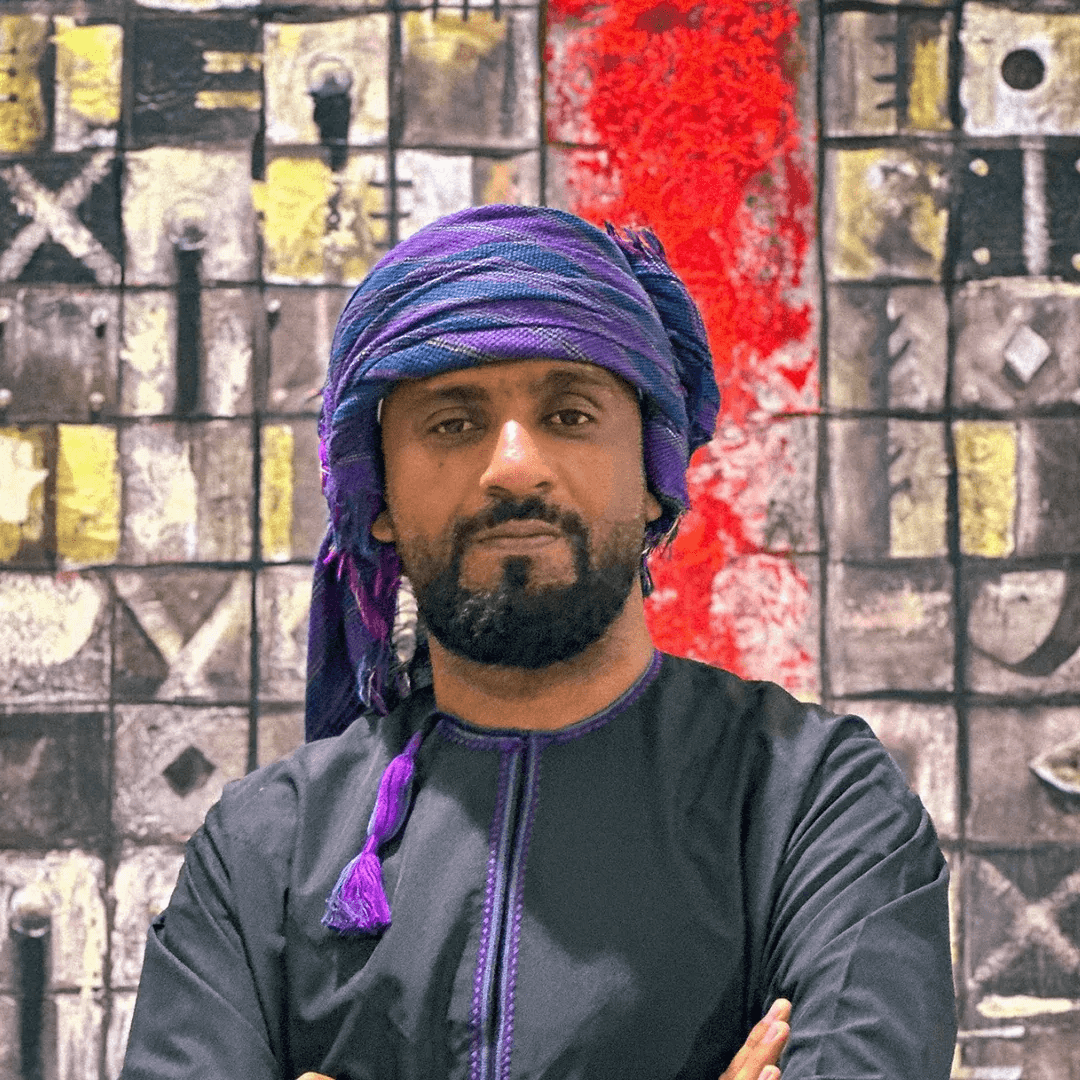
INTRODUCTION
Abdulmajeed ‘Karooh’ is an Omani artist well known for his work in Fine Arts & Culture, He is a member in Omani Society for Fin Arts since 1993 and Emirates Fine Arts Society since 2006. He is also an established member of Ambassadors of Omani Art teem that encouraging in taking new forms of art groups in Oman since 2018. He has participated in many local and international art exhibitions in Oman, Geneva, Vienna, Italy, Frankfort, France Egypt, Dubai, Kuwait, Bahrain, New Delhi, and Thailand. He has won many awards, the distinctive awards was 3rd prize for his unique creative vision in Italy Opra Painter 2012 and 1st prize in Omani society for fine art annual exhibition 2010, Abdulmajeed takes his inspiration from his childhood, also from the unique heritage and folklore of the Sultanate of Oman. His successful contemporary ‘Omani Door’ series are set in bright yet natural colors, reminiscences of his family ancestral home. ‘Oman Architectural’ series were inspired by his father, one of Muscat’s main constructors, who taught him all his know how. Karooh also focuses on the beauty of the Muscat’s costal line and produces amazingly bright contemporary landscapes which depict his joyful memories.
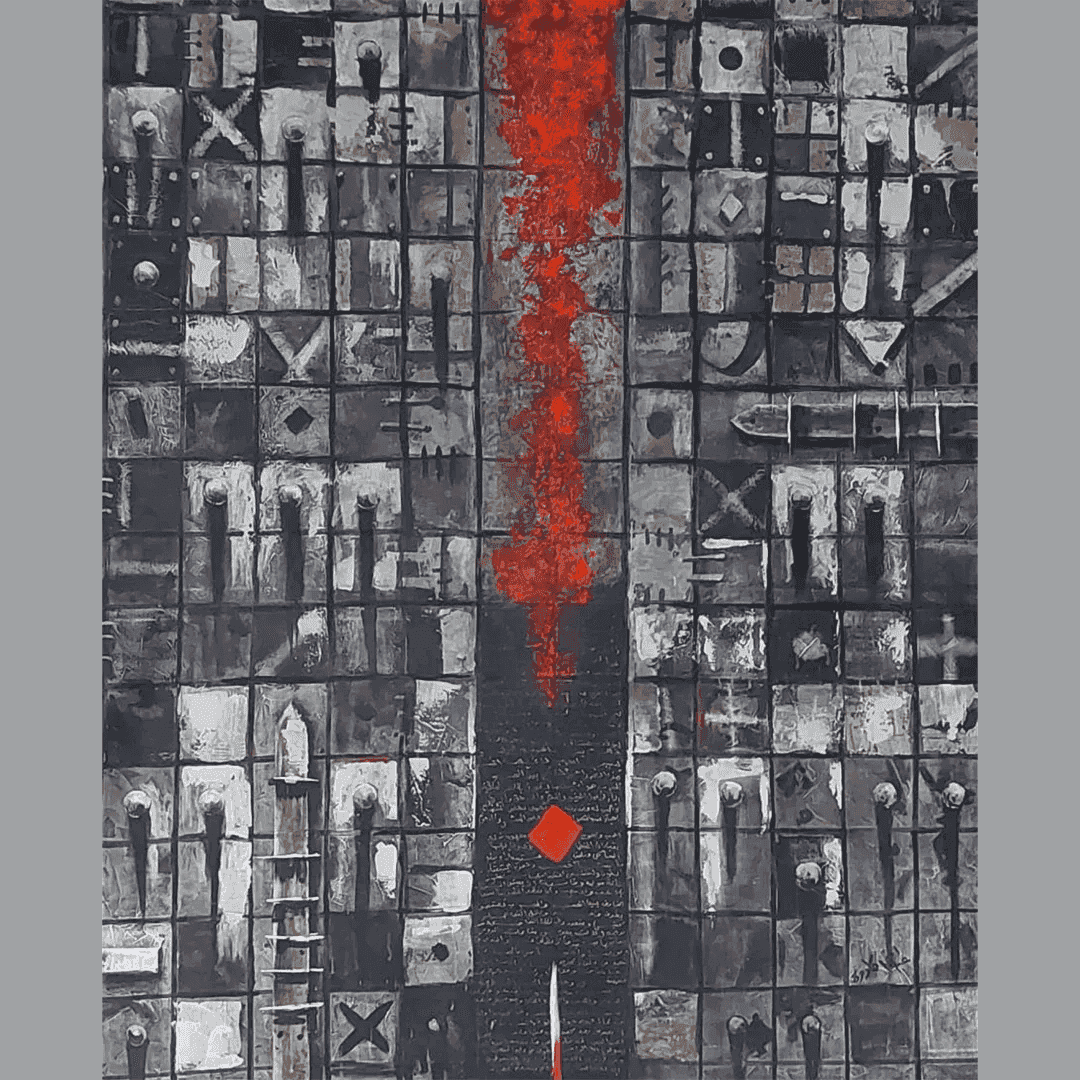
ABOUT THE ARTWORK
The Gate, Medium: Mixed- media on canvas, Dimensions: 150 x 120 cm, Year 2020
This gate/entrance in old Muscat In ancient times, there were two entrances when entering Muscat. called the small door in Muscat on the side of the old Muscat market, while the other is called the big door that leads to the Fardah, the Al-Khor Mosque and the Mirani Castle, while on the side of Hillat Al-Madabbagha, there is a third door called Al-Mutha'ib, which is the entrance to Hillat Al-Awar, all of which are connected to the Muscat wall.
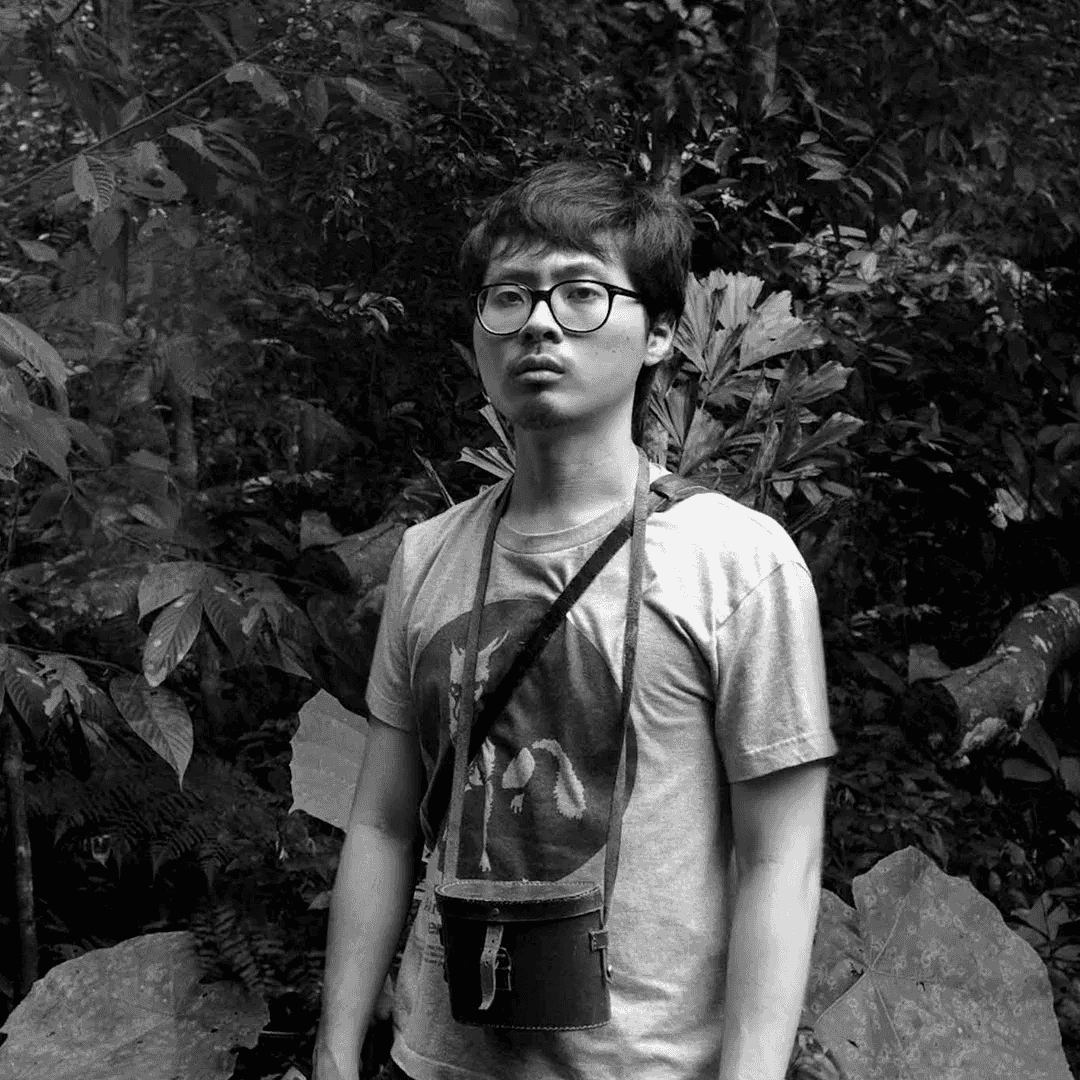
INTRODUCTION
Robert Zhao Renhui (b. 1983, Singapore) is a multi-disciplinary artist and the founder of the Institute of Critical Zoologists. His artistic practice addresses the human relationship with nature. Zhao received his Bachelor’s and Master’s degree in Photography from Camberwell College of Arts and London College of Communication respectively. His work has been exhibited in international group shows such as Busan Biennale 2020; Singapore Biennale 2019; Asia Pacific Triennial, Queensland, Australia, 2018; Jiwa: Jakarta Biennale, Indonesia, 2017; 7th Moscow Biennale, Russia, 2017; 20th Sydney Biennale, Australia 2016; Les Recontres d’Arles, France, 2015. Amongst his more recent solo exhibitions in Singapore are The Nature Museum, commissioned by Singapore International Festival of Art (SIFA) and The Bizarre Honour, realized for OH! Open House, both in 2017. Zhao has undertaken residencies at the Musée du Quai Branly, Paris, France, and Kadist Art Foundation, San Francisco, United States, and the Fukuoka Art Museum, Japan. He was awarded the Young Artist Award by the National Arts Council in 2010 and was a finalist of the Hugo Boss Asia Art Award 2017 and the 12th Benesse Art Prize in 2019.
Robert Zhao Renhui (b. 1983, Singapore) is a multi-disciplinary artist and the founder of the Institute of Critical Zoologists. His artistic practice addresses humanity’s relationship with nature, and is characterised by a longstanding interest in investigating sites defined by the conflation of wilderness and urbanisation. Arising from a research-oriented process, his artistic output spans and blurs the boundaries between the mediums of photography, video, mixed-media installations, and publications. In doing so, he realises stories and narratives that re-focus attention on the planet’s ecological imbalance in palpable ways.
SELECTED AWARDS
2021 Canon New Cosmos of Photography : Excellence Award : Japan 2021 Julius Baer Next Generation Art Prize : 2nd Prize : Stills : Singapore 2020 Silvana Foundation Award : Singapore International Photography Festival 2019 Singapore Bicentennial Public Art Trust Commission : The Time Tree (Trying to remember a Tree) 2017 Finalist, Hugo Boss Asia Art Awards, Shanghai **2017 ** Finalist, Prix Elysee, Switzerland 2016 Musée du quai Branly Photography Residencies Laureate : Paris 2015 President's Design Award Singapore : Design of the Year : Flora and Fauna of the World 2010 Young Artist Award : Singapore 2009 International Graduate Scholarship : University of the Arts London 2009 United Overseas Bank Prize : Painting of the Year Award : Singapore
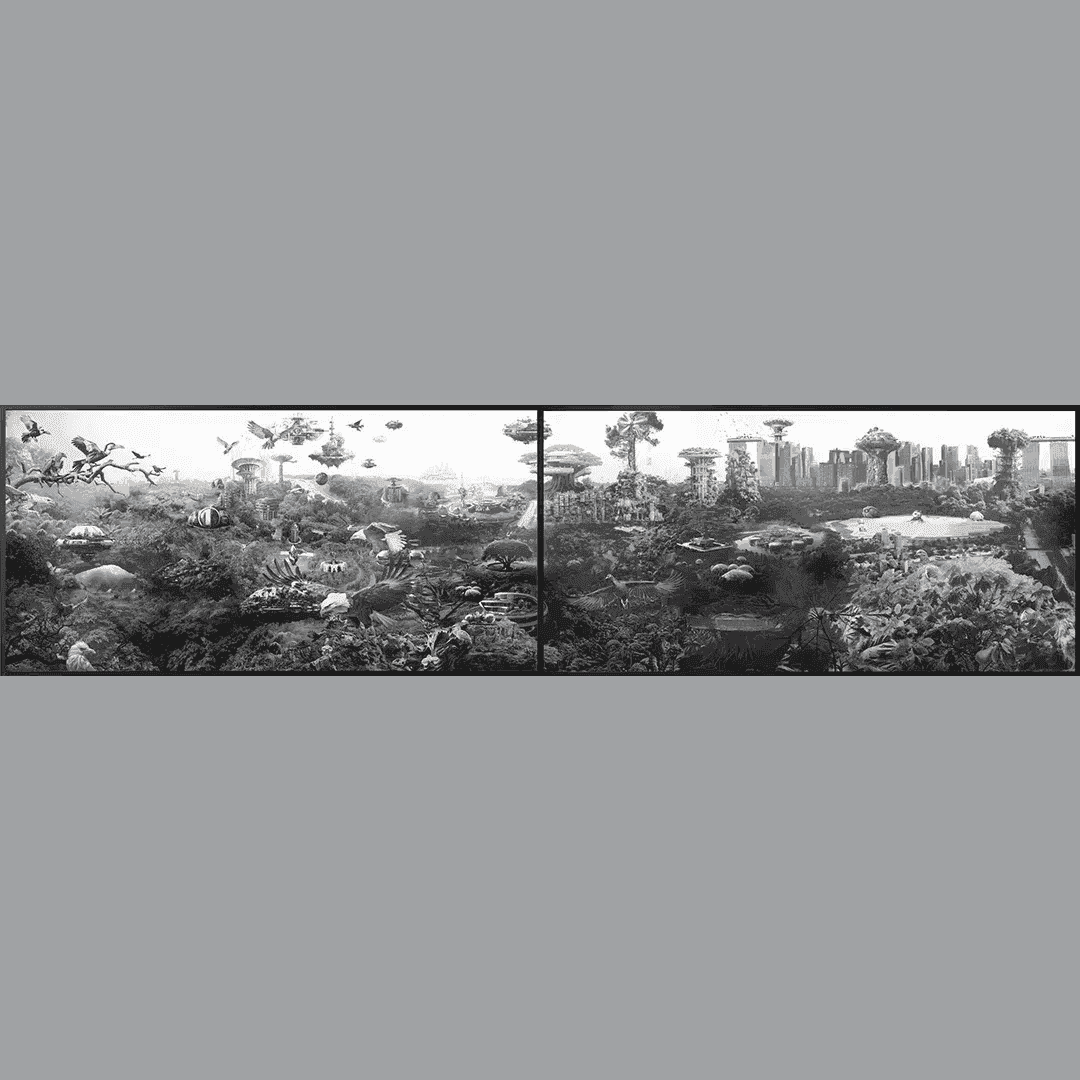
ABOUT THE ARTWORK
A City Landscape, Medium: Archival digital photographic print, Dimensions: 58 x 240 cm, Year: 2023
The artwork that depicts an imaginary landscape of Singapore. This landscape feature flora and fauna of Singapore, as well as futuristic buildings and architecture. The biophilic buildings in the landscapes can be considered to be designed and built with sustainability in mind. Various animals such as birds and mammals that currently live in Singapore, are also included in this landscape.
CONCEPT NOTE
The buildings featured are biophilic and seamlessly integrated in the landscape, giving a hint that the city is a space for both humans and non-human species alike and that a vision of coexistence is possible. The biophilic buildings are designed with sustainability in mind, highlighting the importance of sustainability in the future. The mammals included in the artwork will not be immediately visible to the viewer and will only slowly reveal themselves as the viewer looks into the landscape longer, highlighting the interconnected relationship that humans have with nature.
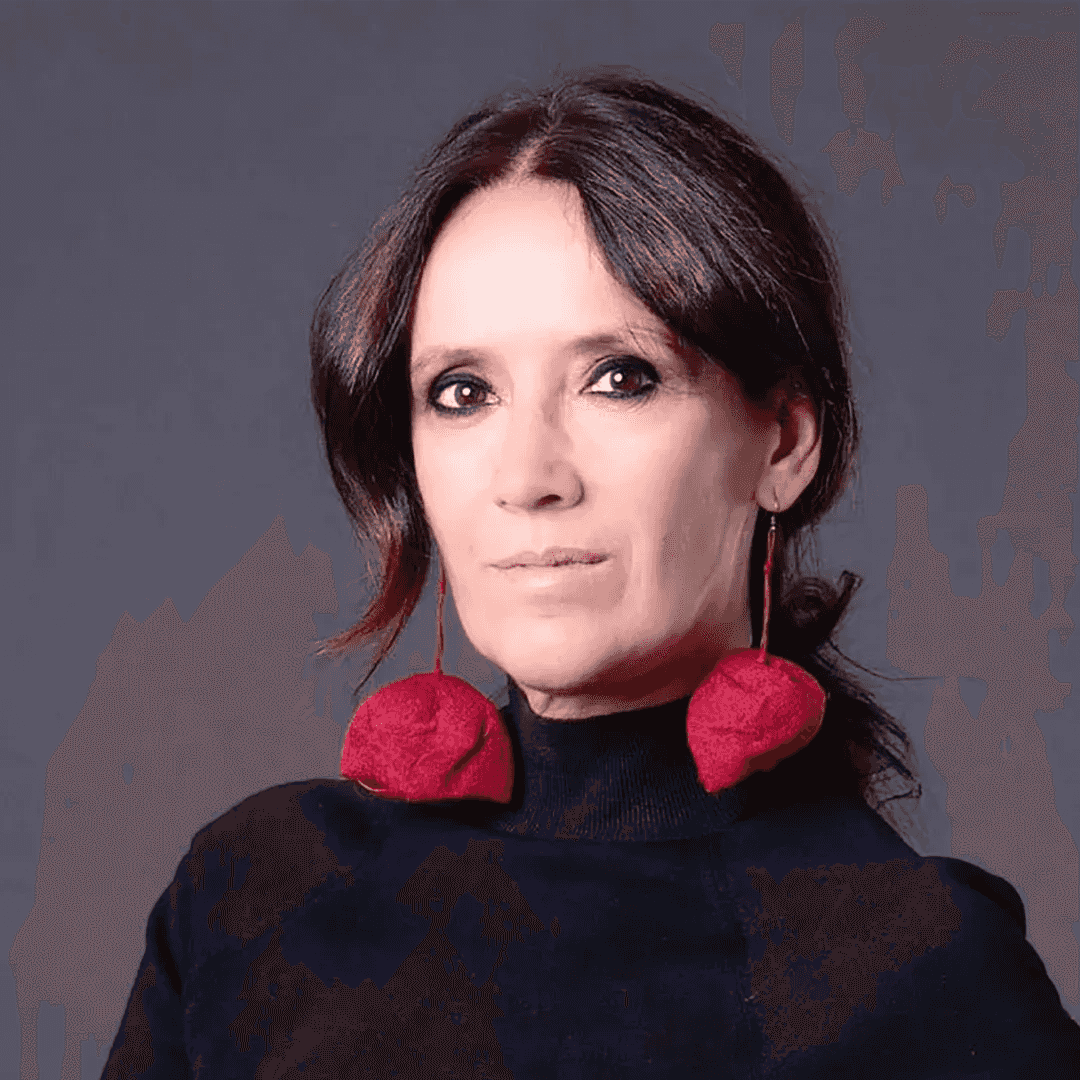
INTRODUCTION
Visual Artist. Beatriz Ruibal has received various awards for her artistic production, such as the Grant for the Promotion of Art and the Grant for Artistic Research, Creation and Production in the field of Visual Arts (2022 and 2020) from the Ministry of Culture; she was a finalist for the art intervention in the Council of Europe buildings (2023); and she was awarded the Grant for Audiovisual Creation in the Community of Madrid (2019) and the Artist-in-Residence Grant from the Spanish Royal Academy in Rome (2016-2017), among others. She has published MADRE (Varasek Ediciones), which was a finalist for the Best Photography Book of the Year (PHotoEspaña 2015); The Photobook Exhibition, Athens Photo Festival (2015); The Library Project, PhotoIreland (2015). Her work can currently be seen at the 6th edition of Hors Pistes at the Centre Pompidou (Málaga, Spain) and in the exhibition “Roma, Siempre Roma: Infinitas Formas. Women of the Spanish Academy in Visual Arts”, in Naves de Gamazo (Santander, Spain). She will also participate as a guest artist in the XIII #EAN13 Cidade da Cultura (Santiago de Compostela, Spain). Her most recent exhibition, “Caída Libre” (Free Fall) could be seen in the Pantheon of Illustrious Men (Patrimonio Nacional), PHotoEspaña 2022, and at RAER 2022, “Tomar la Casa” (Rome, Italy). Her art has also been shown in Spanish art galleries and exhibits such as the Matadero, PhotoEspaña (Royal Botanical Gardens), Casa Encendida, Canal de Isabel II, CBA (Madrid); MAC (A Coruña); and internationally at CCEMiami (Miami); CCMEX (Mexico City); National Museum of Fine Arts, Casa de las Américas, Estudio 50 (Havana, Cuba); Ars Aevi Museum of Contemporary Art (Sarajevo), among others, and at numerous international festivals.
Her work forms part of various public and private collections.
www.beatrizruibal.comwww.naveoporto.com/beatriz-ruibal
CONCEPT NOTE
As a multidisciplinary artist I develop my work through video, photography, and installation, focusing on the genre of portraiture in its broadest sense. It encapsulates a relentless will to preserve and revive individual and collective memory, while exploring links between climate change and the conservation of endangered species. With my images and stories, I confront the absence of forgotten narratives or threatened species, attempting to fill these voids.
My immersive, sensorial works aim to generate a deep resonance within the viewer, inviting them to reflect, to awaken. Interweaving objects, memory, and endangered species, I create a complex web of interconnections.
Not only do I revisit the past, I also immerse myself in the symbolic present I represent, be it characters, objects or nature itself, reaffirming contemporary values as fundamental pillars for the future. My methodology is flexible and adaptive, ranging from historical research to the selection of characters, objects, or natural elements. In my portrayal, I create symbolic images that seek to represent a new nature or meaning.
FOUND NOWHERE ON THE MAP is a synthesis of images constructing a 'contemplative nature', implying critical thinking and political behaviour towards our environment. This 'nature' is a result of my research in the gardens of the Royal Academy of Spain in Rome and Rome’s botanical garden.
From the list of plant species in danger of extinction, I devise a 'perfect storm' where these trees inevitably disappear, from Rome’s pines and century-old Magnolia to beyond the city’s botanical garden, into the streets and across the planet. This work offers some moments of ecological awareness about loss, the lack of dialogue between humanity and nature, and between ourselves.
Understood from an ethnobotanical perspective, nature reflects identity, origin, cultural tradition, and our recognition of diversity. The space for interaction between human and non-human alerts viewers to concepts of resistance and conservation, capacities also inherent in humanity.
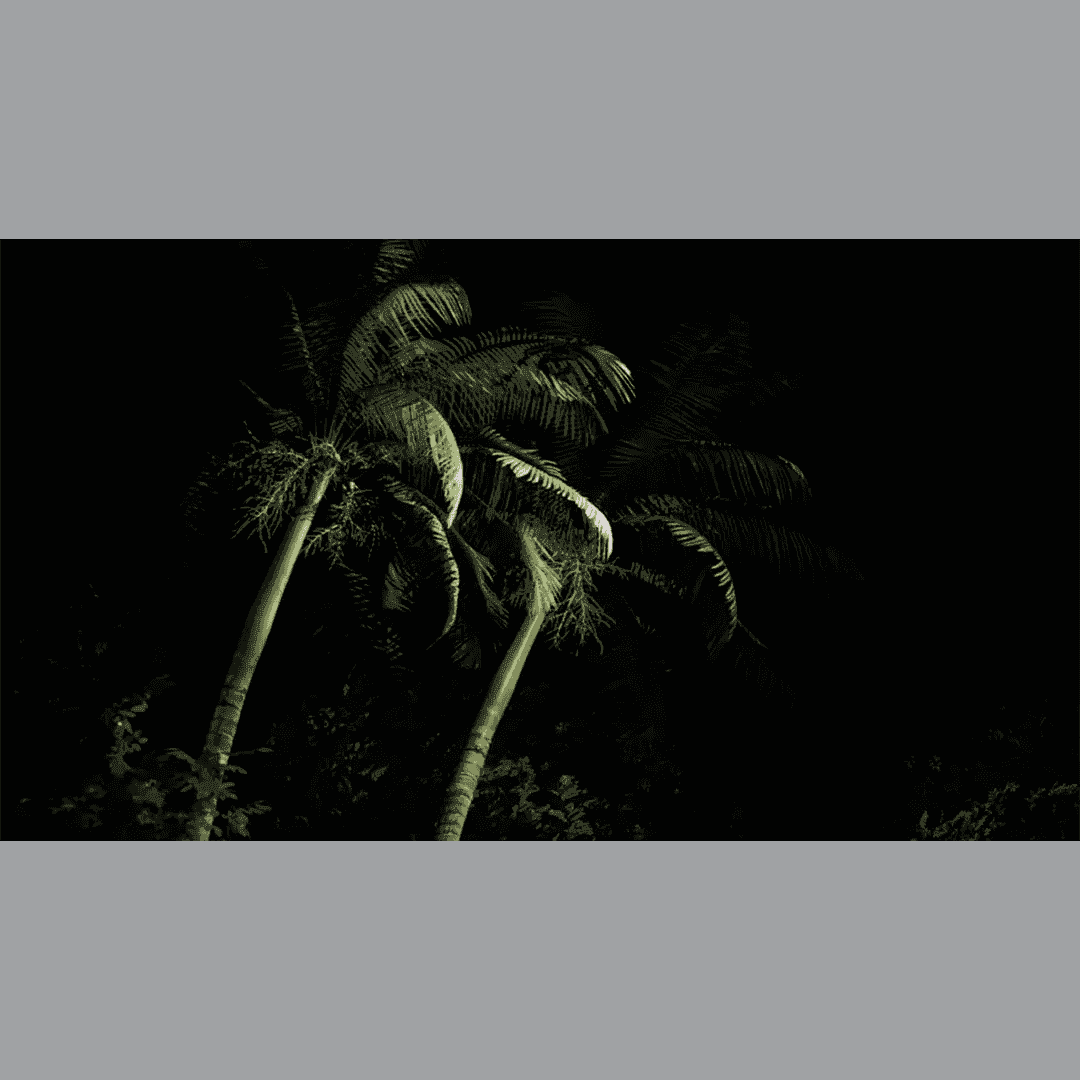
ABOUT THE ARTWORK
Found Nowhere on the Map, Medium: Video, Duration: 25 min 28 sec, Year: 2021
The proposed projection covers the wall from floor to ceiling and encompasses the architectural structure of the room (black box) to allow for an immersive experience and maximize the available space, integrating the artwork "FOUND NOWHERE ON THE MAP" with the environment and creating a significant visual and aesthetic impact. This contributes to a more effective and powerful presentation of the artwork, enabling the viewer to connect more deeply with the piece and appreciate its message and beauty in its entirety.
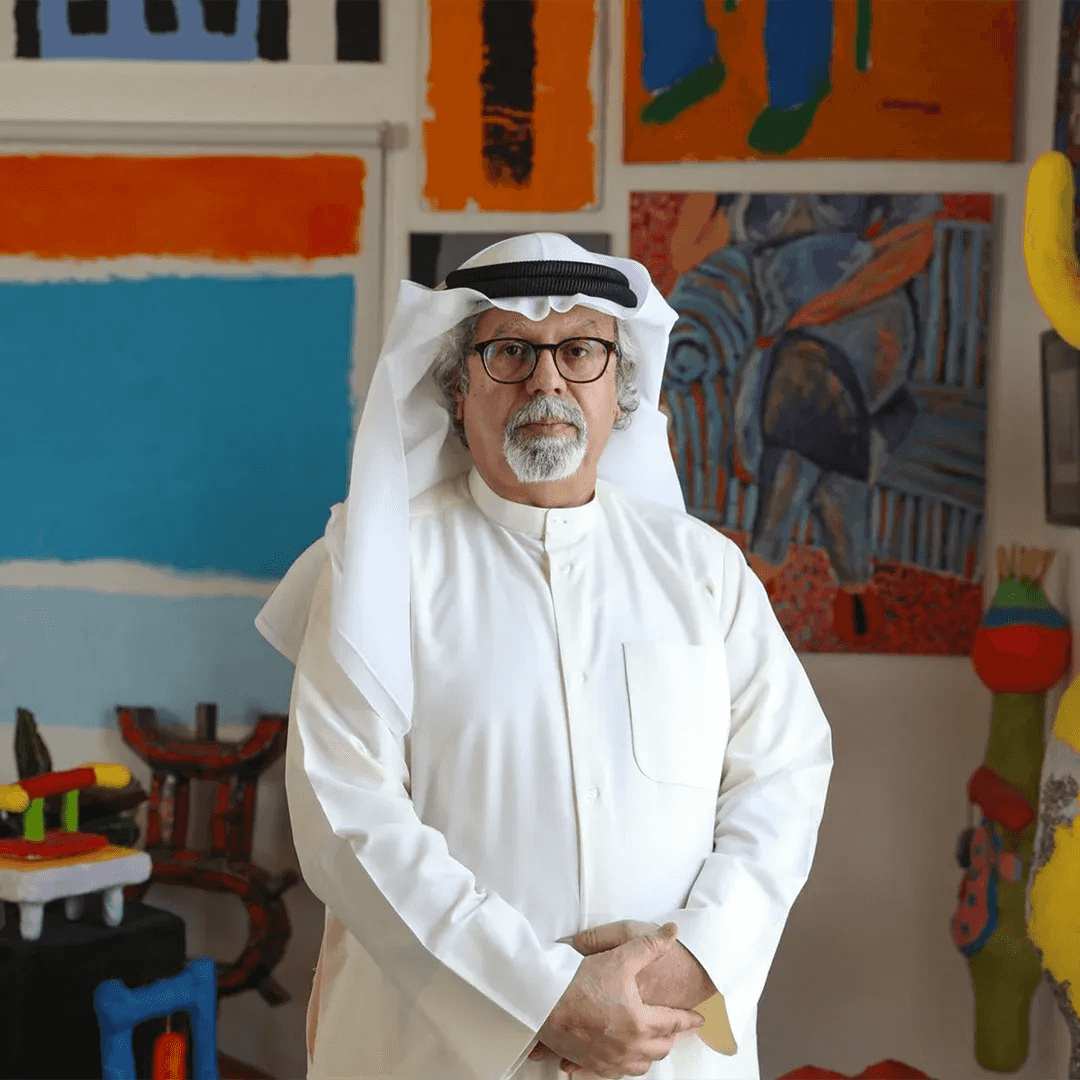
INTRODUCTION
Mohamed Ahmed Ibrahim, an Emirati artist, is widely recognized as one of the most influential artists in the UAE, alongside notable figures like Hassan Sharif, Abdullah Al Saadi, Hussein Sharif, and Mohammed Kazem. Together, they spearheaded the contemporary art movement in the UAE from the late 1980s to the 2000s. Born in 1962, Ibrahim's artistic expression is deeply rooted in his profound connection to the natural landscape, particularly his hometown of Khor Fakkan. This connection is reflected in his choice of materials, such as clay, branches, and stones, which he incorporates into his sculptures and paintings. His artworks take on primordial structures and forms, evoking a sense of timelessness and a harmonious relationship with the environment. Ibrahim has been chosen to represent the UAE at the 59th Venice Biennale in 2022.
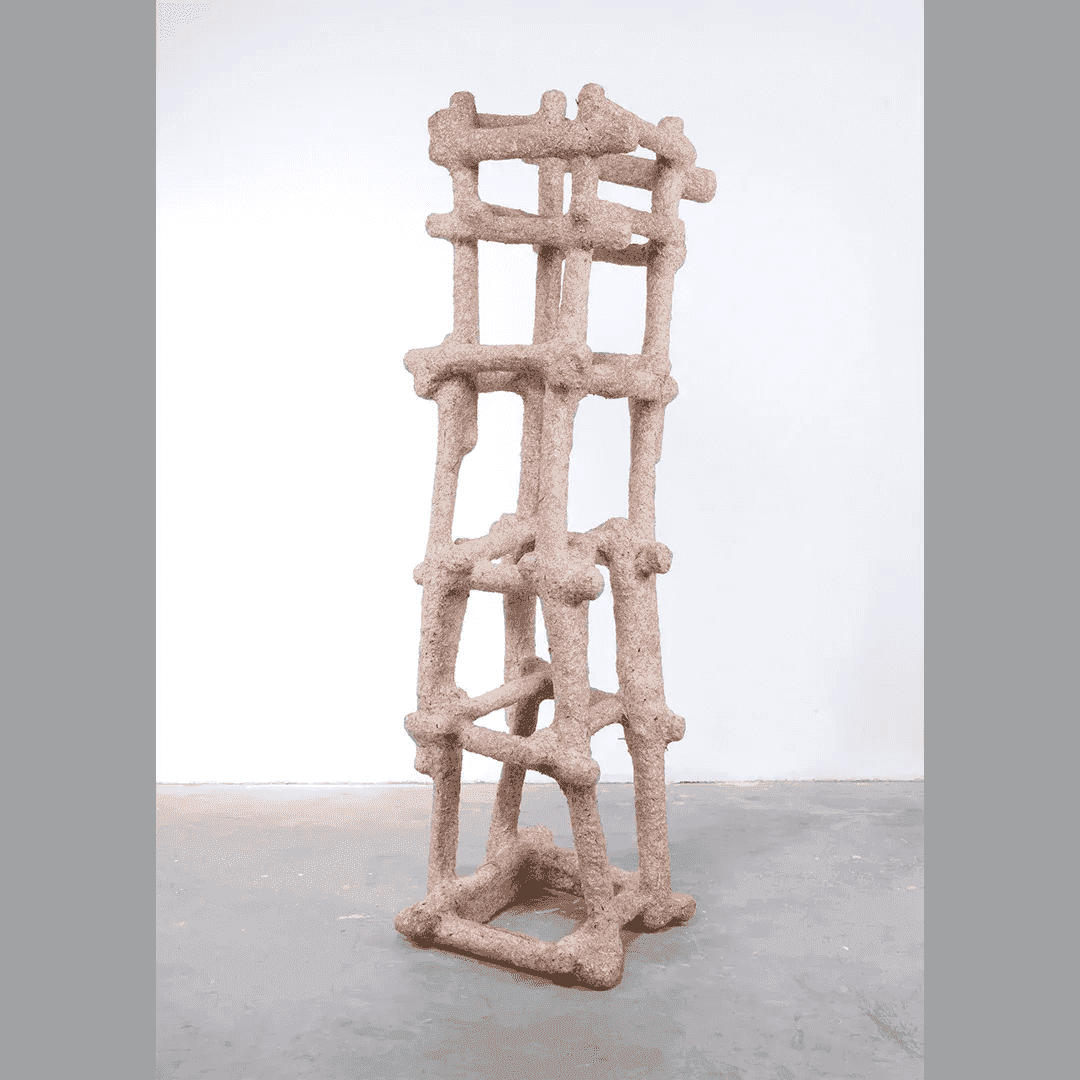
ABOUT THE ARTWORK
Tower 3, Medium: Cardboard, leaves, paper, Dimensions: 152 x 43 x 44 cm, Year: 2017
"Tower" is a remarkable artwork created by artist Mohamed Ibrahim, and it is constructed using a unique combination of materials such as cardboard, leaves, and paper. This artwork serves as a testament to Ibrahim's profound connection to nature and his deep-rooted inspiration from sustainability. The tower stands as a metaphorical representation of Ibrahim's hometown, Khor Fakkan, an idyllic coastal town known for its rich natural beauty. By incorporating materials like cardboard, leaves, and paper, the artist emphasizes the significance of utilizing eco-friendly resources and promoting sustainable practices. The structure of the tower is likely to be intricate and visually captivating. Cardboard serves as the primary material, providing a sturdy foundation for the artwork while also symbolizing the importance of recycling and repurposing materials. The leaves incorporated into the artwork represent the abundant flora of Khor Fakkan and signify the strong connection between the town and nature. Paper elements are also integrated into the artwork, potentially used to depict intricate patterns, delicate textures, or even messages that convey the artist's thoughts on sustainability and the environment. These elements may be arranged in a harmonious and artistic manner, highlighting Ibrahim's attention to detail and artistic skill. Overall, "Tower" by Mohamed Ibrahim is a captivating artwork that showcases the artist's dedication to sustainability and his deep appreciation for the profound connection between nature and his hometown of Khor Fakkan. The creative use of cardboard, leaves, and paper infuses the artwork with a sense of environmental consciousness and invites viewers to reflect on their own relationship with nature and the importance of preserving it.
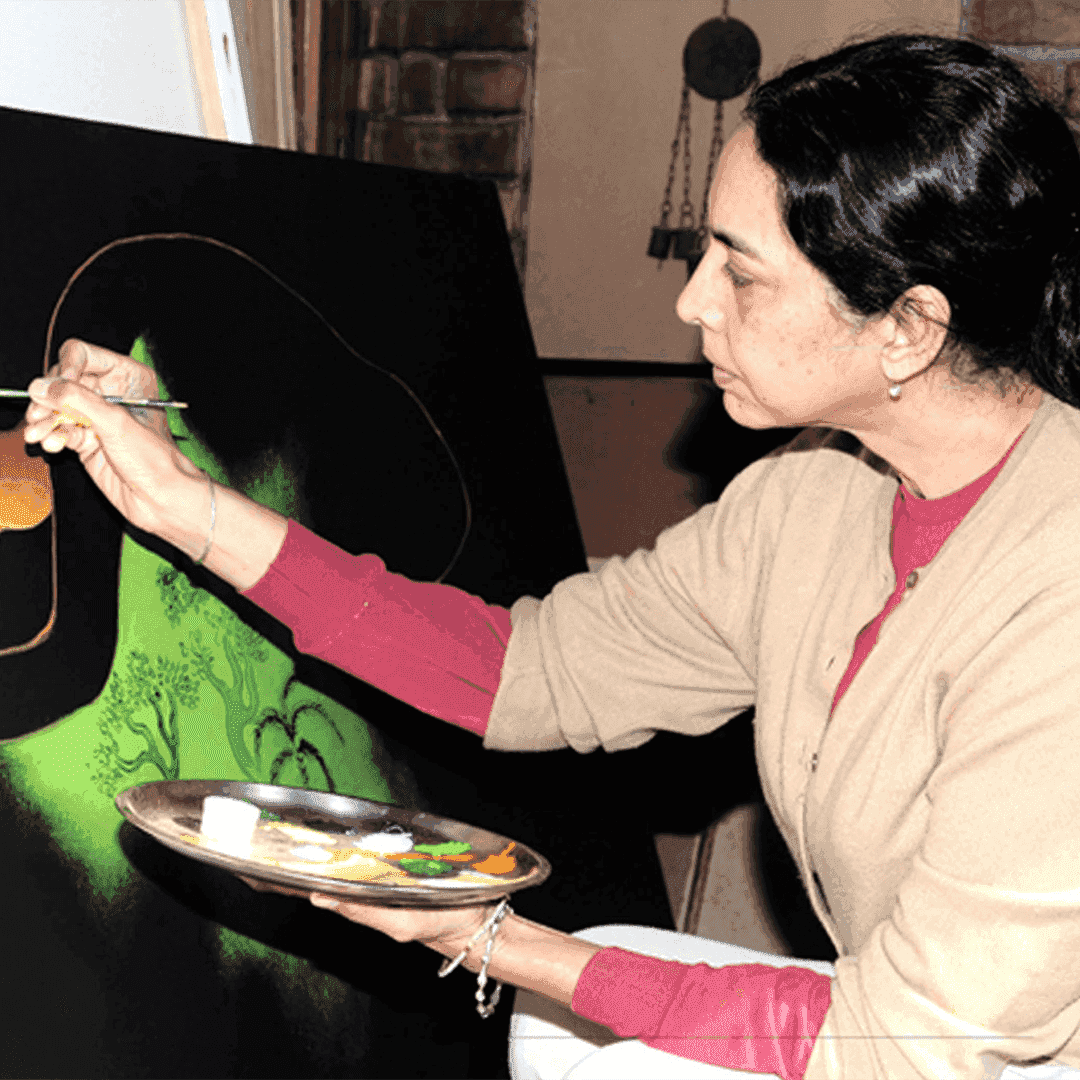
INTRODUCTION
Arpana Caur, born in 1954 in Delhi, is a self-taught artist. Caur graduated from the University of Delhi with a Master’s degree in literature. She unveils a dynamic artistic vision that reflects her concerns about contemporary issues, especially the themes of humanity and nature. Her artworks serve as a testimony, exalting the triumph of time over modernism and showcasing her genuine concerns through captivating visuals. As an observer of human life, Caur breaks free from traditional frames, offering fresh perspectives on the transformative power of life events, the complexities of identity and the indomitable human spirit. Caur's works often explore themes of spirituality, time, life and death, intertwining nature and figures that play significant roles in the stories she narrates through her art. Through various media such as watercolour, gouache, sculptures, non-commercial public murals and etchings, she layers motifs, myths and stories in order to create rich and purposeful references. Influenced by a range of artistic traditions including Gond, Gondna, Madhubani, miniature and folk art forms, Caur's works are deeply knitted to Pahari miniatures, Punjabi literature and the vibrant tapestry of Indian folk art. Through her artworks, Caur responds to the world around her. Her work reflects aspects of life centred around the woman. In addition, she reflects human tragedies and emotional trauma, putting in perspective the socio-political realities of contemporary India. Caur's works are part of the collections of several prestigious museums and institutions worldwide, including the National Gallery of Modern Art, both in New Delhi and Mumbai, Bihar Museum, Dusseldorf, MOCA L.A, Philadelphia Museum of Art, The Victoria and Albert Museum in London, and various others in India and around the world. She was the recipient of a gold medal in the VI International Triennale 1986 in New Delhi. In 2016, a 40-year retrospective of her artistic journey was held at the National Gallery of Modern Art in Bangalore with the Swaraj Archive.
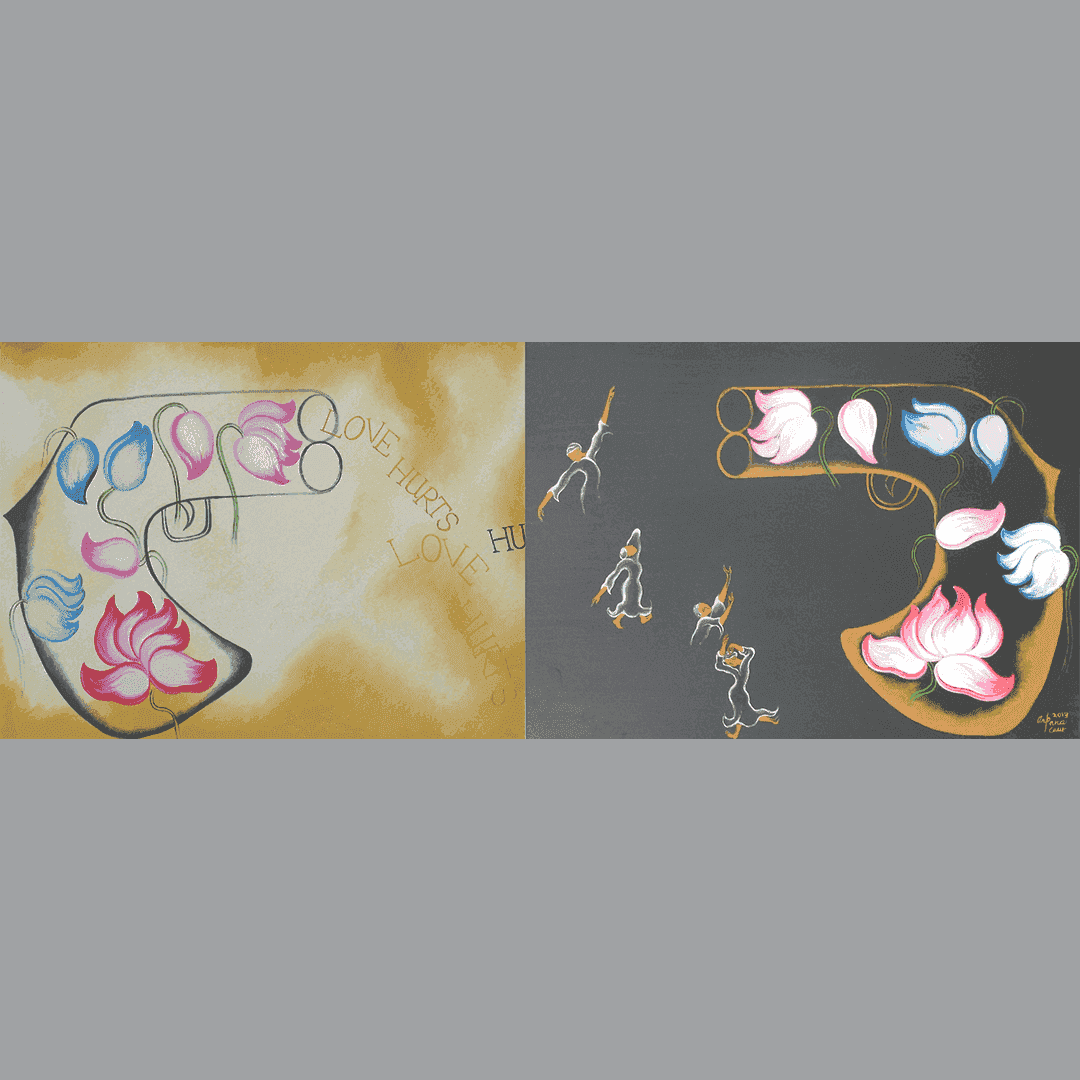
ABOUT THE ARTWORK
Love Lifts, Medium: Oil on canvas, Dimensions: 84 x 244 cm, Year: 2013
Arpana Caur’s artwork, “Love Lifts” reflects on the persistent reality of violence which has escalated to alarming levels worldwide. She observes how guns are always poised to target and accuse one another. However, amidst this grim reality, Caur emphasises that love holds greater power. She envisions the blossoming of love even from the depths of bloodshed, offering hope for humanity. Caur envisions a future where the Sufi's dance of life triumphs, urging conscious efforts towards this goal. She metaphorically describes this spiritual journey as “Hamra Haj Gomti Teer, Jahan Base Peetambar Peer.” [Trans. Of Kabir, “My Haj is by the river Gomti where my Krishna dances.”] Caur's painting exudes an earthy and vigorous quality while displaying a deep empathy towards the subject matter. Through the inclusion of symbols such as guns and the thought-provoking words “Love Hurts,” she explores themes of violence, complexities and challenges with it. However, it is through her adept use of lotus motifs and skillful application of colours like white, ochres, grey and blue that Caur infuses her works with a profound essence of love, spirituality and consciousness. Her artistic style is characterised by simple yet effective sketches of human figures, meticulously arranged shapes and rhythmic lines. While she ventures into surrealistic backgrounds too, it is the darker ones that resonate deeply, enhancing the contemplative nature of the themes she portrays.
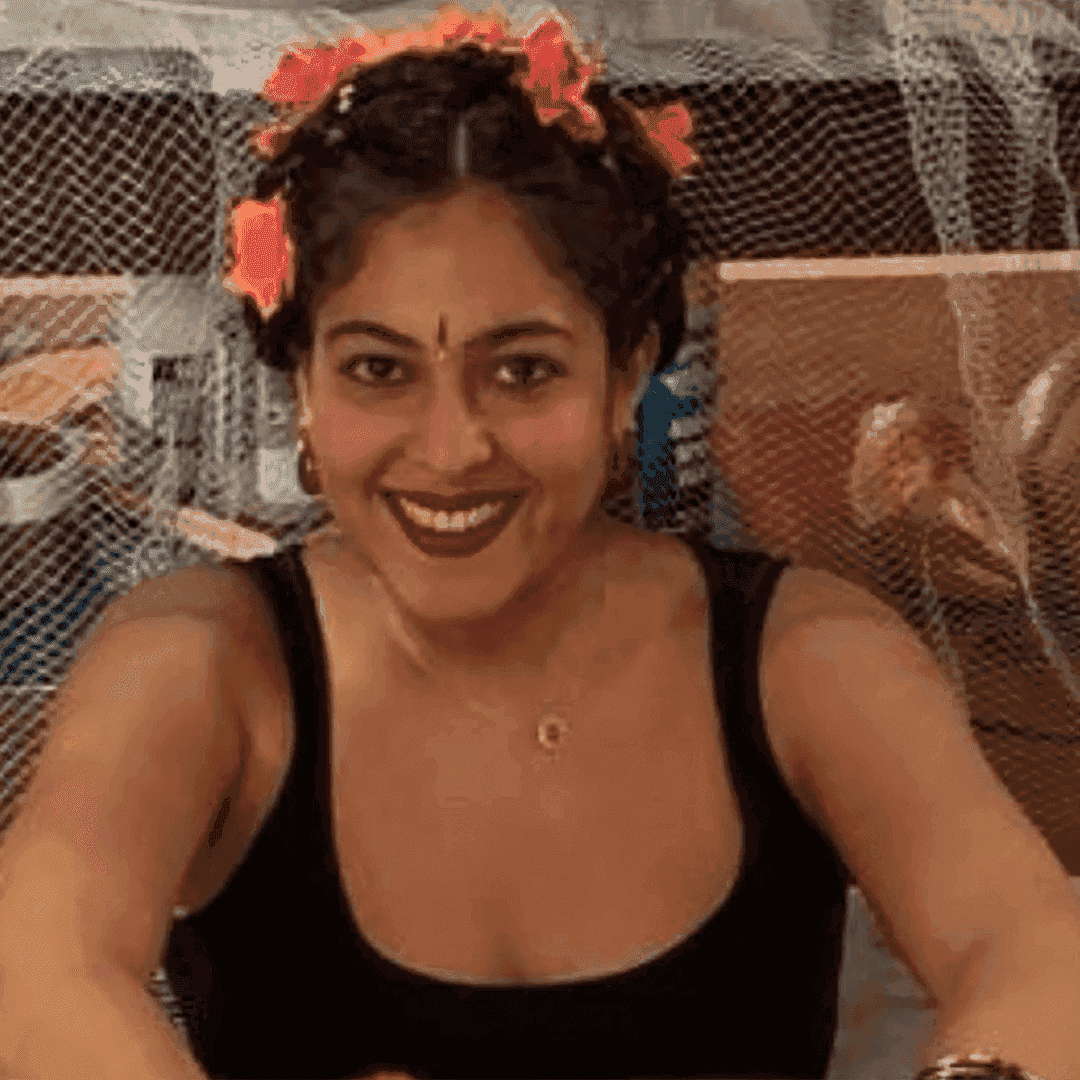
INTRODUCTION
Ayesha Seth Sen, born in 1981, is a collage artist for mixed media who lives and works in New Delhi. She pursued law at the University of Wales, Cardiff and graphic design at Parsons' School of Design, New York. After working for a while at a graphic design firm in New Delhi, she gained recognition with a sell-out solo show. A transformative 10-year period in a Goa fishing village influenced her practice. The artist uses new media and technologies. Although she utilises computer manipulation for image editing and intricate shape design, every aspect of her collage is meticulously assembled by hand. Her palette is expansive, forgoing traditional paints and brushes in favor of X-Acto knives for high precision cutting, an array of adhesives, holographic paper, Japanese paper, transparencies and found objects. These diverse elements blend harmoniously to create her captivating pieces, showcasing her ability to fuse different materials seamlessly. She loves to disregard rules and that shows in her fascination for deconstructing materials and reconstructing new ideas with them. Sen's intricate works serve as a reflection of her personal experiences and intense narratives. Sen seeks to communicate a distinct and emotive experience through her unconventional art. Her unique mixed media collage pieces, different from traditional paint on canvas, evoke strong reactions in viewers--of love or hate. Sen's ultimate goal is to elicit emotions, ensuring that her art leaves a lasting impact. The ability to make others feel is a testament to the success of her creative endeavours. Her artistic journey has comprised of many solo exhibitions and numerous group shows in India and abroad, attracting collectors worldwide. Sen also enjoys conducting collage workshops for all ages. Now she is planning a permanent move to Goa where she aims to establish her studio and a residency program.
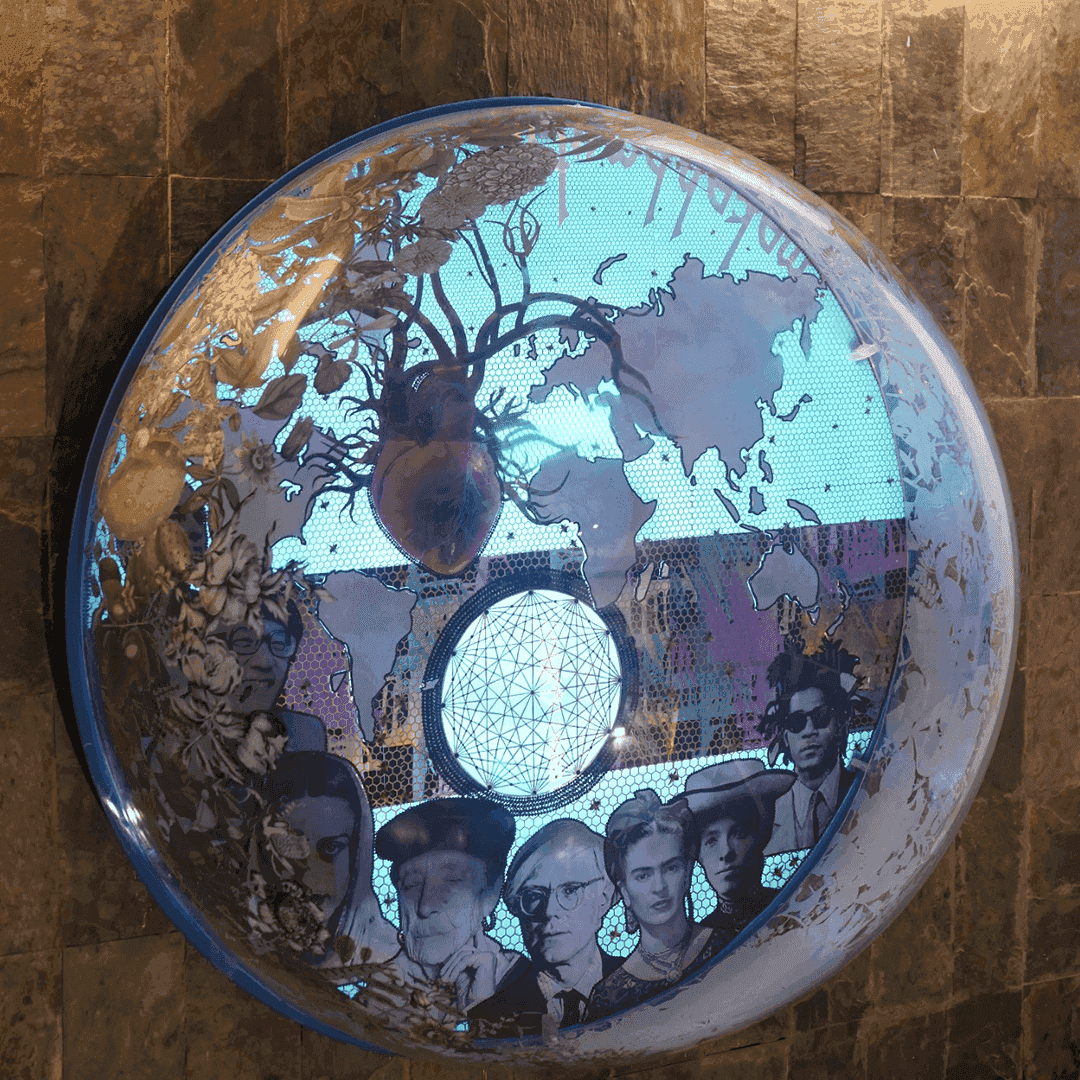
ABOUT THE ARTWORK
Vasudhaiva Kutumbhakam, Medium: Mixed- media collage on acrylic base, Dimensions: 116.8 x 61 cm, Year: 2003
“Vasudhaiva Kutumbakam—The World is One” is an immersive art installation that encapsulates Sen's personal philosophy of global interconnectedness, symbolising the shared responsibility we have as human beings to protect and nurture the world we inhabit. The artwork features a circular canvas, representing the world enclosed within a dome. The top side of the canvas displays a world map, while the bottom portrays a diverse group of people from different ethnicities, symbolising the unity within diversity. A monumental human heart at the center extends over the globe, embracing it with love. The concept emphasises collective action for the planet to flourish which will encompass future generations. Featuring renowned artists and their legacies, the aim is to showcase the enduring power of art. A golden honeycomb symbolises a thriving ecosystem uniting people and the world, while monochromatic botanicals serve as a reminder of our shared responsibility to nurture and protect the environment. The absence of colour signifies our shared responsibility to safeguard the environment. Depicting the avatars of Lord Vishnu, the artwork preserves ecological harmony, while butterflies and insects flutter, celebrating the coexistence of nature when we unite as one.
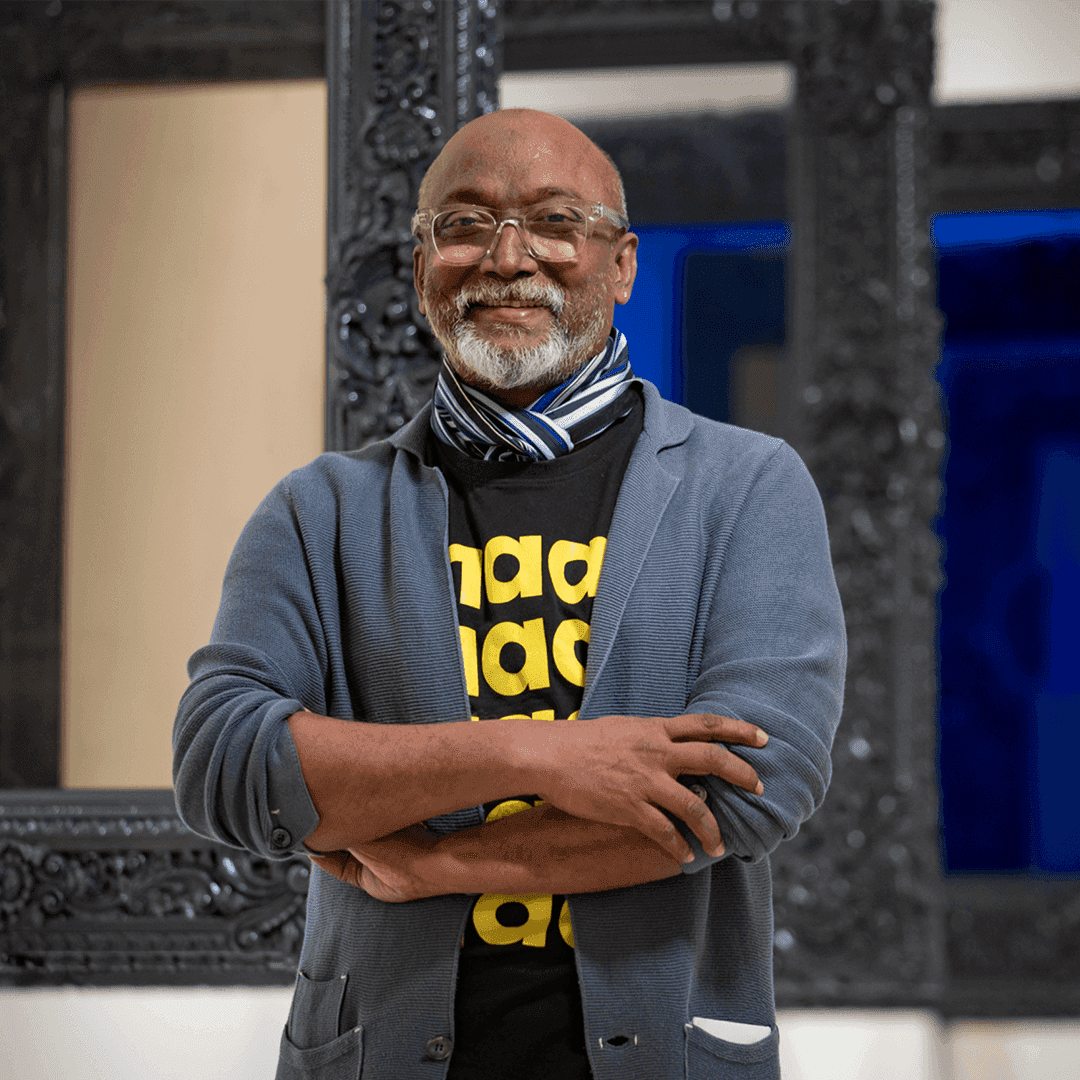
INTRODUCTION
Bose Krishnamachari, born in 1962 near Angamaly, Kerala, is an acclaimed multi-disciplinary artist and curator. He shuttles between Mumbai and Kochi while showcasing a diverse range of creative practices. Bose earned his BFA from Sir JJ School of Art, Mumbai; later he completed MFA at Goldsmiths' College, University of London. Krishnamachari's artistic pursuits encompass drawing, painting, sculpture, design, installation and architecture. His artistic journey has been a pursuit of pushing the boundaries of abstraction, seeking to reach the utmost expression of colour, texture, line and form. In his vibrant and dynamic abstract canvases, he navigates the coexistence of extremities, effortlessly blending chaos and order. Krishnamachari fearlessly binds his bright abstract pieces with his mastery of bold and expressive compositions while continually exploring new styles and techniques. Krishnamachari's art sparks reflection on the transformative power of cross-cultural interactions, revealing the intricate tapestry of our interconnected world.
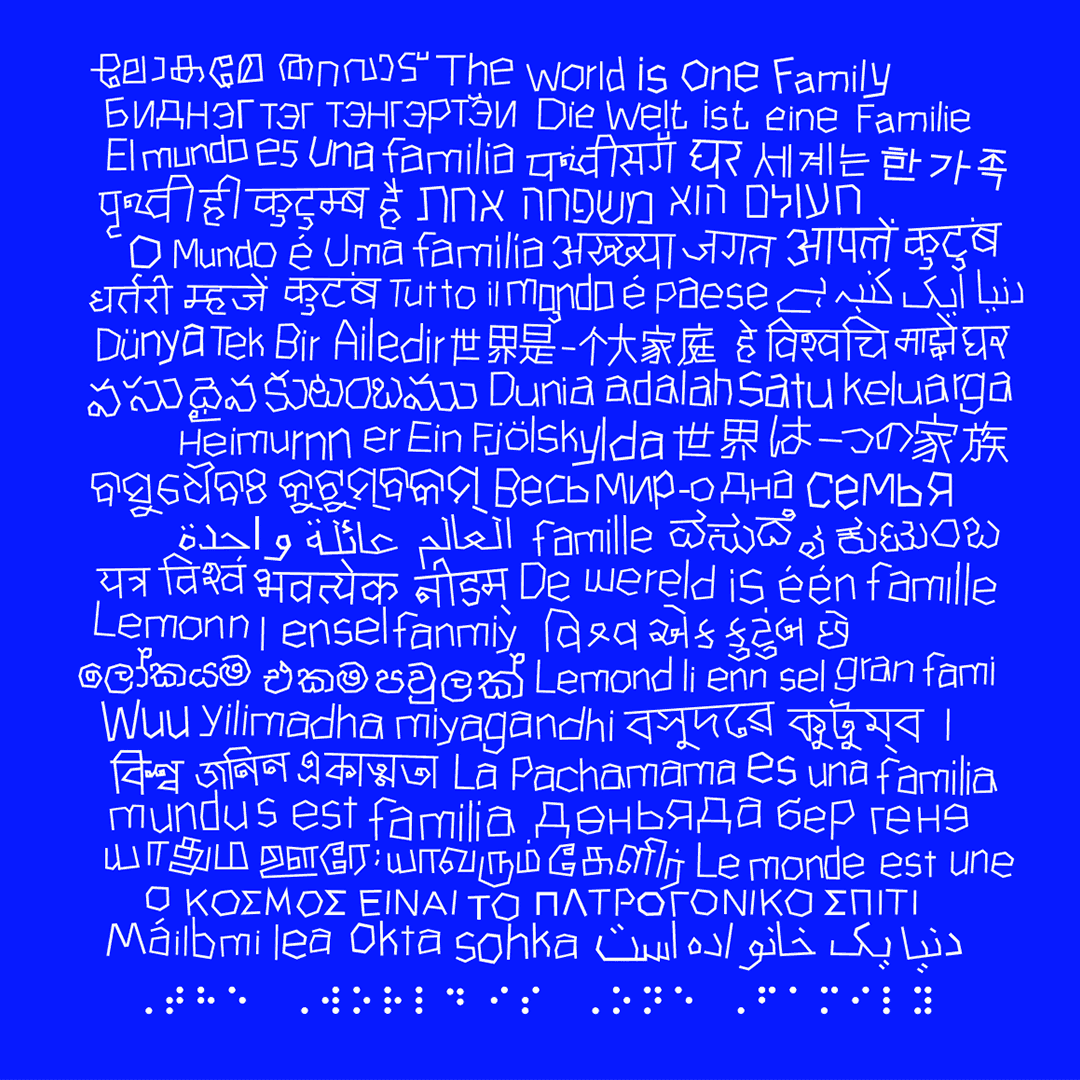
ABOUT THE ARTWORK
The World is One Family, Medium: Serigraph, Framed silk-screen fabric, 3000 offset printed posters, Dimensions: 112 x 81 cm, 122 x 92 cm, 74 x 60 cm, Year: 2023
Bose Krishnamachari's iconic mixed-media artwork, “The World is One Family,” emanates from a vibrant and diverse palette, skillfully utilising the colours blue and white in their purest forms. This deliberate choice evokes a profound sense of unity, harmony and interconnectedness while fostering cultural appreciation and understanding. The artwork encapsulates the essence of diversity and coexistence in India, the world's largest democracy. Through the creation of a multilingual poster, Krishnamachari aims to establish a deep connection to one's mother tongue, transcending linguistic boundaries by translating it into 38 languages, with potential for further additions. This inclusive approach recognizes that certain communities and tribes lack a written language. This emphasises the artist's unwavering belief in universal brotherhood and a secular world that embraces and celebrates pluralism. The enduring relevance of blue remains steadfast, capturing the essence of innovation and creative exploration and the colour white symbolises loyalty and purity, finds. Its presence further enriches the narrative, adding layers of meaning and depth to the composition.
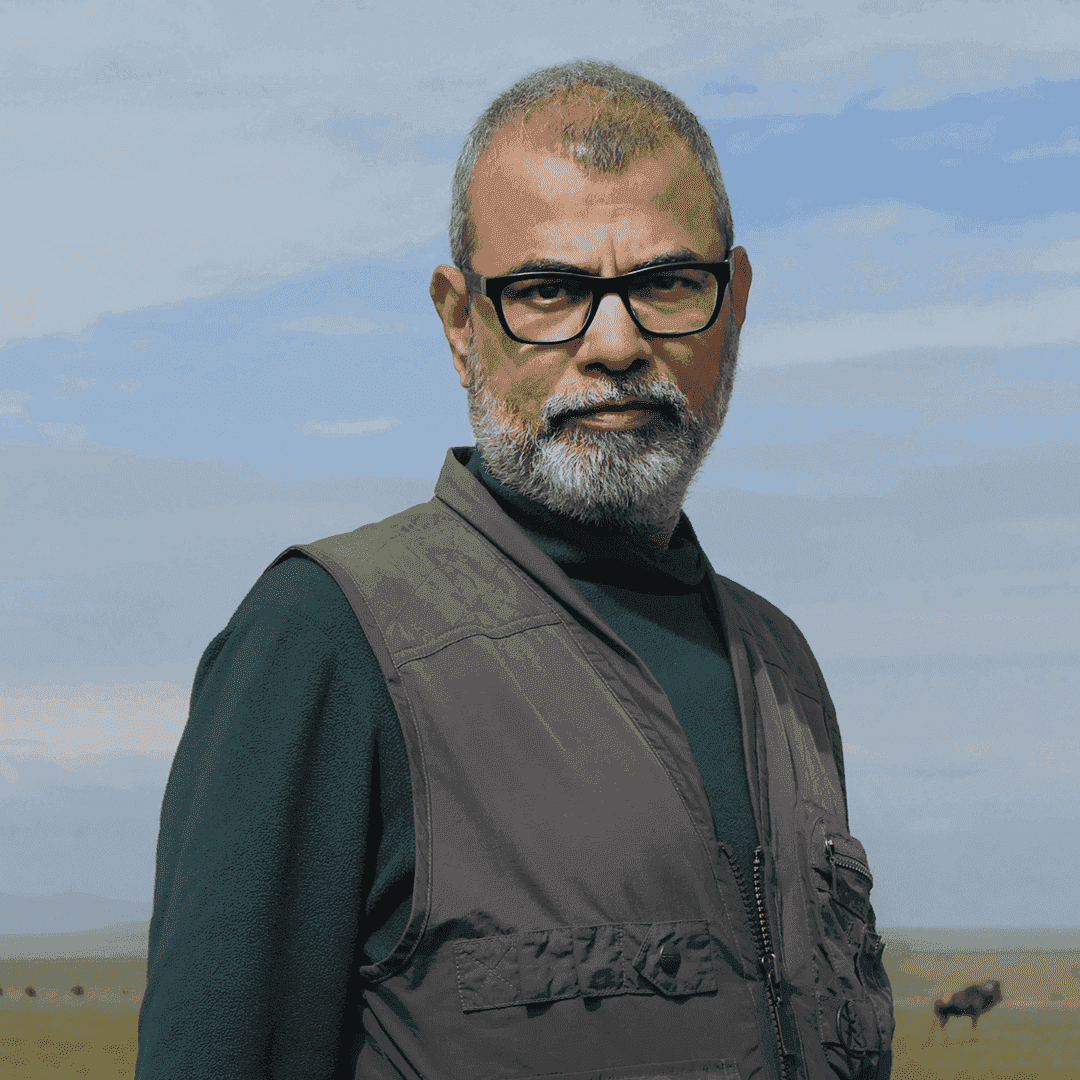
INTRODUCTION
Chandra Bhattacharjee, born in 1960 in Patuli, West Bengal, is a Kolkata-based artist. He graduated from the Indian College of Art and Draftsmanship which marked the beginning of his artistic journey. Initially starting as a billboard artist, Bhattacharjee's artistic practice now transcends traditional boundaries. It encompasses media such as paintings, photographs and moving images. His surrealistic canvases portray a world where nature, flora, fauna, humans, animals, man-made forms, varied terrains and imaginative landscapes coexist harmoniously. All these captivate viewers and evoke in them a sense of wonder. Drawing inspiration from rural and tribal themes, Bhattacharjee's compositions reflect his close association with communities like the “Santhal” tribe in Bengal. Within his artworks, one can perceive reflections of great Bengali literature that offer insights, intuitions and sensorial dictations against the urban backdrop. Bhattacharjee's art addresses pressing environmental concerns, emphasising the delicate balance between human activity and the environment through his distinctive visual imagery. His artworks exhibit a textured quality reminiscent of traditional mud-walls in West Bengal's tribal villages, highlighting the importance of nature. With a unique artistic language, he employs a conté base on the canvas and skillfully layers luminous acrylics with a matte finish, employing meticulous brushwork to evoke emotive expressions and nocturnal narratives that offer glimpses into singular moments in time. Through the technique of cross-hatching, Bhattacharjee captures the nuanced essence of nature that significantly enhances the depth of his paintings. Bhattacharjee has showcased his works in prestigious galleries like Art Alive Gallery, Delhi, Gallerie 88, Kolkata, Threshold Gallery, Delhi, Gallery on Cork Street, London, among others. His art has been featured in auctions by Saffron Art and Bonhams. He actively participates in national and international art workshops and group exhibitions, regularly exhibiting at the India Art Fair and Art Singapore. His artworks are housed in public collections such as the Museum of Bengal Modern Art in Kolkata and the Jordan National Gallery of Fine Art. He was also an artist-in-residence at the Rashtrapati Bhavan in November, 2020.
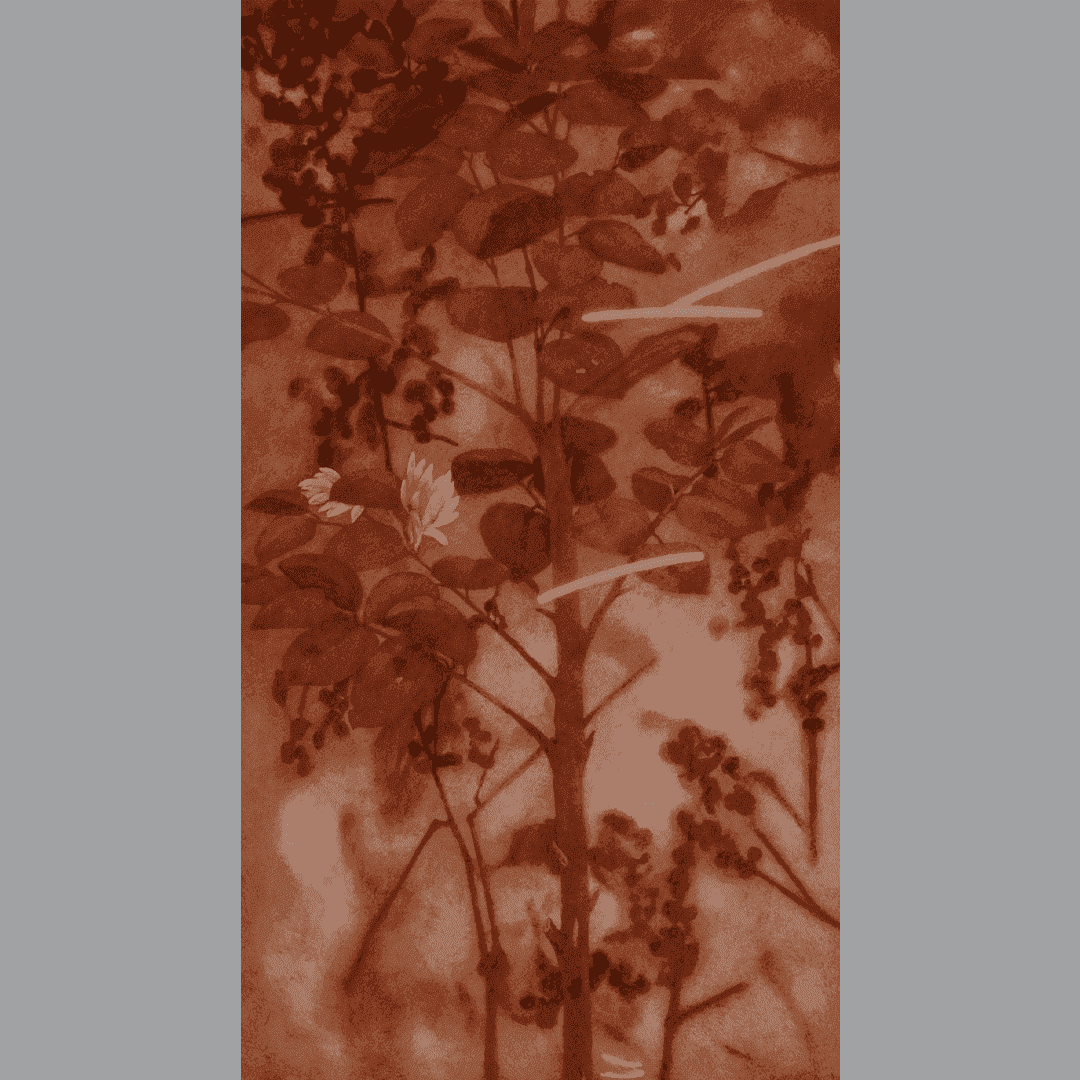
ABOUT THE ARTWORK
Untitled (From Veins of The Earth series), Medium: Acrylic on canvas, Dimensions: 213.3 x 122 cm, Year: 2023
“Untitled” from the series “Veins of the Earth” transports viewers to a primitive landscape, an untamed terrain that remains unaltered by human intervention. Through melancholic and moody artistic edits, the artwork captures a sense of mystery and introspection. The surrealistic nature of this artwork is characterised by subdued earthy tones, reminiscent of the soil, and a luminous quality brings the composition to life. Modest shades, hints of white, and skillfully rendered shadows contribute to the atmospheric quality, creating a captivating depiction of a natural world where flora, fauna and diverse terrains coexist in harmony. Bhattacharjee's artwork reflects a smoky forest creating an interplay of shadows and light that imparts a quality akin to film negatives. The artwork transports viewers to a rural India that feels far removed from the urban landscape. Within a pastoral distance, the artwork offers a glimpse into a whimsical setting where the starkness of the surroundings is delicately balanced by muted colours, creating an almost monochromatic palette. This subtle use of hues adds depth and richness to the artistic narrative. Through each brushstroke, Bhattacharjee attempts to broaden our perception and explore the hidden depths within the earth. He believes that our human perspective is not the sole lens through which the beauty of the world can be experienced. His paintings attempt to delve deeper into the finer nuances of the mysterious and imaginative ecosystem we inhabit.
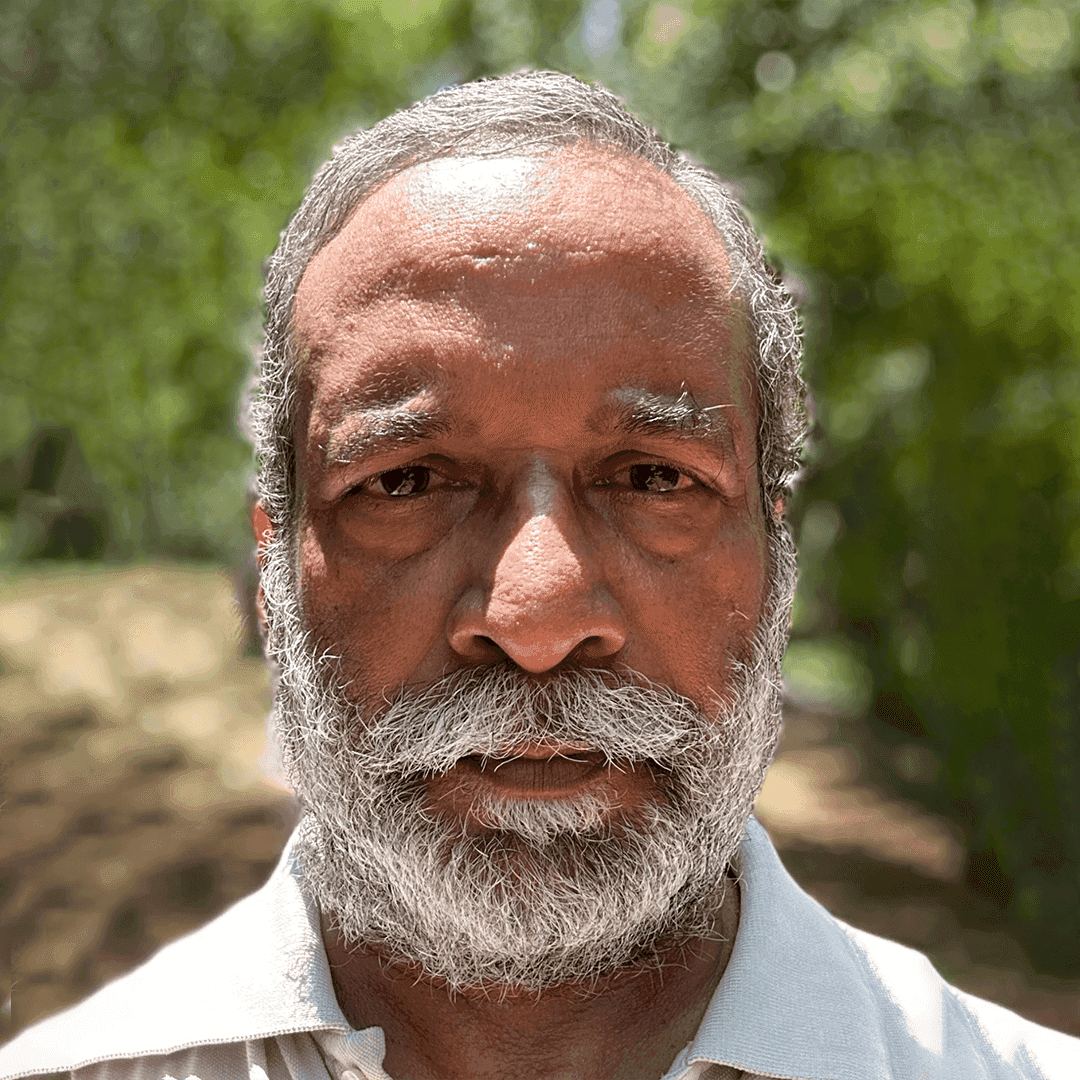
INTRODUCTION
Gavva Ravinder Reddy, born in 1956, lives and works in Vishakapatnam, Andhra Pradesh, in Southern India. He completed his Bachelors and Masters from the MS University Baroda, received a diploma in Art and Design from Goldsmith’s College, University of London, and did a Certificate course in Ceramics from the Royal College of Art, London. Reddy is a contemporary Indian sculptor who draws upon the mythic and cultural construct from his immediate environment, especially as he continues to explore the contours of the human body in his inimitable style. He works primarily with a type of gilded fiberglass in his renditions of heads. These heads are sculpted in a frontal manner, often with wide open eyes, the characteristic attitude of one who proclaims. None of his sculptures look sideways or over the shoulder. Reddy draws his inspiration from pre-modern civilizations like the Egyptians, the early Greeks where over-simplification and formality prevailed. Reddy’s sculptures are heraldic, many of them larger than life. He often gilds them generously with gold or uses complex hair-dos on the female heads in emblematic designs. The sculptures are non-conventional in their visual language. There is a repeated outbreak of sensuality in his work. Even if the subject may not be overtly sexual, the sensuality of colours imbue his work with a certain vigour and palpable energy. Paradoxically, the sensuality in his work is serene, and in most instances the sexual impulse does not speak of excitement but of fulfillment. He specifically fuses the archetypal with the individual to present an element of primitivism in the visual representation of each sculpture, almost compelling the viewer to literally enter into the work itself. Reddy has been widely exhibited in India and abroad. His work is collected by significant and important collectors at museums and galleries both nationally and internationally.
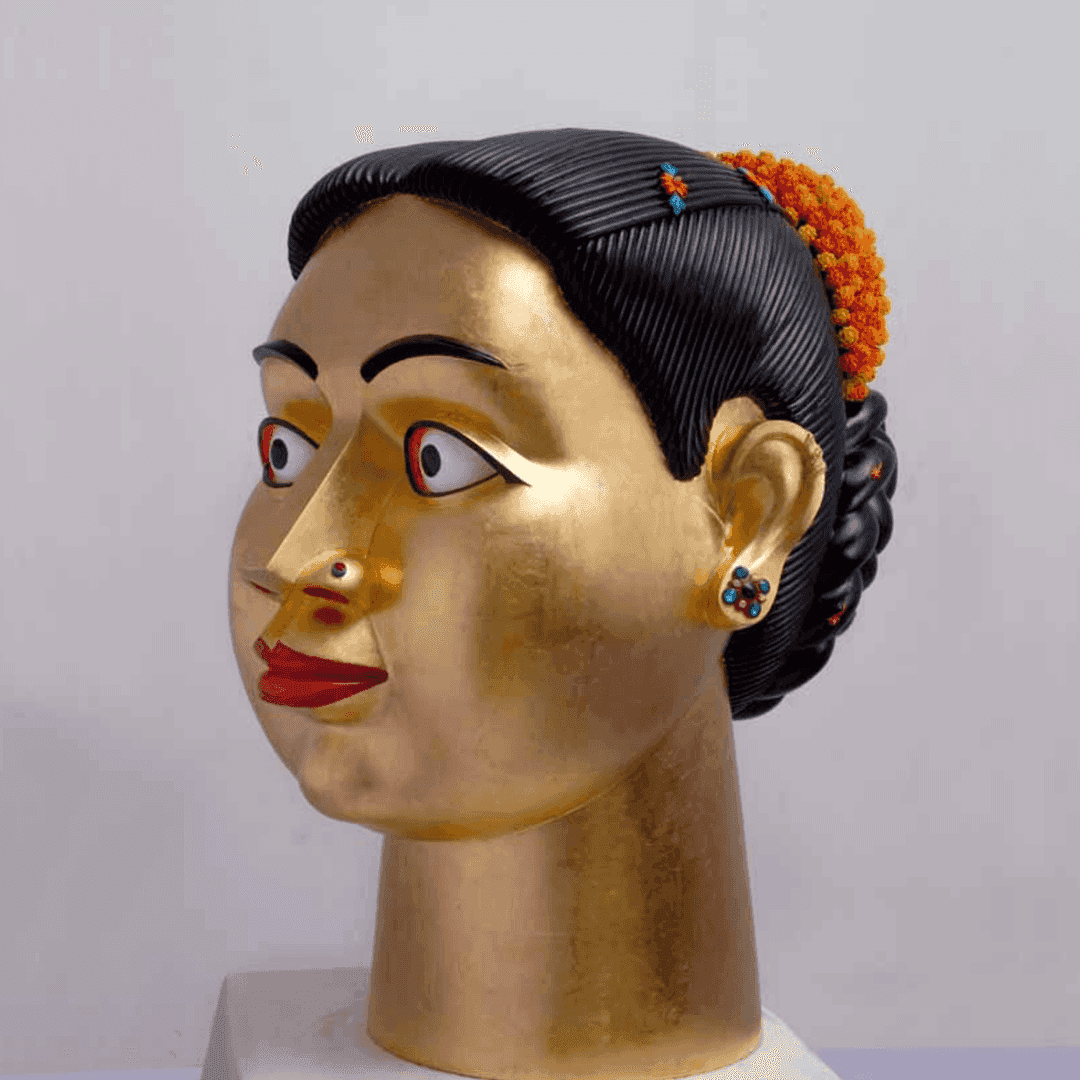
ABOUT THE ARTWORK
Portrait of Gauri, Medium: Painted and gold gilded on polyester resin fiberglass, Dimensions: 101.6 x 63.5 x 94 cm, Year: 2017
Gavva Ravinder Reddy's remarkable sculptures of heads are celebrated for their extraordinary fusion of popular and vernacular aesthetics, as seen in his “Gauri” with its golden hue, emotive expressions, dramatic effects, detailed hairstyles and floral adornments. The intricate details of the sculpture and expressions refer to the fervent intensity of a passionate gaze. These captivating expressions transcend cultural and societal boundaries, reminding us of our shared humanity, cultural plurality and the level playing field of craft, popular culture and the fine arts. Reddy's skillfully fashioned hair-buns evoke an air of majesty and grace. With the vivid blooms that embellish the works, Reddy refers to the plurality of Indian culture where flowers embody deep meanings of beauty, divinity and festivity throughout the country. The careful details and lush shapes speak to the Indian traditions of aesthetics and femininity. Reddy's sculptures merge elements from diverse sources into a unified practice that creates an accessible bridge between past and present. By emphasizing the need to protect and treasure our multifaceted roots, Reddy invites everyone on a voyage of cultural continuity, transcending the boundaries of place and era in a vibrant celebration of diversity and distinctiveness.
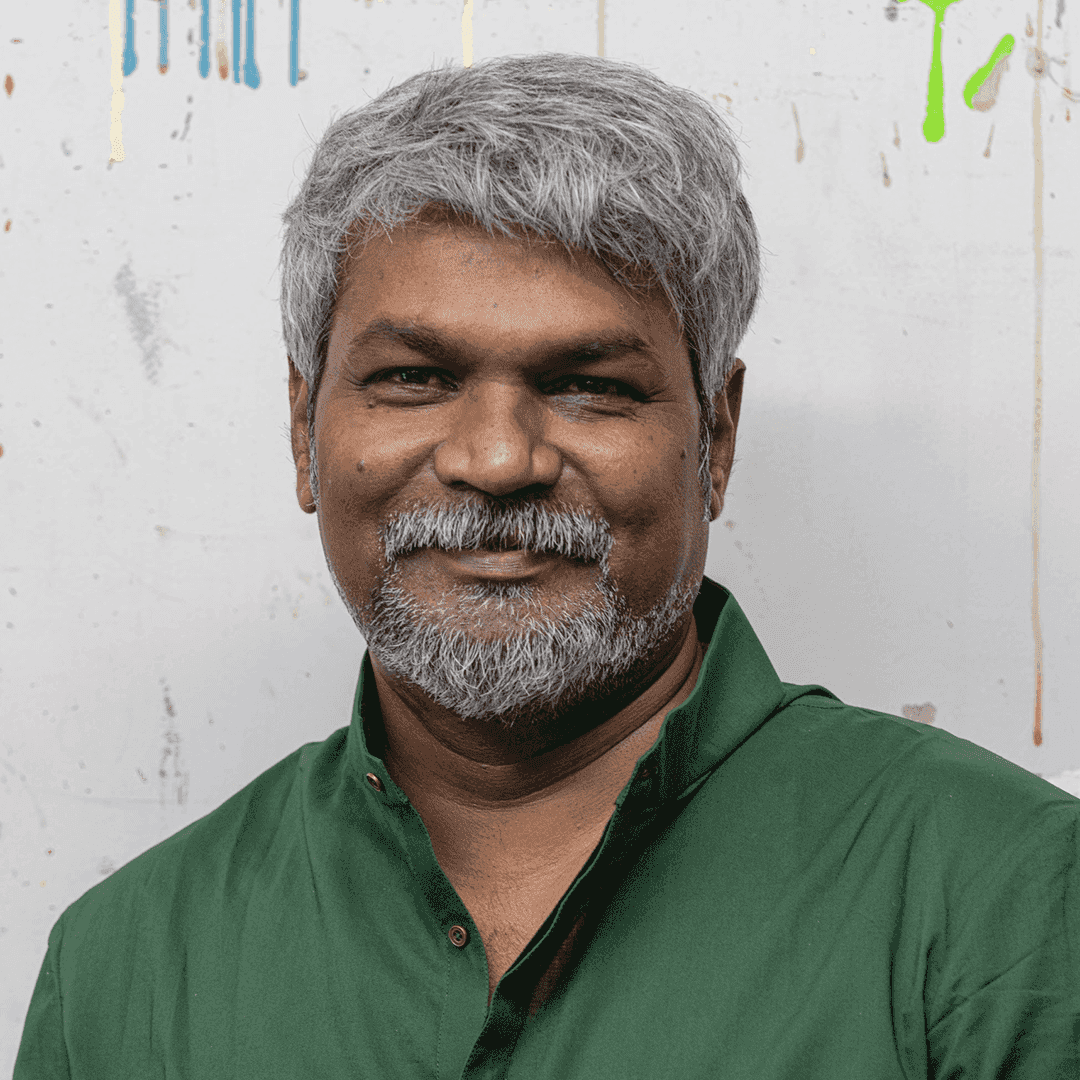
INTRODUCTION
G. R. Iranna, born in 1970 in Sindgi, Karnataka, is an acclaimed Indian artist known for his thought-provoking paintings and installations. Hailing from an agrarian family, he has established himself as a prominent figure in the contemporary art scene. Iranna holds a Master of Fine Arts in Painting from the College of Art, Delhi and has studied at the Wimbledon School of Art, London. Through his practice, Iranna manifests metaphysical dualities that explore the interplay between nature and human artifice, spirituality and materiality, permanence and transience. He represents the contrasts of heaviness and lightness, darkness and light. One particularly captivating motif that recurrently emerges in his creations is that of the tree. However, in his artistic realm, the tree transcends its conventional representation, becoming an enduring entity that holds profound symbolic significance beyond its physical form or visual representation. Iranna’s portfolio encompasses a wide range of media, including paintings, videos and sculptural installations, as he delves deep into the introspective aspects of human existence, social issues and the existential challenges of our modern era. His profound exploration spans temporal conflicts and spiritual dilemmas, unearthing incisive insights from philosophical doctrines and religious practices. He draws inspiration from a rich tapestry of philosophical sources, particularly finding resonance in Lingayatism and Buddhism. These traditions emphasize inner peace and wisdom which serve as guiding principles for his artistic endeavours. Layered with evocative meanings, his works reveal profound connections to morality, wisdom and various ways of life. His artistic evolution is marked by a shift towards abstract exploration, energising his works with dynamic form. His paintings depart from postmodern logic and embrace the representative modernist language of Indian contemporary art. Iranna has held numerous solo exhibitions worldwide, including showcasing his art in New York, Delhi, London and Munich. His works have been featured in prestigious group shows such as the Venice Biennale and the Kochi Muziris Biennale. His thought-provoking creations have received critical acclaim and grace prestigious collections like the National Gallery of Modern Art, New Delhi and the Singapore Art Museum. With a remarkable artistic journey spanning two decades, Iranna constantly captivates audiences with his profound expressions.
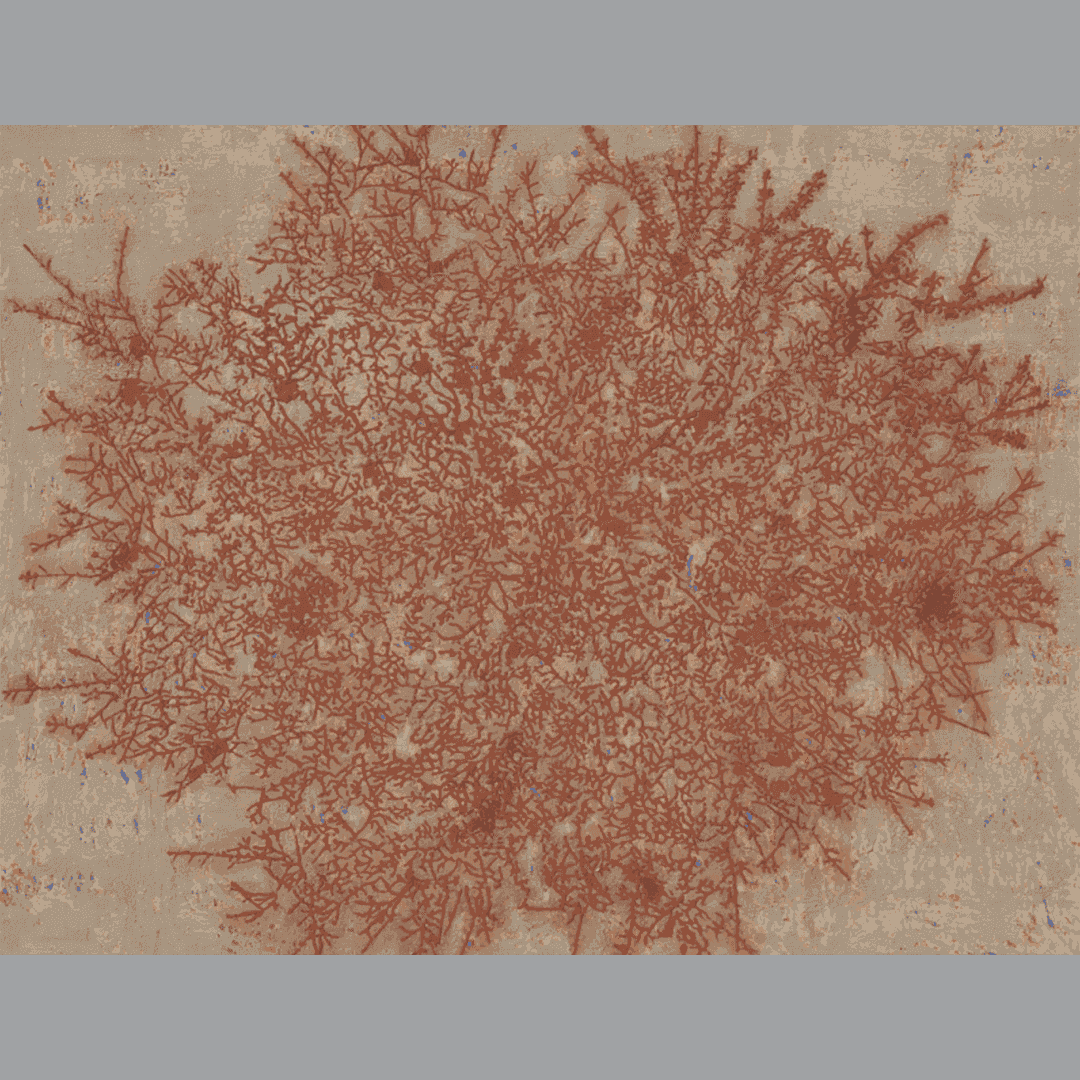
ABOUT THE ARTWORK
धुल (Dust to Dust), Medium: Ash acrylic brick dust on tarpaulin, Dimensions: 167.6 x 213.3 cm, Year: 2023
In Iranna's artwork “धुल” (Dhul-Dust to Dust), the use of dust holds significant spiritual and symbolic meaning. Dust and ash embody notions of impermanence, transformation and the eternal cycle of life and death. Rooted in spiritual and religious traditions, dust is recognized as a potent symbol of mortality and the fleeting nature of human existence by representing the eventual return of the physical body to the earth, along with the natural decay and dissolution of all things. This symbolism resonates in the well-known idiom "ashes to ashes, dust to dust." Just as the remnants of a burnt tree become the fertile ground for new growth, our physical bodies too will eventually return to the earth, completing the life-cycle. His artistic touch transforms powdered pigments as he gracefully incorporates them into the rugged texture of tarpaulin, infusing his subdued colour palette with a sense of ethereal beauty. By utilising dust as a medium, he adds depth, texture and a hint of intrigue, thus inviting viewers to engage in contemplative reflection. In his artwork, the presence of dust asks viewers to contemplate the complexities of existence and our place within the vastness of the universe.
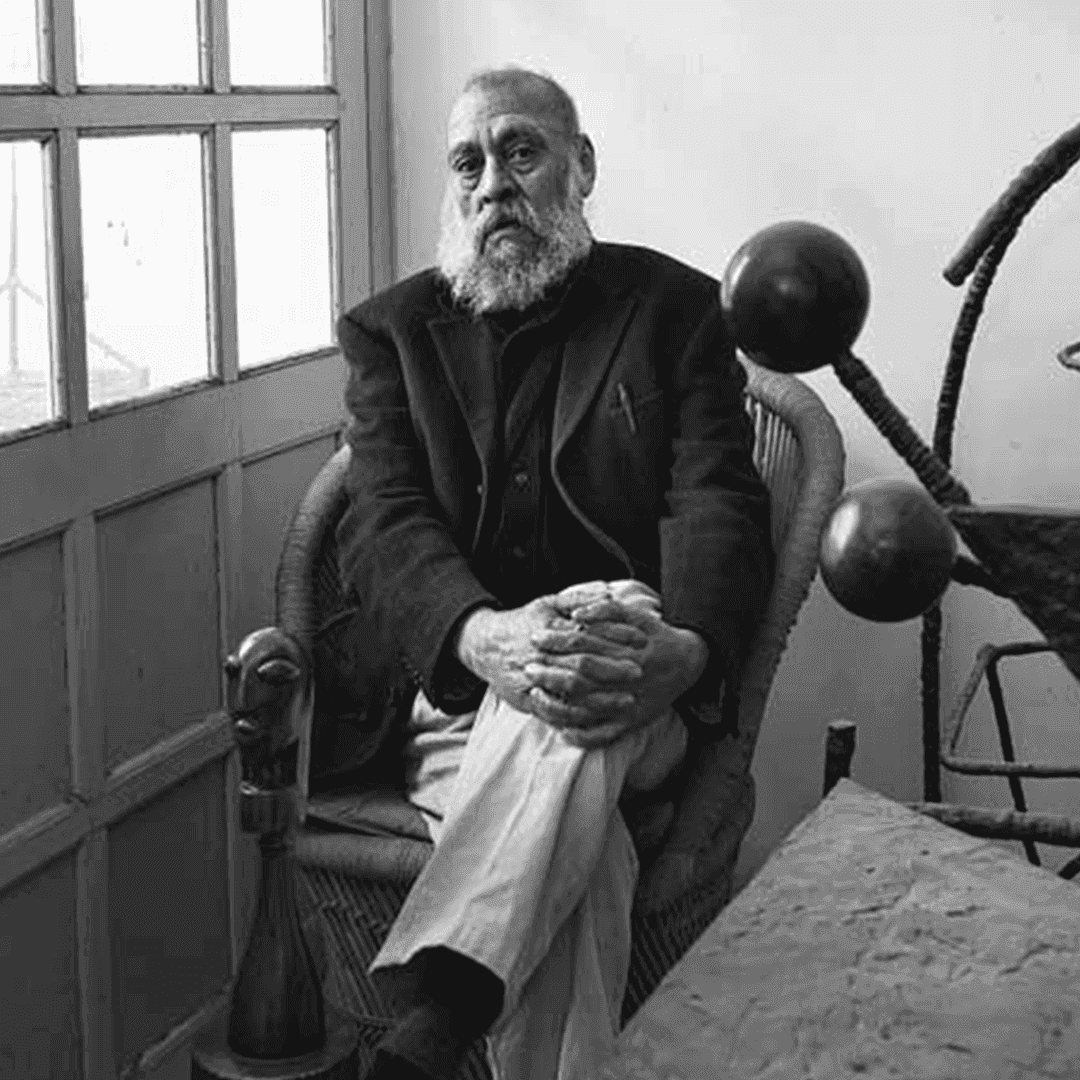
INTRODUCTION
Himmat Shah, born in 1933, hails from Lothal, Gujarat and presently resides and works from his studio in Jaipur, India. He initially trained as a drawing teacher and studied painting at the Faculty of Fine Arts of M. S. University, Baroda. He then received a French Government scholarship and went on to study etching at Atelier 17 in Paris under Krishna Reddy. Primarily, Shah identifies himself as a sculptor and experiments with various art forms and media, including burnt paper collages, architectural murals, drawings and sculptures. Through his self-designed tools and innovative techniques, he brings a contemporary touch to his preferred medium - terracotta. Employing an array of implements, brushes, instruments and hand tools, Shah skillfully carves, shapes and molds his artworks. Within his sculptures, he adeptly incorporates printmaking surface effects, showcasing his remarkable ability to dynamically interpret diverse materials. His engagement with international modernism was nurtured during his two-year stay in Paris when he immersed himself in the museums of Europe. Celebrated for his experimental use of materials such as terracotta, bronze and stone, each chosen for its distinct qualities and expressive potential, Shah's sculptures delve into human forms and abstract shapes, to strike a delicate balance between simplicity and complexity. With a keen interest for the primitive, timeless and transcendental, his artworks evoke contemplation and introspection in viewers. Notably, he is widely recognized for his relief works, terracotta heads and bronze sculptures. Shah has participated in several solo and group shows in India and abroad. He was awarded the Kalidasa Samman by the Government of Madhya Pradesh in 2003 and the Sahitya Kala Parishad Award in 1988 in New Delhi.
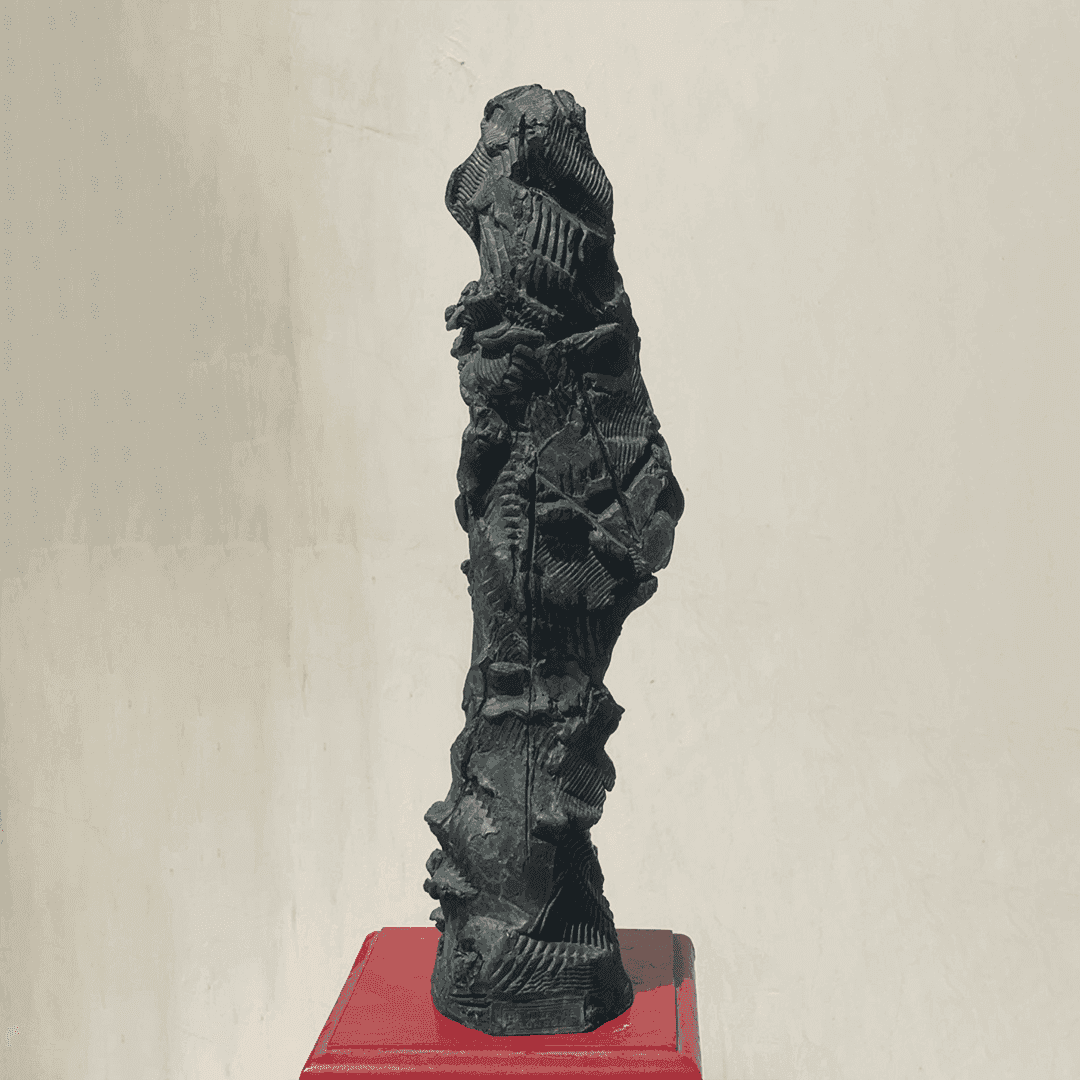
ABOUT THE ARTWORK
Untitled, Medium: Bronze, Dimensions: 37 x 10 x 9 cm, Year: 2019-20
In “Untitled,” Shah fashions his work with texture on surface skills that has become his signature style. He also uses the lost wax technique that is also known as the cire-perdue technique. His composition is largely abstract and demonstrates unusual configurations of form and shape. The material used is bronze which signifies durability. His artistic style is distinguished by a harmonious blend of modernist aesthetics and a profound connection to his cultural heritage. He demonstrates an exceptional ability to see possibilities in unusual forms and is immensely ironic in his own representations of the world. Shah’s bronze sculpture ‘Untitled’ presents a raw and distinctive form that evokes a sense of familiar Primitivism. With a history of encountering archaeological sites and a journey that spans from a village origin to the global art scene, his sculpture presents the sensation of excavated objects, symbolising the core of human existence and natural freedom in the free-standing abstract sculpture in feminine form. Its lyrical curvilinear shape has a gentle sensuality of the womanly body fully embracing pure abstraction. This work suggests cultural continuity as its essence, and the emotional resonance is both timeless and relevant.
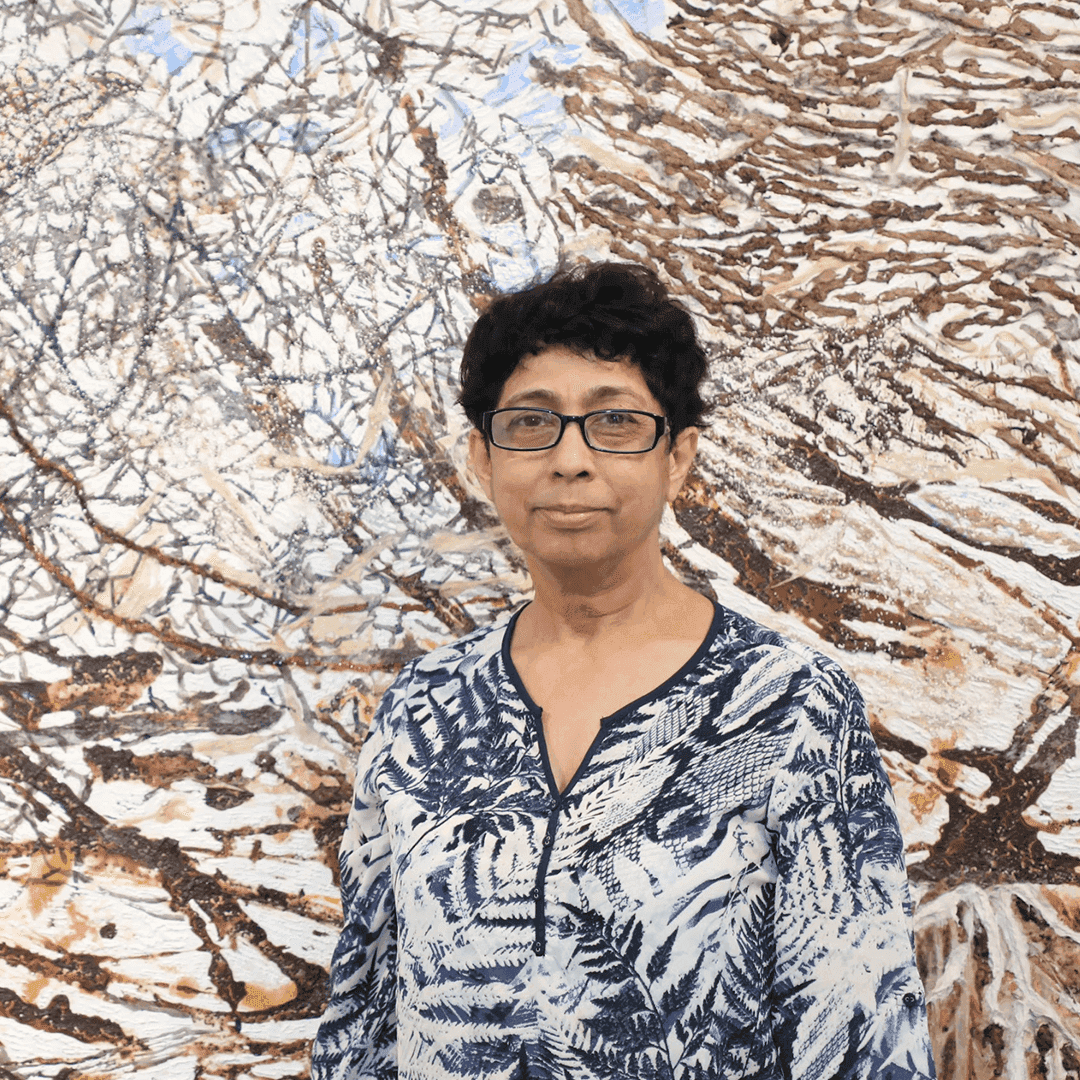
INTRODUCTION
Jayashree Chakravarty, born in the tranquil town of Khoai in Tripura in 1956, is an Indian visual artist currently based in Kolkata. She completed her Graduation at Visva Bharati in the sprawling natural environs of Santiniketan. She pursued her Master’s at the Faculty of Fine Arts at The Maharaja Sayajirao University, Baroda where she was exposed to an urban sensibility. Immersed in Kolkata's natural surroundings during her early years, Chakravarty finds inspiration for her skillful blend of nature in old and new cityscapes. She incorporates birds, broken windows and brick walls to preserve fragments of the vanishing natural world. Working primarily with paintings and large-scale paper installations while using mixed media, her creations reflect the themes of ecology and nature. Organic materials like grass, roots and leaves intertwine with paper, lending depth to her artistic expressions. Inventing her own creative techniques from organic material and varied kinds of papers, her installations in the form of paper-scrolls remain unique in their conception and execution. Employing superimposed forms akin to cave painters' preliminary sketches, her imagery embodies fluidity and transparency, mirroring the present world's mood. Beyond conventional representation, her works symbolise the harmony between humanity and nature. Chakravarty's paintings are vividly conceptual. In their execution, she has broken out of the traditional Bengal style of paintings and she even constructs paintings into sculptural forms. As an artist in residence at Aix-en-Provence from 1993-95, she was influenced in the formative years of her practice by the French movement Supports/Surfaces, especially by Claude Viallat. Chakravarty has had exhibitions both in India and abroad, with shows at various museums, including The Tagore Centre, Berlin, Germany; Chicago Cultural Center, Illinois, USA, Singapore Art Museum (SAM), Singapore; Musée Guimet, Paris, France; Asian Art Museum, San Francisco; Louvre Museum, Abu Dhabi and Kiran Nadar Museum of Art, Noida & New Delhi to name only a few.
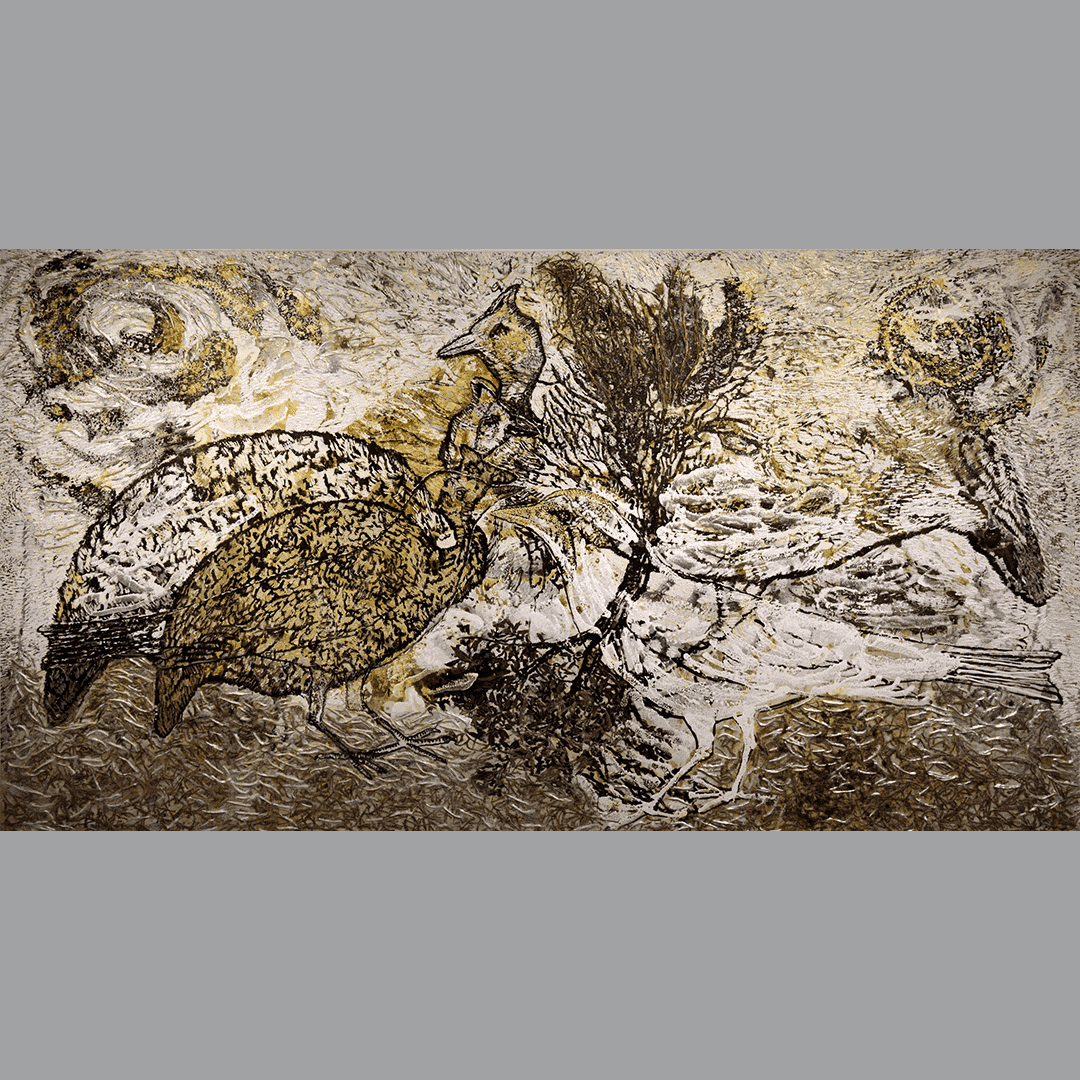
ABOUT THE ARTWORK
Nature Whispers, Medium: Oil, acrylic jute, leaf, cotton, paper on canvas, Dimensions: 193 x 348 cm, Year: 2018
“Nature Whispers” is a large-scale canvas with a composition of some extinct birds. It carries raw furrows of paint that the artist directly creates on the canvas with rare brilliance. The process is unpremeditated and messy, yet it captures the palpable connectedness of organic forms that gracefully come to life. Guided by dense yet translucent lines, these forms engender a captivating sense of perpetual movement. The oil canvas is inlaid with treated organic materials such as jute, leaves, twigs, shell, cotton, tea and coffee stains to add to their textural quality. Chakravarty's longing for the once-thriving greenery of her surroundings is palpable in her artwork which reflects a similar melancholic mood. The loss of fresh air, the presence of dust-covered leaves, and the disappearance of trees intensify the sense of sadness. Through the use of a subtle, yet harmoniously glowing earthy colour palette, Chakravarty adds depth and allure to her works. This choice of colours evokes the immersive experience of strolling through an untouched, sunlit forest. Chakravarty's incorporation of natural elements in her artwork is a personal endeavour to preserve and value nature which serves as a plea for coexistence in a world driven by urbanisation and economic growth, at the expense of the environment. Her densely filled canvas captivates viewers with its expressive imagery, and merges aerial and frontal views to challenge fixed perspectives. She finds fascination in the continuous linear patterns and formations, from roots to stems, textures to armatures, twigs to creepers which symbolises the interconnectedness of nature, embodying the concept of a "wired ecology."
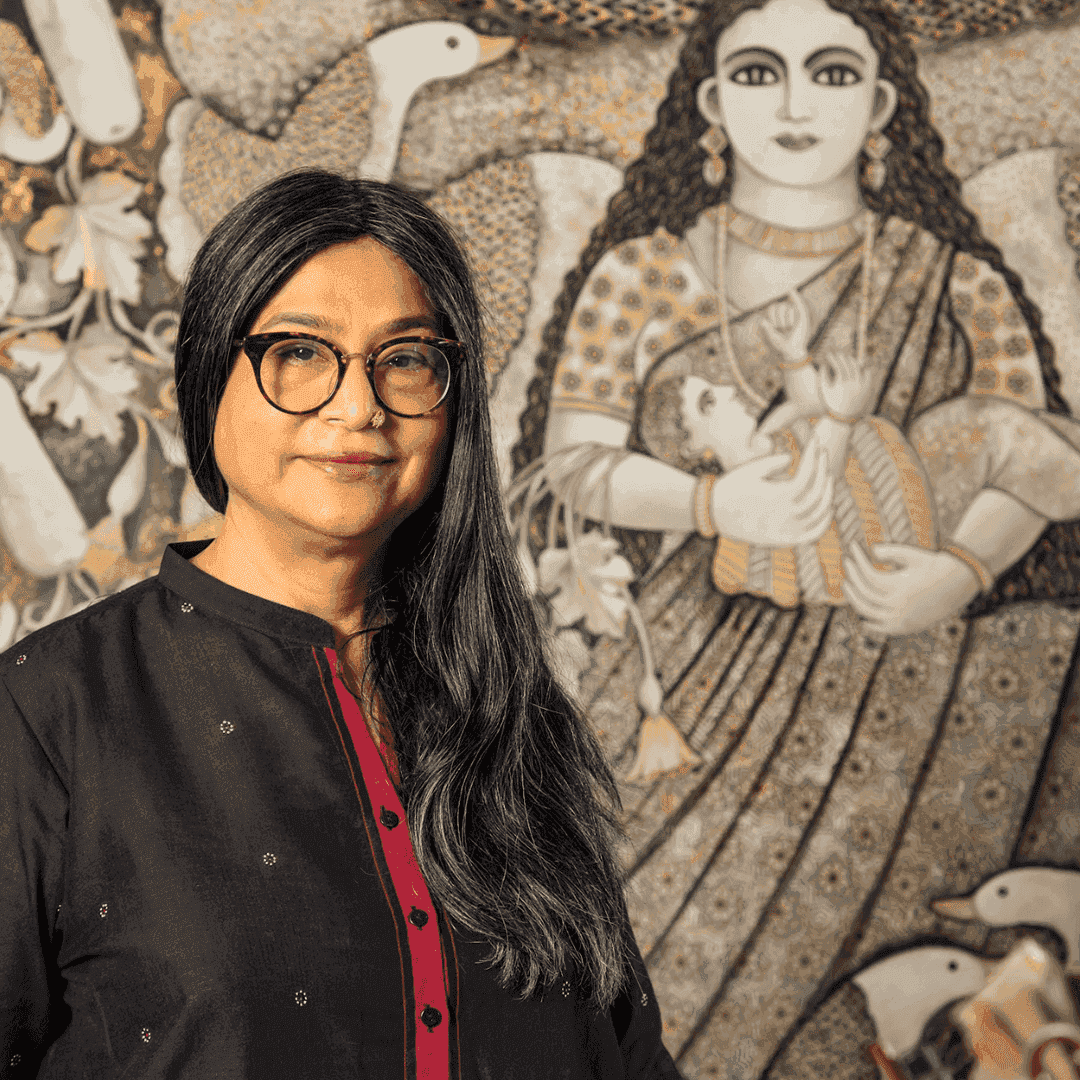
INTRODUCTION
Jayasri Burman, born in 1960 in Kolkata city, currently resides in Delhi. After receiving her initial training from Kala Bhawan, Shantiniketan, Burman further honed her skills by training under the French print-maker Monsieur Ceizerzi in Paris and attended graphic art workshops conducted by Paul Lingren in India. Burman is an Indian contemporary artist who actively engages in exploring rich cultural dialogues on nature, matrilineality, infancy, mythologies, spiritualism and the environment of her work. Burman's vibrant paintings are inspired by her cherished childhood memories, weaving together rituals, festivals and captivating impressions. Her diverse experiences have profoundly shaped her artistic expression, creating a transformative journey. Her medium ranges from flat-surfaces to 3-dimensional artworks. Ink, watercolour, oil, acrylic, charcoal, pencil on canvas and paper have all been important media for her. Her sculptures engage with details of materiality and varied techniques.
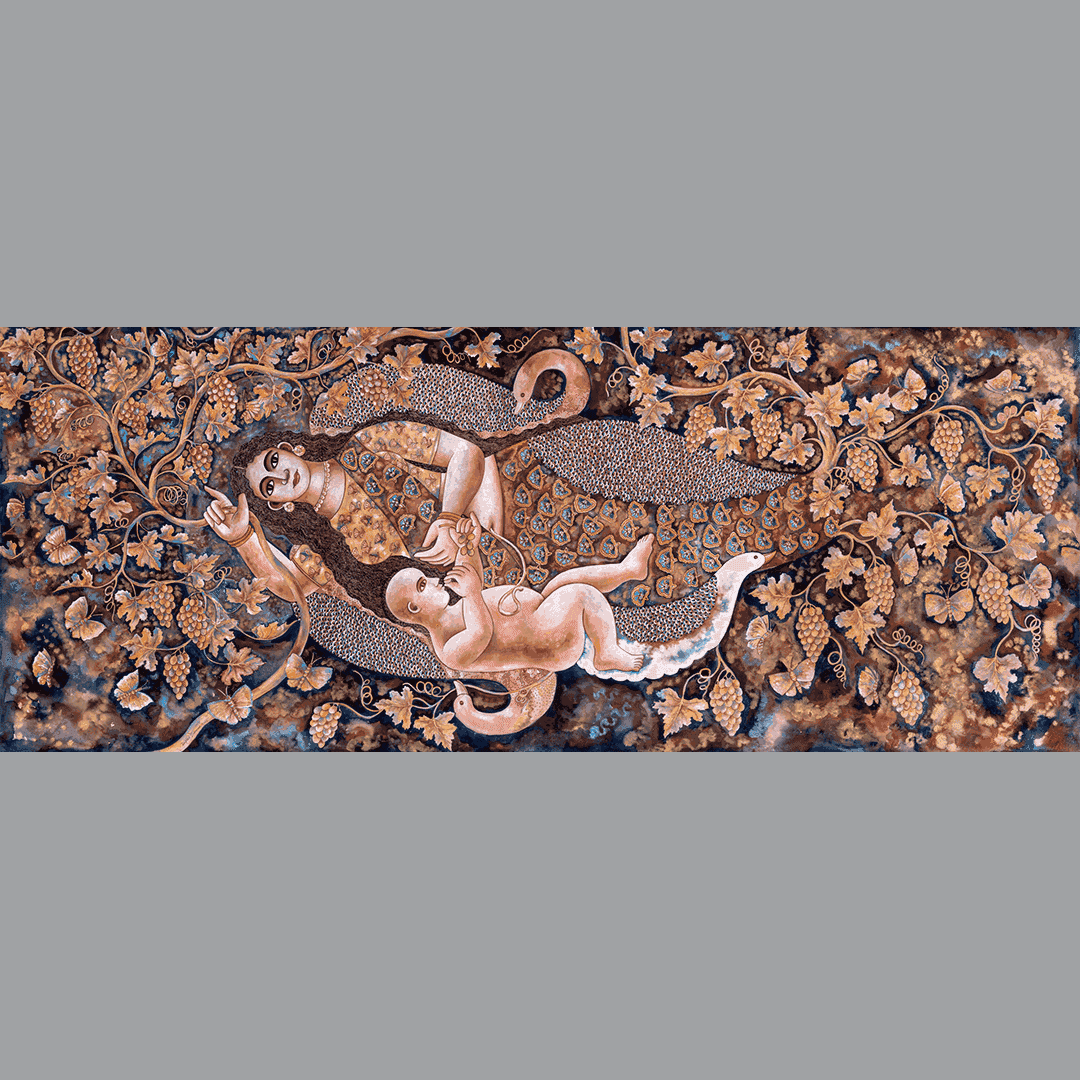
ABOUT THE ARTWORK
Prasav, Medium: Watercolour, ink, and pen on paper pasted on lucobond board, Dimensions: 122 x 305 cm, Year: 2022
Jayasri Burman's painting,“Prasav” beautifully portrays the nurturing bond between motherhood and infancy. The bejewelled woman metaphorically stands for nature and is shown merging into the rich background of the canvas. The baby by her side picks at the fruit in a blissful state. A sense of the miraculous lingers in the painting as a means to address the wonders our surroundings are capable of offering. Simultaneously, motherhood is projected as a role equivalent to nature, emphasising the power of creation and nurturing. Burman's artwork eloquently embodies the beauty of creation and the ideal state of new beginnings. The presence of foliage, fruit-laden stalks and the seamless integration of two figures with nature signify her deep connection to mythology and intimacy. The painting poses as a means to build bridges between time and practice where the source of life is a form of “bonding” that would cater to cultural methods of nourishment. Nature revives nature and art is an essential intervention on the impelling nutriment as it is capable of revival. Therefore, “Vasudhaiva Kutumbakam” is the central theme of this work. Simultaneously, the painting reflects upon the Earth's remarkable ability to heal, sustain life and navigate through crises. It serves as a visual messenger for important social causes that aim to restore balance and harmony.
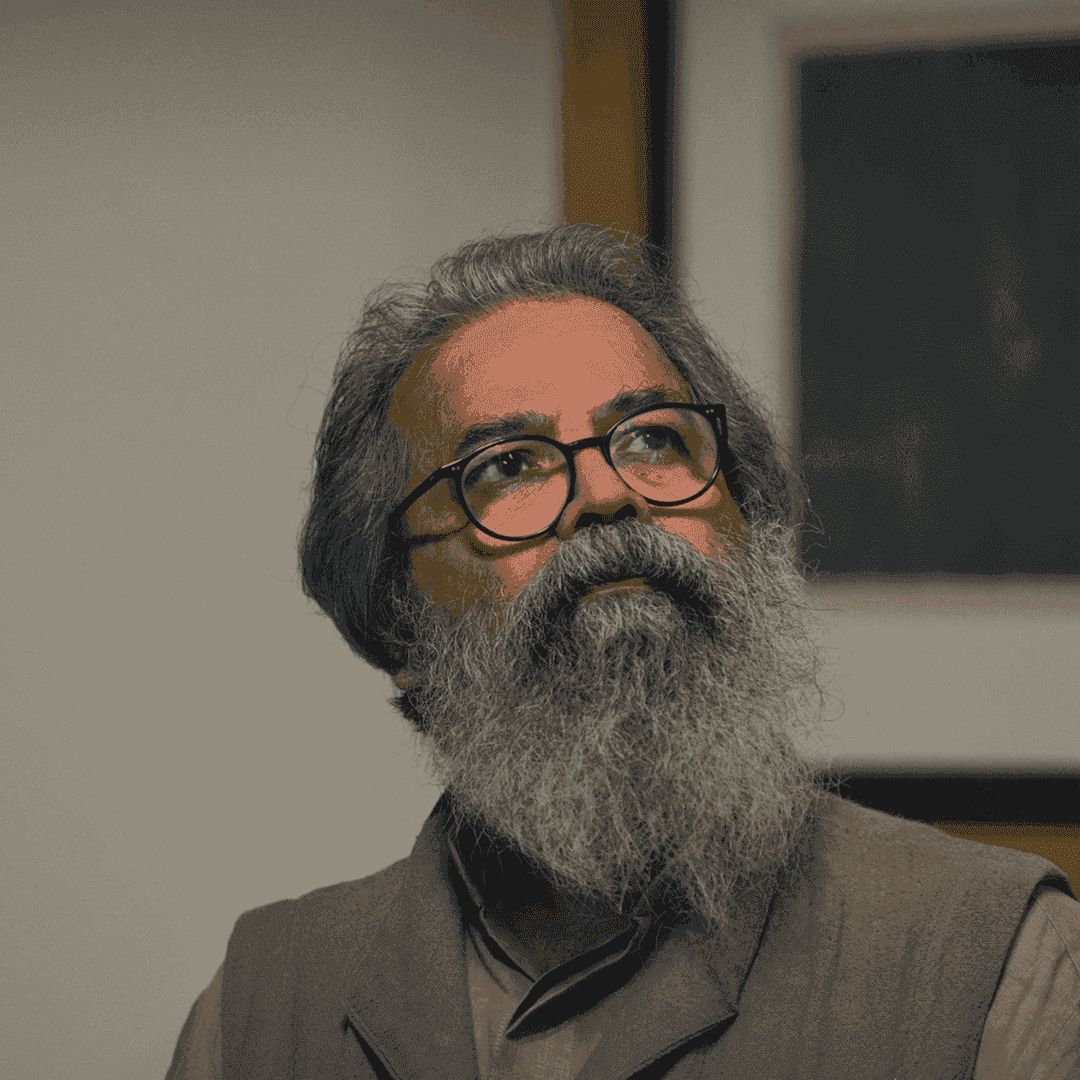
INTRODUCTION
KS Radhakrishnan, born in 1956 in Kerala is trained in sculpture at Santiniketan. He belongs to a small group of notable sculptors of his generation who have collectively brought about a far-reaching resurgence in Modern Indian sculpture. Like his mentors, Radhakrishnan is primarily a modeller who works in clay and makes his work permanent in bronze, and the human figure is his main subject. Since 1996 he has been working with two, part real and part imaginary, characters called Musui and Maiya. He uses them, on the one hand, to explore the physical and social world around us and to speculate on the nature of its reality, and on the other, to explore the possibilities of the human body and the potentialities of sculpture itself.
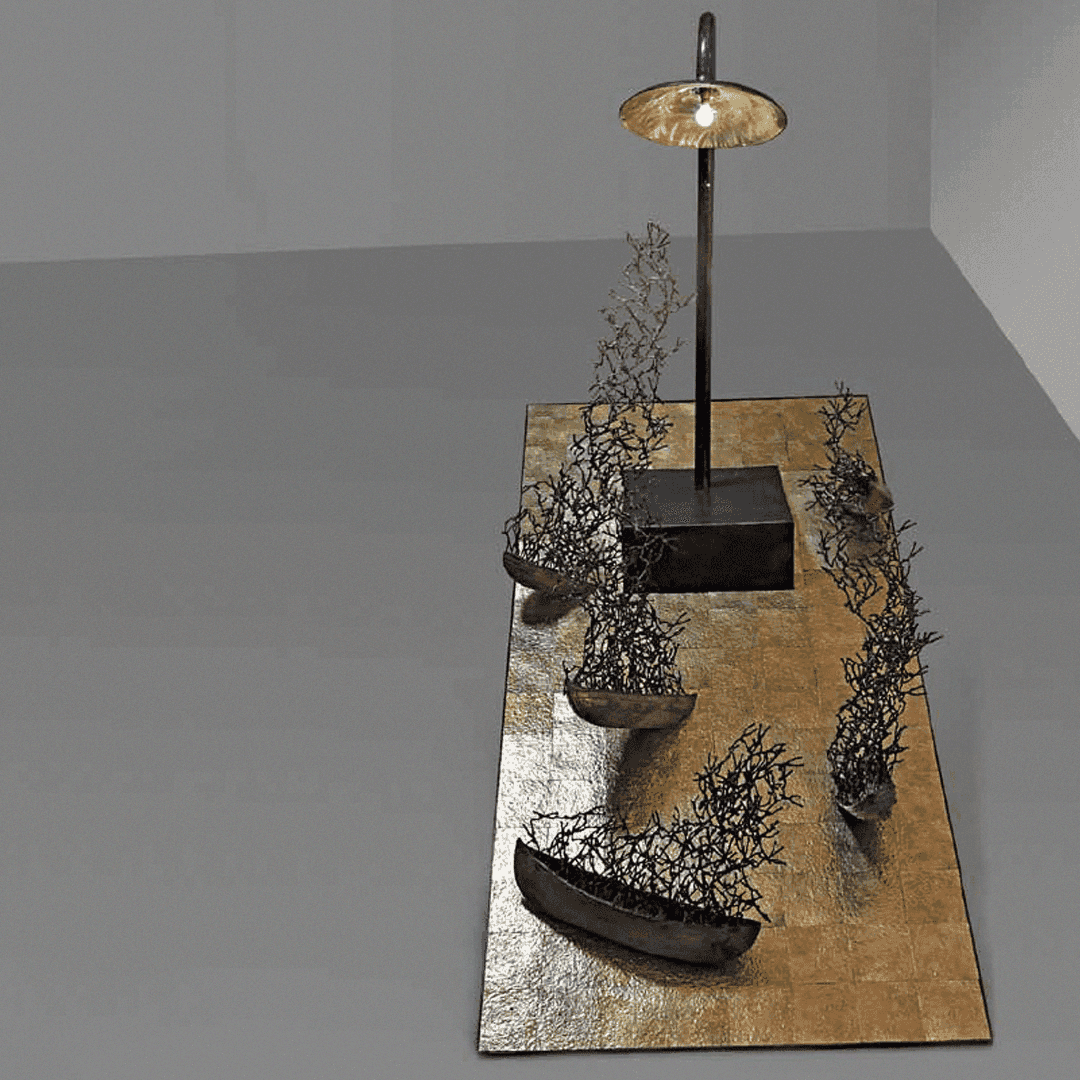
ABOUT THE ARTWORK
Ephemera, Medium: Bronze, Dimensions: 243.8 x 243.8 x 122 cm, Year: 2018
“Ephemera” captures the essence of our present times, marked by the widespread phenomenon of global migration and its impact on displaced individuals. The sculpture features partially submerged boats, serving as symbols of the challenges and hardships faced by these migrants. Their determined journey is depicted as they strive towards a bright yellow lamp affixed to a dark pole, metaphorically representing hope and a symbolic representation of a welcoming and stable land.
At the crest of waves in a turbulent sea, the scene unfolds to boats being tossed up and down, carrying within them tiny human figures with interlocking limbs that spiral outwards, transcending the boundaries of the boats themselves. They bear a striking resemblance to the ephemeral moths of the monsoon season, rising like foam, their movements marked by a profound sense of helplessness.
In his distinctive style, Radhakrishnan utilises the ascending ramp form to metaphorically represent the ocean's surface, stripped of its undulating waves. The bronze tiles, gleaming with a smooth flatness, come together to create an ensemble of waves, while the half boats symbolise their rise and fall amidst the tumultuous tides. A believer in the transcendence of human beings, he often uses the ramp structure to depict the potential for liberation. Radhakrishnan artfully intertwines the well-known narrative of despair with an intriguing sense of empathy. This compassionate glance, though fleeting, provides a moment in art where the marginalised masses and the viewers come together to celebrate solidarity and hope.
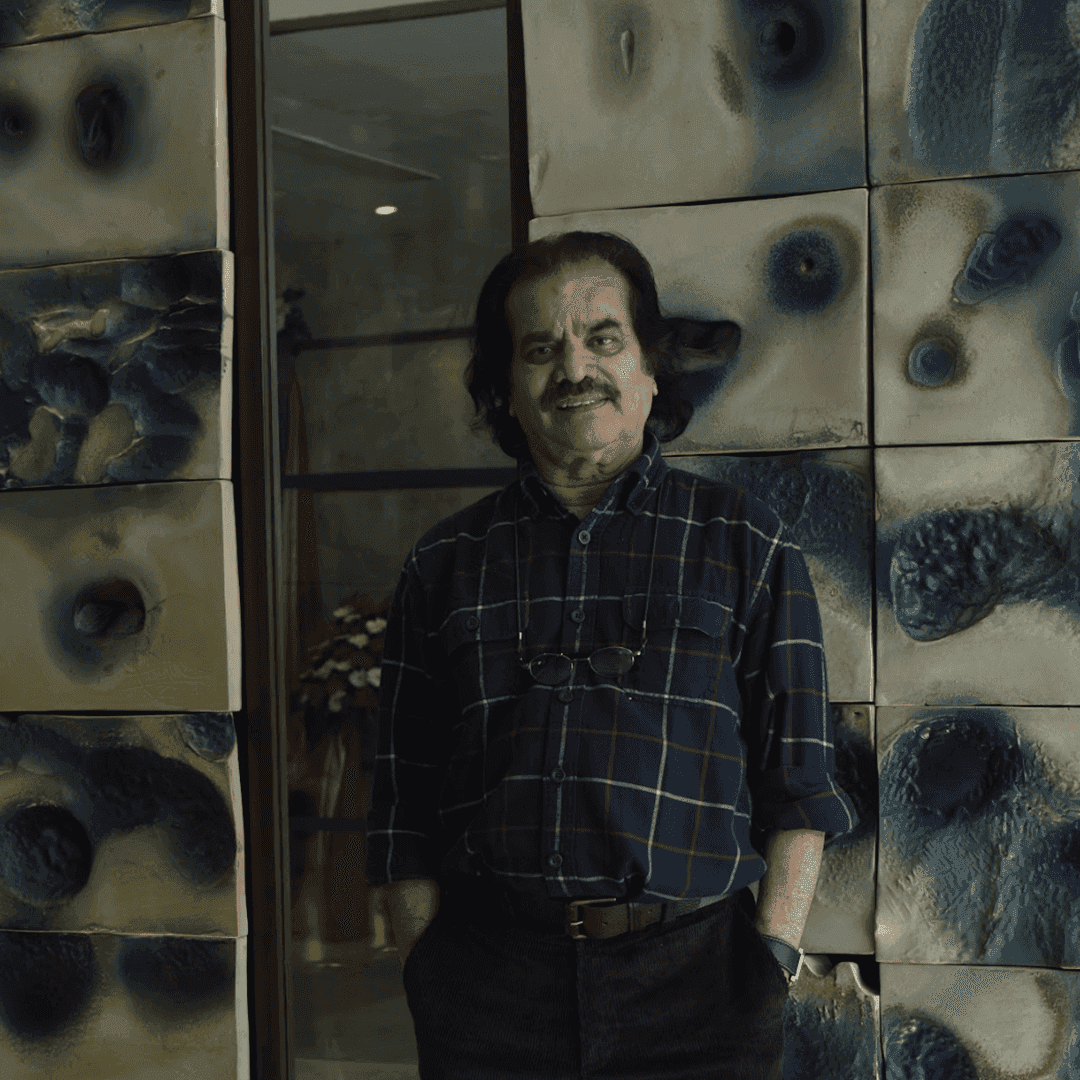
INTRODUCTION
P. R. Daroz, born in Hyderabad in 1944, is a graduate of the College of Fine Arts and Architecture, Hyderabad. He specialised in ceramics from the Faculty of Fine Arts, MS University Baroda. Ceramics has recently entered into the firmament of Indian art from craft traditions and Daroz is a leading ceramics artist who has been ceaselessly working at these creations during the 50 years of his career. Recognized for his bold, impressive and inventive techniques, Daroz's extensive body of work encompasses a wide range of media, including pots, sculptures and architectural installations. Through his ceramic creations, Daroz addresses and dramatises the inherent tension between form and function. He skillfully employs the materiality of clay and showcases his mastery of this technique. Daroz draws constant inspiration from his surroundings, particularly the landscapes and the stones that shape them. By closely observing the repetitive processes of nature, he discovers valuable insights and knowledge that fuel his artistic endeavours. Daroz has received the esteemed National Academy Award from the Lalit Kala Academy in Delhi. Additionally, he has been recognized as an elected member of the prestigious International Academy of Ceramics in Geneva. He has held over 17 solo exhibitions in India, and represented India in the 4th World Ceramic Biennale, Korea, the 2nd Beijing Art Triennial, China and the 3rd World Ceramic Triennial, Zagreb. He has participated in many international artists’ workshops and camps in diverse countries. Daroz's architectural ceramic commissions are highly sought after in private residences and public spaces across India. Notable works include the Kirloskar portrait at the SLK office, Bengaluru, and the Lohia Bhavan facade mural at Nelson Mandela Marg, New Delhi, installed in 2018 and 2016, respectively. Pundole Art Gallery has recently published a book on the life and works of P R Daroz titled “Fire in the Soul.”
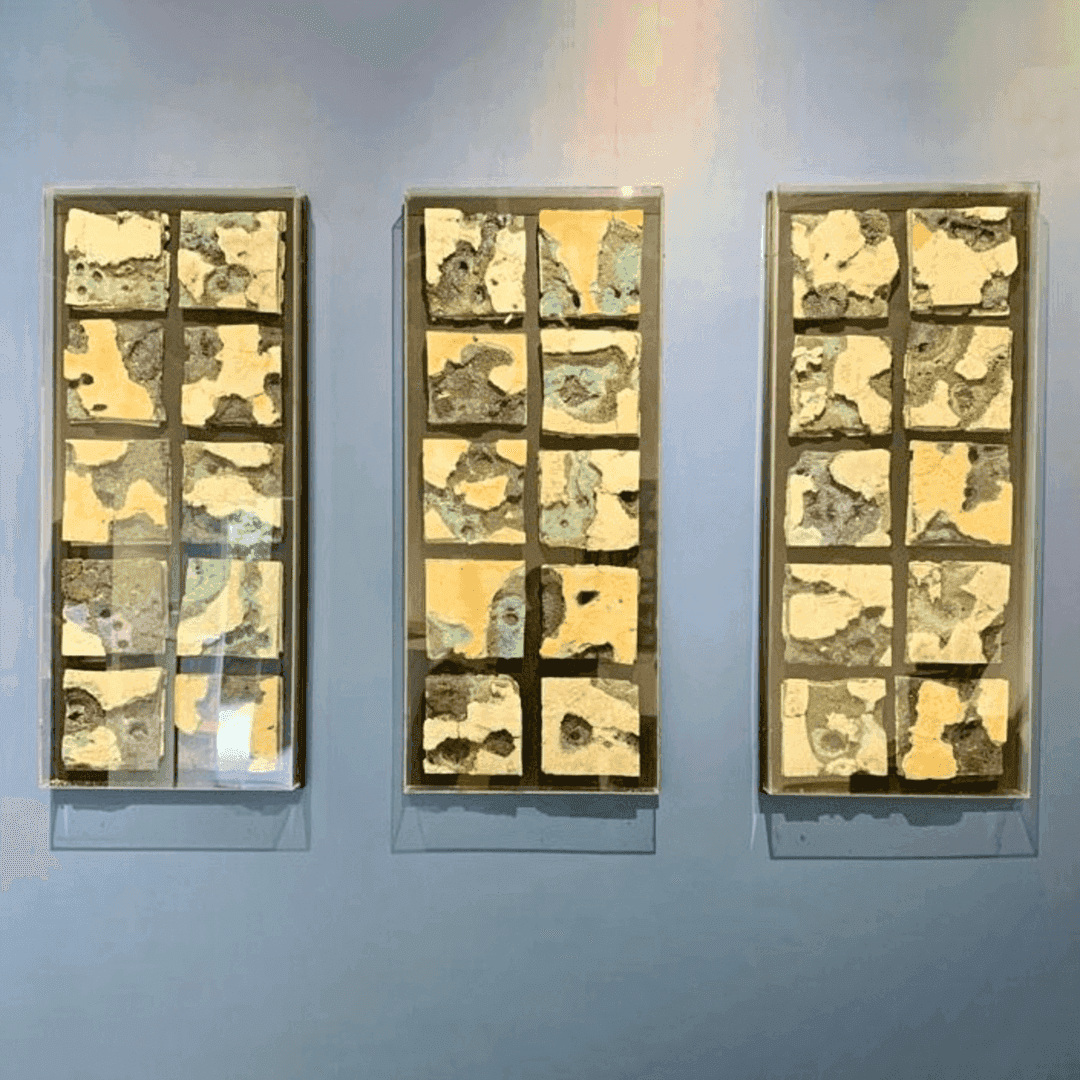
ABOUT THE ARTWORK
Sea - Bed, Medium: Ceramic, Dimensions: 119.4 x 152.4 x 10.2 cm, Year: 2022
P.R. Daroz's artwork "The Sea Bed" is a reminder of the Anthropocene, the current epoch in which human activity has significantly altered the Earth. The work evokes the beauty and fragility of coral reefs which are the rainforests of the oceans. Daroz draws the viewer into his creation through the senses of sight and touch, inviting us to experience the devastating effects of climate change on these vital ecosystems. Daroz invites them to experience the beauty of these vulnerable landscapes and seascapes, through their devastation, in order to inspire people who will protect and preserve them. Nature appears as neither an idyllic alternative to everyday human experience, nor as a site to be controlled and exploited. Daroz's interest in marine surfaces is evident in his abstract work which is textured with crevices and other details. These suggest that the underwater surfaces are full of life with various plants and animals lying between saline rocky crevices in low tide pools. Daroz’s choice of sculptural medium is the stuff of earth itself - clay, an integral part of our shared cultural history and human identity. With powerful use of light and shade, he further manipulates textural contrasts between rough and smooth surfaces, interplaying high and low relief, and completely modelling some forms while leaving others in an almost painterly state of incompleteness. Daroz's appreciation for the delicacy of ceramics and its translucency is evident in his work. His ceramic artwork celebrates and laments a mode of existence that would serve well in magical rituals meant to establish ties between humans and other life-forms. It may point towards a way of being beyond this age we now live in.

INTRODUCTION
Paresh Maity was born in 1965, in the historical town of Tamluk, near Kolkata. He received his Bachelor’s Degree in Fine Arts from the esteemed Government College of Arts and Crafts, Kolkata, followed by a Master’s Degree in Fine Arts from the College of Art, New Delhi. A renowned artist and a brilliant water colourist, Maity's expertise lies in the expanse of scale in his works - from small watercolours on paper to monumental sculptures. Maity is a multimedia, contemporary artist and nature stands as the foremost inspiration in his artistic endeavours. It has remained a constant source of inspiration throughout his life. Enamoured by the magic of light, Maity is immersed in the exploration and understanding of its qualities. He recognizes that colour serves as a medium to convey the essence of light, transcending its mere physical manifestation. Influenced by renowned Western artists like Rembrandt, Turner, Homer, as well as the impressionists and Picasso's cubist period, his fascination with nature takes precedence above all else. Maity believes in capturing the essence of the moment and strives to work directly from nature whenever feasible. His fresh and vibrant artworks, whether on paper, canvas, or any other medium, revitalises us. He evokes the luminosity of Japanese washes and infuses us with renewed energy. With a skilled mastery of scale, Maity navigates the pictorial space, effortlessly blending the delicate perspective of a miniaturist with the grandeur of a muralist. In almost four decades, Maity has held 88 solo exhibitions and his diverse body of work has gained international acclaim in galleries, museums and art fairs. Notably, in 2010, Maity accomplished a remarkable feat by creating an approximately 850-foot mural, one of the world's longest paintings, for the International Terminal at Indira Gandhi International Airport in New Delhi. His art has been collected by numerous private collectors across the world and is also present in public collections of the esteemed institutions such as the Rashtrapati Bhawan New Delhi, the British Museum, London, the Rubin Museum of Art, New York, National Gallery of Modern Art, New Delhi and the Oberoi Group of Hotels, among many others. He has received recognition from prestigious institutions like the Royal Watercolour Society, the All India Fine Arts and Crafts Society, and the British Council. He is also the recipient of the Padma Shri award, one of India's highest civilian honours.
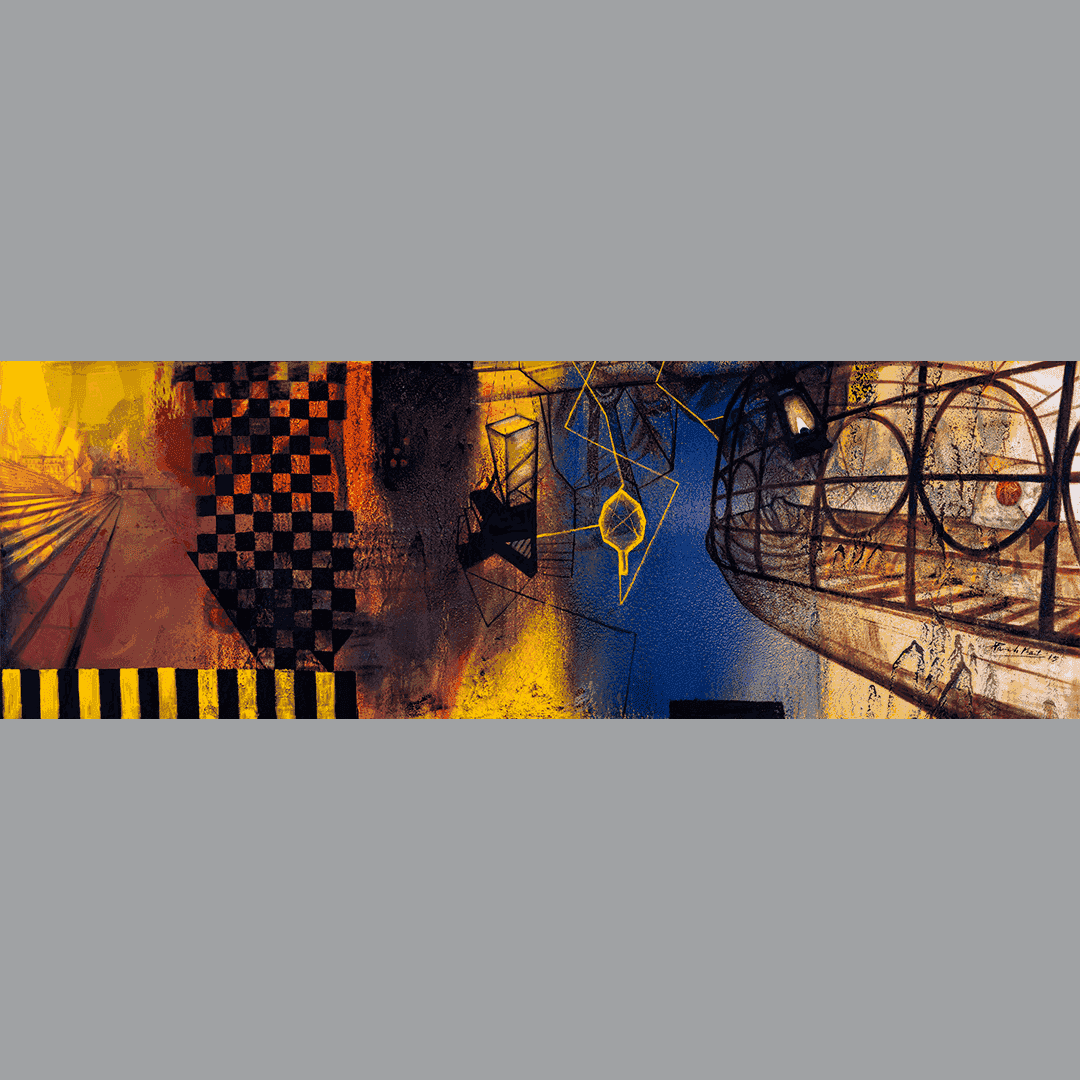
ABOUT THE ARTWORK
Light of Faith, Medium: Mixed- media on canvas, Dimensions: 152.4 x 457.2 cm, Year: 2015
“Light of Faith” by Paresh Maity is symbolic of the unity of India, its togetherness and the myriad colours of its cultures, bound by the idea of “Vasudhaiva Kutumbakam.” His canvas is dominated by varied motifs that signify the diversity of India. The painting is rendered in hues of red, yellow, blue, with some brown tones symbolising the diverse cultures, languages, and individual contributions that have created the vibrant fabric of the nation. The artist skillfully captures the essence of unity by seamlessly blending these colours while creating a sense of cohesion within the composition. Through its visual language, the painting conveys a powerful message of global oneness and unity in all aspects. In this captivating artwork the viewers are transported into a realm of artistic excellence, evoking a sense of wonder through its scale and imagery. The artwork commands sustained attention, inviting the observers to explore its intricacies further. Maity's deep fascination with the transformative power of light is evident in his skillful portrayal, a shaping force in his compositions. Within Maity's artistic process, impulse is inherent, driving him to express his inner essence. His artwork reveals a captivating interplay of light and shade, nurturing inner peace. Rooted in his profound spirituality, his skillful brushwork merges and transforms colours, creating gradients that evoke a tangible experience rather than just visual observation.

INTRODUCTION
Raghu Rai, born in 1942 in Jhang, Punjab, is amongst the early pioneers of photo-journalism in India and currently resides in New Delhi. With a background in civil engineering, Rai embarked on his path as a photographer under the guidance of his elder brother, Sharampal Chowdhry, better known as S. Paul who was an accomplished photographer himself. Rai’s journey began when he became the chief photographer of Statesman in 1966. His remarkable photography exhibit in Paris during 1971 garnered major attention that made Henri Cartier-Bresson nominate him for Magnum Photos. From 1982 to 1991, Rai’s picture essays of the decade were centered around the themes of social, political and cultural elements of India. His works have been displayed in London, Paris, New York, Hamburg, Prague, Tokyo, Zurich and Sydney, and he has received many national and international awards for them. Rai's photography captures the essence of life with an intuitive, honest and bold approach that goes beyond technicalities. He prefers off-centre compositions, prioritising the essence of action over symmetrical frames. Rai values the power of silence and aims to preserve it through his art. Throughout his career, he has showcased a preference for the intensity and depth of black and white photography which allows him to delve into India's rich tapestry of ancient culture, modernity, chaos and simplicity. His lens immortalises both ordinary moments and renowned icons, reflecting the diverse and captivating essence of the country through portraits of Indira Gandhi, Mother Teresa, Satyajit Ray, and various musicians and dancers. He is renowned for his impactful coverage of significant socio-political events, such as the 1984 Bhopal Gas Tragedy and the brutalities in Bangladesh in 1971. He received the prestigious Padmashree award in 1972 for his work on the Bangladesh refugees and war. In a historic achievement, he became the first to receive the esteemed Academie des Beaux Arts Photography Award in 2019. Furthermore, he established the Raghu Rai Center for Photography in 2012.
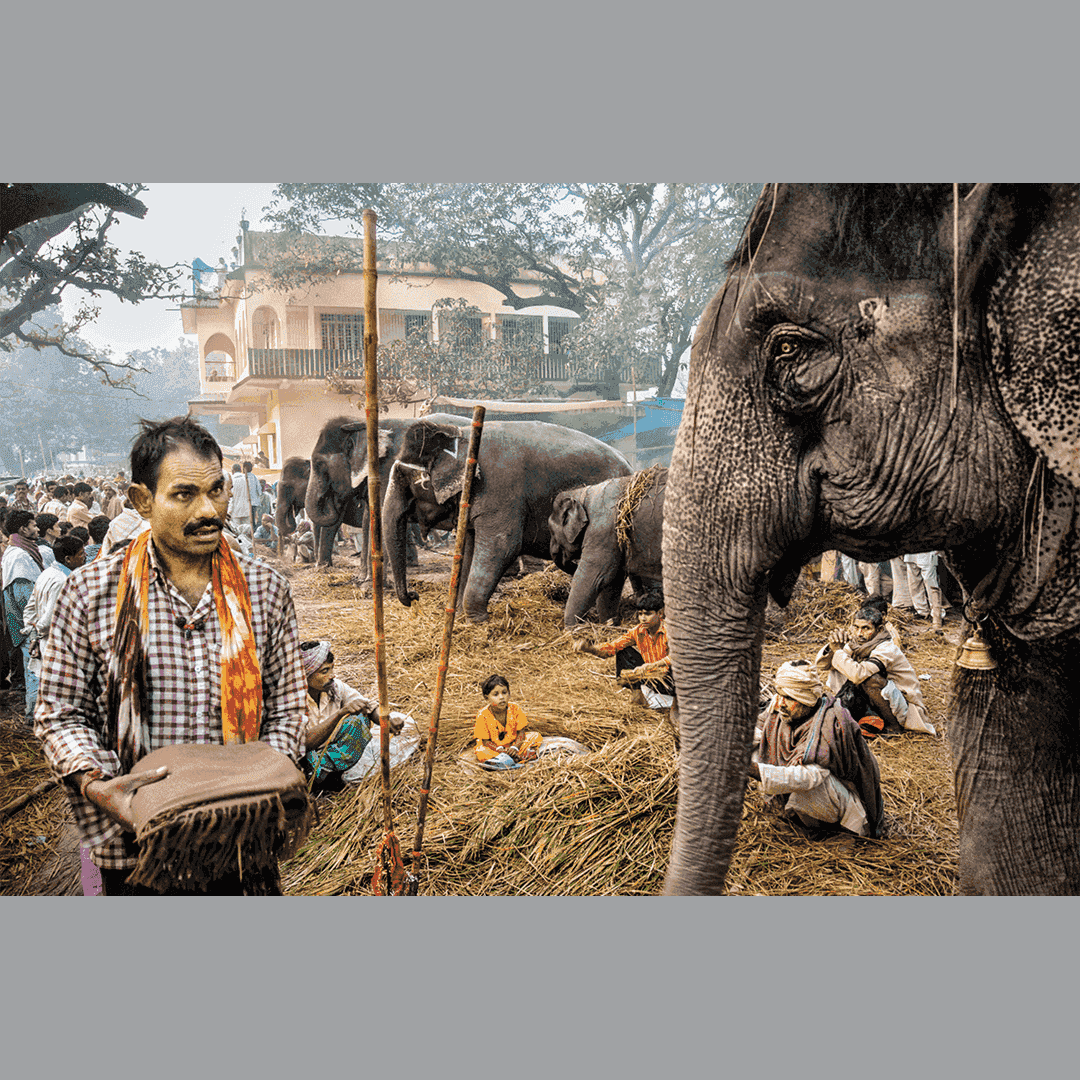
ABOUT THE ARTWORK
Sonepur Mela, Bihar, Medium: Photograph, Dimensions: 50.8 x 76.2 cm on 61 x 86.4 cm paper, Year: 2008
Raghu Rai presents “Sonepur Mela, Bihar,” in a captivating photograph that unveils the mysteries and surprises hidden within the state of Bihar, India. With a focus on Sonepur, a town situated on the banks of the Gandak and Ganges rivers, Rai sets out to capture the essence of this region. His lens is drawn particularly to the famed Haathi Bazaar (Elephant Market), where a remarkable number of elephants are traded. Simultaneously, Rai explores the profound connection between humans and animals as he reveals the essence of Sonepur and its extraordinary cultural landscape.
The narrative begins on “Kartik Poornima,” the auspicious full-moon day in November when the fair commences. Despite predictions from others along the way that things have changed and might not live up to past experiences, Rai's expectations remain high as he embarks on this journey. The allure of creative exploration lies in expecting the unexpected, and the ticklish feeling of anticipation continues to pull him forward to embrace the unknown. As the afternoon sun casts a warm glow, Rai ventures into the area reserved for the majestic elephants. The sight is awe-inspiring, and he slows his pace, keen to observe. “Mahouts,” the caretakers of the elephants, are engrossed in settling their gentle giants for the evening. Amidst this scene, Rai's attention is captured by a particular “mahout” engaged in an intimate conversation with his elephant. The elephant's eyes are fixed on his master, seemingly comprehending every word spoken. Rai is moved by the profound connection displayed between them. It becomes evident that the communication between a master and his animal, be it an elephant or a calf or a fully-grown tiger, holds immeasurable significance in its upbringing. The touching experience of witnessing this unique bond leaves a lasting impression.
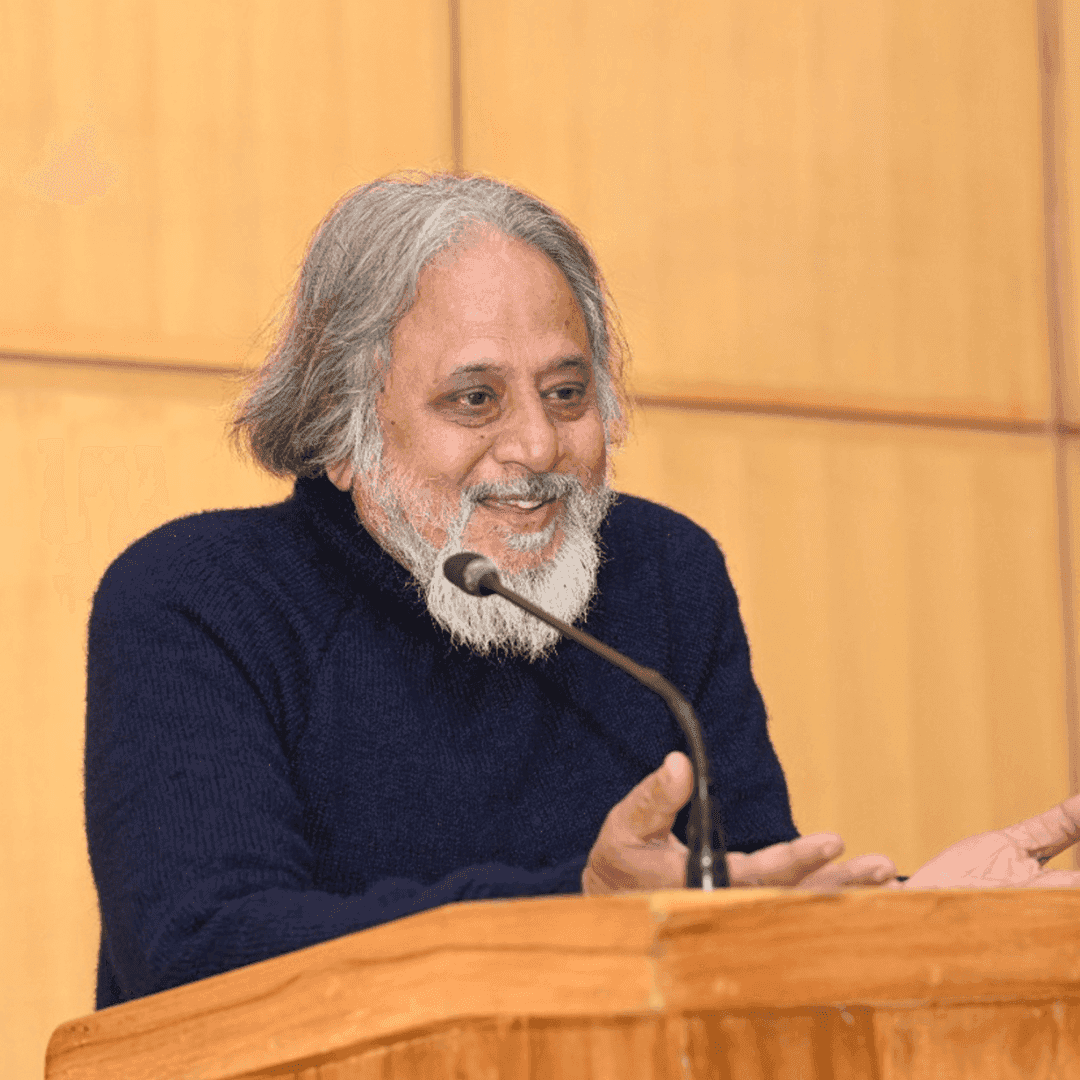
INTRODUCTION
Rajat Ghosh, born in 1956, lives and works in Patna, Bihar. He completed his formal education from Arts and Crafts College, Patna. His artistic journey spans over four decades and his primary preoccupation is with sculptures. Drawing inspiration especially from the rich culture of Bihar and Bengal, Ghosh incorporates customs, myths, folk tales and folk heroes into his sculptures. His diverse range of creations includes popular characters like Alha-Udal, Hiriya Khiriya, as well as historical figures including the modern poet from Bihar Vidyapati and singer, Tansen from the medieval Mughal court of Akbar. Rabindranath Tagore, and the freedom fighter, Kuwar Singh are also represented in his work. A deep understanding of his subjects reflects in Ghosh's sculptures which emanate from simple and spontaneous expressions. Whether capturing human faces, mother-child relationships, or Hindu gods and goddesses, his artworks resonate with a profound sense of humanity. Ghosh's creative style showcases perfect skill and embraces the essence of Indian sculpture which sometimes recalls the classical tradition, and at other times reflects the playful clay figures crafted by children. The allure of his terracotta idols remains strong, as they continue to captivate with their simplicity, affordability and deep- rooted connection to Indian festivals and customs.
His oeuvre is an act of preserving and perpetuating the history and cultural traditions of specific eras through sculptural practice. He highlights the profound impact that visual art has on various aspects of life, society and the nation as a whole. Ghosh's artistic influence extends well beyond Bihar, with his artworks receiving acclaim in India and abroad. His works have been showcased in exhibitions across India, including Asian Art Vinale, Bodh Gaya Vinale, Bihar Museum Patna, and at various art museums worldwide. His artworks are displayed at prominent locations such as Reserve Bank of India and Sanjay Gandhi Biological Park, Patna have garnered significant acclaim and attention. In 1984, he was granted a research scholarship by Lalit Kala Akademi, Delhi which allowed him to conduct an in-depth study on the folklore heroes of Bihar. His remarkable talent earned him the National Award in 1985, and the Government of Bihar honored him with a Lifetime Achievement Award in 2019-20.
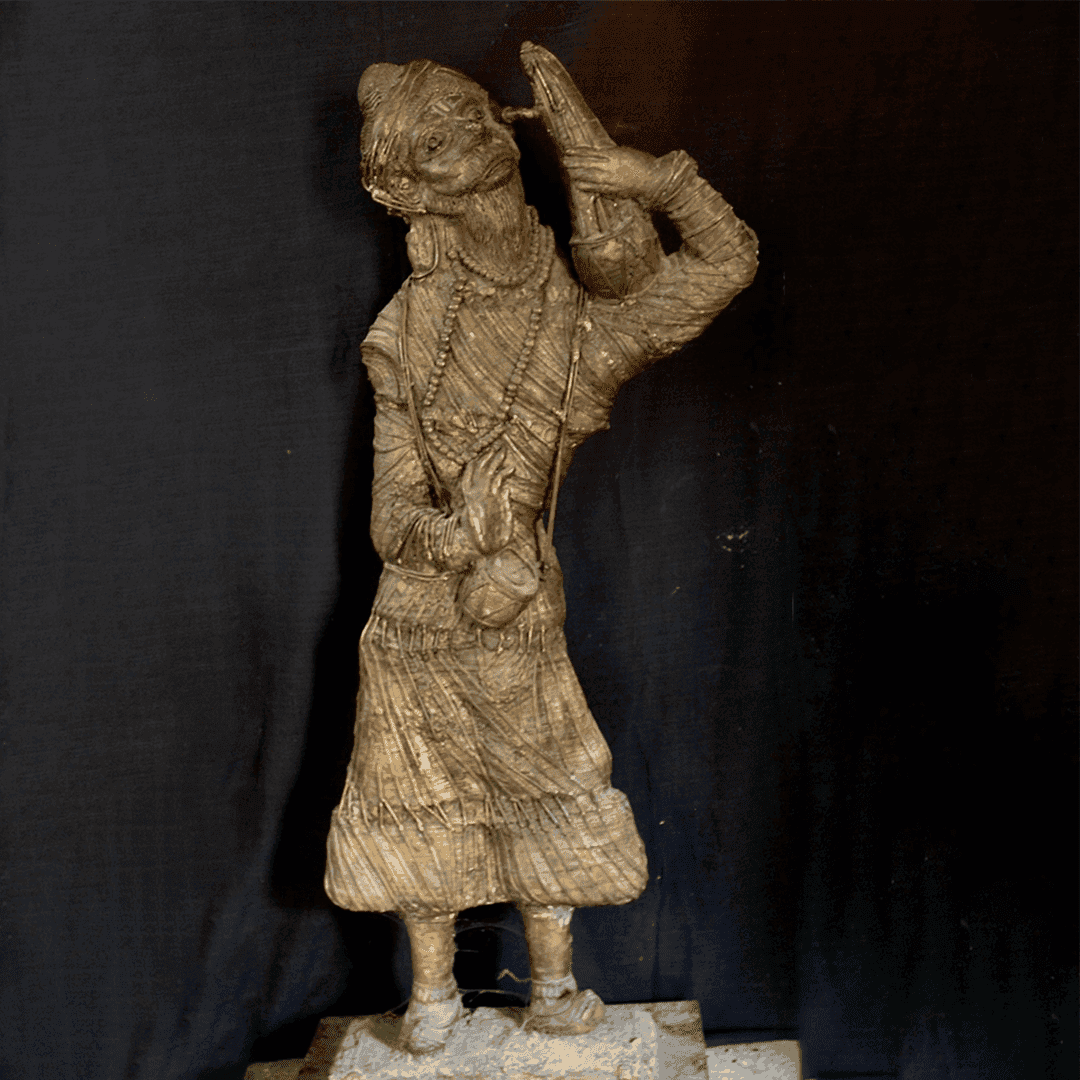
ABOUT THE ARTWORK
Baual, Medium: Bronze, Dimensions: 115 x 48 x 31 cm, Year: 2004
Rajat Ghosh’s bronze sculpture ‘Baual’ derives inspiration from the tradition of Baul singers who wander from place to place, with no fixed home of their own and the minimal number of belongings. They sing self-composed folk songs originating from the soils of undivided Bengal (now a part of Bangladesh, too) and these are often devotional hymns that express an intense connection to God. After being deeply moved by his visit to the temporary home of Purna Das Baul in Ballygunge, Kolkata, Ghosh felt compelled to embark on the creation of the Baul series. This series consists of about 50 terracotta sculptures that revolve around the profound themes of Baul music. He also crafted a metal idol that encapsulates the essence of Baul songs, especially as the singers dance while they sing. He showcases various associated “mudras” (hand gestures) in his work. This sculpture embodies the timeless quality and cultural significance of Baul. It aptly captures the transformative power of spiritual music, embodied by the rhythmic figure holding a single-stringed, musical instrument called the “ektara.” The sculpture beautifully reflects a close connection to the craft of idol-making, and its artistic freedom echoes the freedom of the Baul singers. The flowing drapery of the sculpture creates harmony and enchantment.
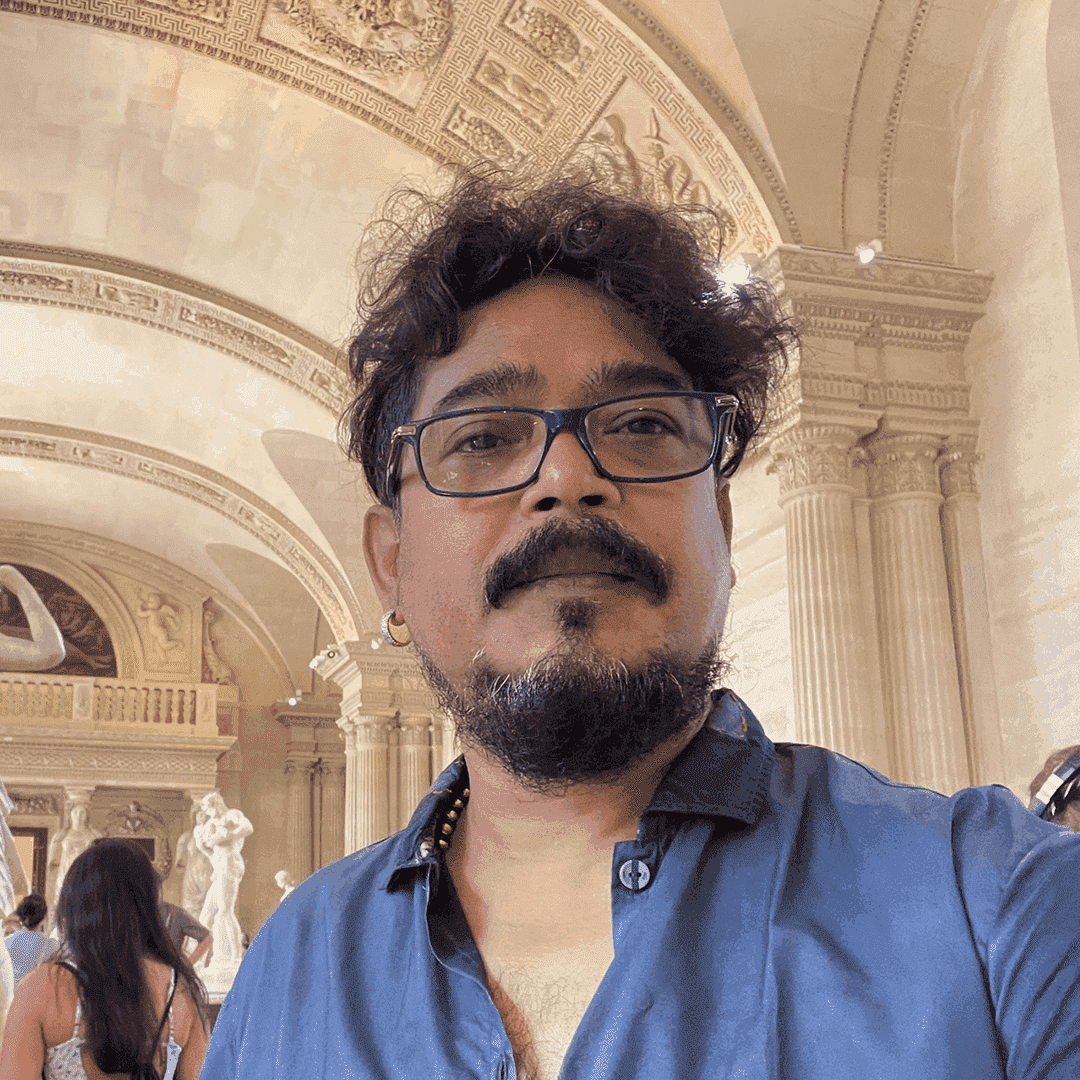
INTRODUCTION
Sanatan Dinda, born in 1971 in Kolkata, holds a first-class Bachelor of Visual Arts degree from the Govt. College of Arts & Crafts in Kolkata and currently works from his studio in the city. Dinda, a multi-disciplinary artist, is renowned for his painting, drawing, sculptures, mural making and installations. In his artistic beginnings, he captured the essence of spirituality. However, as his journey as an artist unfolded, his world evolved. Through his imagery, he now explores diverse phases of relationships between men and women, and how we politicise female bodies. From gender politics to poverty, these subjects began to resonate with him during his formative years. Refined details of his childhood memoirs were engraved with charcoal and he started to narrate them under the wrap drama which helped him to understand socio-political equations. Contemporary politics shook him at times and his rage was reflected in his installations and drawings. When he started his journey as a politically active artist, his artworks helped him to raise questions about society and its contemporary culture. Dinda's artistic expression engages in a dialogue between tradition and modernity. The artist's objective consistently revolves around capturing the intricate nuances of Indian culture through his paintings. With bold lines and vibrant themes, his oeuvre illuminates the often overlooked rustic daily life of ordinary individuals as he seeks to authentically portray the essence of rural Indian existence. Dinda's artistic journey is marked by numerous solo exhibitions such as "Survival," 1996 and "Of Human Comedy," 1998 at the Academy of Fine Arts in Kolkata. His works have also been showcased at prestigious art galleries like Jehangir Art Gallery in Mumbai. Dinda actively participates in workshops and group shows, both in India and abroad. His art has been featured in exhibitions such as "Post Modern Eye" in Germany and Singapore, as well as "East-West" organized by the International Young Artist Organisation in Kolkata. He has received recognition for his talent, including the Creative Painting award from Birla Academy, Kolkata. Dinda's artworks have found their place in the prestigious collections of Buckingham Palace, London and Sachin Tendulkar's home, among others.
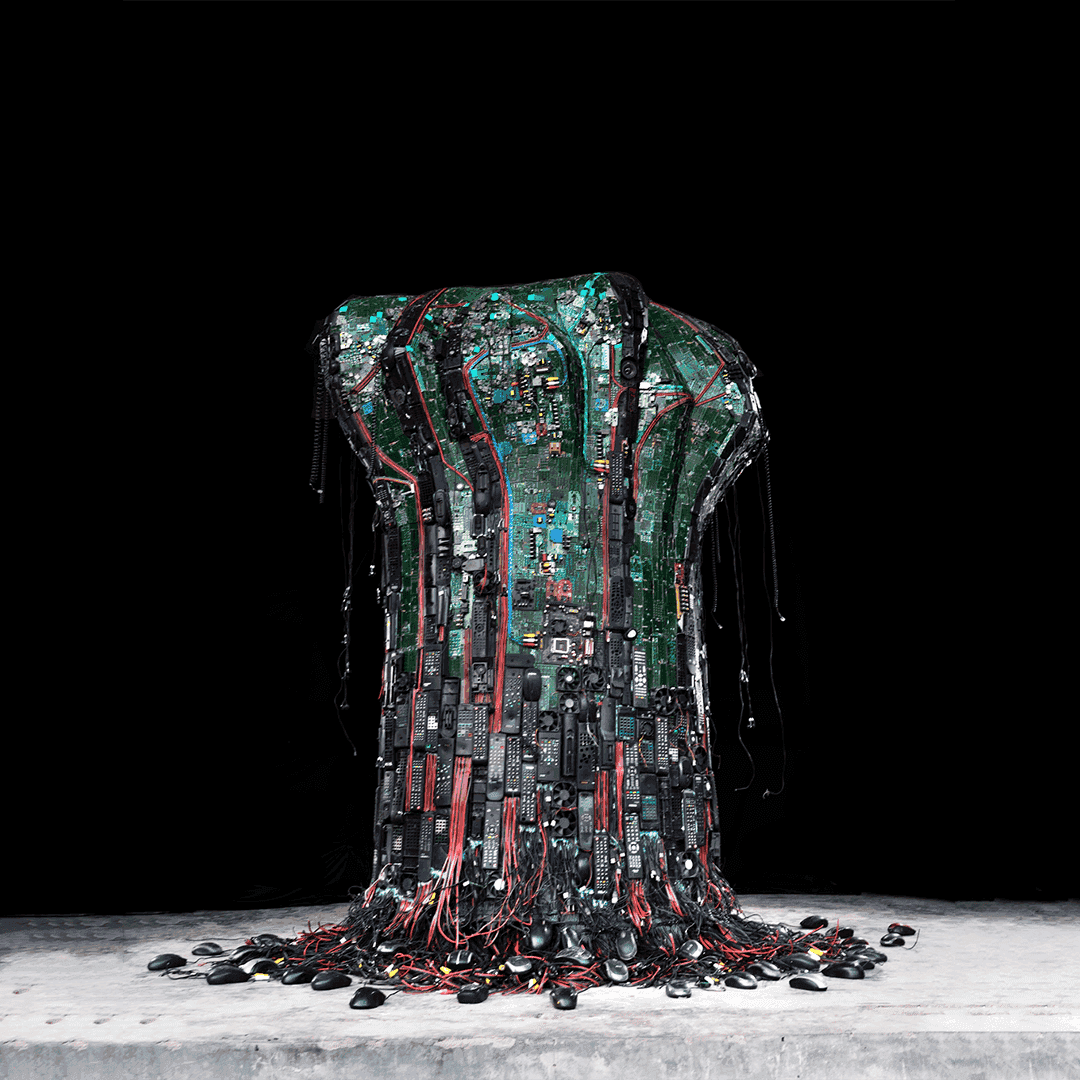
ABOUT THE ARTWORK
Bodhi Tree, Medium: E-waste, Dimensions: 226 x 167.6 x 81.2 cm, Year: 2023
Sanatan Dinda’s sculptural-installation titled “Bodhi Tree” delves into the issue of e-waste and its impact on our environment and society. It draws attention to the Pandora's box-like nature of this progress, where advancements in global communication and entertainment come at the cost of non-recyclable toxic materials that harm our planet. It portrays the transformation of discarded electronic waste into the form of a tree, symbolising the consequences of our relentless pursuit of progress and consumerism. Through “Bodhi Tree,” Dinda draws attention to the community’s unsustainable practices and the irreversible damage caused by our ignorance. The artwork questions the progression of science and technology, accompanied by the forces of capitalism, which often endangers our ecosystem. The remaining hues of green on the computer motherboards serve as a reminder of the fading connection between our technological advancements and the natural world. Dinda evokes a sense of responsibility and awareness, urging viewers to reflect on the need for sustainable practices for the preservation of our environment and the well-being of generations to come.

INTRODUCTION
Sanjay Kumar, born in 1964 in Sahibganj- a city from undivided Bihar (now in Jharkhand), currently resides and works in Mumbai. He studied painting at the College of Arts and Crafts, Patna University. As a contemporary artist with a multidisciplinary approach, his primary focus has been sculpture-making for the past decade. Within his artistic practice, Kumar has explored various forms, including portraits and abstract compositions. In his early years in Mumbai, Kumar was exposed to the broader art world and, more significantly, to the philosophical teachings of Rajneesh Osho, Buddha and other philosophical schools of thought. Kumar’s artworks delve into meditative themes, offering a deep contemplation of these subjects. Kumar's exploration of the language of geometric abstraction served as the foundation for his later series of Buddha paintings. His distinctive artistic style is defined by his black and white large-scale charcoal works that skillfully capture his interpretation of the form of Buddha which emphasises the concept of humanity. His large-scale works resonate with the philosophy of Samyak Sakshi (Unified Conscience), presented through unique and individual compositions in both painting and sculpture. His creations also reflect upon his immediate environment and the broader world, offering insightful perspective as they have deeply influenced Kumar's creative pursuits, ingraining within him rational and moralistic values. In a world fraught with conflicts and boundaries, Kumar’s artistic practice is rooted in India’s philosophical and spiritual traditions. His paintings serve as meditative windows into serene worlds, allowing his works to serve as reminders of the importance of stillness and making us mindful of our increasingly busy and frenetic world. Kumar has held numerous solo exhibitions at Nehru Centre and Jehangir Art Gallery in Mumbai and has been part of many group shows across India. He was also awarded a residential scholarship at the Lalit Kala Akademi, Lucknow and a Junior Fellowship from Ministry of Human Resource Development, Department of Culture, Government of India, in 1995. Kumar has held a mid-career retrospective at the Bihar Museum, 2023 and his sculptural installation “Parikrama” is on permanent display at the Bihar museum, since 2011.
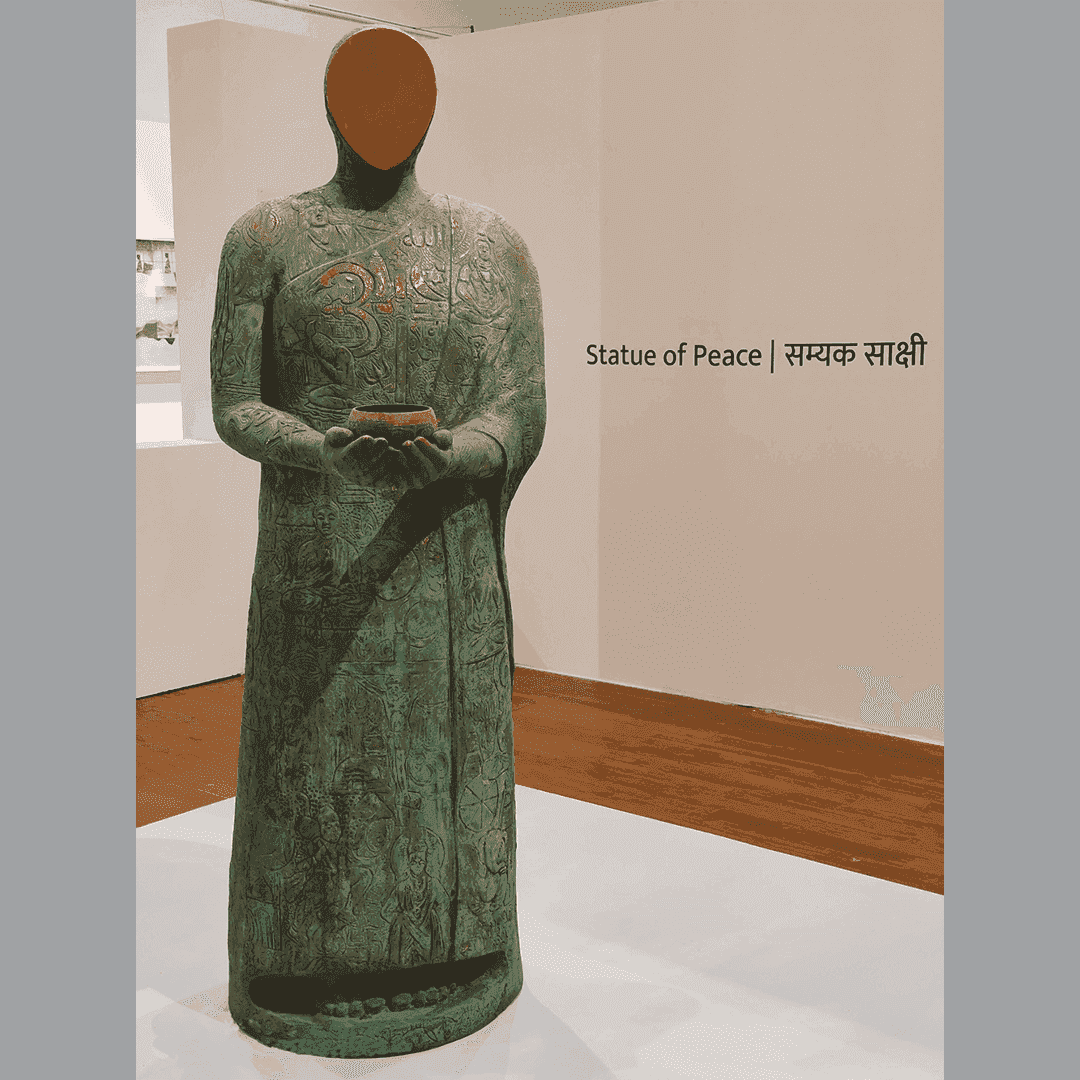
ABOUT THE ARTWORK
Statue of Peace, Medium: Bronze casting, Dimensions: 167.6 x 58.4 x 58.4 cm, Year: 2022
“Statue of Peace” stands as an iconic representation of humanity.
Created through the lost wax technique and cast in bronze, this life- sized free-standing sculpture transcends specific gender or identity.
Rather the sculpture's robe is adorned with symbolic elements from various religious faiths in India and around the world, signifying a unifying bond that transcends boundaries and embodies a universal faith to be revered by all humanity. Kumar also reflects upon the homogeneous diversity of nature, which often exposes contradictions in human behaviour, evoking feelings of fear, suffering and animosity that stem from an inherent state of imbalance. He believes that the establishment of a united world— “Vasudhaiva Kutumbakam”—in both material and philosophical senses, holds the potential to heal a world infected with insecurities, mutual hatred and the destruction of nature driven by insatiable human greed. Drawing inspiration from the divine existence of Shiva and Shakti who symbolise the equilibrium of life and encompass the entirety of the cosmos, the sculpture unifies world faiths within a singular anthropological form. This humanoid figure represents a voluntary surrender of mental evils and atrocities committed against humanity as a whole. This artwork demands the surrender of all evils into the “Bhiksha Patra,” or alms bowl for evil in any form threatens the basic instinct of survival and coexistence.
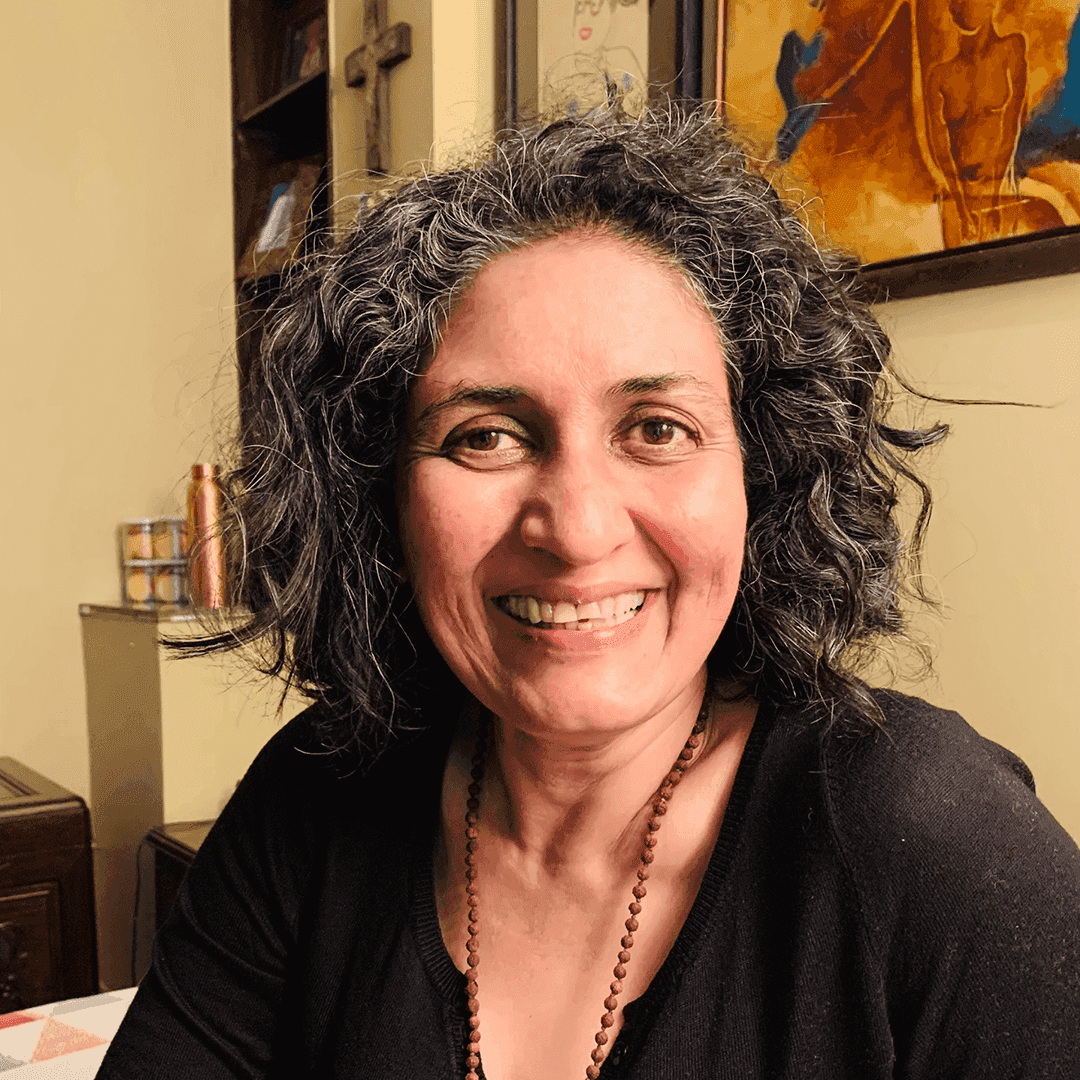
INTRODUCTION
Seema Kohli, born in 1960, is a Delhi-based artist who lives and works in the city. She holds a Bachelor's degree in Philosophy from Delhi University. Kohli is an experimental multi-disciplinary artist, straddling the worlds of the visual and performing arts, and she writes poetry too. Kohli's art celebrates the female form and its energy, exploring the embodiment of “Shakti,” the feminine aspect of Lord Shiva. She finds the feminine form fascinating and goes beyond its physical aspects to depict the deep social, psychological and mystical dimensions of feminine energy that transcend gender boundaries and resonate universally. Kohli's artistic practice in contemporary India is a captivating exploration of the intersections between mythology, spirituality and the human experience. She delves into profound themes of identity, femininity and transcendence, weaving together elements of ancient Indian traditions and contemporary artistic techniques. Kohli contributes to the vibrant and ever-evolving artistic landscape of contemporary India, making a significant impact on the art world, both nationally and internationally. Kohli has held numerous solo and group shows all over the world. She has done several large–scale murals, some of which are displayed at the Supreme Court, New Delhi, Sardar Patel Bhawan, Patna and at the Delhi and Mumbai International Airports. Her works have also been shown at events like Kochi-Muziris Biennale 2016, Venice Biennale of Art/ Architecture 2015 and 2016, and at Art Basel, India Art Fair, Asia Society HK among many others. Her artworks are currently in several prestigious collections including the British Museum, Lalit Kala Akademi and Kiran Nader Museum of Art, Delhi, Birth Rites Collective, UK, Rubin Museum, USA, the Kerala Museum of Arts, India to name only a few.
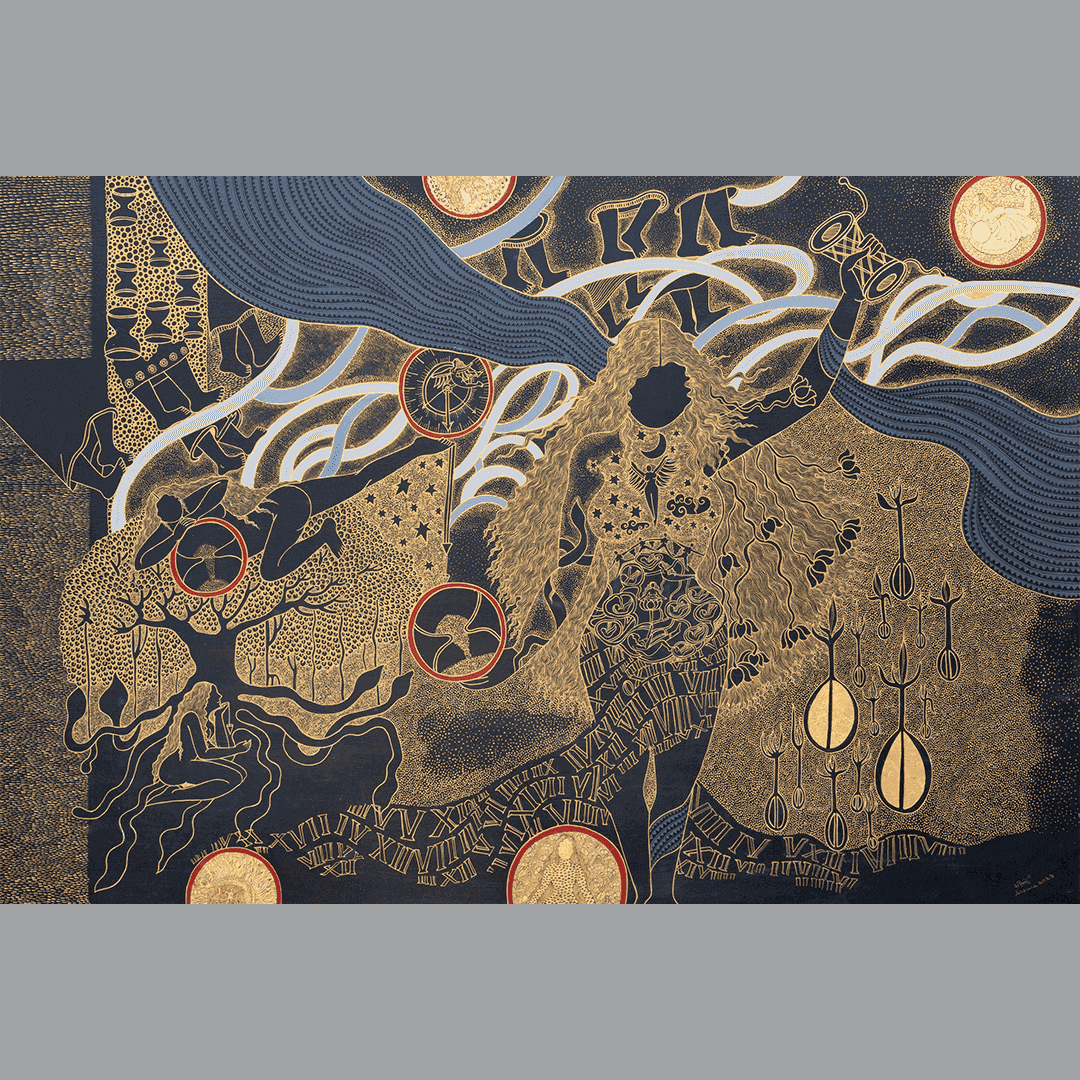
ABOUT THE ARTWORK
Heartbeat of Universe, quicksand’s glitter, Medium: Acrylics and inks on canvas with 24ct gold and silver leaf, Dimensions: 122 x 183 cm, Year: 2023
Kohli’s painting titled “Heartbeat of Universe, Quicksand's Glitter” is an ode to pulsating darkness giving rise to the glitter of sand, sky and water, as well as the hidden depths of our thoughts. The artwork captures the interplay between light and darkness within ourselves, and creates a sense of mystery. The painting portrays the feminine energy as a source of creation, pulsating with life like sperms and seeds, symbolising the generation of time through the womb. The feminine energy acts as a constant force that churns out time and balances the universe where space holds time and energy,providing its movement. Central to this painting is the exploration of the Karmic Cycle (कर्मचक्र) and the concept of “Vasudhaiva Kutumbakam.” This highlights the interconnectedness of all beings and surpasses biases. Each individual is unique, yet exists because of others which emphasises the interdependence and unity of consciousness. Kohli presents a fresh perspective on the Karmic cycle to elucidate that the end of suffering is not the central point, but rather the fulfillment and conviction in living life to the fullest. The use of black is very characteristic while gold symbolises purity. Every colour employed by Kohli holds a specific meaning, contributing to the overall message of the artwork. Kohli's expansive canvases radiate with dynamic energy, capturing the essence of all living beings.
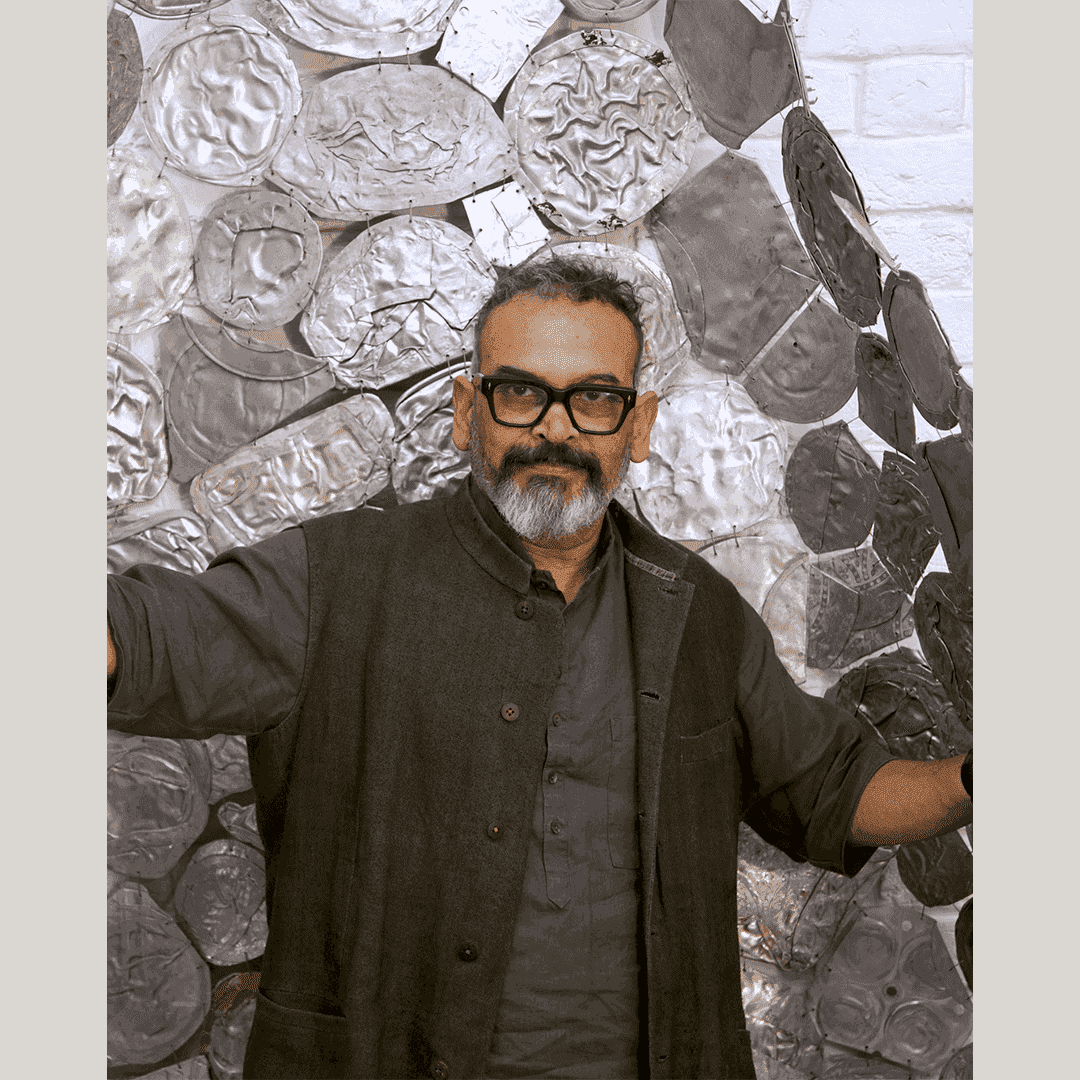
INTRODUCTION
Subodh Gupta, born in 1964, Khagual, Bihar, is an Indian contemporary artist based in New Delhi. He pursued his Bachelor's degree in Fine Arts from the College of Arts & Crafts in Patna, India. Prior to his artistic education, Gupta had a background as a street theatre actor. Gupta’s artworks blend formalism with a perceptive comprehension of symbols and forms prevalent in contemporary India. Migration from village to city, the charged and unpredictable encounter with globalism, and cultural hybridity are crucial concepts in his work. He is renowned for his monumental sculptural works made from mass-produced everyday steel objects such as lunch boxes, cookware and tin cans. As a sculptor, he strategically employs materials that deeply express conceptual contexts. By incorporating everyday objects, his art embodies Indian culture and its diverse socio-economic backgrounds. Gupta's artistic range extends to various media, including stainless steel, bronze, stone, brass, wood, clay and fiberglass. He also embraces a multidisciplinary approach when working with sculpture, installation, painting, photography, performance and video. Gupta's art transcends cultural boundaries as he explores the transformative power inherent in ordinary objects. The interplay between the familiar and the constructed in his artwork creates a captivating dialogue. Gupta grounds his work in stark contrasts that exist in a country like India which combines rural simplicity with growing urban globalisation. He uses the metaphors of Indian society and extrapolates the taboos within the domestic arena to address issues related to caste and gender politics. His works, exhibited both in India and internationally, have gained recognition in prominent international biennials and exhibitions. They have been acquired by a number of public and private collections, including Tate Britain, London, Guggenheim Museum, New York, National Gallery of Modern Art and Kiran Nadar Museum of Art, New Delhi and many more. Gupta has received prestigious awards and honors in his career, including a French Government residency in 2004 and the title of Chevalier dans L'Ordre des Arts et des Lettres (Knight of the Order of Arts and Letters) in 2013.
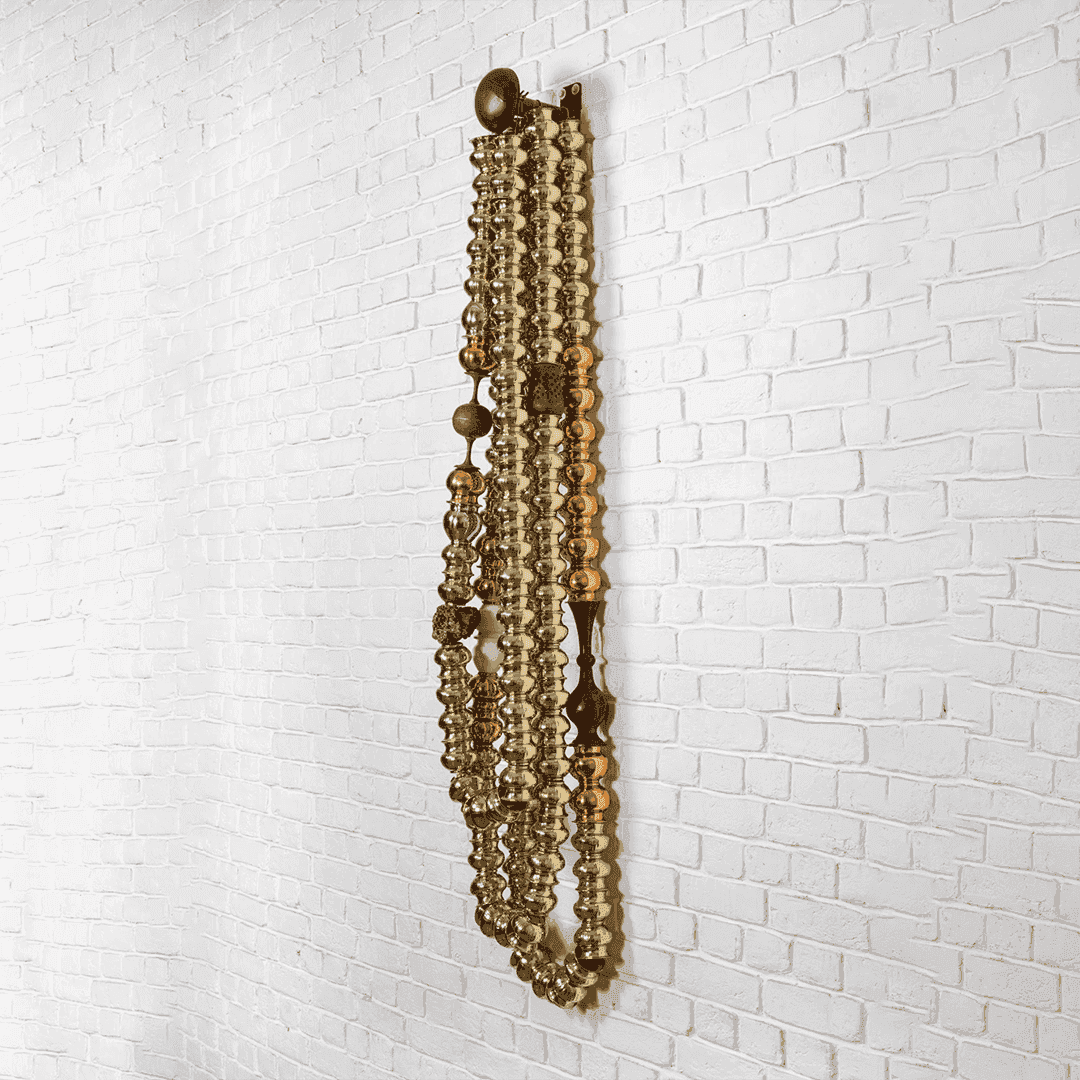
ABOUT THE ARTWORK
Spiritual Tools, Medium: Brass, copper, found rock, stainless steel, paint and steel, Dimensions: 203.2 x 35.5 x 25.4 cm, Year: 2022
“Spiritual Tools” (jaap mala), explores the concept of meditation and self-realisation through the repetition of mantras or divine names using a string of 108 prayer beads. This practice, common in Buddhism, Hinduism, Jainism and Sikhism, aims to foster a deeper connection with a divine power. In this artwork, Gupta takes the handheld spiritual tools traditionally used for meditation, and magnifies them. The materials he employs, such as brass, copper, found rock, stainless steel, paint and steel, contribute to the visual richness and symbolic depth of his creations. Additionally, he replaces the beads with small brass utensils called “lotas” which are typically used for personal hygiene and ablution purposes. Through this juxtaposition, the artist draws a parallel between the practical act of cleansing through the “lota” and the spiritual purification achieved through chanting with the “jaap mala,”and thus bridging the gap between the sacred and the functional realms. This integration also invites viewers to contemplate the interconnectedness of the material and the spiritual aspects of their lives.
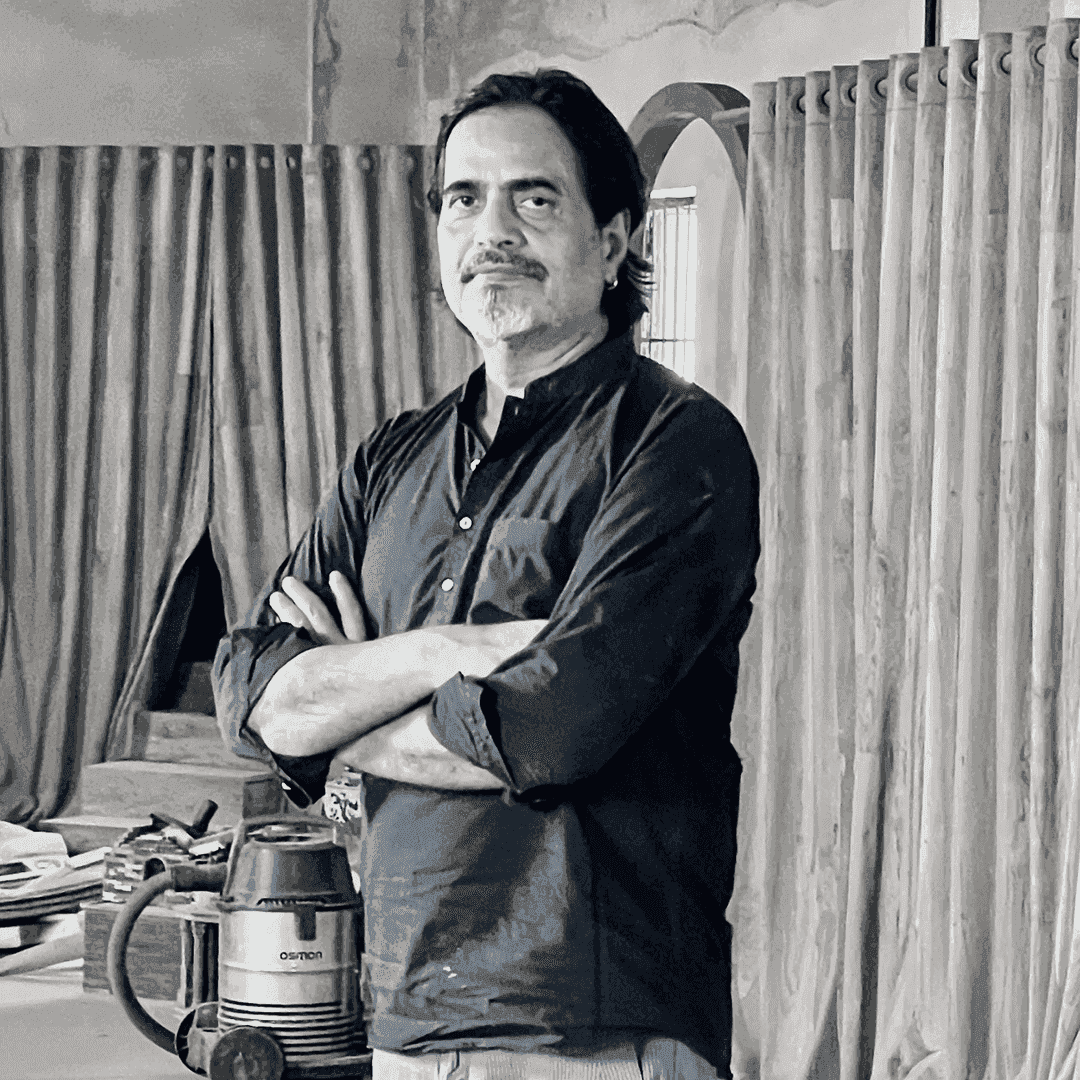
INTRODUCTION
Sudarshan Shetty, born in 1961 in Mangalore, Karnataka, currently lives and works in Mumbai. He received his Bachelor's degree in Fine Arts from Sir JJ School of Art, Mumbai in 1985. Following this, Shetty went on to a fellowship at Kanoria Centre for the Arts, Ahmedabad. Shetty grew up in a family where a lively atmosphere of music and singing allowed him to immerse himself in storytelling that deeply influenced his artistic practice. These experiences have enabled him to explore innovative approaches through a diverse range of media, such as painting, sculpture, assemblage, conceptual installation, video, sound and performance. By transitioning his primary focus from painting to the exploration of installation and mixed-media works, he delves into profound ontological questions that arise from our interaction with the world of objects. Thus, he prioritises the subject and breaks free from conventional artistic mannerisms. His installations encompass a varied range of materials, such as machine parts, everyday objects, and electronic media. Through the fusion of these culturally diverse elements, he creates immersive and unconventional artistic experiences. Shetty's artistic approach involves repetitive movement and the juxtaposing of ordinary objects. Through the use of object language, he challenges conventional narratives and establishes symbolism while embracing openness for diverse interpretations. Shetty's artistic themes have transitioned from exploring the politics of absence and mortality, to delving into concepts of futility, meaninglessness and transience. In fact, an unwavering fascination with mortality pervades his art, as Shetty continuously questions the nature of life’s transience. Reflecting the pulse of contemporary urban life, his artistic world evokes memories of childhood and stirs his playful, curious mind. In doing so, he subverts the homogenizing force of globalism, and quite innocently plots to disrupt the dominant value system dictated by politics and the economy. Shetty has showcased his work in India and across the globe, and some of his significant compositions were presented at the Kiran Nadar Museum of Art, New Delhi, Galerie Krinzinger in Vienna, Staatliche Museum, Germany, Centre Pompidou in Paris, Guggenheim Museum, New York and the Vancouver Biennale among others. Shetty's artworks are currently in several prestigious collections, including the Kiran Nadar Museum of Art, India and Fukuoka Asian Art Museum, Japan. In 2016, he was the curator of the Kochi-Muziris Biennale.
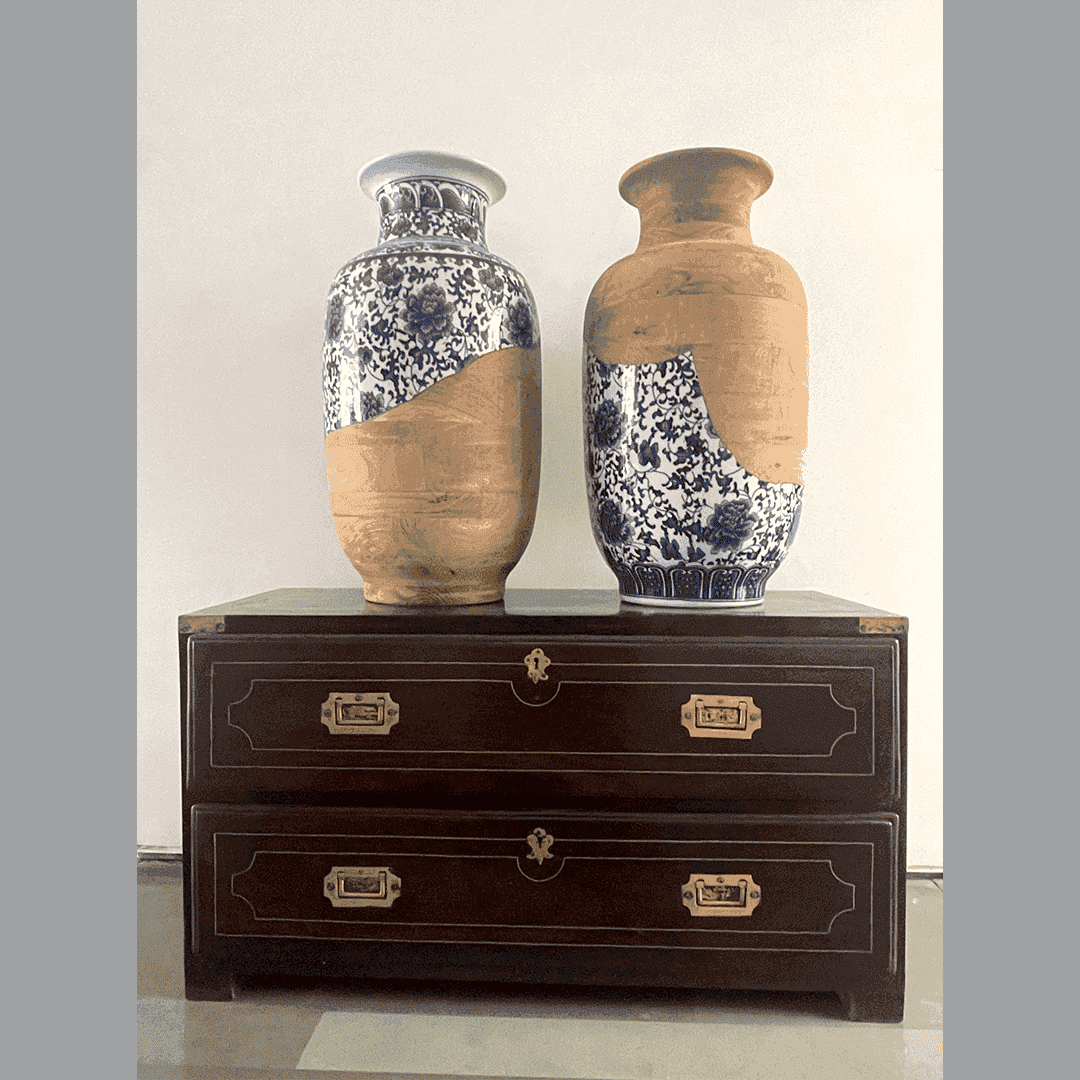
ABOUT THE ARTWORK
Untitled, Medium: Teak wood and ceramic vase and found cabinet, Dimensions: 109 x 86 x 35.5 cm, Year: 2015
The “Untitled” presents a pair of vases that combine two distinct materials: porcelain and wood. The porcelain vase, initially purchased from a market that specialises in objects for home decoration, is intentionally shattered. The cracked pieces are then carefully mapped onto its wooden replica. By using wood to complete the pot, Shetty aims to revive the broken vase. The wood utilised in this process is sourced from a second-hand market, and carries within it a hidden narrative of its previous existence in a dismantled structure from the city. The ceramic part of the vase may appear antique, but it is actually new and imitative, whereas the reused teak wood holds unknown histories of its own. Through his constructions, Shetty frequently examines the fusion of Indian and Western traditions, raising questions about their interplay. Incorporating recycled wood, metal and ceramics, he explores the essence of movement within the domestic realm and uncovers the hidden histories they carry.
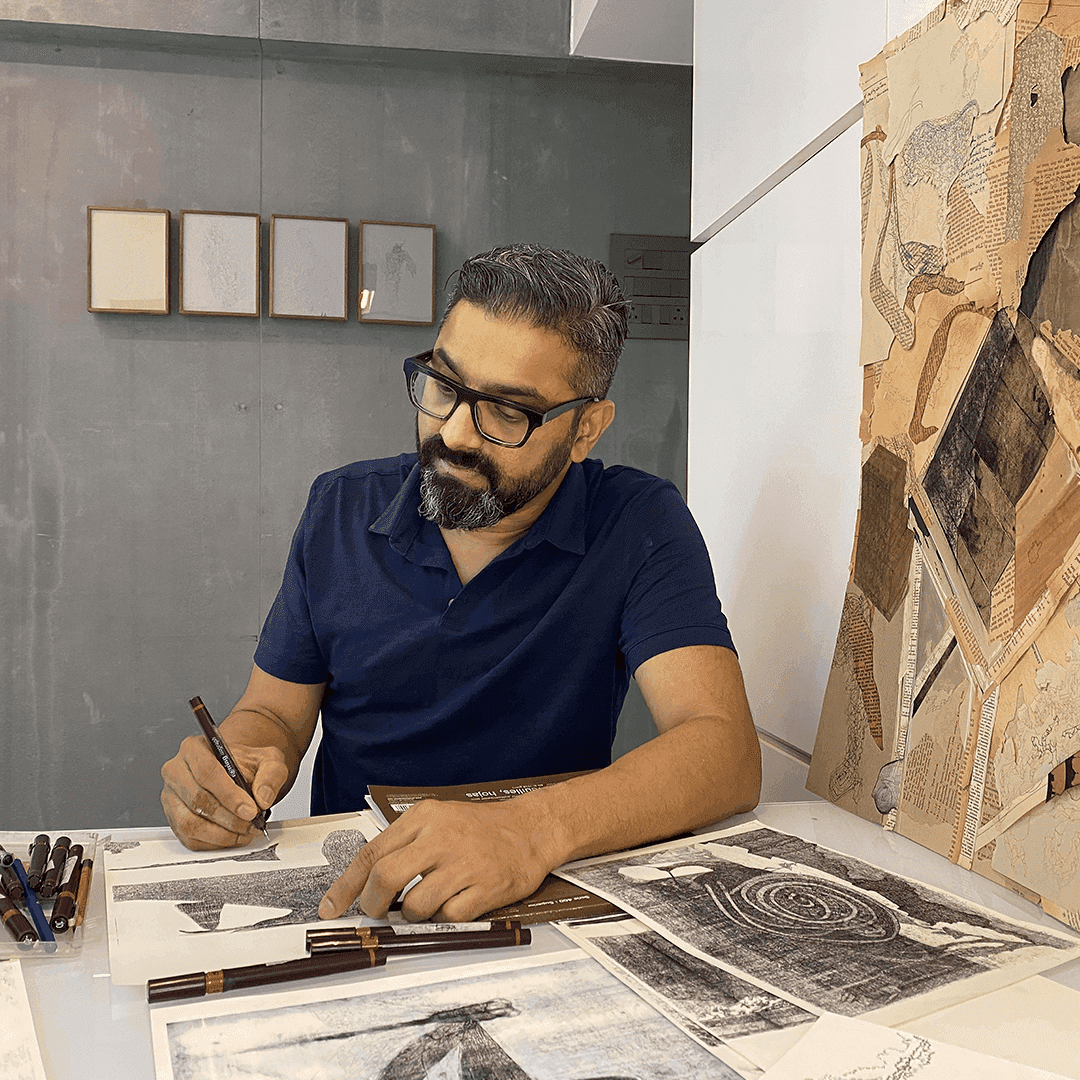
Sunil Padwal, born in 1968, lives and works in Mumbai. He completed his Bachelor’s degree in Fine Arts from the JJ Institute of Applied Art. His artistic practice is a culmination of diverse memories, the bustling urban environment, the evolving cityscape and the complexities of modern society. Growing up amidst the vibrant streets of Mumbai, he draws inspiration from its various activities and social dramas. This daily engagement with the city is the core of Padwal's practice which sheds light on the imperfections of humanity and society. They blur the line between reality and fiction, and his drawings offer a unique perspective rooted in his observations of the world. Padwal's artistic practice spans a range of media, including line drawings, paintings, sculptures, photography and installations. However, in the past decade, his focus has shifted exclusively to drawing-based work. Padwal's line drawings act as mirrors of his overlapping thoughts, transforming them into fascinating and intricate shapes that transcend their original form. The lines play a vital role, giving birth to complex and diverse forms that reflect the depth of his thinking. He curates a collection of objects, including those that hold personal significance to individuals whose lives he has touched, and he uses them to create compelling narratives. He values the viewer's engagement and imagination, as they add another dimension to his semi-fictional stories. Padwal has exhibited his work extensively in India and the international world, with his artworks showcased in numerous solo and group exhibitions. He presented “Lining an archive” at GALLERYSKE, New Delhi, 2019; “Confluxes” at The Arts House, The Old Parliament in Singapore, 2014; “Soliloquies, notes from the drawing book” at Space 1857, Chicago 2012; "Myopia" at Jehangir Art Gallery in Mumbai and “Untitled” at the Hong Kong Visual Arts Centre, 2006. Notable group exhibitions include the Kochi-Muziris Biennale 2016-17; "As Far As The Forest Is," Three Artists Show - Kewenig, Palma, Spain, 2019; “Fifty Years of Freedom of Expression” by the National Gallery of Modern Art in Mumbai, "Every Soiled Page," Ishara Art Foundation, UAE, 2020, to name a few. Padwal has also made significant contributions to public art that includes a mural at Kala Ghoda, Fort, Mumbai; another at Mumbai International Airport, and a sculpture located at Delhi Metro Airport Express Line station, New Delhi. He has received awards including the Society Young Achievers Award in 2004, Emerging Artist of the Year in 1998, and the Communication Artist Guild Award in 1990.
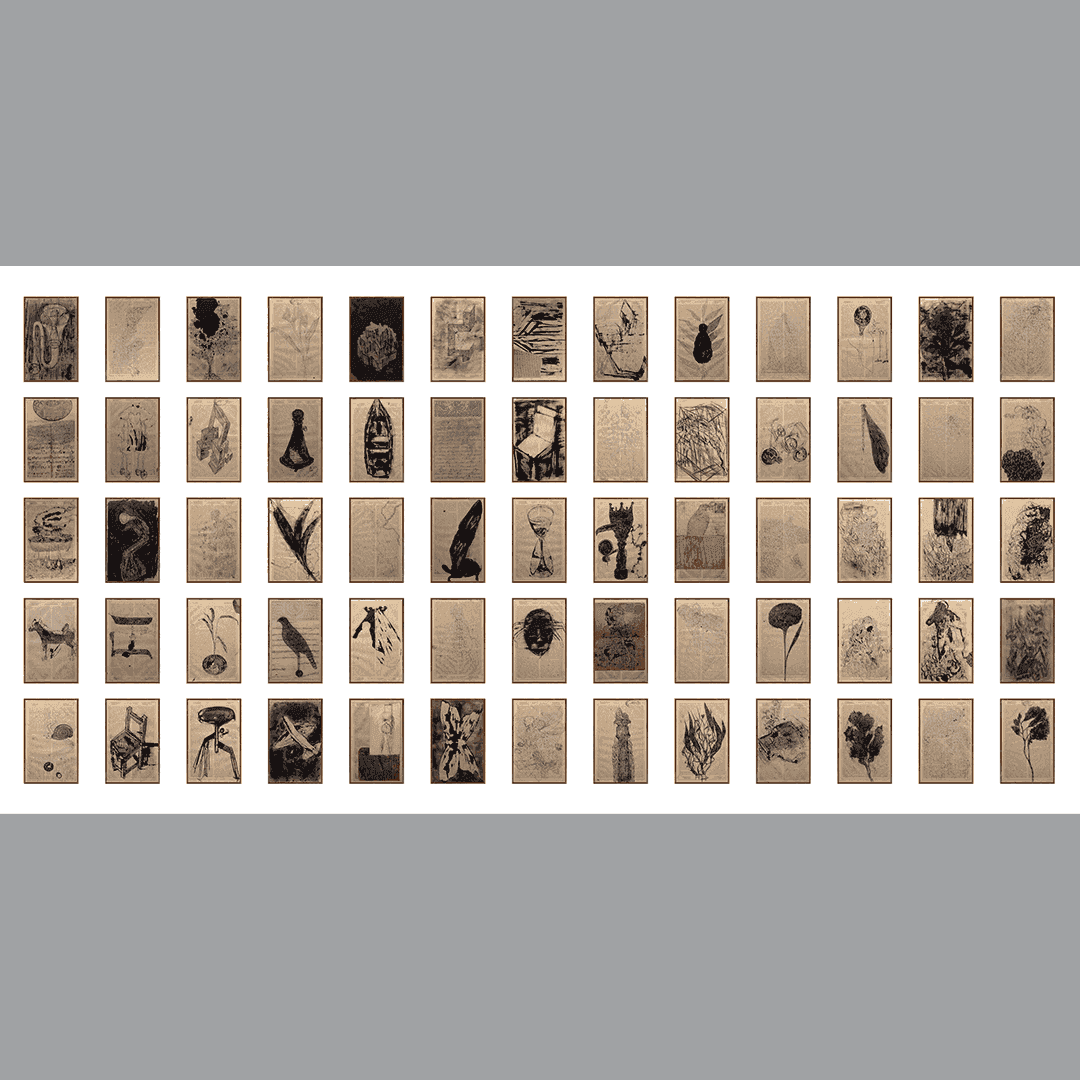
ABOUT THE ARTWORK
65 pages of eloquent silence (A found book, found postcards and found stamp papers, Royals- birds and animals on wheels, flora, concrete and present-day quotidian stories), Medium: Isograph pen, Micron pen, charcoal, pencil, ink on found book pages, Dimensions: 271 x 128 cm, Year: 2023
In “65 pages of eloquent silence,” Padwal skillfully portrays elements like birds and animals from Mughal miniature paintings, juxtaposing them within the context of the present day. Finding inspiration from his daily observations of the urban environment, Padwal incorporates found objects, including a book, postcards, stamp papers, and inscribes them with new meaning and narrative. The drawings serve as a means to overwrite or supplement the existing narrative within the found book. Flora, fauna, concrete jungle and present-day stories further enrich the tapestry of themes explored in this artwork. Through this amalgamation of materials and subjects, Padwal creates a multi-layered experience that invites viewers to delve into the complex interplay among history, nature, urban life and contemporary narratives. At first glance, the drawings may appear tranquil, yet they possess layers of meaning. These intricate and multilayered narratives gradually unfold. Padwal employs the urban landscape and everyday objects as tools to subvert conventional notions of reality, evoking the viewer's imagination and challenging their perceptions. Previously relegated to the sidelines as mere spectators within the artwork's composition, the figures in his artwork now assert their presence, actively participating and subtly revealing the mysteries behind their forms. By integrating elements of past and present, he prompts reflection on the intricate relationships between history, identity, and the ever-evolving world we inhabit.
The G20 Art Project: Together We Art was a contemporary visual arts project, conceptualised by the Culture Working Group (CWG), Ministry of Culture, Government of India for India’s G20 Presidency, in collaboration with Bihar Museum, Patna. Together We Art was based on India’s G20 Presidency theme ‘Vasudhaiva Kutumbakam’ or ‘One Earth · One Family · One Future’, with a focus on cultural sustainability, ecology, and environment. The project also exemplified the CWG’s campaign of ‘Culture Unites All’ to represent the shared heritage of the G20 members and invitee countries.
The exhibition was inaugurated on 7 August 2023, with the Bihar Museum Biennale, and showcased one artwork as a national submission from each G20 membership, along with the works of 20 notable contemporary artists from India.
CURATORIAL NOTE:
Embedded in the Maha Upanishad, ‘Vasudhaiva Kutumbakam’ is a concept which lays the foundation for the concept “One Earth, One Family, One Future” This is the recurring leitmotif of the exhibition,_ “Together We Art.”_ Conceptualised by the Ministry of Culture for India's G20 Presidency, “Together We Art” presents an extraordinary “raagmala” or garland of exquisite artworks, gathered under one roof, from the G20 members and invitee countries.
Together We Art integrates the artistic response to many concerns of the G20 countries. From climate change to gender inclusion, migrations to identity, and global oneness to materiality, the creates the most intricate patterns of human understanding, woven through the web of ideas expressed by over 40 participating artists. It faithfully serves as a powerful testament to the unifying potential of art. The convergence of diverse artistic expressions becomes a celebration of human creativity, uniting artists and audiences from different corners of the world. The exhibition has shown that art has the remarkable ability to communicate universal, but ordinary themes such as love, hope, resilience and human communication, regardless of nationality or background. Ultimately, this exhibition has managed to dissolve global boundaries and emerge as a laboratory of creative expression.
The artworks transcend geographical, cultural and societal differences by speaking a universal language that will resonate with audiences worldwide. By intertwining the urgent narratives of climate change and gender equality, the exhibition raises awareness of critical global challenges; it fosters a sense of shared responsibility and solidarity. The rich tapestry of artworks allows viewers to witness the beauty of shared experiences and the collective nature of our historic and onward human journey.
This effort of bringing together over 40 artists from India and the world together is a gentle reminder that beyond our individual identities and nationalities, we are all part of a shared human experience of an extended human family. We can break down barriers, celebrate diversity, and collectively envision a more inclusive and harmonious world through art. This exhibition dissolves the notion of “us” and “them,” by inviting everyone to embrace a sense of global citizenship and responsibility for the well-being of our planet and its inhabitants.
— Dr Alka Pande, Chief Curator
Must Know
EVENT INFORMATION
MUSEUM HOURS
MUSEUM ENTRY TICKET IS REQUIRED
MUSEUM ENTRY TICKET IS REQUIRED
PLAN YOUR VISIT
– Closed on Mondays
– Galleries: 10:00 am - 5:00 pm
– Children’s Gallery, Children’s Café, Museum
Shop, Library : 10:00am – 7:00pm
– Restaurant : 10:00am – 9:00pm
GET MUSEUM DIRECTIONS
Special after-hour ticket price after 05:00 pm
© Copyright Reserved Bihar Museum 2025
Website designed by Lopez Design
